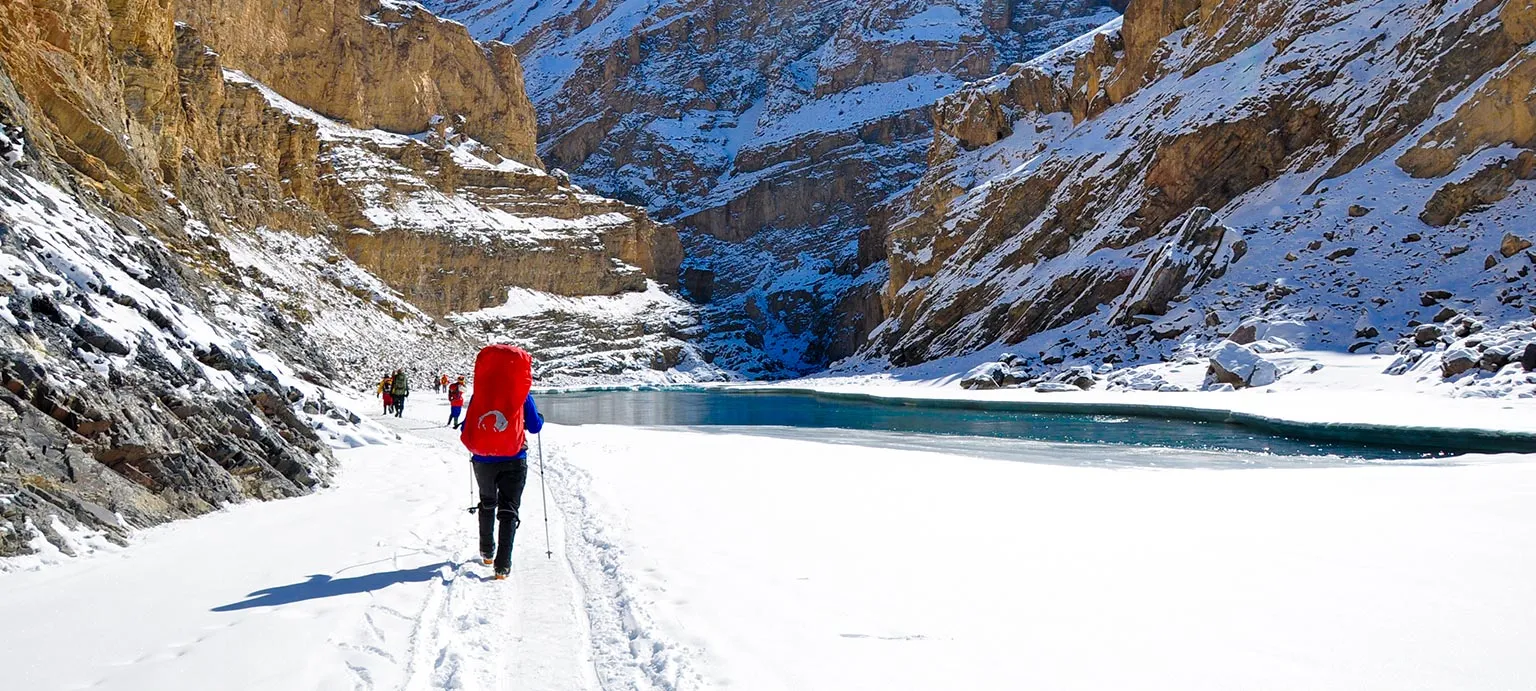

Chadar Trek Frozen River
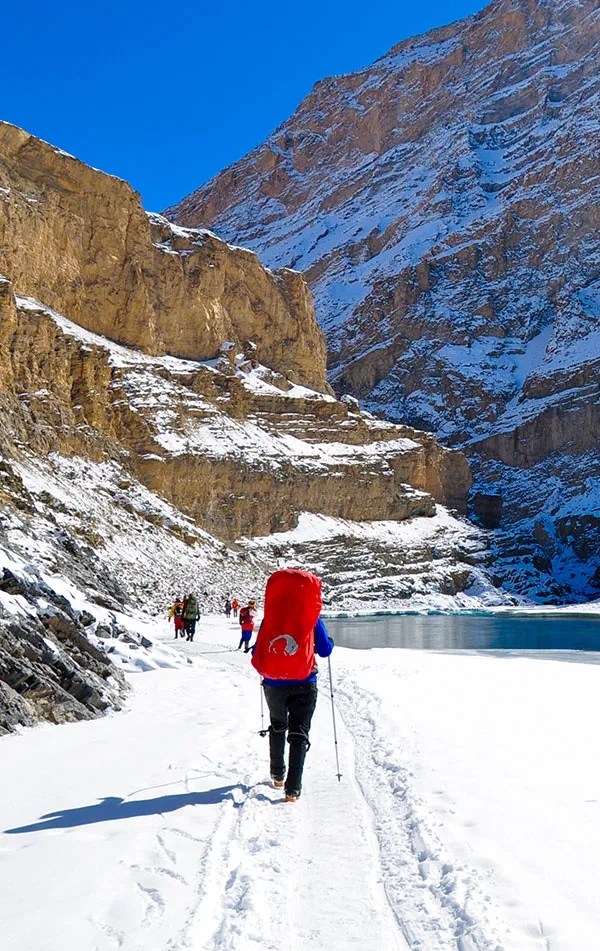
Ladakh | India
Max Altitude
Trekking Km
Help & Support
26500 /person $ /person.
- +5% GST (goods and services tax).
- Services Leh to Leh.
For more information. Please complete this form.
Help & Support
Trek Name: Chadar Trek Frozen River
Adventure Type: Trekking
Base Camp: Leh
Season: Winter |
Month: January | December |
Country: India
Altitude: 11100 Ft.
Grade: Difficult
Rail Head: -
Stay: Hotel & Camping
Food: Meals while on trek
Location: Ladakh
Distance: 62 Km.
Trail Type: Point to point trail | Camping at the same location upon returning.
AirPort: Leh (Kushok Bakula Rimpochee)
Why Chadar Frozen Trek is a Must-Do Trek?
- The Chadar Frozen Trek is renowned as one of the world's most iconic and challenging treks, offering a unique and extraordinary experience for adventurers.
- Takes trekkers through the starkly beautiful and remote landscapes of Ladakh, providing an opportunity to witness the untouched beauty of the region.
- Trekkers traverse the frozen Zanskar River, experiencing the thrill of walking on a solid ice sheet, transforming the river into a surreal frozen wonderland.
- Trekkers face extreme winter temperatures, with the mercury often plummeting well below freezing, reaching as low as -30°C (-22°F) during the night. This challenging environment adds an element of resilience to the trek.
- Provides an incredible cultural experience as trekkers pass through the remote villages and interact with the local communities along the frozen river.
- Highlights the awe-inspiring Nerak Waterfall, a significant milestone on the trek. The frozen cascade of ice is formed due to the chilling temperatures, creating a mesmerizing natural wonder.
- Features the Tibb Cave, a naturally formed overhang along the frozen river cliffs. This cave serves as a crucial shelter for trekkers, offering respite from the biting cold, wind, and a place to rest, warm up, and prepare meals.
- The trek is only possible during the frozen winter months, making it an exclusive and limited-access adventure that adds to its allure.
- For those seeking a rare and challenging experience in the Himalayas, the Chadar Trek is considered the ultimate choice, providing a blend of natural beauty, cultural immersion, and physical challenge.
The Chadar Frozen Trek , located in the northernmost part of India in the region of Ladakh, is one of the world's most iconic and challenging treks. The trek takes adventurers on an extraordinary journey along the frozen Zanskar River offering a unique opportunity to explore the starkly beautiful and remote landscapes of Ladakh, complete with breathtaking ice formations and an incredible cultural experience.
The Chadar Trek takes place in the Zanskar region of Ladakh, India. The trek begins near the village of Chilling and extends through the frozen Zanskar River. The Chadar Frozen Trek occurs during the coldest months of the year, typically from January to February when the Zanskar River freezes over. This is the only time when it's possible to undertake this unique adventure. Winter temperatures in the Zanskar region can plummet well below freezing, often reaching as low as -30°C (-22°F) during the night.
For those seeking a rare and challenging experience in the Himalayas, Chadar Trek is the ultimate choice.
Frozen Landscape
The trek takes you through a surreal frozen wonderland, where the Zanskar River transforms into a solid ice sheet. Trekking on the Chadar , or frozen riverbed, is a remarkable experience.
Nerak Waterfall
Nerak Waterfall, often referred to as Nerak Waterfall Camp, is a significant milestone on the Chadar Frozen Trek . This awe-inspiring site is a cascade of frozen ice that has formed as a result of the chilling temperatures in the Zanskar region.
Tibb Cave is another remarkable feature along the Chadar Trek . It's a naturally formed overhang in the rocky cliffs along the frozen river. This natural shelter provides trekkers with a respite from the biting cold and wind, offering a place to rest, warm up, and even prepare meals.
- Who can Participate
- Important Links
- How to Reach
- Trek Essential
Who Can Participate
- Age; 12 years +.
- First timers can apply; previous trekking experience is more appreciated.
- The climber must be fit and have sufficient stamina to cover 5 km of distance in 35 minutes without stress.
- The climber should be able to carry a 10-15 kg backpack.
Reporting day at Leh
- Altitude: Leh 3,500 m/ 11,500 ft.
- Keep your woolen cap and gloves handy at the Airport.
- Airport pickup is not included in the cost.
- Orientation & Briefing of the trek at 12:00 noon (Mandatory).
- Check-in Hotel 10:00 am | Centrally heated room | Attached washroom in running condition | Hot water in buckets.
- Bring a copy of your ID proof and 2 photographs. Foreigner, a copy of passport and visa.
- Keep the boarding pass with you, it will be needed for permission on the third day.
- The network is available (only post-paid).
- ATM is available.
- Visiting any very high-altitude place or pass is not advisable.
- Consumption of alcohol and smoking is strictly prohibited.
- Spend the day in the room itself to acclimatize.
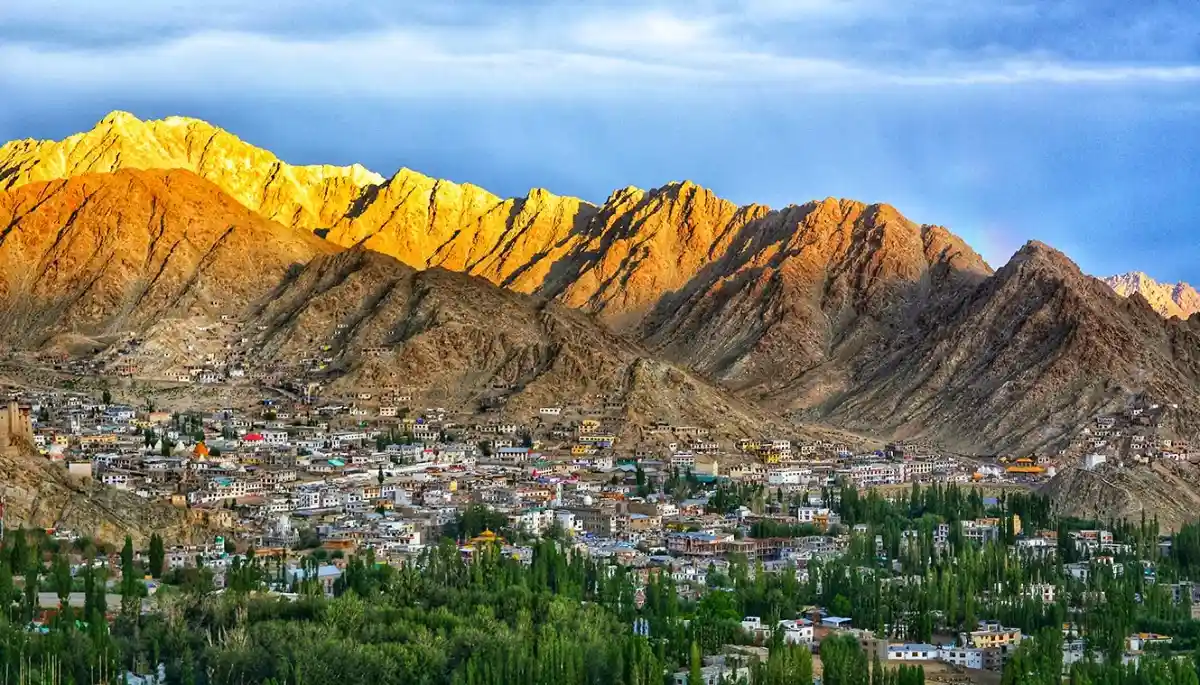
You will be landing at the Leh airport which is one of the most picturesque airports that you will come across. Just before touchdown time, you'll be greeted with the entire range of snow-capped peaks that will surely get you wonderstruck. It's important to keep your warmies handy as you'll feel the sudden drop in temperature as soon as you arrive at Leh airport. A jacket, woolen gloves, and a woolen cap is a necessity. After reaching the guesthouse you will be given enough time to relax and acclimatize to the conditions. Later in the evening, you can spend some time at the Leh market for last-minute window shopping. It is very important that you get used to the cold temperature in Leh because the temperature will only tend to fall as you start walking on the frozen Zanskar. From the end of January to mid-February, the temperature can be anything between -10 to -15 degrees during the day. It is also important to keep your body hydrated by increasing the intake of fluids that will help to maintain your body temperature.
Acclimatization Day
- Rest + Acclimatisation day.
- Sightseeing included in the cost (Hall of Fame, Shey Monastery, Thiksey Monastery).
- Visit of any very high altitude place or pass is not advisable.
- Stay in Hotel | centrally heated room |attached wash room in running condition | hot water in buckets.
Keeping in mind the health problems that trekkers are facing (AMS), as per the new regulations applied, anyone doing the Chadar Trek should be atleast spending two days in Leh to get your body fully acclimatize to the weather conditions. It is irrevocable and it is important that it is strictly followed by every trekker. You can spend the day by visiting the places around the city. You can also join us while we conduct a small sight seeing session(included in the cost). It is only for 3-4 hours, covering all the major spots of Leh. It is advisable that you avoid visiting places which are at a higher altitude. Crosscheck your essentials before going to bed.
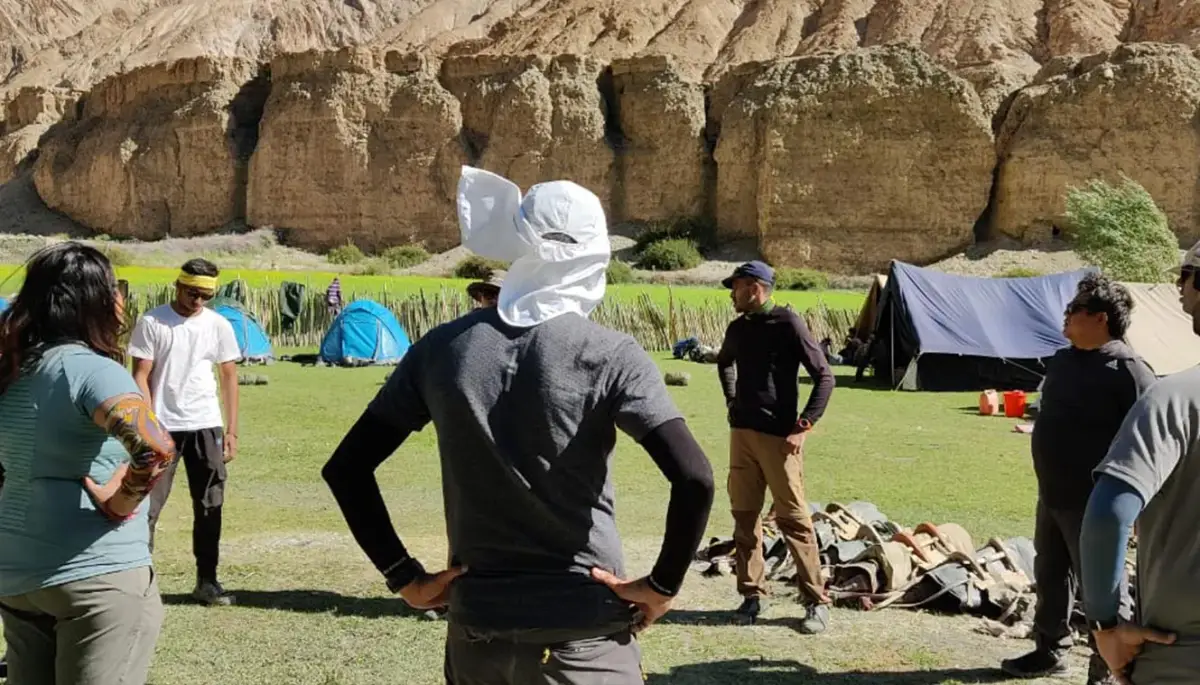
Medical test day
- Wake up early and get ready for medical tests | height & weight, blood pressure and oxygen level.
- Drive/Walk to the Government Medical camp.
- Get your Oxygen and BP reading (There is a long queue due to rush of tourists. It may take 3-4 hours depending on the rush).
- Late afternoon insurance formalities.
- Enjoy evening in Leh.
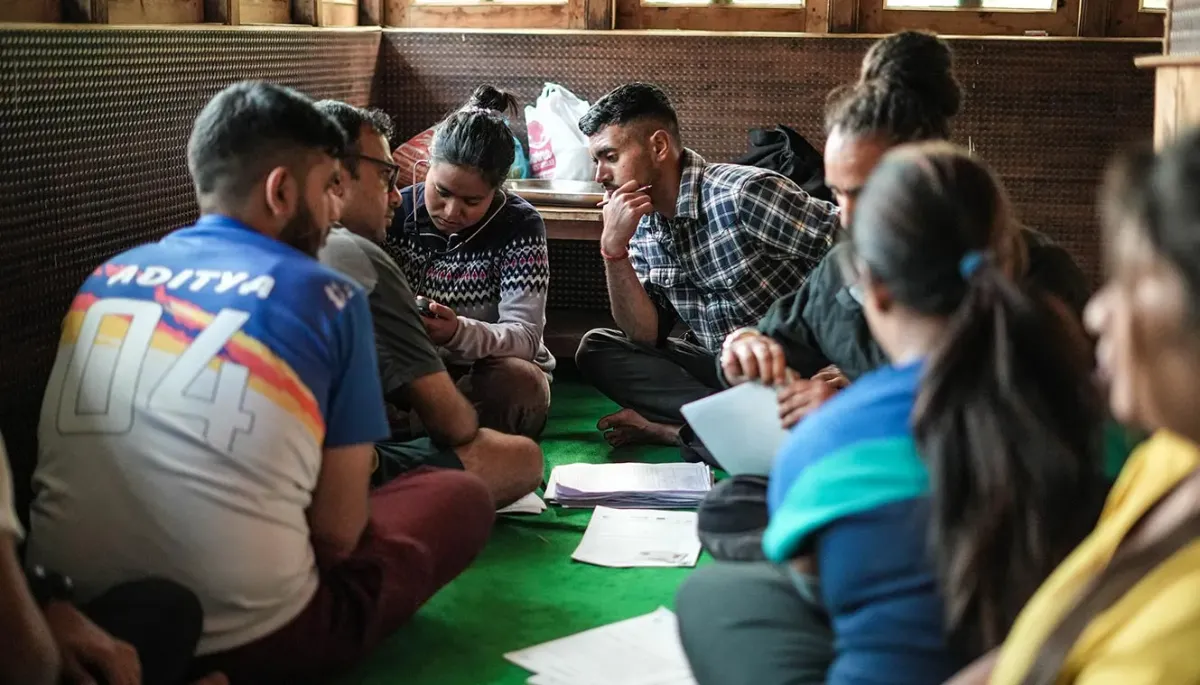
Note: Walking in gumboots will take a while, so be prepared for some slips and falls! It’s advisable to carry a small backpack which will protect your back at the time of falls.
On this day, you'll be headed to the first campsite which is Tsomo Paldar via Chilling & Shingra Koma. Shingra Koma is the most unique place of Chadar for it is placed at U bend of Zanskar. Forming a wonderful place with lots of views. Today will be one of the most scenic drives which lets you witness some of the top spots in Ladakh. Gurudwara Pathar Sahib, Magnetic Hill and the confluence of the Zanskar and Indus are some of the places where you can take a pit stop for clicking pictures. After 3-4 hours drive along the Zanskar will get you to Shingra Koma. The car will drop you right where the road ends, this will be your starting point of walking on the Zanskar.
The layer of Chadar may seem thin here, but you can also see various rock formations. Walking with gumboots on will definitely be a challenge in the initial stage. Understanding the ice patterns will take time, slowly but steadily you will know which surface is fragile and which is trustworthy. There are multiple ice surfaces that you would come across while walking on the mighty Zanskar and as you start walking you will know more about it. Planting your foot will be important in most cases, you can check for the ice for its steadiness with your walking stick before stepping on it wholeheartedly. A small and light backpack will help as you will able to manage your body weight in an effective manner. After an hour and a half of slipping, falling and trying to gather your balance you'll be reaching your first campsite at Tsomo Paldar. This will be your first experience of camping under sub-zero temperatures.
Tsomo Paldar to Tibb Cave
- Altitude: 3,350m/ 10,950 ft.
- Trek Distance: 14 km | 6-7hr.
- Make sure you fill your thermos with warm water before you leave.
- Pass through a waterfall which never freeze.
- It will be sunny only around 9-10 in the morning.
- Hot Lunch on the way.
- Visit small cave, in that cave the local porters rest for the night.
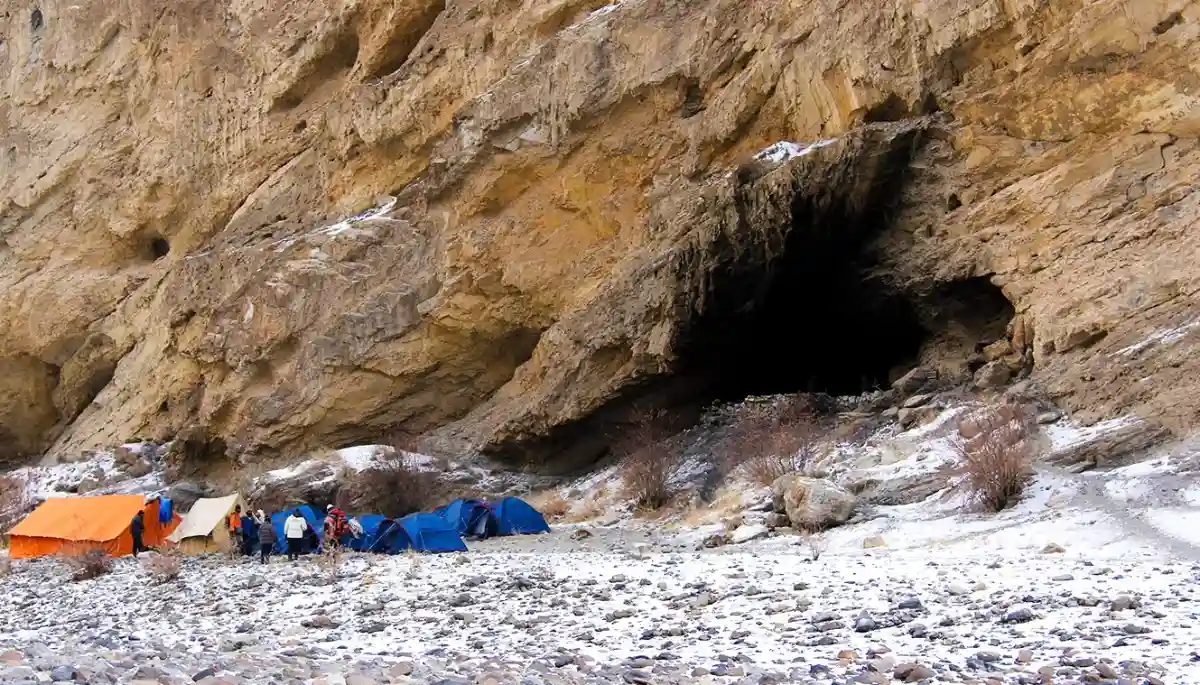
Chadar is one such trek where you are not gaining altitude in quick succession. Slowly but gradually from Tsomo Paldar to Tibb Cave (6-7 hours), you will be gaining an altitude of 400ft. (Tsomo Paldar: 11,400 to Tibb Cave: 11,800) After spending a cold night in the tent at Tsomo Paldar get done with you breakfast that will re-energize your senses in the morning. The much-needed hot cup of tea will be special in such frosty conditions. As you start heading to the next campsite which is Tibb Cave, this trek route has some of the most eye-catching frozen waterfalls that youll see. Waterfalls that stand frozen in time. The source of some of these frozen waterfalls is still unknown and there are a lot of myths amongst the villagers. The mighty Zanskar will be flowing all along with you on the trail and the emerald green water will have a smooth soothing You will be served lunch midway to Tibb cave. After walking for a couple of hours you'll come across different rock patterns along the way which look like art looks when the sun rays fall on them making their way from behind the clouds. You will be camping near the Tibb cave which is surrounded by dry sand.
Tibb Cave to Nerak
- Altitude: 3,400 m / 11,100 ft.
- Trek Distance: 13 km | 6-7 hrs.
- Attraction Frozen waterfall.
- Nerak is the first village of the Zanskar region.
- If we reach Nerak Camp on time, we can go to Nerak village.
- Stay in a tent.
As you move on to the most awaited campsite of the trek which is Nerak, the 13km long trail will take you to the most iconic landmark of the Chadar trek. i.e. The frozen waterfall. The frozen waterfall is a nature masterpiece that attracts trekkers from around the world. Hot lunch will be served on your way to Nerak. By far, Nerak will be the coldest of all the campsites on the trek where the temperature goes down to as low as -30 degrees during the night. It will be important that you wear proper clothing in layers to stay safe from the biting cold. If you manage to reach the waterfall on time, there are chances of paying a visit to the Nerak Village as well. You will be camping at a distance of 15-20 minutes from the waterfall.
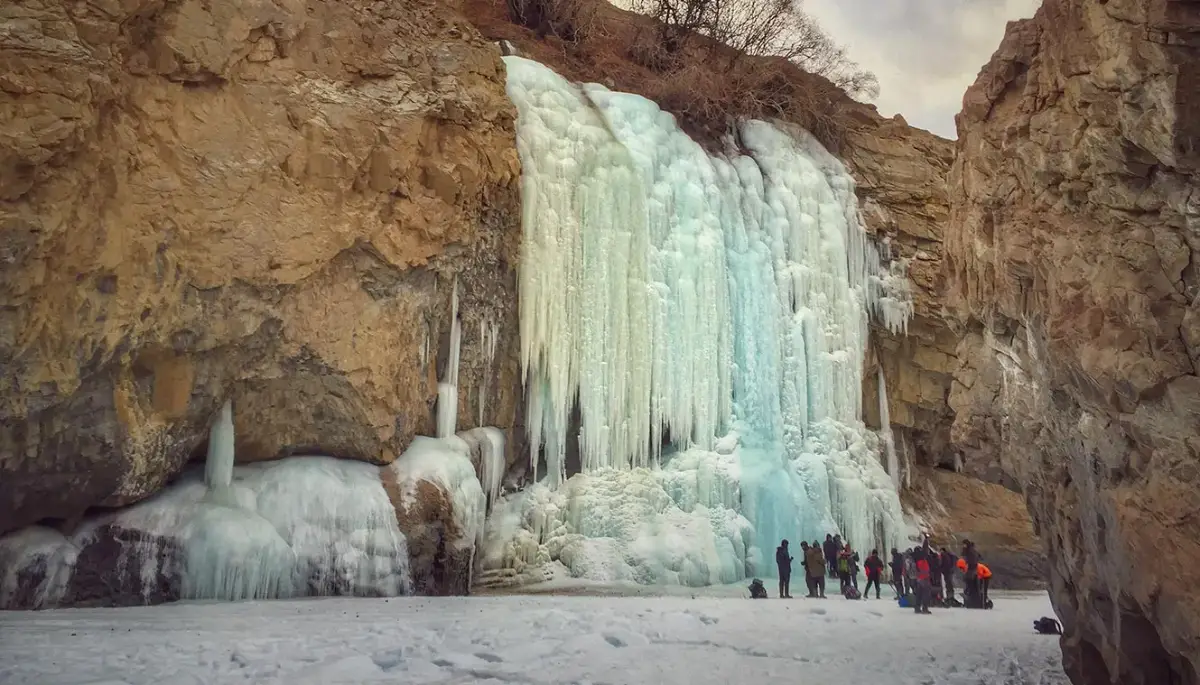
Nerak – Tibb Cave
- Altitude: Nerak- 3,400 m/ 11,100 ft | Tibb cave- 3,350 m/ 10,950 ft.
- Trek Distance: 3 km / 5-6 hrs.
You might have heard stories of how unpredictable the weather patterns can get here on the Chadar trek. There are instances where the formation of Chadar no longer exists on your way back from Nerak. In the same way, you will witness a new layer of Chadar formed at some. Even though it's the same route, you'll be amazed to see how different it appears while coming back. Chadar Trek is the experience of a lifetime that every trekking enthusiast should witness. And then, what if we told you that these eight days of your life are going to be some of the best days youve lived so far and that youll cherish these moments till the very end.
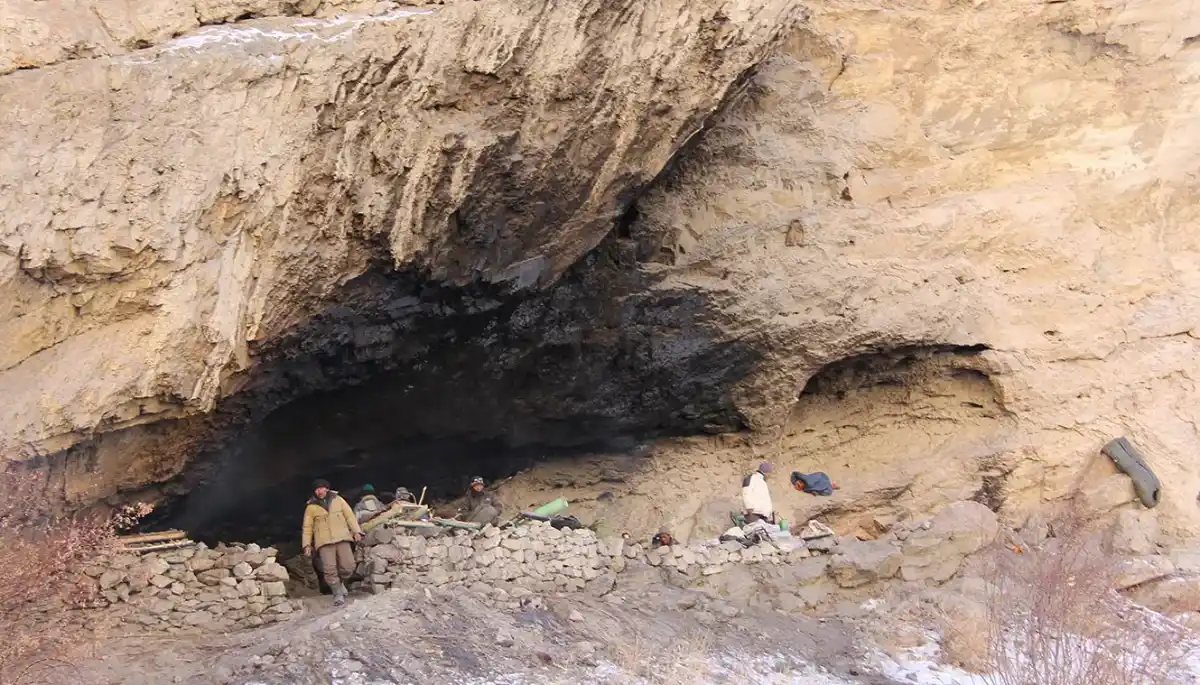
Today retrace your steps back to Tibb Cave. You get another last chance to cherish, relive, and gather the memories. Wave goodbye to all the locals while you make your way back. Be careful and enjoy your last stay in tents.
Tibb Cave to Shingra Koma then Drive to Leh
- Altitude: Tibb cave- 3,350 m/ 10,950 ft | Shingra Koma- 3,150 m/ 10,300 ft.
- Trek to Shingra Koma : 17 km | 5-6 hours.
- Drive to Leh: 70 km | 3-4 hours.
- You will reach Leh by the evening.
- Stay in a hotel (Centrally heated room) (Running hot water in taps).
Again wake up early for a long walk back. It is not retracing steps because you may observe a lot has changed. Chadar may have melted, a layer of Chadar may have gotten thin, and wonderful rocks are visible now. We all, know the beauty of nature and the Chadar trek. Reach Shingra Koma and get ready to board on vehicles. Another bumpy ride and you will arrive in Leh.
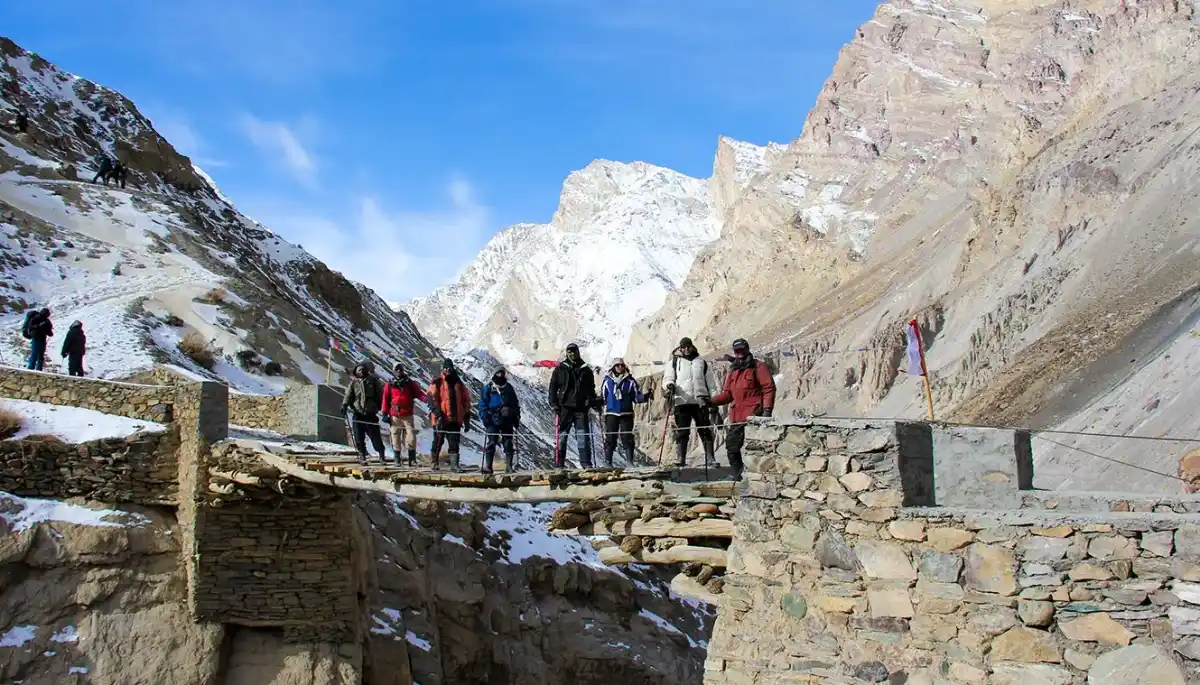
- Keep 1 or 2 buffer days in your travel plan.
- If buffer day is not used in the travel then it can be used to Explore Leh.
- Distance, Altitude, and Trekking hours are approximate and rounded off.
- Keep the original and copy of ID proof handy.
- Come one day early if planning to come by plane.
Day-1: Reporting day at Leh
Day-2: acclimatization day, day-3: medical test day.
- Wake up early and get ready for medical tests.
Day-4: Leh to Shingra Koma drive & Trek to Tsomo Paldar
Day-5: tsomo paldar to tibb cave.
- Altitude: 3,350 m/ 10,950 ft.
Day-6: Tibb Cave to Nerak
- Altitude: 3,400 m/ 11,100 ft.
Day-7: Nerak – Tibb Cave
- Trek Distance: 3 km | 5-6 hrs.
Day-8: Tibb Cave to Shingra Koma then Drive to Leh
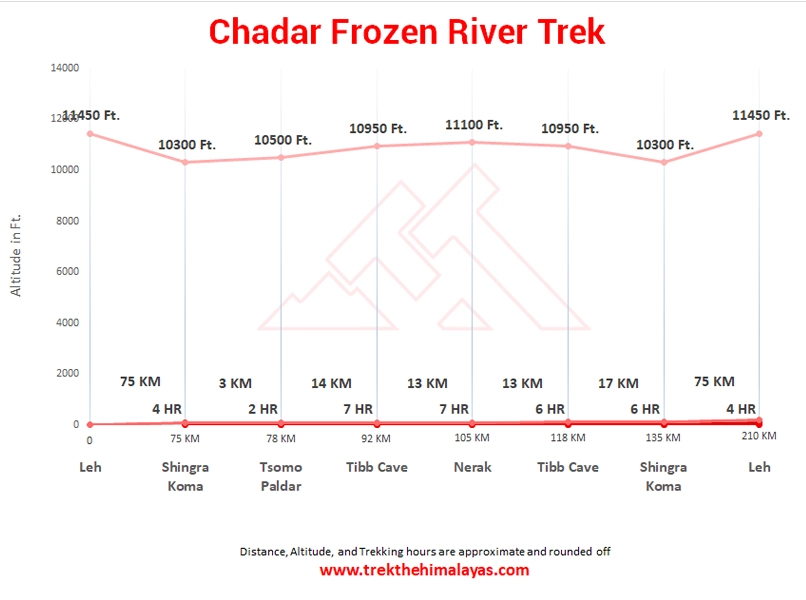
Pulse rate at rest must be in between (60 to 90 beats per minute).
Blood Pressure Reading must be in between (DIASTOLIC 70 – 90, SYSTOLIC 100 - 140 mm Hg).
Respiratory rate at rest must be in between (12 to 20 breaths per minute).
Should not have Liver and kidney issues.
Should not have Diabetes Mellitus, Bronchial Asthma, Heart problems, Hypertension, etc.
No pacemaker implant.
People with Sinus issues, Epilepsy please contact to trek coordinator before booking the trek.
If your BMI is not normal, Please contact our Trek coordinator before Trek booking.
Medical & Disclaimer Form (Mandatory Documents) Click here to download Medical & Disclaimer Form
- Government Employees can avail the benefit of Special Casual Leave (SCL) when they join us for a trekking expedition. As per the rules of the Pay Commission, Special Casual Leave can be availed for up to 30 days in a calendar year for trekking/mountaineering expeditions through a registered organization. Trek The Himalayas is a registered adventure tour operator by the Indian Mountaineering Foundation (IMF) and the Ministry Of Tourism (MOT).
- Trekkers have to apply for leave at least 20 days before the trek departure date.
- This service is exclusive to Indian government employees and is applicable only for treks within India.
- Do mail at info@trekthehimalayas to apply and mention your booked trek date and trek name.
Junior trekkers (below 15 years) should have a company of parents/guardians.
Trekkers between 15 to 18 years can come solo with the disclaimer form signed by parent/guardian.
- Medical & Disclaimer Form (Mandatory Documents) Click here to download Medical & Disclaimer Form
Exercise For Difficult
Fitness Regime For:
Calculate Your Bmi
Your BMI value is
Congratulations, your body is in good conditions!
Medical & Disclaimer Form (Mandatory Documents) Click Here.
How To Reach
It is essential for everyone to arrive at Leh (01:00 pm)
The only way to travel is to fly to Kushok Bakula Rimpochi Airport located in Leh. It is just 4 km away from the main city. The airport is well connected to Delhi and also receives flights from Mumbai, Srinagar, Jammu, Chandigarh and other general destinations in India. Even international travellers can fly directly from major cities like Kolkata, Mumbai and Delhi.
It's quite convenient to secure a cab from outside the airport to reach our hotel. Alternatively, you can inform your coordinator to arrange a cab for you. Upon booking the trek, your trek coordinator will furnish you with the hotel details.
Travelling by both the road routes, the Manali-Leh Highway and Srinagar-Leh Highway, is not possible since they are not open in the snowy winters of Ladakh.
The Manali-Leh and Srinagar-Leh highways are generally closed by October-November
For your return journey from Leh , you have to choose only air transport options. Please ensure an early check-out in the morning, as all flights operate during the morning hours.
It's highly advisable to keep 2 buffer day in your travel plan. If the buffer day is not needed, it can be used to explore Leh.
.webp)
1. Accommodation (as per the itinerary):
- Guest house (centrally heated room)(attached washroom) in Leh on Day 1, Day 2, Day 3 & Day 8 (twin sharing basis, triple in very rare cases).
- Camping during the trek (Day 4 to Day 7).
2. Meals (Veg + Egg):
- All meals while on trek. .
- Day 4 breakfast to day 8 lunch.
3. Support:
- 1 Versatile base camp manager handles communication and deploys extra manpower in emergencies.
- 1 Mountaineering & First aid qualified professional expedition leader.
- 1 Experienced high altitude chef.
- Local experienced guides (Number of guides depending on the group size).
- Enough support staff.
4. Trek equipment:
- Sleeping bag, Sleeping liners (if required), Mattress, Utensils.
- 3 men all season trekker tent (twin sharing), Kitchen & Dining tent, Toilet tent.
- Camping stool, Walkie talkie.
- Ropes, Helmet, Ice axe, Harness, Gaiters & crampons (if required).
5. First aid:
- Medical kit, Stretcher, Oxygen cylinder, Blood pressure monitor, Oximeter, Stethoscope.
6. Transportation (as per the itinerary):
- Leh (Guest house) to trekking point (Day 4).
- Trekking point to Leh (guest house) (Day 8).
7. Clock room service at Leh. 8. Mules/porters to carry the central luggage. 9. All necessary permits and entry fees, up to the amount charged for Indian. 10. Services from Leh to Leh.
1. Food in Leh. 2. Insurance (Mandatory). 3. Any kind of personal expenses. 4. Pick up and drop from Leh airport. 5. Mule or porter to carry personal luggage. 6. Emergency evacuation, hospitalization charge, etc. 7. Anything not specifically mentioned under the head Inclusion. 8. Any additional cost due to the final decision incurred by the Administrative. 9. Pre Medical Check-up and Rescue fee, Wildlife/environmental charges, ALTOA NOC, and entry fees up to 6K to 8 K paid to the authority on the spot.
Things can be provided on demand and availability (participant has to pay extra for these things).
1- Gamow/PAC HAPO Bag (Portable Hyperbaric Bag) - is a unique, portable hyperbaric chamber for the treatment of acute mountain sickness (AMS), also known as altitude sickness.
2- AEDs (Automated External Defibrillators) - are portable life-saving devices designed to treat people experiencing sudden cardiac arrest, a medical condition in which the heart stops beating suddenly and unexpectedly.
Cancellation terms:
Cancellations prior to 25 days from the start of the Trip
Refund options
- 5% deduction of trek fee
- 100% cash voucher for any trip till one year
- Transfer your trek (any trek, any date) to your friend
Cancellation between 24 days and 15 days to the start of the Trip
- 30% deduction of trek fee
- 100% cash voucher for same trip till one year
- 85% cash voucher for any trip till one year
- Transfer your trek (same trek, any date) to your friend
Cancellation between 14 days and 10 days to the start of the Trip
- 50% deduction of trek fee
- 80% cash voucher for same trip till one year
- 70% cash voucher for any trip till one year
- Book the same trek, in the same season, with any other batch
Cancellation less than 9 days to the start of the trek
- No cash refund
- 20% cash voucher for the same trip till one year
- 10% cash voucher for any trip till one year
- Transfer your trek (same trek, same date) to your friend
Note- If a booking is made using a voucher or discount code, the policies related to vouchers and discounts cannot be modified.
In the unlikely event that TTH cancels a trek prior to the scheduled departure date:
While it is extremely rare for TTH to cancel a trek, we understand that unforeseen circumstances or natural disasters may occasionally require us to do so before the scheduled departure. These circumstances could include continuous rain or snow, thunderstorms, snowstorms, landslides, floods, earthquakes, or any other natural calamity that poses a risk to the safety of our trekkers. Additionally, unforeseeable events such as local riots, curfews, pandemics, lockdowns, government orders, or any similar situations that compromise the safety of the trekking experience may also necessitate a cancellation.
In the event of such a cancellation, TTH will provide you with a voucher equivalent to the amount you paid for the trek. This voucher can be redeemed for any of our treks within the next year, allowing you to still enjoy an adventure with us at a later date.
The issuance of a voucher is not applicable in situations where you are required to descend from the trek for any reason. The trek leader may make the decision to send you down from the trek due to factors such as insufficient fitness level, symptoms of Acute Mountain Sickness (AMS), high blood pressure, exceeding the designated turn-around-time, health concerns, or if you are found smoking, drinking, or violating the rules set for the trek. In such cases, the provision of a voucher does not apply.
In the rare event that TTH shifts a trek:
We would like to emphasize that weather conditions in high-altitude areas are highly unpredictable and can undergo sudden changes at any time, irrespective of the day. Additionally, circumstances beyond our control, such as natural disasters, political unrest, pandemics, and lockdowns, may impact the feasibility of conducting a trek. In cases where we are unable to proceed with an event due to such circumstances that are beyond our direct control, we will make every effort to provide you with an alternative trek that is safer and more suitable.
In such situations, we will issue a voucher to offset the cost difference between the originally scheduled trek and the alternative trek. This voucher can be redeemed at any time within one year from the date of issue. Please note that a refund fee or reimbursement of the cost difference is not applicable in these cases.
- Change of trek batch is dependent on the availability of seats in the batch
- In case of transferring a trek to a friend, he/she should satisfy all the mandatory requirements put forward by TTH
- TTH holds the right to change/cancel the policies, without prior notice
- Cash refund is applicable only in case of bookings made without using any promotional offer code or vouchers
Cash Voucher Terms:
- This is a non-transferable voucher
- The voucher cannot be merged with any other offer of Trek The Himalayas
- The voucher is valid for Trek booked directly with Trek The Himalayas in India
- To avail the voucher please use your register phone number or e-mail id
- All the other Terms of booking a trek with Trek The Himalayas are applicable to the voucher
- Trek The Himalayas holds rights to add/remove any of the Terms and Conditions without prior notice
Itineraries are based on information available at the time of planning and are subject to change. "Trek The Himalayas" reserves the right to change expedition dates, people or itineraries as conditions warrant. If a trip must be delayed or the itinerary changed due to bad weather, road conditions, transportation delays, government intervention, airline schedules, sickness, or other contingency for which TTH or its agents cannot make provision, the cost of delays and/or other changes are the responsibility of the participant. TTH reserves the right to decline, or accept, any individual as a trip member for any reason whatsoever.
Trek Essentials
PDF Of Trek Essential Download
Frequently Asked Questions(FAQ)
How to register/create an account with tth.
To register with TTH, visit our website - www.trekthehimalayas.com and create your account. To create your account you will need to use your email address and fill in all the details, set your unique password and your account is ready to use.
How to book a trek?
- To book a trek with TTH, you first need to register with us and create an account.
- Choose the trek that you want to do and click on available dates.
- You will land at the login page, fill in the required details.
- Add Participants, choose add-on services click on the Pay now button, choose your preferred payment method, and make the payment. TTH accepts multiple payment options, including credit/debit cards, net banking, and UPI.
- You will receive a confirmation email from TTH with all the necessary details about the trek, including the meeting point, transportation, accommodation, and other important instructions.
Made a payment but did not receive any confirmation.
please send an email to us at [email protected] or reach out to the numbers provided in the Help and Support section of your Trek Page. We will ensure that your issue is promptly resolved.
How to book off-load luggage and transportation?
To book services such as off-load luggage and transportation, you can find them listed as add-ons. These additional services can be booked at the time of your initial booking. If you miss booking add-ons during the initial reservation, you can log in anytime and easily book 4 days before the departure date add-ons through the platform.
If I have booked the wrong trek or date, how can I make changes?
In such a situation, please log in to your account and transfer your trek or date to the desired one within 12 hours or drop us an email at [email protected] 10 days before the departure date of the trek. After the initial 12-hour period, any changes will be processed according to the cancellation policy.
I am a beginner and confused which trek to book.
We recommend visiting our "Suggest Me a Trek" page. By filling out the form, our experts will contact you with the best possible trek options based on your preferences and experience level. Alternatively, you can reach out to us via email at [email protected] or give us a call using the numbers provided on our website for personalized assistance and recommendations.
How is family trek different from regular trek?
Family treks differ from regular treks by focusing on ease of difficulty, offering shorter durations for younger participants, Kid-friendly and easily digestible foods, child-friendly activities, maintaining a higher guide ratio for diverse age groups, and implementing additional safety measures for families.
Ideal treks for children.
Family Trek with Kids recommendation Only Dayara Bugyal and Chopta Chandrashila Trek.
Minimum age for children to trek with TTH.
Minimum age for TTH treks is typically 7 years, though this may vary depending on the specific trek.
Can we take children to high altitudes with their guardian?
Yes, you can take a kids to a high-altitude trek with a parent. Discuss with a trek expert before booking a trek.
Can we send kids without Parents/guardian?
Medical & Disclaimer Form (Mandatory Documents) Click here to download medical and disclaimer form
How to prepare a child for a high altitude trek?
Physical Fitness: Ensure your child is physically fit. Engage them in regular exercise, outdoor activities, and hikes to build stamina and endurance. Hydration: Emphasize the importance of staying hydrated at high altitudes. Encourage your child to drink water regularly, even if they don't feel thirsty. Proper Nutrition: Provide a well-balanced diet with sufficient carbohydrates for energy and foods rich in iron to prevent altitude sickness. Adequate Sleep: Ensure your child gets enough sleep in the days leading up to the trek. Quality rest is crucial for altitude adaptation. Educate on Altitude Sickness: Teach your child about the symptoms of altitude sickness, such as headache, nausea, and dizziness. Encourage them to communicate any discomfort immediately. Appropriate Clothing and Gear: Dress your child in layers to adjust to changing temperatures. Ensure they have appropriate trekking gear, including sturdy footwear. Positive Mindset: Foster a positive mindset. Encourage your child, and let them know it's okay to take breaks when needed. Medical Check-Up: Schedule a medical check-up before the trek to ensure your child is fit for high-altitude activities. Consult with a healthcare professional about any potential health concerns.
Kind of food will be served during the trek for children.
TTH takes special care to provide wholesome and nutritious food for children on treks. Here are some of the foods that are typically served for children: Breakfast: For breakfast, TTH serves a variety of options like porridge, cornflakes, bread, butter, jam, honey, boiled eggs, omelettes, and pancakes. Children can choose from these options to fuel themselves for the day's trek. Lunch: For lunch, TTH serves lunch which includes rotis, vegetables, rice, dal, and salad. The rotis are usually made fresh on the trek and are a good source of carbohydrates. The dal and vegetables provide protein and other essential nutrients. Snacks: TTH provides healthy snacks like fresh fruits, dry fruits, energy bars, cookies, and biscuits to keep the children energized throughout the day. Dinner: For dinner, TTH serves a hot and wholesome meal which includes soup, rice, dal, vegetables, and a non-vegetarian dish (if requested in advance). Children can also choose from a variety of desserts like custard, jelly, and fruit salad. Dietary requirements: If a child has any special dietary requirements, TTH can cater to those needs as well. For example, if a child is lactose intolerant or allergic to nuts, the kitchen staff can make arrangements to accommodate those requirements.
How to choose the right trek?
Choosing the right trek for a beginner can be a bit overwhelming as there are many factors to consider such as distance, elevation gain, terrain difficulty, weather, and time of year. Here are some tips that can help you choose the right trek for a beginner:
1. Determine fitness level: Assess the fitness level of the beginner to understand their physical capabilities. This will help you select a trek that is challenging but not too difficult.
2. Choose a well-traveled trail: A well-traveled trail will have more amenities such as signposts, water stations, and shelter. It is also safer as there will be other hikers on the trail.
3. Consider the length of the trek: For beginners, it is recommended to start with a shorter trek that can be completed in a day or two. This will help them get acclimatized to trekking and build their confidence.
4. Look for gradual elevation gain: Choose a trek with a gradual elevation gain rather than steep ascents. This will make the trek easier and more enjoyable.
5. Check the weather: Check the weather forecast before selecting a trek. Avoid treks during the monsoon season or winter when the trails can be slippery or dangerous.
6. Research the trail: Read about the trail to get an idea of the terrain, altitude, and difficulty level. This will help you select a trek that is suitable for the beginner.
7. Consult with an expert: If you are unsure about which trek to choose, consult our trek expert Mr. Nitin (+91 70600 59773) between 10 AM to 6 PM (Tuesday - Friday). Mr. Nitin will provide you valuable advice and guidance.
Overall, it is important to choose a trek that is enjoyable, challenging but not too difficult, and suitable for the beginner's fitness level and experience.
Can a beginner choose a tough trek?
It is not recommended for a beginner to choose a difficult Himalayan trek. Trekking in the Himalayas can be physically and mentally challenging, especially if you are not used to the high altitude, steep slopes, and rugged terrain. Choosing a difficult trek without the proper experience, fitness level, and preparation can be dangerous and put you at risk of altitude sickness, injury, and other hazards.
If you are a beginner, it is recommended to start with an easier trek and gradually build up your skills and experience. This will help you understand the challenges of trekking in the Himalayas, and also prepare you physically and mentally for a more difficult trek in the future. It is also important to choose a trek that matches your fitness level, experience, and interest.
What is the age limit for a beginner trekker?
There is no specific age limit for a beginner trekker. However, it is important to consider your physical fitness, health condition, and personal interests before embarking on a trek. Trekking in the Himalayas can be physically and mentally demanding, and requires a certain level of physical fitness and endurance.
If you have any pre-existing medical conditions or are above a certain age, it is recommended to consult with a doctor before embarking on a trek. It is also important to listen to your body and take breaks as needed during the trek to prevent exhaustion or injury.
If I am solo, can I join the trek in a group?
Yes, you can join the trek. We have fixed departure groups where you can simply book your trek and we will take care of curating a group.
How does my family get updated about my Trek?
Before you start the trek, it is recommended that you make all the necessary phone calls as during the trek you may or may not receive network coverage, once you come back to the Base Camp, you can reconnect with your family via phone once again. You can share your trek coordinator contact detail with your family members to get the latest updates about your trek batch.
What food can I expect?
At TTH, we provide wholesome and nutritious meals during the trek. The food is vegetarian and includes a variety of dishes such as rice, dal, vegetables, chapati, paratha, pasta, noodles, and soup. We also offer snacks such as biscuits, and salty, and dry fruits during the trek. Special dietary requirements such as vegan, gluten-free, or Jain food can also be arranged if informed in advance.
I am allergic to some foods.
If you are allergic to some foods, you need to let us know in advance so that we can make arrangements accordingly.
How safe is trekking with TTH?
TTH is a trekking company that prioritizes the safety of all its participants, including women trekkers. They have a comprehensive safety system in place, which includes a dedicated team of experienced and trained trek leaders and support staff who are equipped to handle emergency situations and provide first aid.
TTH also takes specific measures to ensure the safety and comfort of women trekkers. They have a separate tent accommodation for women trekkers, female trek leaders, and support staff. They also provide separate toilet facilities for women and encourage a safe and respectful environment for all trekkers.
Moreover, TTH has a strict policy against any kind of harassment and has a zero-tolerance policy towards such incidents. They have a designated Internal Complaints Committee (ICC) to investigate and address any complaints related to harassment or misconduct. Overall, TTH has a good reputation for safety and responsible trekking practices, and women can feel comfortable and safe while trekking with them.
How TTH will manage if I am the only woman in the group?
In case you are the only women in the group, we provide a single sleeping arrangement. Also, during the trek, the trek leader will always remain by your side to provide optimum safety and reassurance.
How can I know that other women are in the batch?
You can reach out to the trek coordinator to inquire about the number of female trekkers and their respective states who have booked the trek. Please note that the trek coordinator cannot disclose personal details of any trekker. Once you've confirmed your booking, a WhatsApp Group will be created for all the trekkers in your batch. This allows you to connect with fellow trekkers before the trek begins.
Can I know in advance, which trek is led by a women Trek Leader?
While many of our treks are led by female trek leaders, however, it is not possible to know which trek leader is assigned to which group. But nonetheless, whether the trek leader is male or female you can be completely assured of your safety and security with us.
Can I trek with periods? If yes, then where can I dispose of the sanitary pad?
Yes, it is possible to trek with periods. However, it is important to take some extra precautions and preparations to ensure a comfortable and safe trekking experience.
Here are some tips that can help you trek during your period:
1. Use menstrual hygiene products that you are comfortable with, such as tampons, pads, or menstrual cups. It is recommended to carry enough supplies for the entire duration of the trek.
2. Pack wet wipes, hand sanitizer, and plastic bags to dispose of used hygiene products.
3. Wear comfortable and breathable clothing that allows for easy movement and reduces friction. Avoid wearing tight or restrictive clothing that can cause discomfort.
4. Carry pain relief medication, such as ibuprofen or acetaminophen, in case of menstrual cramps.
5. Stay hydrated and maintain a balanced diet to support your energy levels and overall health.
6. Take breaks as needed and listen to your body. If you feel uncomfortable or experience any unusual symptoms, seek medical attention immediately.
It is also recommended to consult with a doctor before going on a trek during your period, especially if you have a pre-existing medical condition or are taking medication. By taking necessary precautions and being prepared, you can have a safe and comfortable trekking experience even during your period.
We provide proper disposal facilities for sanitary pad disposal during the trek.
How will the accommodation be during the trek?
We offer three person tents with twin-sharing for optimum comfort. A woman trekker will share a tent with another woman trekker and if you are the only woman in the group, you will be given a single accommodation for your comfort and privacy.
Are trek poles, Jackets and other equipment available for rent from Trek The Himalayas?
Yes, we do provide gears on rent. You can book it using you TTH account directly.
Who will be with us on the trek from Trek The Himalayas?
Mountaineering qualified Experienced and first aid certified Trek Leader, First Aid Certify local guide, Cook, helpers and supporting staff.
Who can not join the trek?
People suffering from Bronchitis, Asthma, High blood pressure, Epilepsy (got faints), TB , Heart problem or on higher BMI side are strictly not allowed to go on any Himalayan trek. Apart from this if you had any medical history, please let us know.
When it gets really cold can I consume alcohol?
No. Alcohol and smocking isn’t allowed while on trek. It is totally misconception that it will keep you warm. Your body need to acclimatize properly and for that eat properly and drink enough water; these things will keep you warm.
What type of toilet facility is TTH providing at the trek?
Toilet tents provide a convenient solution for answering nature's call in the great outdoors. Dry toilets, in particular, offer a highly sanitary approach. By digging a pit and utilizing mud and a shovel, you can easily cover up your waste. This method ensures cleanliness and hygiene while camping or exploring in the forest.
Remember to pack essential toiletries to complete your outdoor bathroom kit and maintain proper personal hygiene during your adventures. With these practices in place, you can enjoy nature while also respecting it.
How do I manage the negative temperatures on the trek at higher camps? Do I need special jackets?
Layer Up From Head To Toe Eat Full Meals, never sleep empty stomach You can keep warmee (if you’re more susceptible to cold). Use sleeping bag in right way and don’t leave free space in sleeping bag.
For upper body – Thermal layer – T-shirt (full-sleeves) – Fleece T-shirt (for extreme colds) – Fleece layer – Thick Jacket/Down Jacket – Waterproof or Windproof layer (outermost layer, when it is snowing or raining) - For Lower Body – Thermal layer – Hiking pants (normal) or Winter hiking pants
Based on how warm you feel you can skip any of the above layers. Your outer later should be windproof since it is windy at high altitude. The idea behind layering is that the more insulation you have the less cold you feel, and instead of wearing a very thick jacket if you wear multiple layers, your body will be better insulated against the cold.
Do you provide crampon/micro spikes and gaiters?
Yes, we provide micro spikes and gaiters, if required.
What documents need to carry on trek?
Mandatory documents: 2 xerox of ID having address (addhar card/driving license), 2 Passport size photographs, hard copy Medical form signed & sealed by doctor, disclaimer form sign by trekker and high altitude insurance.
If we come prior the trek date, Do you provide accommodation?
No. We don’t but we can suggest you good hotel/Stay nearby pick up location.
Do we get enough water for drinking?
Yes, trekker must carry 2 water bottles 1 litre each so they can refill it at campsite for drinking and keep themselves hydrate.
What kind of shoes we should buy for the trek?
You should buy shoes which has these three features –Good grip, Ankle Support and additional water resistant layers. Generally, we advise Quechua Trek 100, MH 500 and MH 100.
What happens if some members of the team need to turn back before the summit?
No one is forced to go on. There is always enough staff to split the party according to need and regroup later at the camp. Most people have no trouble reaching the highest campsite. If some members decide not to climb the final distance they can wait for the climbers to come back down the same way or take a lateral path to the descent route.
What is Chadar Trek Frozen River?
The Chadar Frozen River Trek is a popular winter trek in the Indian state of Jammu and Kashmir. It involves walking on a frozen river, the Zanskar River, which is transformed into a thick sheet of ice during the winter months. The trek is known for its scenic beauty and challenging terrain, as well as the unique experience of walking on a frozen river.
When is the best time to do the Chadar Trek?
The best time to do Chadar Frozen River Trek is during the months of January and February when the river is frozen enough to support the weight of trekkers.
What is the difficulty level of Chadar Trek Frozen River?
Chadar Trek Frozen River is a Difficult Grade Trek.
What is the duration of the Chadar Trek Frozen River?
It is an 8 days long trek.
Are there any altitude-related concerns on the Chadar Trek?
Yes, altitude-related concerns can be a factor on the Chadar Frozen River Trek . The trek starts at an altitude of around 3,300 meters and reaches a maximum altitude of approximately 3,850 meters . While this may not be extremely high, it is still significant enough to cause altitude-related issues for some trekkers.
Altitude sickness, also known as acute mountain sickness (AMS), is a common concern on the Chadar Trek . Symptoms of AMS can include headache, nausea, dizziness, and shortness of breath. Trekkers can take several precautions to avoid AMS, such as acclimatizing properly, drinking plenty of fluids, and taking necessary medications.
It is also essential to be aware of frostbite and hypothermia, which can occur due to exposure to cold temperatures and wind on the trek. Trekkers should dress in layers, wear proper gear, and stay warm to prevent these conditions.
Overall, while altitude-related concerns are something to keep in mind, with proper preparation and caution, many trekkers are able to successfully complete the Chadar Frozen River Trek without any significant issues..
What kind of gear is needed for the Chadar Trek?
The Chadar Frozen River Trek is a challenging winter trek that requires specialized gear to ensure the safety and comfort of trekkers in extreme cold and icy conditions. Here are some essential gear items needed for the trek:
1. quality trekking boots with sturdy soles and good traction to provide adequate grip on slippery ice.
2. Warm and waterproof clothing, including thermal layers, fleece jackets, and down jackets, to keep you warm in sub-zero temperatures.
3. Waterproof gloves or mittens and socks to keep your hands and feet dry and warm.
4. A warm hat and a balaclava or a face mask to protect your face from the cold winds.
5. Sunglasses to protect your eyes from the glare of snow and ice.
6. Trekking poles to help maintain balance and stability on the icy terrain.
7. Sleeping bags are rated for sub-zero temperatures to ensure a good night's sleep in the extreme cold.
8. Headlamp or flashlight with extra batteries to navigate in the dark.
9. First aid kit including altitude sickness medication, pain relievers, and basic medical supplies.
10. Backpack with at least 60 liters capacity to carry all your gear and supplies.
What kind of food will be provided during the Chadar Trek?
During the Chadar Trek , TTH provides all meals, including breakfast, lunch, and dinner. The meals are prepared by a team of experienced cooks, who use fresh and locally sourced ingredients to provide nutritious and tasty food to the trekkers.
Is it necessary to have the prior trekking experience to do Chadar Trek Frozen River?
While prior trekking experience is not strictly necessary for the Chadar Frozen River Trek , it is highly recommended that trekkers have some level of physical fitness and experience with hiking or trekking in challenging terrain. The trek is considered to be a moderately difficult trek, and the icy conditions can make it even more challenging.
It is important to note that the Chadar Trek requires trekkers to walk on a frozen river, which can be slippery and unstable. Trekkers must also navigate through narrow gorges, steep canyons, and frozen waterfalls, which can be physically demanding. Therefore, it is recommended that trekkers engage in regular physical exercise and prepare themselves mentally and physically for the trek.
Additionally, trekkers need to be prepared to face extremely cold temperatures, which can drop to as low as -25 degrees Celsius at night. Therefore, it is essential to have appropriate gear and clothing to keep warm and protect against frostbite and hypothermia.
What kind of physical fitness is required for Chadar Trek Frozen River?
It is recommended that trekkers engage in regular physical exercise and prepare themselves mentally and physically for the trek.
Here are some specific physical fitness requirements for the Chadar Frozen River Trek:
1. Cardiovascular endurance: Trekkers need to have good cardiovascular endurance to tackle challenging terrain and high altitude. Regular cardio exercises such as running, cycling, or swimming can help improve endurance.
2. Strength training: Trekkers need to have strong leg and core muscles to maintain balance and stability on the icy terrain. Strength training exercises such as squats, lunges, and planks can help build these muscles.
3. Flexibility: Trekkers need to have good flexibility to prevent muscle strain and injuries. Regular stretching exercises such as yoga or Pilates can help improve flexibility.
4. Mental toughness: The Chadar Trek can be mentally challenging due to the extremely cold temperatures, long hours of walking, and unpredictable weather conditions. Trekkers need to be mentally prepared to face these challenges and stay motivated.
It is important to note that the physical fitness requirements for the Chadar Trek can vary depending on the individual's age, health, and fitness level. It is recommended that trekkers consult with a doctor or a fitness trainer before embarking on the trek to assess their physical fitness and determine any necessary precautions or preparations.
Is it necessary to hire a guide for the Chadar Trek?
It is highly recommended. The Chadar Trek is a challenging trek that requires specialized gear, experienced guides, and support staff to ensure the safety and well-being of trekkers. Hiring an expert trekking organization can provide many benefits, including safety, specialized gear and equipment, and logistics and support.
- Date and Price
Rent A Gear
Trek Articles
Quick Links
Trekking & Hiking
Mountaineering
Multi Sports
Himalayan Pilgrimage
Website Privacy
Terms & Condition
Contact Info
Get in touch with us. E-mail us Monday-Saturday (10 AM to 6 PM)
Address: Trek The Himalayas, Kaintura Plaza, Badrinath Road Tapovan, Rishikesh - 249201 Uttarakhand
Phone: 8191004846
Email: [email protected]
2010 Trek The Himalayas. All rights reserved

Chadar Trek
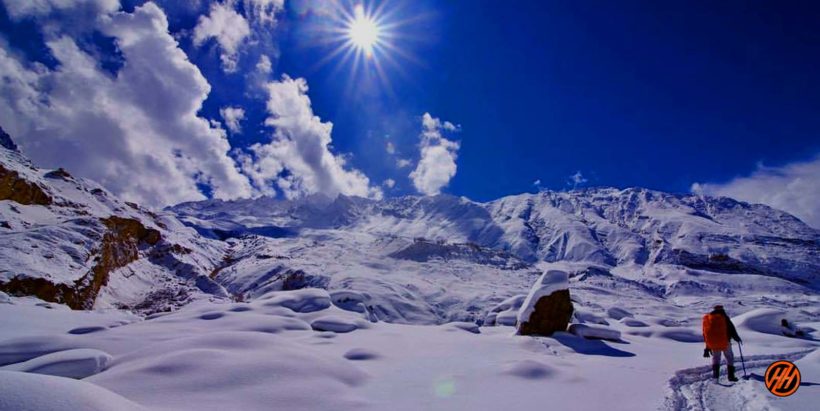
Description
Reviews (2), things to take, available dates, include / exclude, chadar trek in leh – over the zanskar river range of ladakh-2024- complete information, itinerary, costs date.
Your trek journey started with Himalayan Hikers , beautiful mountain town of Leh, all our trekker reach Leh by flight this is best option to you reach to Leh, altitude is 11400 feet above sea level, the trek beautiful Zanskar River which liws totally frozen during the December to Feb, Peak Winters Trek , So, probably the best time to do Chadar Trek is February because the ice remains harsh and stable. Trek starts from the freezing point of Zanskar River and that is Chilling.
Therefore, the “Chadar trek” is also known as “The Frozen River Trek”. This Trek is over a frozen river in the Zanskar region of Ladakh and it is different from all other treks in the Himalayas.
The snow appears as a thick sheet of snow, therefore, it is called “Chadar trek” and it is one of the trickiest treks in the world which is done in peak winter months. On this trek explore the Zankari culture and get to know about it in close proximity and the main highlight of this Frozen River Trek is a completely frozen waterfall “Nerak”.
The Chadar Trek is a popular winter trek in the Zanskar region of Ladakh, India. Here are some highlights of the trek:
- Trekking on the frozen Zanskar River: The highlight of the Chadar Trek is the experience of walking on the frozen Zanskar River, which transforms into a thick sheet of ice during the winter months.
- Breathtaking views: The trek offers breathtaking views of the frozen landscape, towering mountains, and the gushing river beneath the ice.
- Cultural experience: The trek also offers a unique cultural experience, as trekkers get to interact with the local Zanskaris and witness their way of life in the harsh winter conditions.
- Adventure: The Chadar Trek is a challenging trek that requires physical endurance and mental toughness. Trekking on the slippery ice, crossing icy-cold streams, and camping in freezing temperatures make it an adventure of a lifetime.
- Photography opportunities: The trek offers numerous opportunities for photography enthusiasts to capture stunning landscapes and unique cultural experiences.
Overall, the Chadar Trek is a must-do trek for adventure and nature lovers who are up for a challenging winter trekking experience.
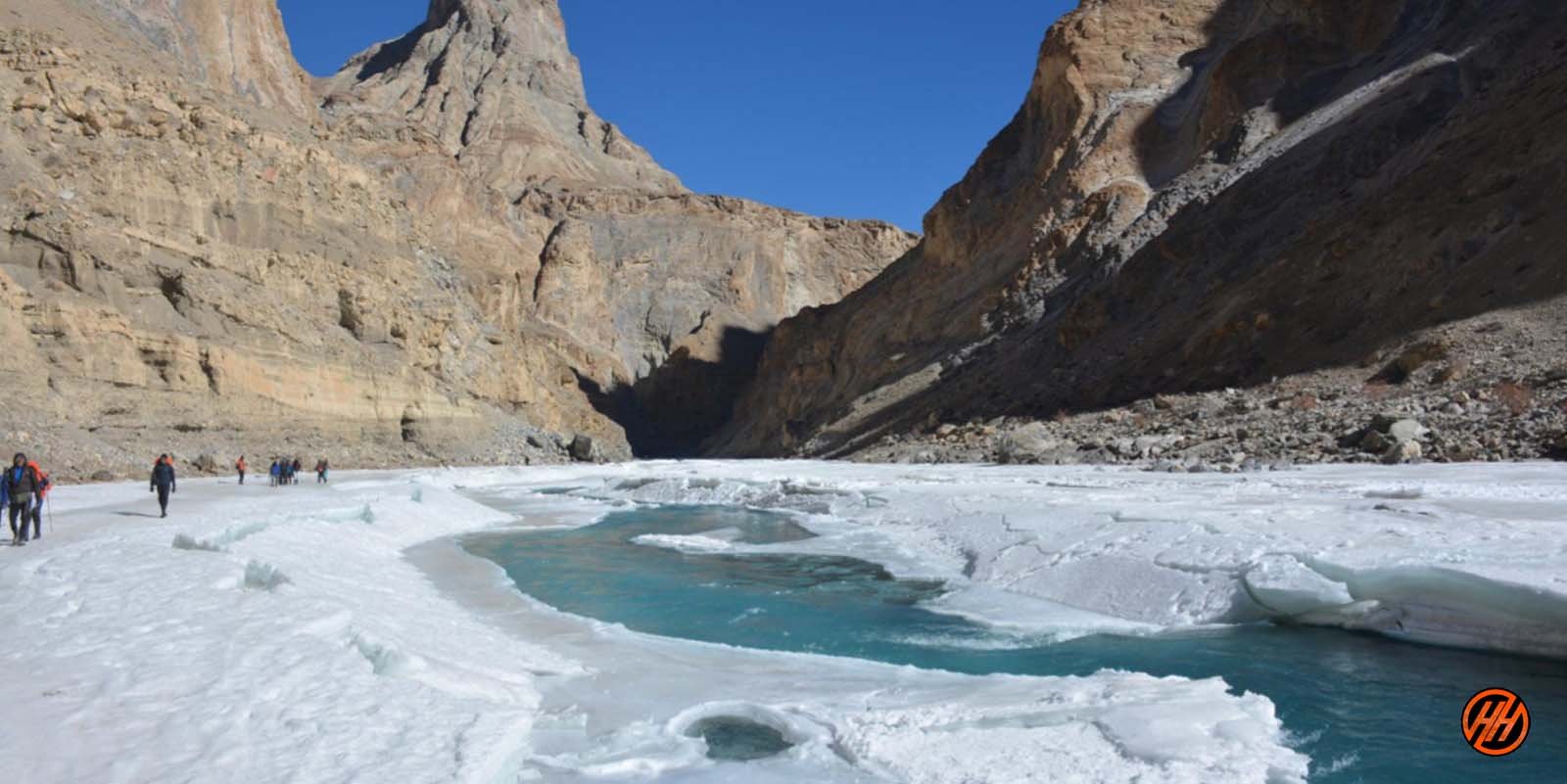
Ice Covering and Freezing Cold in Chadar Trek
The Chadar trek is over a frozen river and the ice can turn dangerous sometimes but can also be safe the other times. But, it is important to find a safe path over the perilous sheet of ice.
During the trek, you do not camp here at the meadows or the forest clearings but inside the caves which are present along the banks or you set up the tents at stable ice.
Here, the temperature remains chilly and freezing (-20) and falls down at night, so keep warm layers to protect the body against chilly cold and prevent the freezing of blood.
Best Time to Visit Chadar Trek
The best time to do the Chadar Trek is during the winter months, from January to February, when the Zanskar River freezes and forms a thick sheet of ice that is suitable for trekking. During this time, the weather is cold and dry, with clear blue skies and minimal precipitation.
It is important to note that the timing of the trek also depends on the weather conditions and the formation of the ice sheet. It is essential to have experienced guides and a reliable trekking organization to provide up-to-date information on the ice conditions and weather forecast.
Additionally, it is recommended to plan the trek in advance and book with a reputable trekking organization like Himalayan Hikers Trekking Organization to ensure availability and to have the necessary permits and logistics in place.
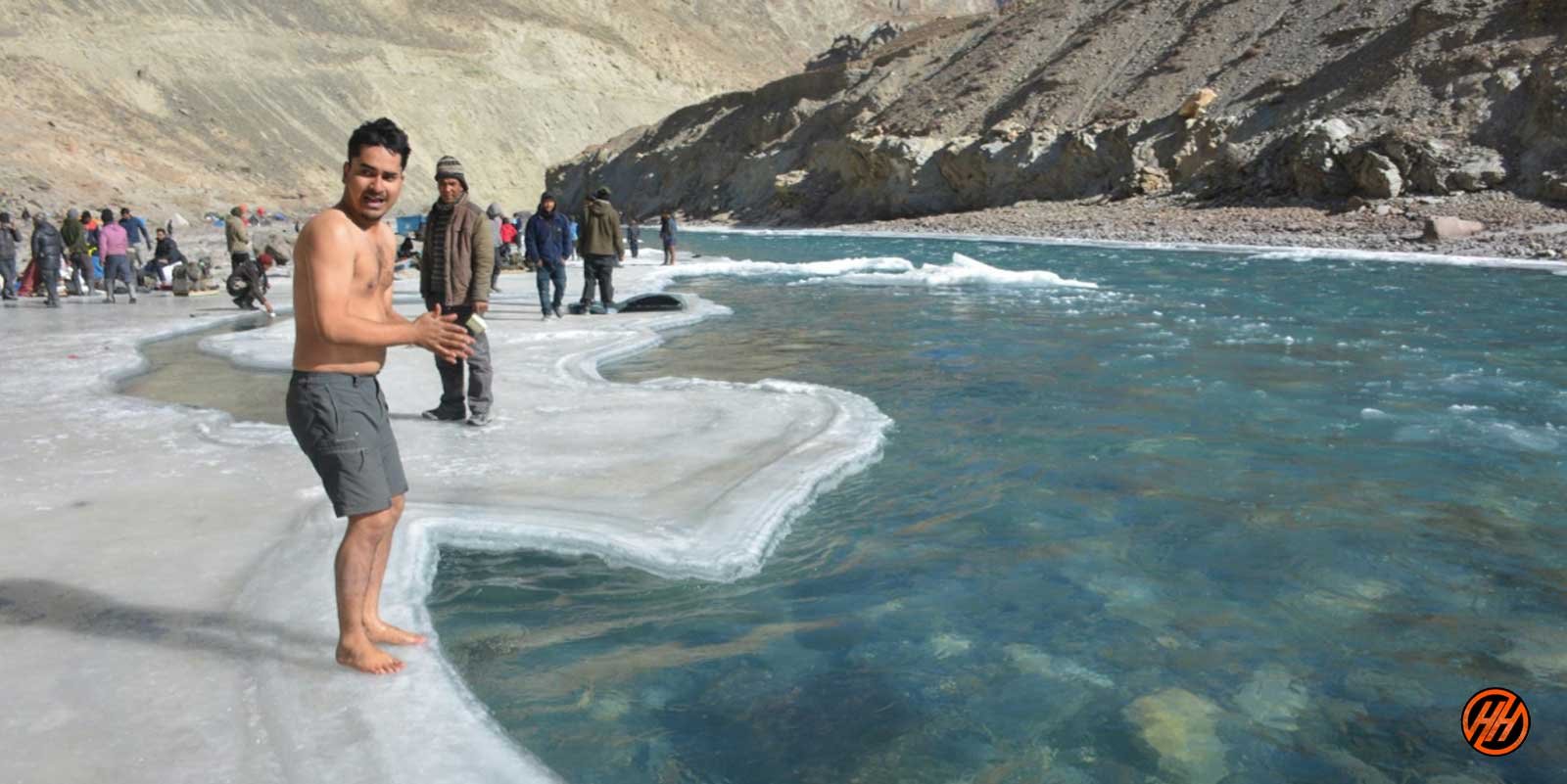
Be Aware During Chadar Trek (Not for Beginners)
You need to be very aware of the stability of ice and conditions below the feet for a safe trek. Sometimes the ice isn’t stable and the choices go wrong so walk carefully if suddenly a crack appears to go fast to the place where the ice is
So, choose a camping spot wisely after properly analyzing the area.
Here are some tips to do Chadar Trek –
Analyze the ice sheet conditions.
Avoid the cracks in the ice.
Walk carefully on the slippery areas.
Run immediately to a stable area if a sudden crack appears under your feet.
Walk on the places with a coating of snow.
Choose camping spots wisely.
Alcohol and smoking are not allowed in during the trek
Level- Difficult
During the trek, proper conditioning & training of body required
Need proper gear & clothing for sub-zero temperature
Shoes are the single most important equipment.
High Altitude requires proper acclimatization. Of base camp Leh
Beautiful landscapes so carry good photo gear & Extra battery backup.
Travel headlight
The backpack should not exceed 12 kg.
Long Gumboots are mandatory to all trekker
About Leh – Ladakh – The Land of High Passes
Area: 98,000sq km
Altitude: 7,500m Max.
Population: 250,000
Religion: Buddhism, Islam. Hindu
Geographical Status: Cold Desert
Across the Kashmir Valley and over the famous Zoji La pass lies Ladakh, the Land of High Passes. It is a magical land, so completely different from the green landscape of some other parts of the Himalayas. It is nature at its extreme. A land of freezing winds and blazing sunlight, Ladakh is a cold desert lying in the rainshadow of the Great Himalayas and other smaller ranges. Little rain and snow reaches this dry area, where the natural forces have created a fantastic landscape.
Ladakh forms part of the state of Jammu and Kashmir in India. Parts of Ladakh are under the illegal occupation of Pakistan and China. The border of Ladakh touches those of Afghanistan, Pakistan, China, the Kashmir Valley (India) and Himachal Pradesh (India). This region is made up of two administrative districts — Leh District, with its headquarters at Leh, and Kargil District, with its headquarters at Kargil –and covers a total area of about 59,000 square kilometers.
Ladakh is at an average elevation of 2,700 m to 4,200 m. The aridity of this region is due to its location in the rainshadow area of the Great Himalayas, elevation and radiation of heat from the bare soil. The most striking physical feature of Ladakh, however, is the parallelism of its mountain ranges. The region is extremely dry, with an annual rainfall as low as 10cubic centimeter.
In Ladakh, large rivers and their tributaries have carved deep gorges far below their steep banks. However, their water is not of much use as the terraced fields lie high above the gorges.
Until the advent of the aircraft, Ladakh could only be reached over dangerous, high passes. The Zoji La pass connecting Ladakh to Kashmir is at 14,000 ft and is the lowest approach from the west. The southeast approach has to cross the 18,200 ft high Tanglang La. And to the north lie the Saser La and Karakoram passes, gateways to Central Asia from where trading caravans used to come for many centuries.
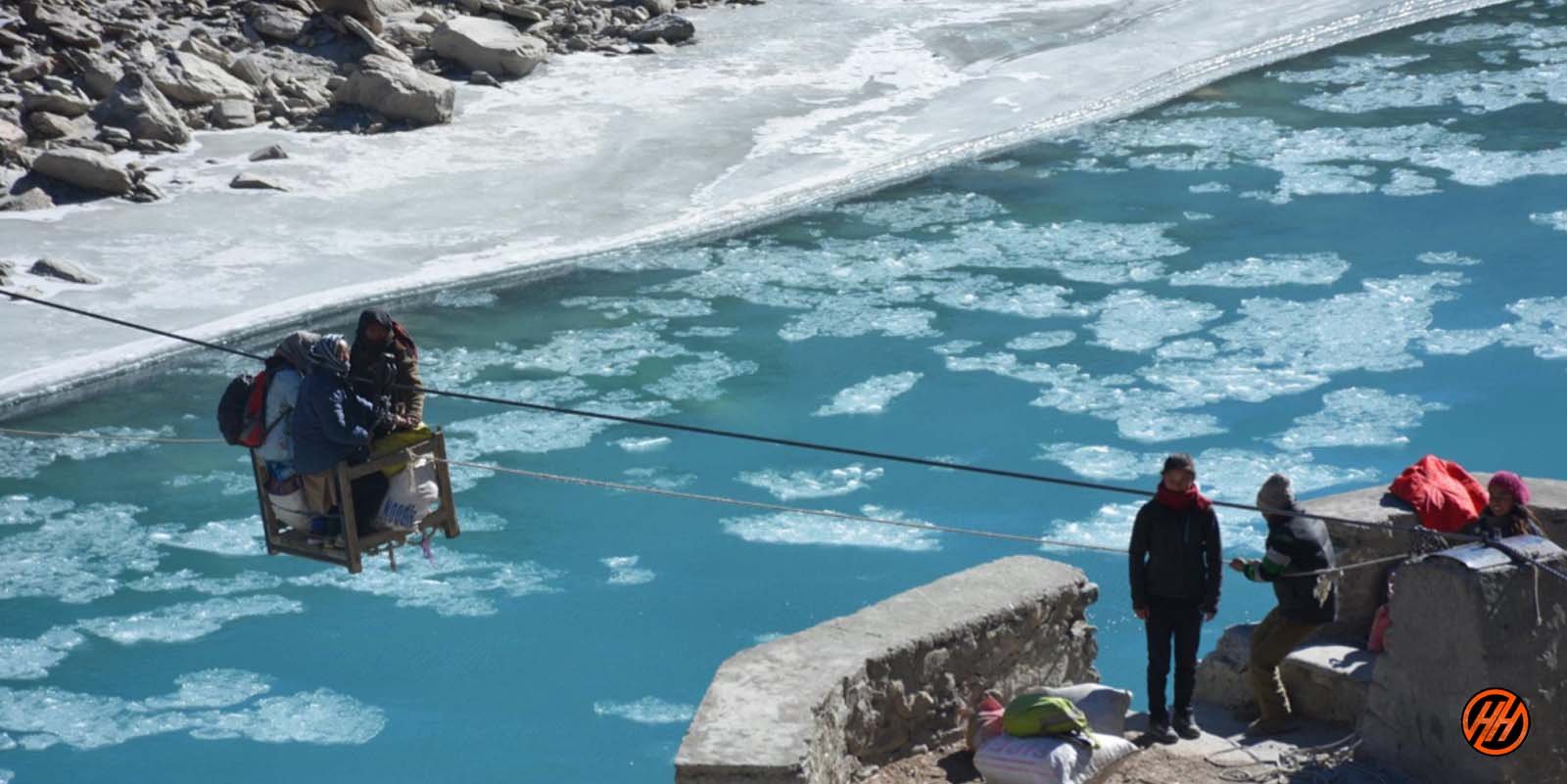
Altitude we are going to cover in Chadar Trek
Leh – 3500 Meters
Tsomo Paldar camp – 3200 Meters
Tibb Cave camp – 3300 Meters
Nerak camp – 3400 meters
The temperatures during the Chadar Trek
The temperatures during the Chadar Trek can be quite cold, as it takes place during the winter months when the region is covered in snow and ice. The average temperatures during the trek range from -10°C to -20°C (14°F to -4°F) during the day, and can drop to as low as -30°C (-22°F) at night. However, it is important to note that temperatures can vary depending on the weather conditions, altitude, and time of day.
It is crucial to have proper clothing and gear to stay warm during the trek, including warm base layers, a down jacket, insulated pants, waterproof gloves, and a warm hat. Additionally, it is important to stay hydrated and eat nutritious food to maintain energy levels and stay warm. Experienced trekking organizations like Himalayan Hikers Trekking Organization provide detailed information on what to wear and pack for the Chadar Trek to ensure a safe and comfortable trekking experience.
ATM Point & Mobile connectivity in Chadar Trek
ATM POINT: Hi trekker ATM available is Leh Withdraw money before your journey,
Mobile Connectivity: There will be available all networks only postpaid
Key Points of Chadar Trek
Duration: – 08 Nights 09 Days from Leh to Leh
Base camp: – Leh
Winter Temperature:- Day -5°C to -15°C) Night – 12° C to -20° C
Chadar trek – Altitude: – 11400 feet
Best Time: – Jan or Feb
Trek Level: – Difficult
Trek distance: – On foot 57 Km – By taxi 140 km
Group Size: – minimum of 05 people maximum of 15 people
Temperature
The winter temp. touches as low as minus 30 degree (Leh & Kargil) and minus 60 degree in (Drass) subzero temp. prevails from December to February throughout Ladakh, whereas, zero degree temp. is experienced during rest of winter months. This results in freezing of all conceivable water resources. During summers the maximum temp. increases from 20 degree C to 38 degree C in July and August
Clothing: Light/Medium woolens in summers to Heavy woolens in winter
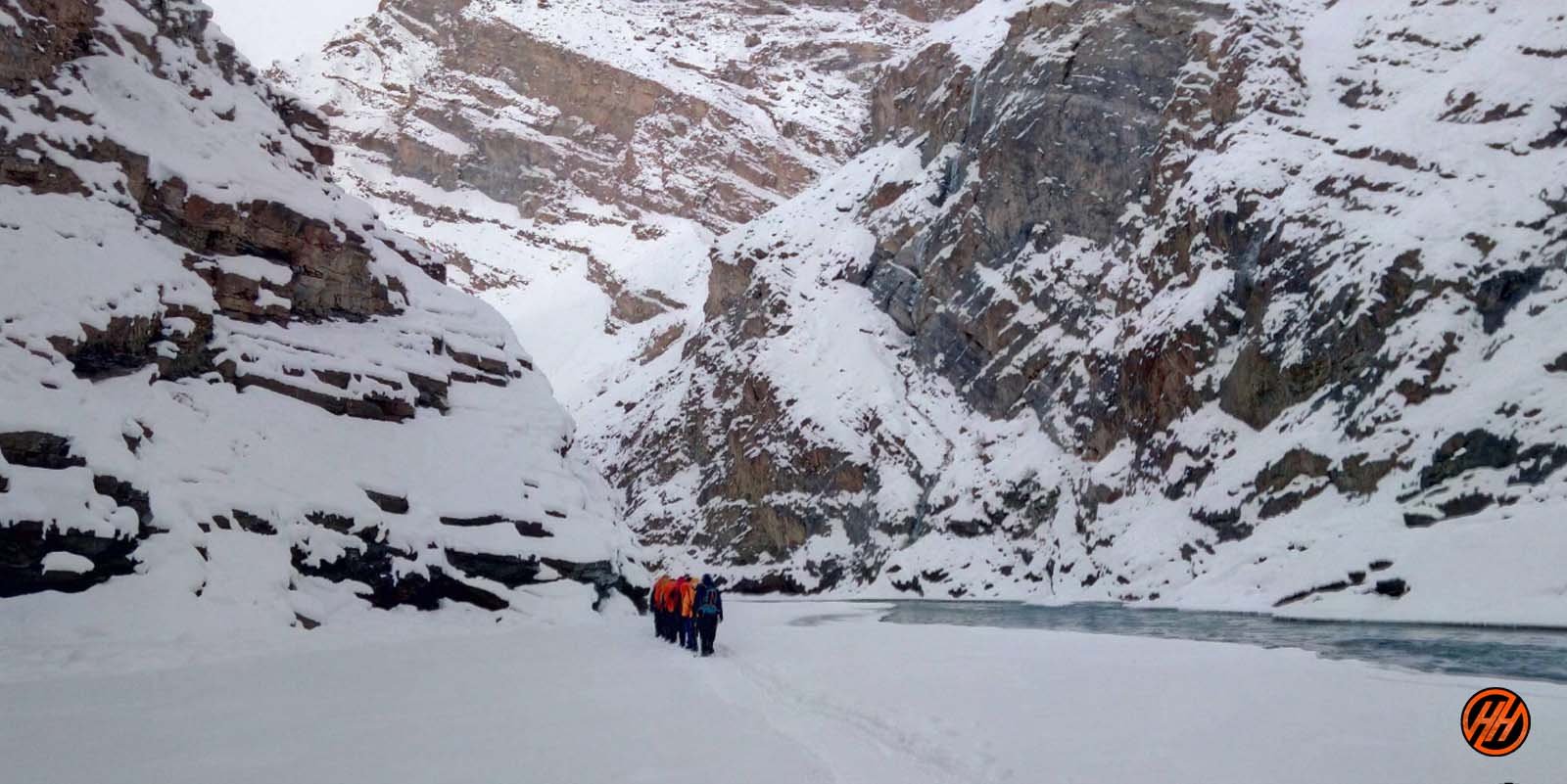
Languages Spoken
Ladakhi is the main language of Ladakh. Other languages spoken are Balti, Shina, Brokshat and Changshat. In hotels and restaurants, staffs speak English and Hindi, while tourist guides are well versed with the language.
Key Points about Chadar Trek
– Level: Difficult (so first-timers trekkers should avoid)
– Proper conditioning & training of body required
– Group size minimum of 05 maximum of 15 people
– Need proper Expedition gear & clothing for sub-zero temperatures?
– Shoes are the single most important equipment
– High Altitude requires proper acclimatization
– Phones don’t work on the trek, we are provide to you Radio Walkie Talkie for Communication
– Beautiful landscape so carry good photo gear (I couldn’t carry my best equipment)
– Travel light (my backpack was heavy at about 12 kg to 15 Kg )
– Keep an extra day in your itinerary for attempt to Chadar trek summit account for bad weather
– Alcohol and smoking is not allowed in during the Chadar Trek Expedition
Difficulty level
Because the top is relatively high in elevation, we strongly recommend a reasonable level of physical fitness. The arduous journey of Chadar trek winter hiking with longer distances and ascending elevations to be covered in a short span of time would require acclimatization. We advise trekkers to physically and mentally prepare themselves prior to this trek. Throughout the course, all groups will be guided by our experts for trekking equipment and any impending terrain.
Any medical assistance that is required will be provided at any point of the journey; however, trekkers must consult their professional care before beginning any trek. We also strongly advise trekkers to learn about altitude sickness and to notify our teams as soon as any symptoms appear.
Short Itinerary of Chadar Trek
Day 1:- Arrival at Leh – pickup to you from Airport drive to Hotel check in Rest and Acclimatization overnight stay Hotel
Day 2:- Trek Planning and Briefing – Acclimatization and Preparation- meet us our Himalayan Hikers Guide overnight stay
Day 3:- Medical Test Day in Leh
Day 4:- Drive from Leh to Bakula (70 km) (2 hours) same Day Trek Bakula to Shingra Koma 2/3 Hours overnight stay Camp
Day 5:- Trek from Shingra Koma to Tibba (16 km) (6/7 Hours) overnight stay Camp
Day 6:- Trek from Tibba to Nerak Waterfall (12 km )( 6/7 Hours) overnight stay Camp
Day 7:- Trek from Nerak to Tibba (16km ) (6/7 hours) overnight stay Camp
Day 8:- Trek from Tibba to Bakula (12 km) (6/7 hours) Same day Drive to Leh Hotel
Day 9:- After breakfast Depart from Leh
permit and passport.
Tourist don’t require permit for Leh, however, all foreigners are required to be registered at Drass, Rumtse and Serchu if they are travelling overland. Those traveling by air get themselves registered at airport. Tourists are required to get permit for restricted areas like Tsomoriri, Tsokar and Pangong Lakes, Dhahanu and Nubra Valley, which can be obtained from District Magistrate, Leh, through Travel Agents at Leh.
Avoid acute mountain sickness
Acute mountain sickness can occur to any one at an altitude above 10,000 ft. above sea level, therefore, make it sure to take complete rest on the day of arrival.
How to Reach Leh or ladakh
Overland Approach
Overland Approach – The overland approach to Ladakh from Kashmir Valley via Kargil is approx. 434 Km, which remains open for traffic from early June to November. The most dramatic part of this road journey is the ascent up the 11,500 feet / 3,505 m high Zoji-La, the pass in the Great Himalayan Wall that serves as the gateway to Ladakh. The J & K State Road Transport Corporation (J&K SRTC) operates regular Deluxe and Ordinary bus services between Srinagar and Leh on this route with an overnight halt at Kargil. Taxis (cars and jeeps) are also available at Srinagar for the journey. Groups can charter Deluxe and A-class buses for Leh, Kargil or Padum (Zangskar) from the J & K SRTC at Srinagar.
Manali to Leh – Since 1989, the 473 km. Manali-Leh road has been serving as the second overland approach to Ladakh. Open for traffic from around mid-June to early October. This high road traverses the upland desert plateau of Rupsho, altitude ranges from 3,660m to 4,570m. A number of high passes fall enroute among which the highest one known as Taklang-La is world’s second highest motorable pass at an altitude of 17,469 feet/5,235m. Himachal Pradesh Tourism, HRTC and J & K SRTC operate daily Deluxe and Ordinary bus services between Manali and Leh. The bus journey between Leh and Manali takes about 19 hours or two days with an overnight halt in camps at Serchu or Pang. Shared taxis are also available both from Leh and Manali
Road Distances
Srinagar-Leh 434 Km
Manali-Leh 473 Km
Srinagar-Kargil 204 Km
Delhi-Leh 1047 Kms
Leh-Kargil 234 Km
Kargil-Padum (Zanskar) 240 Km
Leh-Deskit (Nubra Valley)118 Kms.
Credit Cards & ATM Machine
Credit cards are accepted by very few hotels and tour operators but there will be 2.5% service charge. The Jammu and Kashmir Bank and State Bank of India has placed ATM Machine in Leh. The State Bank of India accepts visa and mastero but this ATM is not very reliable. J&K Bank ATM is more reliable but accepts only Mastero.
Indian Airlines www.indian-airlines.nic.in operates regular flights to Leh from Delhi (fare USD 135), Four flights in a week from Jammu and once in a week from Chandigarh and twice from Srinagar. Jet Airways www.jetairways.com also operates daily flights between Leh-Delhi (fare USD 143).
Internal Transport
The cheapest way to travel within the region is by public buses, which ply on fixed routes according to fixed time schedules. The most comfortable and convenient though expensive mode of travel, however, is by taxi, which are available for hire on fixed point-to-point tariff. For visits to the newly opened areas of Nubra, Dah-Hanu, Tsomoriri, Tsokar and Pangong Lakes. It is mandatory to engage the services of a registered/recognized travel agency for making all the requisite arrangements including internal transport. Detailed information about bus schedules, taxi tariff, travel agencies can be obtained from the Tourist Office or Local travels guide “Reach Ladakh”, available at Book Shops.
Leh is the headquarter of Leh District, and the largest town of the region. It is located to the north of the Indus River at an elevation of 3600m above the sea level. The town is dominated by the nine-storey Namgyal Palace and Namgyal Tsemo (victory peak), built by Tashi Namgyal on his victorious in reunification of the Upper and Lower Ladakh. Leh became the capital of Stod (upper Ladakh) during the reign of king Graspa Bum- Lde,who ruled Ladakh from 1400 to 1430 AD. In the later period, Leh became an important center for trade in Central Asia. Leh remained merely a headquarter of Ladakh district until 1974, when Ladakh was opened for foreign tourists. Since then period Leh became the centre for tourism related activities in the region.
Fact File
Leh provides medium and lower class accommodation, with hundreds of guesthouses and hotels, which can suite every budget. Restaurants offer good multicuisine for a reasonable price. There are number of tour Operator/Travel Agents around the town, which look after traveler’s requirements.
Tour of Buddhist monasteries can be organized in one or two days, as all the famous monasteries are within a drive of one or two days from Leh. For information on monasteries please check monastery section of this web site.
There are several reasons why you may consider going on the Chadar Trek with the Himalayan Hikers Trekking Organisation:
- Experienced guides: Himalayan Hikers Trekking Organization has experienced guides who are familiar with the trek and the local area. They can provide valuable insights into the local culture and help ensure your safety during the trek.
- Safety measures: The Chadar Trek is a challenging trek that requires proper safety measures. Himalayan Hikers Trekking Organization takes safety seriously and provides necessary safety equipment like crampons, ropes, and ice axes, as well as a medical kit.
- Logistics: Organizing a trek like the Chadar Trek can be challenging, especially in a remote region like Zanskar. Himalayan Hikers Trekking Organization takes care of logistics like transportation, accommodation, and food, making the trek a hassle-free experience.
- Reputation: Himalayan Hikers Trekking Organization has a good reputation for organizing treks in the Himalayan region. They have received positive reviews from trekkers who have gone on their treks, making them a reliable choice for the Chadar Trek.
- Support staff: In addition to experienced guides, the Himalayan Hikers Trekking Organization also has a support staff to help with logistics and camp setup. This ensures that you can focus on the trek and enjoy the experience without worrying about the details.
Overall, going on the Chadar Trek with the Himalayan Hikers Trekking Organization can provide a safe and enjoyable trekking experience with the necessary support and guidance.
Day 1 : Reach Leh by Air today is your Reporting day in our hotel (3500 Meter) – night stay hotel
Today arrive Leh, a great tourist attraction. And, the only way you can arrive Leh in winters is by flight, catch the glimpse of snow-capped Himalayas while flying high.
Reach Leh and experience the drastic change in temperature with a touch of cold breeze on your face. Acclimatize and have enough rest today, spend your night comfortably in a hotel.
Day 2 : Rest Day for Acclimatization explore some time Shey Monastery and Thiksey monastery and hall of fame Leh market night stay hotel
Most trekkers go through Altitude Sickness and because of this health issue the government of Ladakh made a rule i.e. anyone who is going for Chadar Trek will spend two days in Leh for proper Acclimatization.
This rule is strictly followed by everyone visiting this place.
Today you can go to the nearby areas, there is a market you can go there. The temperature further will fall when you start trekking over frozen Zanksar, make your body used to the cold temperature.
Stay in a hotel and check all the important things required for your trek.
Day 3 : All trekker wake up early morning or get ready for medical check –up – after lunch our team working insurance working enjoy overnight Leh – night stay hotel
As the rule of Ladakh Government medical check- up of the trekkers in “Tourist Information Center” is mandatory. After the approval you can go for the Chadar Trek and then the trekkers will get their permits and important documents from ALTOA and Wildlife Department.
If you don’t get approved by the officer for Chadar Trek then you can go on “Ladakh Tour” at no extra cost.
Day 4 : Pickup from Leh Drive to Tsomo Paldar by tax
Trek Distance – 73 km – 8/9 Hours journey
Mode of journey – By taxi – 70 km – On foot – 03 km
Altitude – Tsomo Paldar – 3200 Meters
Night Stay – our Camp – on twin/three share basis
Starting of this trek is Shingra Koma, drive through some picturesque places of Ladakh and en route see some place i.e. Magnetic Hill, Gurudwara Pathar Sahib and Indus and Zanskar’s confluence.
Drive is along the Zanskar River and after one and a half hour reach Chilling, the freezing point of Zanskar.
Start your trek over frozen Zanskar, it will be challenging in the starting of the trek to walk with heavy gumboots. Walk carefully and check with the help of your hiking pole if the ice is stable before stepping on it.
Tsomo Paldar is your campsite for today which lies at the river bend surrounded by gigantic peaks and rock faces. Setup your tents after analyzing the place and stability of ice properly.
Day 5 : Trek from Tsomo Paldar camp to Tibb Cave camp.
Trek Distance – 15 km – 6/7 Hours journey
Mode of journey – On foot
Altitude – Tibb Cave – 3300 Meters
You will gain altitude steadily on this trek. Wake up in chilly cold and have hot cup of tea, coffee and salubrious breakfast then head towards your campsite for today i.e. Tibb Cave.
On the way you can have a glance of frozen awe spell binding waterfalls and their origin is not known. Trek next to Zanskar rive which has bluish green water and in middle of the day have your lunch.
Further you will see rock patterns and the campsite today is “Tibb Cave” which is surrounded by sand. Overnight stay in camp.
Day 6 : Trek from Tibb cave to Nerak camp
Total distance – 13 km – 6/7 Hours journey
Altitude – Nerak camp – 3400 Meters
Nerak camp is a frozen waterfall and the most beautiful point of Chadar Trek which lies 13 km away from Tibba Cave and it is your campsite for today. People from different areas desire to come here to catch a glance of this frozen waterfall.
You will get packed lunch which you can have in middle of the journey. This campsite is going to be the most freezing one because the temperature can drop down to -30°C. Wear enough warm layers and stay protected from the chilly cold.
Reach this totally frozen waterfall then go to visit Nerak village. The campsite can be reached in 20 minutes after you’ve reached the frozen waterfall. Setup the tents and retire for the night.
Day 7 : Trek from Nerak camp to Tibb cave (13 km) (6/7 Hours) (3300 Meter) over night stay camp
Trek Distance – 13 km – 6/7 Hours journey
Post breakfast, start the journey back to Tibb Cave. Getting back isn’t easy because the change in temperature changes the Zanksar River and it gets totally different.
While getting back to Tibb Camp you can see the locals wearing their traditional dresses (Woolen Gotchas). The monks can also be seen returning from Lingshed and coming back to Leh. You will be surprised by the way they work in the freezing cold and still have smiles on their faces
Reach Tibb Cave and spend overnight in tents.
Day 8: Tibb Cave to Shingra Koma (13 km) (5/6 Hours) same day drive to Leh
Distance – 83 km – 8/9 Hours journey
Mode of journey – By taxi – 70 km – On foot – 13 km
Altitude – Leh – 3500 Meters
Night Stay – our Camp – on hotel
From Tibb today you will be returning to Leh via Gyalpo and Shingra Koma. On side of the river you can see big and high mountain walls and also the footprints of animals like Fox and Snow Leopards will be visible on the trail.
You can spot Snow Leopards if you’re lucky. Trek over the white sheet “Chadar” this is the last day you will be walking over it. Completing this tricky frozen River trek will be a total different experience.
From Shingra Yokma leave for Leh and you can reach in the evening there around 6:30 am. From Leh return the next day, so book the flight tickets of another day. Stay at hotel in Leh.
Mandatory Documents
Please carry the documents given below.
Original and photocopy of government photo identity card- (Aadhar Card, Driving License, Voters ID, etc, Passport and Visa important to foreigners Medical Certificate (First part should be filled by the Doctor and Second part by the Trekker) Declaration Certificates
Note: – Many trekkers commit the same mistake of carrying unnecessary items on a trek which only makes the backpack heavy. It is important to know the right items to carry. It differs from season to season if you are trekking in summers then carry less layers of warm clothing and if you are trekking in winters carry enough layers to protect yourself against chilly cold.
Necessary Items for trekkers

Backpack (50 to 60 liters) A strongly built backpack with good support is compulsory for a trek. (Rain cover is important)
Sturdy Trekking Shoes The shoes should be strong enough with good support. The people ask if sports shoes would be comfortable but it is good to bring the right trekking shoes.
The Clothes You Should Bring On a Trek Avoid keeping extra clothes because it only makes you backpack heavy.
Trek Pants – The jeans are never suitable for a trek so you need at least 2-3 trek pants for treks carry more for longer treks.
Jacket – Jackets are very important to carry on a trek it protects you against the chilly weather. So carry 2 jackets on a week long trek.
Layers of warm Clothing Carry warm woolen layers or fleece. Carry more layers during winter season (at least 2 to 3) and less during summer.
Thermals – The Temperature decreases at night so you might be need thermals for Night.
T- Shirts – Bring those t shirts which dry fast.
Poncho –They are needed if you are trekking on a Rainy day to keep you dry.
Hiking Pole
Water Bottle 2
Cap or Balaclava
Woolen and Waterproof Gloves
Socks (Woolen and Regular)
Torch head light
Personal Toiletry Items – (toothpaste, toothbrush, toilet paper, sanitizer etc.)
Carry Personal Medical Kit
Personal Medical Kit (Carry minimum 5 tablets and maximum 10)

Diamox – (Prevents altitude sickness)
Digene – (It cures discomfort in stomach, acidity)
Crocin Advance – (Cures fever and headache)
Aspirin/Combiflam – (Pain reliever)
Disprin – (Cures headache)
Avomine – (Prevents motion sickness)
Avil – (It treat allergies)
Norflox TZ & Lomofen – (Prevents Diarrhoea)
Ranitidine – (Reduces the amount of acid in stomach)
Volini/Moov spray – (For sprains)
Betadine/Savlon – (Antiseptic cream)
Stretchable/Elastic bandage
Note:- Use medicines only when prescribed by the doctor. In case you face any problem during your trek, discuss and take advice from the Professional guide.
What is Included In This Trek?
Transport from Airport Leh to Leh.
Sightseeing tour on day two visit Sindhu Ghat Shey palace, 3 Idiot School Thikshey Monastery.
Centrally Heated Rooms – Running hot water ( Day 1, 2,3, or 08 )
Accommodation in Hotel Leh twin sharing Basis
Accommodation in tents on twin share basis
All meals: Breakfast, Lunch, snacks, and Dinner ( provide you During the Trek Day 04 lunch to Day 8 Lunch )
Radio Walkie Talkie for Communication
High quality Dome tents
Sleeping bags
Good comfortable Mattress
Toilet tent
Dining Tent
Kitchen team
Good Experience Trek Leader guide and Technical guide
Medical Kit
Oxygen Cylinders
Technical Equipment for your safety
What is Not Included In This Trek?
Personal Insurance
Personal toiletry Items
Personal trekking gears
Hotel leh food not includes
02 Dose vaccinated certificate please carry with you or Negative – RT-PCR
Domestic flights & Travel insurance ( mandatory)
Please carry your personal use medicine
Backpack and offloading Costs pay to Directly before trek Leh (5000 full Trek)
Inner Line Permit
Meals in Leh and any Sightseeing
ALTOA & Environmental / Wildlife permit fee Approx. 5 k to 8k to be paid on the spot to the Authorities
Note- We serve three meals a day including snacks and soup. A variety of delectable and healthy food is provided which includes; Indian, Chinese and other Western meals. They are nutritious and keep you fit and healthy on the trek. (Veg food or egg).
2 reviews for Chadar Trek
Darshan Shah – November 20, 2020
Please information us about this trek
admin – November 21, 2020
Okay sure, Can you please contact or WhatsApp us at 9756197558 and Main us at [email protected]
Your email address will not be published. Required fields are marked *
Name *
Email *
Save my name, email, and website in this browser for the next time I comment.
Related Tours
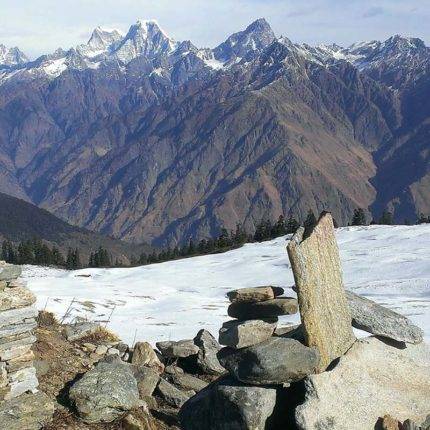
Kuari Pass Trek
Kuari pass, The perfect trek in Uttarakhand explored by Lord Curzon.
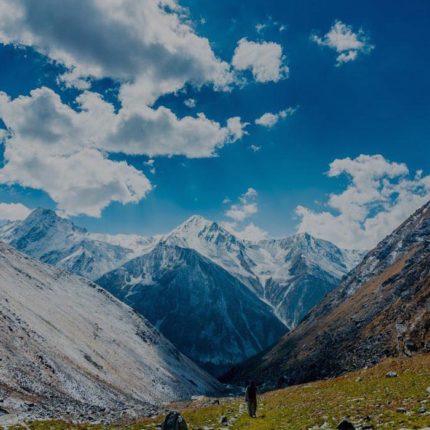
Har Ki Dun Trek
Har Ki Dun Trek is an Enthralling valley in the Garhwal Himalayas
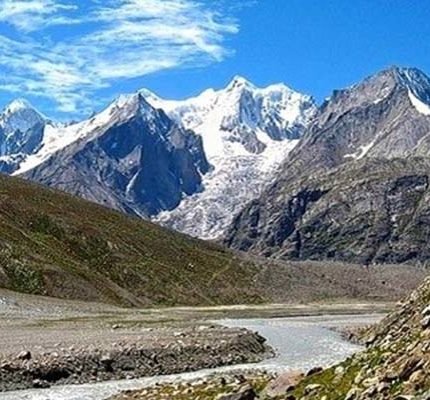
Rumtse to Tso Moriri Trek
Lake Moriri or Tso Moriri trek lies in the Jammu and Kashmir region.
Price: ₹ 23,000.00
Book the tour
Send a quick enquiry.
- Overview Itinerary Dates Include/Exclude
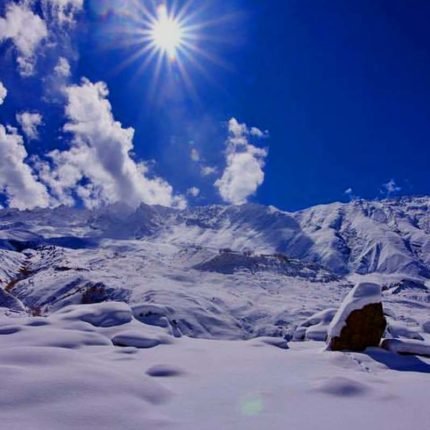

- Pangong Lake
- Popular Ladakh Tour Packages
- Leh Ladakh Bike Trip
- Chadar trek
- Chadar Trek 2023 Booking
- Pangong Lake Tour Packages
- Customize your tour
- Popular Tour Packages
- Family Friendly Tours
- Nubra Valley
- Tsomoriri Lake
- Hemis National Park
- Turtuk Village
- Zanskar Valley
- Hall of fame
- Zorawar Fort
- Kargil War Memorial
- Ladakh Images Gallery
Chadar Trek 2024 – The Chadar Frozen River Trek

Chadar Trek
The exciting and adventurous Chadar Trek in Ladakh is a dream trek for most nature lovers and adventure enthusiasts. This awe-inspiring Chadar trek on the frozen river of Zanskar is a thrilling adventure experience of a lifetime.
Chadar trek trail
The road to the Zanskar valley gets blocked by the heavy snowfall in the winter, and the villages of Zanskar get isolated from the rest of Ladakh. The Zanskar river, which gets frozen during the month of December, creates a trail of thick ice sheets. This trail is the only way that connects the villages of Zanskar to the other places of Ladakh. The trail for the Chadar trek on the frozen Zanskar river gets thick enough in the month of January for the trekkers to walk on.
The above map shows the trail of the Chadar trek through Nerak, Tibb cave, and Gyalpo. So, in the Chadar trek, the trekkers walk on thick ice sheets formed on the river Zanskar. In March, the trail of the frozen river trek starts melting, due to which the Chadar trek can not be done. So, the month of January and February is the only two months for the Chadar trek when the trekkers walk on the frozen river of Zanskar.
An adventurous trek
The majestic view of the mountains covered with snow, the frozen river, and the ice over the lake are the biggest attractions for the people visiting this place. And one glimpse of this enchanting place is more likely than not to entice you to embrace the breathtaking experience of a lifetime.
Chadar trek is known for both its spiritual and physical aspects. The route crossing over the Zanskar River is known for its vast sums of snowfall. However, the journey is not without its dangers. The travel can be both exhilarating and adventurous as you will often encounter breaking ice and jolting mountains to traverse across this vast land.

Location: Zanskar River (frozen) in Ladakh Trekking Time: January and February Duration: 8 Nights / 9 Days Trekking Distance: 62 Km Difficulty Level: High Altitude: 11,000 Feet Temperature: -5°C to -30°C Camps: Leh (Base-camp), Gyalpo, Tibb cave, Naerak camp. Hotels in Leh : The White Yak, Mandalchan Hotel, Welkin High or other same category hotels .
Chadar trek Itinerary:
Day 1: leh arrival -base camp.
- The destination airport is Kushok Bakula Leh Airport.
- Temperature in Leh: -5°C to -15°C
- Night Stay would be at Leh Hotel.
- The road to Leh from Srinagar and Manali usually gets blocked by the end of November. So, you need to travel by air. You’ll be landing at the Leh airport.
- The temperature in Leh would be around -5°C to -15°C. Before you deboarded the plane at Leh airport, make sure you are wearing enough warm clothes. Keep your heavy winter jacket, woolen gloves, and woolen cap easily accessible with you in your hand baggage to wear before leaving the plane.
- Your hotel booking would be in Leh. Complete your check-in procedures at the hotel. After breakfast, you need to rest for few hours for acclimatization. As you have traveled from a lower altitude to a very high altitude place, acclimatization is very important. After taking a nap, in the late afternoon, you can visit Leh market.
- Carry enough warm clothes with you, as the month of January and February is extremely cold in Leh with a freezing temperature beyond -15°C at some point.
- You may also experience heavy snowfall during this time. So, make sure you are wearing enough warm clothes and have enough rest to acclimatize to the harsh weather at a very high altitude. And drink enough water to keep yourself hydrated, which helps your body to regulate temperature and acclimatize faster. Read Details
Day 2: Leh Base Camp – Acclimatisation
• Acclimatization Day • Sightseeing
- While enduring extreme cold weather and maintaining high altitude differences, Trekking is a challenging task your body has to accomplish. So, your body needs to acclimatize properly and get ready for the Chadar trek ahead. And the process of acclimatization for your body would take some time.
- Many tourists faced health issues caused by Acute Mountain Sickness (AMS) due to lack of acclimatization. So, DM (District Magistrate) of Leh Ladakh issued a standard operating procedure which is mandatory to comply with if you want to go for the Chadar trek.
- As per the standard operating procedure , you need to acclimatize for the first three nights and then start the Chadar trek on day 4.
- So, in the meantime, you can visit the surrounding places of Leh. You can discuss the day plan with us and book a taxi to visit a few nearby places.
- As body acclimatization is still in progress, you should not travel long distances or visit higher altitude places . Read Details
Day 3: Leh Base Camp – Fitness test:
- Fitness test at designated medical camp between 2:00 pm to 4:00 pm
- Obtaining permit to continue the Chadar trek
- Completing Insurance formalities if you get the permit for Chadar trek
- Refund/Ladakh winter tour; if you are deemed unfit for the Chadar trek.
- Thank you for your patience and persistent efforts to acclimatize faster. Today your efforts would be finally rewarded.
- As per the SOP issued by the DM of Leh Ladakh, you are supposed to undergo a medical examination to make sure you are fit enough to pursue the Chadar trek.
- And if you have complied with the instructions for acclimatization, chances are very high that you would be qualified to continue the Chadar trek.
- The permit will be issued by the officials at the tourist information center (opposite to JK bank main branch)
- After obtaining the permit, we will complete the insurance formalities.
- However, you can’t continue the Chadar trek in unlucky circumstances if you are denied of permit (very rare chances).
- But don’t worry, we are always there for you to help. You can ask for a refund, or there are many other places in Ladakh where you can travel in winter. And you would definitely enjoy it a lot by walking on the frozen lakes, or the great scenery of majestic mountains covered with snow blankets, and much more. So, discuss the itinerary with us, and we will plan a mind-blowing tour of Ladakh. If the amount of the Chadar trek would cover the charges of the trip, then you don’t have to pay anything. Otherwise, you have to pay the extra charges . Read Details
Day 4: Chadar Trek; First day of trekking:
- Travel to Shingra Yokma (70km) after the breakfast
- Sightseeing on the way
- Trek to Gyalpo/Tsomo Paldar (3km) by walking on the frozen river of Zanskar.
- First Night of camping at Gyalpo/Tsomo Paldar
- Finally, the day is here; today is the first day you would walk on the frozen river of Zanskar.
- To start the Chadar trek, you need to travel to Shingra Yokma, which is around 70km away from Leh. It would take around two hours to arrive, but you will make few stops for sightseeing.
- Some of the famous tourist attractions you will visit on the way are the Hall of fame, Sangam-the confluence of the Indus & Zanskar river, Magnetic hill, Gurudwara Pather Sahib, and more.
- After the sightseeing, you will be heading towards the beginning point of the frozen river trek, which is Shingra Yokma.
- Time to put on your gumboots/trekking shoes and start the walk on the frozen river of Zanskar.
- If you are walking on a frozen surface of water for the first time, you will find it a little challenging. And the gumboot would make this walk more thrilling and wonderful.
- You would need your walking stick (trekking poles) on the first day of the Chadar trek. But later, you would be comfortable enough to walk on the frozen river of Zanskar without a stick.
- The distance you will cover would be around 3 km, and it would take around 2 hours to arrive at the first campsite at Tsomo Paldar.
- After walking for a while on the frozen surface of the river Zanskar, you would start enjoying it a lot.
- You will find a range of different kinds of surfaces on the Chadar trek. Some surfaces are very thick to carry enough weight, and some surfaces are fragile, ready to break. While following your guide and your mates, you’ll also start to learn how to judge the fragile surfaces from the stronger ones.
- After completing the first day of the Chadar trek, you will arrive at your first campsite in Tsomo Paldar.
- Congratulations, you have just proved that you can do it.
- Enjoy the first-night camping at Tsomo Paldar. Read Details
Day 5: Tibb Cave – 6 to 7 hours
- Trek to Tibb Cave
- 15km to cover in 6 to 7 hours
- Lunch will be served on the way to Tibb Cave
- Night Camping Around the Tibb Cave
- After spending the first night camping, you would find the next morning very exciting. Enjoy a hot breakfast on a very cold morning.
- As you are acclimatized properly and trained fully yesterday, now you are ready for the long trekking of today (15 km).
- Today you will witness mind-blowing sceneries on the way to Tibb cave. The enchanting view of the waterfalls and the flowing river with sparkling rocks (reflecting sunlight) around. And the giant mountains of different sizes covered in snow blankets would offer a wonderful view. The most beautiful scenery of this trekking would be the waterfalls which come in the way.
- For the first time after visiting Ladakh, you will feel starving after a long walk. A hot lunch around the cold frozen river would be served. After having lunch, you will continue the walk with a few small stops.
- After covering around 15 km, you will finally arrive at Tibb cave.
- Night camping would be around the Tibb cave. It’s a beautiful place of sand and small stones beside the river. Read Details
Day 6: Nerak – 6 to 7 hours
- Trek towards Nerak after breakfast
- 13km to cover in 6 to 7 hours
- Lunch will be served on the way to Nerak
- Night camping around Nerak
- After breakfast, the trek would continue towards Nerak.
- Lunch would be served on the way.
- Nerak is the last post of the Chadar trek.
- At Nerak, you are going to witness the most beautiful waterfall with unique features you have ever seen.
- Tonight you would witness the coldest temperature of your life, which you heard only in the news. It’s the coldest time of the year in Nerak, and the temperature goes as low as -30°C around Nyerak village. And the heavy snowfall blocks the road to these areas, isolating Zanskar from the rest of Ladakh. And you have accomplished a marvelous task of penetrating this isolation, bravo.
- If time allows, you can visit the Nerak village. Visiting this area would give you a chance to catch a glimpse of the challenging life endured by the people of Zanskar throughout this distinctive time of the year.
- Night camping at Nerak. Read Details
Day 7: Return to Tibb Cave – 5 to 6 hours
- Return from Nerak to Tibb cave
- Night camping around Tibb Cave
- Well done, you are a pro now and a trained walker of frozen surfaces.
- Have a nice and hot breakfast, and then you will start returning to Tibb Cave. Hot delicious lunch around the cold frozen river would be served on the way to Tibb Cave.
- You have covered all the trails of the Chadar trek and endured the weather harshness at its extreme point. But, don’t take the trek lightly from now on, assuming it, as only a trail you have already completed trekking. Be careful and cautious, as you can never predict the weather of these areas.
- Night camping at Tibb Cave . Read Details
Day 8: Return to Leh – 7 to 8 hours
- Return from Tibb cave to Shingra Yokma
- 18km to cover in 7 to 8 hours trekking
- Drive back to Leh from Shingra Yokma
- Night stay at Leh Hotel
- After breakfast, the last day of trekking would start from Tibb cave. Today you will cover a distance of around 18km trekking to arrive at Shingra Yokma.
- Bravo, you have done an incredible job completing the challenging Chadar trek. You are a pro now, and you have really earned it.
- Make sure you have taken pictures and recorded a few parts of trekking to show your family and friends.
- From Shingra Yokma, you will drive back to Leh. If your flight is on the next day, you should buy some souvenirs for your friends and family. If your flight is a day later, you should rest today and visit Leh market the next day.
- The hotel at Leh would be cozy enough to keep you warm tonight after few nights of enduring extreme cold weather.
- Celebrate your achievement, have dinner, and rest for the night. Read Details

Chadar Trek Booking
Inclusions and Cancellation policy for Chadar trek 2024 booking
- Accommodations : 4 nights in Leh, 4 Nights in Camps on a double or triple sharing basis.
- Transportation : From Leh to Chadar trek vehicle-accessible point. Return to Leh after Chadar trek.
- Meals : All meals (Vegetarian) during the Chadar trek on the frozen river.
- Trek equipment : Sleeping bag, mattress, kitchen & dining tent, utensils, tent, and toilet tent
- Permit for the Chadar trek 202 4
- Qualified guide certified for Chadar trek and support staff.
- First Aid Medical Kits
- Oxygen Cylinders
Cancellation Policy
- Transfer of a booking can be done (for the same dates) without extra charges.
- Suppose you want to cancel 24 days before the start date of the Chadar trek. Then you will get a 90% refund, no questions asked. Also, you can opt for a special coupon for the next year (2025) of the Chadar trek. The coupon can be used by anyone approved by you for the Chadar trek. However, the coupon holder has to pay the difference if the rates go higher next year.
- If cancellations are made within 14-24 days before the Chadar trek, you will get a 70% refund. Or you can choose any other date for the chadar trek 2024.
- Suppose you want to cancel 14-10 days before the start date of the Chadar trek 2024. Then you will get a 50% refund . After that no refund, but you can transfer it to anyone else (for the same dates).
- “Please note that refunds for the trek will not be possible in the event of flight cancellations. But we will work with you to find a suitable alternative date for your trek. We understand that flight cancellations can be frustrating and inconvenient, but we are not responsible for circumstances beyond our control. We recommend that all trekkers arrive at least two days before the scheduled trekking date to avoid any last-minute flight cancellations. If your flight is canceled, please inform us as soon as possible so that we can make arrangements to reschedule your trek”.
Things to do after you have booked your Chadar trek with us:
- Book your flight tickets to Leh as per the Itinerary. And book the return ticket to your hometown two days after the Chadar trek ends. If the Chadar trek ends today, your flight should be the day after tomorrow to accommodate any unforeseen circumstances.
- Don’t forget to inform your family and friends about the dates and the location of the Chadar trek; in case of any emergency during the trek, you might need them.
- Keep your documents in order.
- If you haven’t brought your first aid kit from your hometown, buy it in Leh before going for the Chadar trek as there are no shops/chemists around the trekking area.
- After getting the permit for the trek in Leh, show your trekking backpack to our expert guide; they will guide you on what to pack and how. Also, show them the clothing and gears you are planning to wear on the trek.
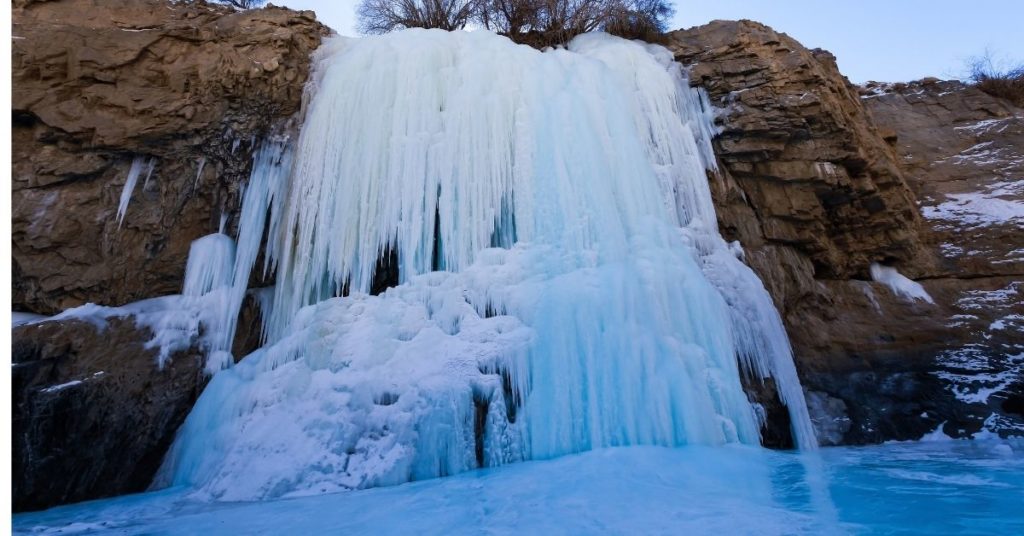
Packing list / Checklist for the Chadar trek:
The famous Chadar trek in Ladakh is highly adventurous yet demanding because you need to consider all of the requirements of the Chadar trek. From basic personal equipment to the emergency kit, you need to ensure you are well equipped before you commence your journey.
The gear includes some-what basic equipment which will allow you to reach Chadar in safety and security. Understanding the local weather condition and adhering to them makes the Chadar Trek a safe and successful journey. Winter is coming, and you are going to challenge it, so get prepared… as you are going to challenge the harshest winter of India at -30°C.
Given below is a comprehensive packing list for the upcoming Chadar trek
Weight restrictions for flights to Leh:
Before starting to pack your bags, keep in mind the weight restriction policies of the flights flying to Leh. Air India allows 30 kg per person. So, check with your airlines to confirm the allowable weight that you can carry to Leh Ladakh.
Dividing the bags
You should carry at least two bags—the main bag to carry on the Chadar trek and an additional bag. In the base camp Leh, you should divide your luggage into the trek and non-trek items. In the rucksack, you should carry all the trek items, and the rest of the items should be stored in another bag.
Backpack for the Chadar trek (55 – 65 L)
Choosing the right backpack. All of your trekking gear and clothes should fit in the backpack. So choose a backpack with a capacity of around 60 liters. Make sure the shoulder straps are comfortable enough with the supporting frames, as you have to trek for around 60km carrying the bag. Choose a backpack made from rugged, waterproof material to keep everything dry. Avoid backpacks with fancy handles and wheels, as these make the backpack harder for porters and mules to carry.
You can also hire a porter from us to carry those heavy bags for you. But you need to inform us at least 15 days in advance.
Carry these items to reduce the risk of getting infected.
- Hand sanitizers
- Disinfectant wipes/spray
- Tissues / Napkins
- Extra towels
Documents to carry:
- A photo ID proof like driving license, voter ID, passport. ID proof would be required at the airport and the hotel. Also, the ID proof would be required to make the permit for the Chadar trek.
- 4 Passport size photos to make the permit and insurance.
- A medical certificate of your fitness for the trek. The medical certificate should be from a recognized doctor.
- Indemnity certificate
- Covid-19 vaccination certificate
Packing items to wear on the Chadar trek:
- Gumboot: Experts recommend gumboot to be better than any other trekking shoes for the Chadar trek. At some point, you might have to walk in knee-deep cold water. The wet hiking shoes, socks, and pants will instantly freeze and won’t dry in the freezing cold temperature of Zanskar. So, gumboots are the best solution during situations like these to keep your feet and shoes dry. At the start, you will find it a little harder to walk comfortably on ice in those heavy gumboots. But soon, when you learn the expert way of “penguin walk” on the ice, and you will enjoy the walk on the frozen river of Zanskar.
- Hiking Shoes: A pair of good-quality (and waterproof) hiking shoes with a sole that would not slip on the glossy ice of the frozen Zanskar river. Avoid shoes with a smooth flat sole and heels. Shoes with plastic and leather-sole tend to be the worst for walking on ice. While purchasing the hiking shoes, make sure that it fits properly after you wear heavy woolen socks.
- Track pants: Carry 2 pairs of synthetic track pants.
- T-Shirts: Carry 2 full sleeve tees with collar.
- Inner thermals 3-4 pairs. Wear two layers at a time.
- Winter jacket/feather jacket
- A waterproof wind protector
- Cap: 2 woolen monkey caps that can cover the ears too.
- Socks: 2 pairs of sports socks and 2 pairs of woolen socks.
- Gloves (touch screen): Woollen gloves + synthetic glove (waterproof).
- Muffler: A woolen headscarf or muffler.
- Sunglasses with 100% UV protection (not polarized) to protect your eyes from sunlight and the reflections of snow. The clean snow on the way reflects most of the sunlight, creating a white appearance, which would be harsh for your eyes. Therefore, sunglasses are mandatory for the Chadar trek. And if you wear spectacles, you can wear contact lenses, so that you can wear sunglasses. Also, a photochromatic spectacle may be a good option if you don’t want to wear contact lenses. But at any cost, if you want to wear your specs, then buy bigger size sunglasses to fit them above your spectacles .
Toiletries and skin care to pack for the Chadar trek.
- Shampoo, face wash, soap, Toothbrush, toothpaste, wet wipes, and toilet paper should continuously be within your quick access during the whole trip.
- Deodorant, Razor and shaving cream
- Chapstick or lip balm and cold cream
- Sunscreen lotion (SPF 40+).
Few other important thing to put on your packing list for the trekking.
- Hot water bottle
- A thermos to carry hot water while trekking
- If you feel cold much more than others, you can carry exothermic warming pads.
- Trekking pole: It is mandatory for walking aid on the ice, and also, you can check the ice to be strong enough to walk on.
- Towel 2-3 small sizes microfiber towels with quick-drying features.
- 2 Water bottles (1 L each). Insulated water bottles are a better option. Also, normal water bottles can do the job.
- Non-prescription medicines kit: You must consider keeping all the basic medication that should keep you safe from potential common medical issues. For instance, you must have remedial medicine for headaches, stomach issues, cold & fever, band-aids for skin cuts, and any other medication you think you might need for yourself. You can slip and fall many times during the Chadar trek, as the ice would be very slippery, but slipping on ice won’t hurt you much, and you won’t need any medication for that. A bandaid will do the job if there is some minor skin injury.
- LED headlamp with extra batteries
- Small repair kit consisting of safety pins, needle, thread, and string (very important).
- Plastic bags: For wet clothes and to carry waste items to dump it later in a trash bin.
- Camera: The camera is a must-have item on the Chadar trek if you are interested in taking pictures. When you would be walking on the frozen river, you will find breathtaking attractions, and you would definitely want to capture the moment. So, don’t forget this ‘magical capturing moment device’ and its charger.
- Mobile phone and the charger: Cell phone is now a part of our lives, so, obviously, you won’t forget it. But still, write it in your checklist to check before leaving. The batteries of your phone can be consumed rapidly in the extremely cold weather of Zanskar. So, try keeping your devices warm.
- A waterproof case for your mobile
- Power bank: Keep your power bank ready with the other things to carry on the Chadar trek, as there would be a lot of power cuts in Leh. And there won’t be any power connection in the camps. So, carrying the power bank is very important to charge your phone. Your phone batteries can be consumed at a very rapid pace by the extreme temperature (-30°C) around the frozen Zanskar river. So, make sure that your phone is not out of power in Leh Ladakh. Always keep your power bank with you to prevent your phone from getting out of battery.
- Watch with alarm (if the mobile battery goes out of power).
- SIM: As of now, postpaid SIMs of BSNL, Airtel, and Jio are functional in Ladakh for roaming service. The signal for BSNL is better than Airtel and Jio. Internet speed is good in the main Leh area, but in remote areas like Zanskar, the signals would be very weak or no signal at all. We highly recommend subscribing to a BSNL post-paid SIM to use it on the Chadar trek.
You can also carry these items (Not very important)
Journal Pen Book/Novel Small binoculars
After packing your trek backpack, measure the weight. It should be below 10 kg if you intend to carry it yourself.
Things to avoid:
- Do not carry non-essential items, as you have to walk 62 km in the ice of the frozen Zanskar river during your Chadar trek. So, make your backpack lighter.
- Denim or jeans – not suitable for the Chadar trek
- Cotton or other sweat-absorbent clothing – Experts considered cotton to be a bad choice for the Chadar trek. It gets dampened when soaked with sweat which leads to rapid body heat loss.
- Junkfood, juice, etc. – Don’t carry too many of these items. Instead, carry snacks with high-fat like chocolate, nuts, etc.
- Don’t carry any disposable plastic bottles like (Bisleri, Aquafina), plastic wrapped/packaged items.
- Do not bring any non-biodegradable material.
- Carry a garbage bag with you to carry the leftovers. The Chadar trek area is an eco-friendly zone, so don’t dump trash there.
- During the trek, you will come across a few waterfalls, don’t use soaps and shampoos as local inhabitants of these areas drink this water. And the chemicals in these shampoos and soaps would contaminate the water.
- You will see a lot of local inhabitants and Lamas (monks) during the trekking. Don’t stare a lot, mock or pinpoint them, as they won’t like it.
Tips on keeping yourself warm during the trek.
- The temperature on this trek can go as low as -30°C, so try keeping yourself as warm as possible. Wear 2 layers of thermal sets, a heavy winter jacket, and a waterproof wind protector on the top.
- Wearing enough clothes is very important, but those clothes don’t produce heat; they just trap the heat produced by your body. So, keep moving or doing something during the trek to make your body produce heat all the time. When you stop for more than a few minutes, wear the windshield jacket to prevent the body from rapidly cooling off.
- Dressing in layers is found very effective in the extremely cold weather of the Chadar trek. The air trapped between each layer will hold your body heat. Plus, layers would help your body to regulate the body heat better and avoid sweating too much.
- Make sure that the warm thermal layer underneath your clothes fits snugly against your body so that your body heat would trap properly in them.
- Walk-in a slow and steady pace like the other trekkers of Chadar. Otherwise, you would sweat and damp your clothes. And wet clothes conduct heat away from your body.
- Sometimes, it would be windy in the freezing cold temperature of the Chadar trek, so you need to wear a waterproof windshield layer of fleece. It would prevent your body from cooling down. Please make sure the fleece is breathable, or it has a working zipper at the front to open it when it’s not windy.
- Fill your thermos with hot water and add sugar to it every morning before you start trekking. The weather conditions during the Chadar trek would be very cold and dry, which would make your body dehydrate more quickly than you realize. So, drink the hot water frequently during the trek.
- Keep the hot water bottle in your sleeping bag to keep you warm during the camp night.
- Make sure to keep your finger and toes warm. If your finger and toes get cold too quickly, it might get swelling which can cause irritation and pain. So, carry two pairs of woolen gloves and socks during the trek. When your finger or toes gets cold, take off the gloves or socks you are wearing. Now, warm your fingers or toes and wear another pair of gloves or socks. Similarly, if your warm cap gets damp by sweating, remove it and wear the spare one.
- Put exothermic pads in your socks and gloves; it would release heat and keep you warm for up to 8 hours.
- Eat chocolates, nuts, and other snacks with high-fat, calories, and protein. It will keep generating heat in your body, which would keep you warm.
- Please don’t sit on the ice of the frozen river of Zanskar, as it will conduct the heat from your body. Instead, sit on the rucksack/backpack.
- Please don’t drink alcohol during the night camps of the trek, thinking it will warm your body. Alcohol will make you feel warmer, but it doesn’t actually keep you warm. Instead, drinking alcohol lowers the core temperature of your body.
Are you fit enough to go on the Chadar trek?
If you are fit enough, with high levels of stamina and strength, then only you should go for the trek. If you have any health issues, consult your doctor.
How to know whether you are fit enough for the trek?
- If you are an experienced trekker with no recent health problems, then you are ready for the trek.
- Your stamina must be good enough to cover 5 km of distance in 45 minutes without stress.
- You should be strong enough to carry a 10 kg backpack on a trek of 6-7 hours.
- Don’t go on the trek if you have health complications like heart problems, asthma, high blood pressure, epilepsy, etc.
Tips on preparing yourself for the Chadar trek:
As mentioned earlier, the Chadar trek is a challenging trek that demands great fitness and prior trekking experience. The weather involved is freezing, and you have to walk on ice. But with the right attitude and perseverance, you can train yourself and get fit for the trek. So, start training yourself and get your body fitter each passing day. The more you train for the Chadar trek, the easier it will be.
- Prepare yourself for the extreme weather you have to endure on the Chadar trek. Be mentally prepared for the cold temperatures, long hours of trekking, and the possibility of changes to the itinerary due to weather conditions. Keep reading and watching videos about the Chadar trek regularly to prepare yourself mentally for the upcoming trek.
- You have to walk for 6 to 7 hours a day for 3 days on the Chadar trek. So, the best way to prepare for a really long walk is to do some long walks. Start with short distances and keep increasing the duration of the walk. You should be able to walk 6 hours comfortably.
- Walk up the stairs to strengthen your legs and to build stamina.
- The altitude in the Himalayas can be a challenge for many trekkers. Arrive in Leh a few days before the Chadar trek to acclimatize to the altitude and give your body time to adjust.
- To prevent acute mountain sickness, you should know about its symptoms, prevention, and treatment. So, start reading about it.
- Train with a backpack. You are carrying a backpack of 10kg on the trek. So, start training with a 5kg bag and then keep increasing the weight until it reaches 10kg.
An Amazing Trek To Explore The Beautiful Valleys:
Chadar Trek is a dream trek for many adventure seekers who want to have an awe-inspiring trek in Ladakh. The frozen Zanskar trail has immense natural beauty and charm. And the surreal experience on this trail leads the trekkers to cherish the moment of a lifetime. The amazing and fascinating nature of the Zanskar gives you a feeling of freedom and makes the journey on this trail amazing. This place, with its unforgettable experience, has been a unique destination for travelers for ages.
The scenic wonderous frozen Chadar trail superbly winds its way amidst lofty mountains, deep valleys, and surging rivers. This forbidding, however, is a pilgrimage of the brave. It is an arduous trek that goes hand in hand with great peril. And It’s a trek to be proud of, with sheer beauty and tranquility, undiminished by clouds of altitude and luring to the heights of mountain ridges abound. Get set for an experience that is here to stay unforgettable.
A wonderful beginning
Your journey to the wondrous and intriguing Zanskar Valley begins at Leh city, best known for its inexpensive accommodations, good restaurants, and central location. The airport is in Leh and around 7km far from the main Leh Bazaar. On your arrival to Leh, you would notice the great scenery this beautiful place has to offer. The majestic view of the mountains covered with snow, the floating ice on the great Indus river, and the ice over the lake are the biggest attractions for the people visiting this place. And one glimpse of this enchanting place is more likely than not to entice you to embrace the breathtaking experience of a lifetime.
Chadar Trek begins from Shingra Yokma. The walk on the frozen side of the river beside the magnificent flowing river – Zanskar River, which shimmers under the sun, makes the trek amazing. It inspires all travelers who come across with a passion for experiencing the astounding beauty that lies beyond the periphery of the human world.
The trail located offers the perfect balance between nature and spirituality, making it a well-renowned and visitor-intensive route. And as you walk across the beautiful and mesmerizing Zanskar River, you encounter great panoramas of the high-altitude valleys and isolated villages. And the awareness of spiritual values, the preservation of local culture, and prayer are often apparent as you get across the marvelous and mystical sunrise over the Zanskar.
The difficulty ahead
The trek on the frozen river of Zanskar is very thrilling and amazing. However, this trekking is not without its dangers. The travel can be both exhilarating and adventurous as often you will encounter breaking ice and jolting mountains in order to traverse across this vast land. The precarious sheet of ice crossing over the river blanks in and out is the most difficult passage, and some travelers even see the “ice smudges” as they slowly move in and out of the land. Thus trudging along the frozen Zanskar river during the Chadar trek is not an easy job, especially when the weather conditions are always unpredictable and you wither unsure what you are likely to see.
To envision your way through these dangerous and trying conditions, you will need an expert guide around you who will remain vigilant, careful, and will be able to predict the weather conditions, and will provide you the right types of equipment and instant support in case of any emergencies. So, don’t worry, we will provide you all with all requirements as mentioned.
The expedition is highly likely to be successful if the objectives are taken a little more seriously as, unlike other individual treks, it requires a great deal of planning to be well-paced. In case you are taking this trail independently, then the best bet is to be accompanied by a local guide who will step by step guide you through the trail and will take care of any emergencies. Contact us for an expert guide for your Chadar trek.
Helpful tips on how to trek on the frozen river of Zanskar:
When you walk on frozen river, it is important to be aware of the dangers that can happen around you. Icy and unpredictable conditions are something that you will have to weather if you are interested in visiting Chadar Trek. Trekking on the frozen river may seem like a fun and easy task, but It is true that you might face some dangers while trekking on the frozen river, but you can also rest assured that those dangers can be avoided if you know some tips about trekking safely on the ice. Here are some tips:
- The first and most important thing you have to remember is not to trek alone on the frozen river. Always make sure to have the guide around you or at least one person close to you.
- Stay alert at all times while walking on the ice. Don’t use a mobile phone while walking.
- Move slowly and keep your hands free. Don’t keep your hands in your pocket.
- Bend slightly forward and walk flat-footed; your center of gravity should be over your support leg.
- You will encounter ice cracks in your way. Instead of trekking near this opening, you may opt to walk through the hips of ice towards the other side.
- You should be wearing a pair of gumboots which does not have any holes or cuts in them. Make sure that your gumboots aren’t slippery, as these would make it easy for you to slip and fall once you start walking on the ice. This might seem strange, but flat-soled shoes are more likely to slip on the slippery ice than those with pointed toes.
- Another thing that you should take into consideration before trekking on the frozen river floors is your weight and how much you are carrying with you as you walk across. So, carry the important things only and walk as lightweight as possible.
- As you trek on the ice, you will also want to wear thick gloves so that if you slip and fall, you might slide a little, and your hand would get injured. Wearing thick gloves would protect your skin not only from the extreme cold but also from getting injured.
- Also, it is a good idea for you to carry a first aid kit with you.
- Ice is not your friend, so you must secure a good pair of ice clothing. Carry an extra set of clothes and keep them in a waterproof bag. So, that if you accidentally fall in the water, you have extra clothes to wear.
- Maintain some distance while walking, as walking closely in a group might put a lot of pressure on the ice, and it may break.
- Bend your back a little and head forward so that if you slip and fall on ice, it will avoid hitting your head against the ground.
- Always follow the guidelines and instructions of your trekking guide. The Chadar Trek is a challenging trek, and it’s important to take all necessary precautions to ensure your safety.
How to know if the frozen surface is safe for trekking?
Seeking professional advice from the local guide will be of great help if you are planning to do a “Chadar trek” as paired with a professional guide, you will be able to evaluate the condition of the trail. You will mentally and physically prepare yourself against deterioration and mishaps.
Enlisted are precautions you need to take during Chadar Trek:
- Always look out for routes with thick ice, for they are best for walking as they are less prone to breakages.
- The thickness of ice should be 4 inches to make it safe for walking. However, the Zanskar river keeps flowing, making the thickness vary from time to time. So, if you have measured the thickness while going towards Nerak, you should measure the surface’s thickness again while returning.
- If cracks appear below your feet, it’s advised to carefully place your trekking poles and move away from the danger zone.
- Be careful if you feel a temperature rise in Zanskar that might impact the ice quality. If the sunshine is of high intensity in Zanskar, then temperatures will vary widely, weakening the ice during sunny days and refreeze at night. As a result, the ice formed at the side of the river would weaken and float away with water flow, making it difficult for you to return.
- Avoid ice beneath the snow, as you can’t see if it’s thick enough or there are cracks. And the ice beneath the snow is often weak because of the insulating effect of snow which slows down the freezing process.
- Newer formations of ice are stronger than the older ones, and clear ice is the newer ones, so walk more on clear ice than white ice.
Be vigilant and careful all the time as your safety lies in your hands.
Three types of Ice to avoid during the Chadar Trek
- White ice is formed by freezing wet snow, and it would not be strong enough to walk. Ice formed by snow has air pockets making it weak and prone to break.
- Grey ice is also weak to walk on, as the color grey shows the presence of water in it, which weakens its density. So, try to avoid grey ice too.
- Slush ice ; the slush is a sign that ice is no longer freezing and might be melting. So, if you find slush on the ice, stay away from it. And if you find a lot of slush on the Chadar trek trails, inform the guide to know whether you should continue the trek.
What to do if the ice breaks and you fall in the water?
If you would be careful enough and follow the instructions properly, it’s very unlikely that you would fall in the water through the ice, but there is a chance that it may happen. That’s why it’s very important to know the tips and tricks recommended by the experts for these types of situations. So, what to do if the ice breaks while trekking on the frozen river and you fall in ice-cold water? Here’s what the Washington Post has to say on what to do if you fall into the water through the ice?
- Stay calm : It’s natural that a person goes into shock in such a situation. But don’t let the shock of falling into the ice-cold water take over. Clearing your mind would make it easier to come out of the water.
- Jacket to the rescue : Your heavy winter jacket would act as a buoy, and it won’t let you drown in the water.
- Kick, and pull ,” Gordon Giesbrecht, a professor at the University of Manitoba who studies hypothermia and is known as “Professor Popsicle,” told ABC News. “Put your arms on the ice, and just kick your legs, and just try to pull yourself along the ice.”
- Stay horizontal : When you come out of the water, lie down horizontally on the ice. As the ice around the hole is weak, it might break again if you stand up too soon. “Roll away from the hole to keep your weight spread out,” the Minnesota guide advises.
- Keep yourself warm: Get out of the wet clothes immediately, as it would start freezing instantly. Wear the extra set of clothes and drink something hot, and keep yourself warm.
How do I get to chadar Trek?
Located in Jammu and Kashmir, Ladakh, the land of high passes and fair valleys, is one of the most beautiful and spectacular places in this world. However, the journey to this place is quite difficult as, during winter, it’s impossible to move around through the high passes, as the road to Ladakh gets blocked by the heavy snowfall. And if one wants to travel, you need to fly miles before you can reach your destination.
The ruthless weather conditions and deep snow can crush any dream of exploring this amazing exotic place in the winter, but what is an adventure without a challenge! Many Indian airlines like Go Air and Air India offer flights to the destination. However, be sure to make your final booking much before you need to go, as flights are sometimes fully booked in advance!
The beginning of the Chadar trek is from Shingra Yokma. To reach Shingra Yokma, you need to follow the given route:
- Arrive, Leh
- Get the permit for the Chadar trek in Leh
- Book a Taxi in Leh to travel to Shingra Yokma
How to reach Leh?
You can reach Leh by plane or land. But the road to Leh would be closed during the months of November to April. And the time of the Chadar trek is January and February, which are the coldest months of the year with heavy snowfall, so the roads would be closed during the season of Chadar Trek. Read this blog post about how to reach Ladakh.
Flight to Kushok Bakula Leh Airport.
The airport of Ladakh is Kushok Bakula Airport, located in Leh. It is around 7 km far from the main Leh Bazaar. There are regular flights to Leh, including direct flights from cities such as Srinagar and Delhi. When the weather is fine, there would be no clouds, and you can enjoy the magnificent view of the Himalayas during your journey to Leh.
Due to the mountain breeze in the afternoon, all flights take off and land in the morning. This method is challenging because it is unidirectional and has high terrain towards the Kushok Bakula Rimpochee Airport’s east end. So, the timings of your flight to Leh would be in the morning.
From these cities flight goes directly to Leh Airport with no stops:
- Air India – Chandigarh, Delhi, Jammu, Srinagar
- SpiceJet – New Delhi
- GoAir – Delhi, Mumbai, Srinagar
- Jet Airways – New Delhi
If you live in one of the above cities, the flight to Leh would be direct from your city. Otherwise, you need to make stops in one of the above-mentioned cities to reach Leh for the Chadar trek.
From Airport to Leh city:
You will find a lot of cabs outside Leh Airport. When you leave the arrival terminal, you will find a taxi booking booth to your left, outside the terminal. You can also book a taxi from there to your hotel in Leh.
Taxi charges from Airport to Leh City:
Suv: ₹ 800/- Van/Omni: ₹ 600/-
Leh to Shingra Yokma:
You can book a taxi to Shingra Yokma in Leh. If you are in a group of four or less, then you should book an SUV. And if you are in a huge group, you can book a tempo to arrive at Shingra Yokma for the Chadar trek. If you have booked your trek with us, we will provide you the transportation to arrive at Shingra Yokma for the Chadar trek.
An interesting fact about Chadar trek
The Chadar trek is an excellent winter trek through the frozen Zanskar River, which lies within the Indian union territory of Ladakh. It is now becoming more popular among foreign adventure tourists. But do you know that the Chadar trek was started as a necessity by the people of Zanskar?
The Valley of Zanskar gets isolated from the rest of Ladakh for around 6 months. And the trekking route is the only viable means of travel from Zanskar to other places in Ladakh. So, the local inhabitants used the route to get their basic supplies and sell utensils, goatskin, and yak butter for livelihood. And the route which they used became the Chadar trek trail. Now it’s an easy task for the locals of Zanskar to trek on the frozen Zanskar river, as for 6 months a year, this is the only route that connects Zanskar to the rest of Ladakh.
During your Chadar trek, you will notice a lot of local inhabitants in traditional wear. You would get surprised at how easily they can walk on the ice of the frozen Zanskar River.
Few of the benefits of Chadar trek:
There are a lot of benefits to going on the Chadar trek. Spending 18-20 hours trekking on the frozen river not only improves your health and stamina but also adapts you to extreme cold weather. And that’s not it; you would also develop some skills.
- Softer skill development: Chadar trek can also benefit your management skills. You have to plan the trekking, set goals, and work as per schedule to stay with the trek group. All of these would make you not only punctual but also mentally strong.
- Reduces Stress: Spending time around rivers and mountains with beautiful sceneries would be the most relaxing time of all, which would reduce your stress.
- Social benefits: During the Chadar trek, you won’t be busy with many devices that give you a chance to interact with your group mates. Also, you would be helping, motivating, and encouraging each other to keep going. So, you will be able to bond with other members of the group, and you can make lifelong friends.
- Less junk or other harmful foods: On the chadar trek, you won’t be eating snacks, drinking beverages, and other junk foods. Also, you would be eating a lot of healthy foods.
Frequently asked Questions:
Do you have qualified and certified guides for the chadar trek.
Yes, all our guides are qualified and certified, and the government authorizes them to lead the Chadar trek. Not only have the guides completed their advanced mountaineering course, but they are well experienced for more than 10 years. We also have guides from Zanskar village, near the Chadar trek area, who lived there for more than 20 years and knew the place very well. A certified guide would accompany every group.
How many guides and staff per group?
All the groups would have at least one authorized guide and one local who knows all the routes of the Chadar trek area. The rest of the supporting staff are from the rescue team, cook, porter, helper, etc.
Chadar trek 2024 dates?
The Chadar trek in 2024 would start from the 6th of January 2024 to the 11th of February 2024. If there is any cancellation or changes in dates, the information would be updated accordingly.
How long is Chadar trek? Duration of Chadar trek?
You have to cover 62 km trekking on the frozen river of Zanskar. However, the duration of the whole trip would be 8 nights and 9 days. For the first 3 days, you have to stay in Leh to acclimatize, and on the fourth day, the trek on the frozen river would start. The duration and the camping locations during the Chadar trek is given below:
- Night 1, 2, 3 – Leh base camp . The permit for the Chadar trek will only be issued if you spend the first three days at Leh. On day 3, after the fitness test, you will get the permit for trekking.
- Night 4 – Gyalpo: On day four, the Chadar trek would start from Shingra Yokma to Gyalpo. Gyalpo is located at a bend in the Zanskar river. You would enjoy the great scenery of the river and the peaks and walls of rock faces that look human-made.
- Night 5 – Tibb cave : Tibb cave is a wonderful place of sand and small stones. It’s a great place for night camping. The view of the majestic mountains from the Tibb cave looks amazing.
- Night 6 – Nerak : – Nyerak is the last post of this trek. After Nyerak, you have to return from you came from.
- Night 7 – Tibb cave: On day 8, you would be returning to Leh from the Tibb Cave. This would be the last day of your Chadar trek.
- Night 8 – Leh
What’s would be the temperature during the Chadar Trek?
The temperature during the Chadar trek can vary from -5°C to -30°C. Chadar trek can only be done in the months of January and February. And these two months are the coldest months of Ladakh, with temperatures dropping below -30°C.
- On the first day of your arrival to Leh, the temperature at daytime in Leh would be around -5°C to -10°C. The temperature during nighttime in Leh would be around -10°C to -15°C. So, for the first three days of your Chadar trek at base camp Leh, the temperature would vary from -5°C to -15°C.
- The fourth day of your Chadar trek would be from Shingra Yokma to Gyalpo. The temperature during the daytime of the Chadar trek would be around -10°C to -15°C. And during the nighttime camping at Gyalpo, the temperature would be around -15°C to -20°C.
- On day 5, the temperature during the daytime would be around -10°C to -20°C. And during the night camping at Tibb cave, the temperature would be around -15°C to -25°C. On the 6th day of the trek, the temperature would be around -10C to -20°C. The night camping at Nerak would be the coldest night of the whole trekking, where the temperature can drop to -30°C.
- After day 6, you have to return from where you came from. So, the temperature would vary according to the places of trekking and camping as mentioned above.
Why is the Chadar trek difficult?
The trekking difficulty is a very common question that is asked by many tourists who are planning a Chadar trek in Ladakh. Many people think it’s walking on the ice sheets of the frozen river that makes this trekking difficult. But no, walking on the ice doesn’t make this trekking difficult, it can be dangerous, but if you follow the guidelines then, it’s actually fun.
So, what makes the Chadar trek difficult? The answer is straightforward… The extremely cold temperature of Ladakh and the Acute Mountain Sickness due to high altitude is what makes the Chadar trek difficult. The harsh weather of Ladakh and the extremely cold temperature can drop to -30°C. But if you read the information given above on how to stay warm and how to acclimatize properly, you can manage through the freezing cold temperature of Ladakh during the Chadar trek.
Is Chadar trek dangerous?
The Chadar Trek is considered to be a challenging and strenuous trek, but with proper preparation, it can be done safely. However, there are some risks associated with the trek that should be taken into consideration before embarking on the journey.
- The main risk associated with the Chadar Trek is the weather. The trek takes place during the winter months, and the temperature can drop well below freezing. The cold weather can lead to frostbite, hypothermia, and other cold-related injuries. Additionally, the ice can be slippery and unstable, increasing the risk of falls and injuries.
- Altitude sickness is also a risk on the Chadar Trek, especially for those who have not acclimatized properly. Symptoms of altitude sickness can include headache, nausea, and dizziness, and in severe cases, it can be life-threatening.
- Another risk associated with the Chadar Trek is the remoteness of the trek. The trek takes place in a remote and isolated area, which can make it difficult to access medical care in case of an emergency.
- Despite these risks, the Chadar Trek can be done safely with proper preparation and the guidance of an experienced trekking guide. It’s important to take the time to acclimatize properly, dress appropriately for the cold weather, and follow the guidance of your trekking guide. By taking the necessary precautions, you can have a safe and enjoyable experience on the Chadar Trek.
The details about how to acclimatize properly and how to walk on the ice are given on this page; please read it before going on the Chadar trek.
How to acclimatize for the Chadar Trek?
Acclimatization is an important part of preparing for the Chadar Trek. Here are some tips on how to acclimatize for the trek:
- Arrive in Leh a few days early: Leh is located at an altitude of more than 10,000 feet, and it’s important to give your body time to adjust to the altitude before starting the trek. Arrive in Leh at least two to three days before the trek to acclimatize.
- Take it easy: During your first two days in Leh, take it easy and avoid any strenuous activities. Relax and allow your body to adjust to the altitude.
- Stay hydrated: Drink plenty of water and fluids to keep yourself hydrated. Dehydration can worsen altitude sickness, so it’s important to drink plenty of water.
- Eat light: Avoid heavy meals and eat light, nutritious meals. Foods high in carbohydrates are a good option as they provide energy and help with acclimatization.
- Avoid alcohol and smoking: Avoid alcohol and smoking as they can worsen altitude sickness and make it harder for your body to acclimatize.
- Take short walks: Take short walks around Leh to help your body adjust to the altitude. Walking at a slow pace will help you get used to the thinner air and increase your oxygen intake.
By following these tips, you can help your body acclimatize to the altitude and reduce your risk of altitude sickness on the Chadar Trek. Remember to listen to your body and take it slow if you experience any symptoms of altitude sickness.
Is Chadar trek for beginners?
Yes, as a beginner, you can go for the Chadar trek, given that you are physically fit for it. The Chadar Trek requires a good level of physical fitness, as you will be trekking on ice and snow for several hours each day. It’s important to train for the trek in advance and build up your fitness level to be able to handle the physical demands of the trek.
If you have a medical condition, you should consult a doctor to confirm whether you can go for the Chadar trek or not.
Overall, while the Chadar Trek is challenging, it can be done by beginners with proper preparation and guidance. However, it’s important to be realistic about your abilities and take the necessary precautions to ensure your safety and enjoyment of the trek.
You should follow all the guidelines not to face any problems during the Chadar trek. This page consists of all the information about the Chadar trek, and the information is given by trekking guides of the Chadar trek, who are experts in this field. So, read all the information given on this page before going for the Chadar trek.
Can the Chadar trek be done solo?
It’s not recommended to go on the Chadar trek solo. Here are some reasons why:
- Safety: The Chadar Trek is a remote and isolated trek, and it’s important to have someone with you in case of an emergency. Having a trekking guide with you can help ensure your safety, as they are trained to deal with any potential issues that may arise on the trek.
- Navigation: The Chadar Trek is a difficult trek to navigate, with the route changing daily due to the shifting ice. A trekking guide will be familiar with the route and will know how to navigate the changing terrain safely.
- Logistics: The Chadar Trek requires a lot of logistical planning, including transportation, permits, and equipment. A trekking guide will handle all of these logistics, making the experience much smoother and more enjoyable.
- Group support: Trekking in a group can provide support and motivation when the going gets tough. The Chadar Trek is a challenging trek, and having a group with you can provide the support you need to keep going.
Overall, it’s not recommended to do the Chadar Trek solo. Hiring a trekking guide and trekking with a group can help ensure your safety and provide a more enjoyable experience on this challenging trek.
You can book your Chadar trek with us; we will include you in a group accompanied by a guide.
How much cash we need to carry with us during the trek?
It is important that you need to keep some cash for emergencies. However , don’t carry too much cash from your home town. You will find ATMs in Leh to withdraw the needed cash. Our guides in Leh would tell you what to carry and how much. So, it would be best if you ask our guides a day before the Chadar trek to know the cash amount carry with you.
Can we smoke or drink alcohol during the trek?
Smoking and drinking at a high-altitude place like Ladakh would harm your body. And it would make it difficult for your body to acclimatize properly. Also, there were few cases when the trekker suffered from acute mountain sickness due to smoking and won’t be able to continue with the trek. So, we strongly recommend not to drink alcohol or smoke cigarettes.
Do we need a trekking pole/walking stick while walking on the frozen river?
Yes, you would need a trekking pole if you are a beginner. However, if you are an expert in walking on ice without the help of a trekking pole, then you won’t need one.
What are the group sizes? How many trekkers are there in one group?
Usually, the least number of people in a group is 8. And the highest number is 22 people per group. However, if you have a group that wants a customized trek, we can arrange the same for you even if the number of people is lesser.
Do girls go on Chadar trek. Is it safe?
Yes, a lot of girls participate in the Chadar trek with us every year. It’s our top priority to provide a safe environment for the girls participating in the trek. Tents and rooms for girls and boys are separate.
Toilet facility during camping?
Toilet tents would be there at every campsite.
How to get hot water to drink while trekking?
Hot boiled water would be provided at the campsite. It is recommended to carry chlorine tablets to use with the boiled water. Also, don’t forget to carry boiled water every morning before you start trekking.
What medical facilities are provided during the trek?
All the needed equipment like oxygen cylinders, stretchers, first aid kits and more, would be available during the trekking. And don’t worry, our trekking guides are certified for first aid medicines.
Can we stay in the caves?
There are few caves with limited seats, so, if you book early we can look for the availability of a cave.
Will there be bonfires during the Chadar trek?
No, a bonfire is not possible, given the weather condition and the non-availability of wood.
What is the emergency evacuation plan?
If someone falls sick and requires medical attention, the support team would take the patient to Leh. The support backup team would always be there to attend to any medical emergency.
Where is the Chadar trek frozen river?
The Chadar trek frozen river is the Zanskar river which gets frozen during the winter, and the ice sheets get thick enough in January for the Chadar trek.
Please read the World health organization’s travel advice, before traveling anywhere.
Read Indian Government travel guidelines .

About the author:
Sam K. Pandepa is a travel enthusiast and right from the early years, he had a thirst for adventure. he likes to explore and document new places, trek in the mountains, and share his travel experiences with other travel enthusiasts. His vision is to explore and document new trails, hike in the mountains and implement sustainable ways of trekking. He loves sharing his Himalayan experiences and motivating people with his travel stories. When not traveling, he likes to spend time with like-minded travel enthusiasts and read books on travel and mountaineering.

RoamingIndian
Where Travellers Connect
Chadar Trek
Chadar trek distance, chadar trek height, trek difficulty, why choose chadar trek.
Chadar Trek: “Winter Trail on Frozen Zanskar River”
Chadar,” a term that translates to “sheet of ice,” marvelously captures the transformation of the Zanskar River during winter. This natural wonder sees the swift river turning into a pristine white expanse, resembling a glassy quilt ranging from shades of bluish tinge to golden yellow under the sunlight, and a serene milky white in the moon’s gentle glow. This trekking adventure is truly unparalleled.
The Chadar trek forms a vital lifeline, connecting remote villages nestled deep within the Zanskar mountains with Chilling, situated along the frozen Zanskar River . This age-old route, historically employed for trade and transportation, is at its most reliable in February when the ice attains optimal stability.
Embarking on the Chadar trek is not just a journey; it’s an odyssey into the heart of nature’s frozen wonders. The frozen riverbed serves as a canvas for an unforgettable experience, offering trekkers a unique blend of challenge and awe-inspiring beauty. Witnessing the Zanskar River’s metamorphosis into a surreal ice sheet is an adventure that leaves an indelible mark on the soul, making it a must-experience trek for every avid adventurer.
- Certified Trek Leader
- Transparent Pricing, Zero Surprises - ( No hidden costs )
- Our mission is your memorable journey
Highlights of Chadar Trek
- Experience the Zanskar River transforming into a captivating sheet of ice, creating a surreal landscape.
- Trek on the frozen riverbed, navigating through icy terrains and breathtaking gorges, offering an unatched challenge.
- Explore remote villages along the route, interacting with the warm-hearted locals and understanding their traditional way of life.
- Follow the ancient trade route used for centuries, connecting isolated mountain villages with the outside world.
- Overcome the challenges of trekking on icy surfaces, making the journey immensely rewarding and memorable.
Chadar Trek Available Dates
Fixed Departures Every Week.
Call 8090993036 for more information for group treks.
Chadar Trek Itinerary
Arrival in Leh, nestled at an altitude of 3500 meters (11,400 ft), where you will be accommodated in a comfortable Guest House.
Acclimatization stroll in Leh at an altitude of 11,400 ft, followed by a relaxing stay in a cozy Guest House.
Undergoing a medical examination at SNM Hospital, located at an altitude of 11,400 ft, followed by a comfortable stay in a nearby Guest House.
Descending from Lower Shingra to Somo Paldar, transitioning from 11,400 ft to 10,390 ft. The journey includes a 75 km drive and an 8 km trek, culminating in a night's stay in tents.
Trekking to Dib Cave/Tibb, navigating an altitude range from 10,550 ft to 10,760 ft. Covering a distance of 15 km on foot, the trek concludes with an overnight stay in tents.
Continuing the journey from Dib Cave/Tibb to the Camp at Naerak, the trek spans an altitude from 10,760 ft to 11,150 ft, covering a distance of 12.5 km. Experience the mesmerizing surroundings before resting for the night in tents.
Trekking from Naerak to Tibb/Gaylpo, the route covers an altitude range from 11,150 ft to 10,760 ft, spanning a distance of 14.5 km. Rest for the night in comfortable tents amidst the serene wilderness.
Embarking on the final leg of the journey, trek from Tibb to Shingra Koma, covering altitudes ranging from 10,390 ft to 11,400 ft, spanning 8.5 km. After the trek, enjoy a scenic 75 km drive back to Leh. Rest and unwind in the comforts of a guest house.
Check-out from the guesthouse in the morning and depart from Leh airport.
Trek Inclusions
- Accommodation in tents during the trek and in a hotel in Leh on days 1, 2, 3, and 8 as per the itinerary.
- Vegetarian meals during the trek.
- Trekking equipment.
- First aid medical kits and oxygen cylinder.
- Expert trek leader, guide, and support staff for assistance.
- Transportation from Leh to the road head and back.
- Transportation from Base Camp Leh to Leh as per the provided itinerary.
Trek Exclusions
- Meals in Leh, available at Leh Hotel/Guest House at Rs.250/- per meal.
- Personal expenses of any kind.
- Local fees such as Environmental Fee, Wildlife Fee, ALTOA, LAHDC, etc., ranging between Rs.300/- to Rs.2500/-* (subject to variation).
- Porter service for personal luggage, available at Rs.3750/- per day (5 days) for up to 10kg baggage.
- Anything not explicitly mentioned under 'Inclusions'.
Photo Gallery
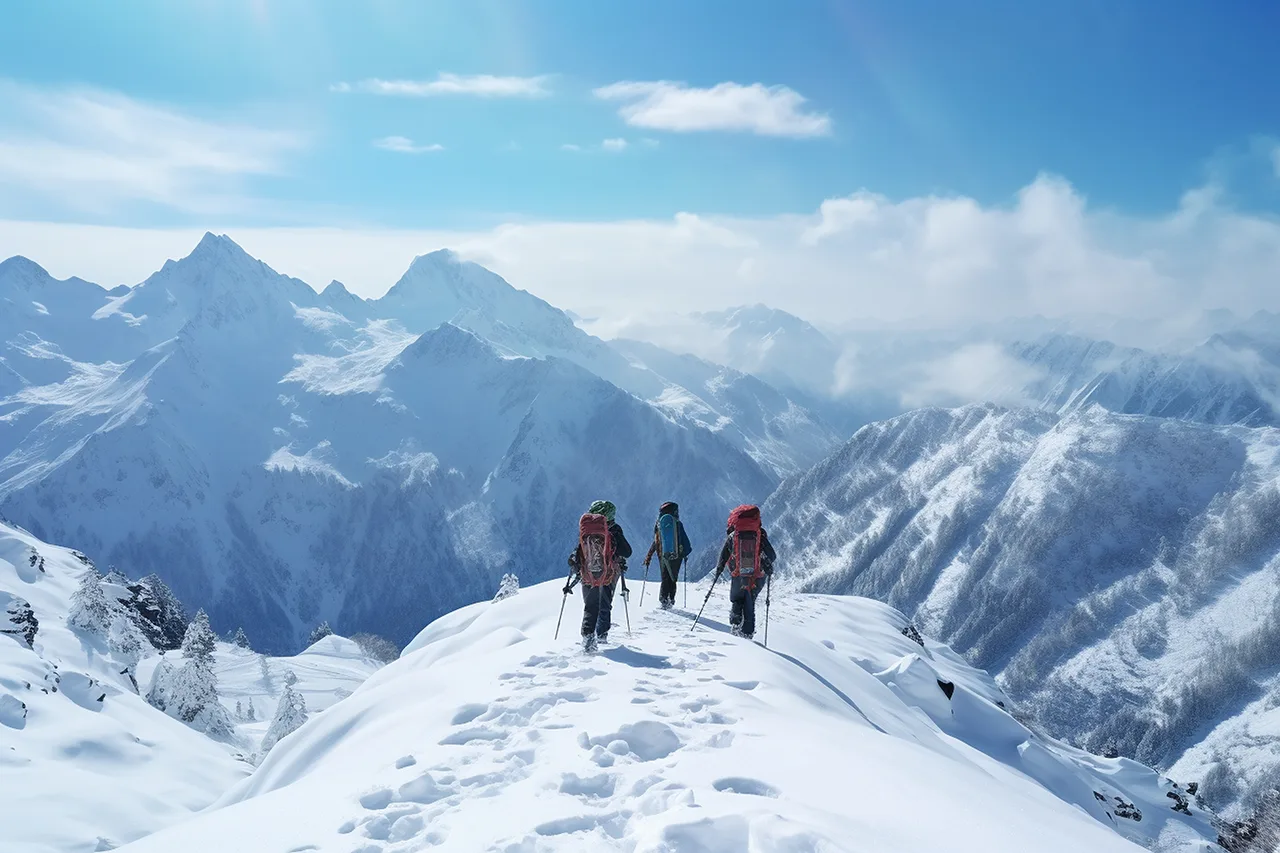
Chadar Trek Detailed Itinerary
Arrival in Leh (3500 m) Leh, situated over 3500 meters above sea level, ranks as the second-largest district in the country. During winter, when most passes leading to Leh are inaccessible, you’ll be flown to the Leh airport, the world’s highest airport. As you touch down, the dry, cold air welcomes you, but the breathtaking sight of snow-capped mountains steals the show. Complete arrival formalities, grab your luggage, and head to the pre-arranged hotel. Enjoy an overnight stay.
Acclimatization Walk in Leh Rise early for an acclimatization walk at high altitude. Head to Shanti Stupa, a sacred Buddhist stupa, offering a stunning sunrise view and a panoramic sight of Leh. Stay hydrated as you acclimate to the altitude on your first day in Leh.
Medical Check-up at SNM Hospital Due to the trek’s challenging nature, a medical certification is mandatory. Undergo a medical check-up at Sonam Narbu Hospital to obtain a clearance certificate, ensuring fitness and acclimatization for the trek.
Shingra Koma and Somo Paldar Enjoy breakfast and embark on a journey to Shingra Koma. The thrilling drive involves bumpy roads and hairpin bends, offering awe-inspiring views of the surrounding high mountains. Disembark and trek to the Somo Paldar campsite, marking the start of your Chadar trek.
Trek to Dib Cave/Tibb Embark on a trek to Dib Cave/Tibb, surrounded by breathtaking ravines and gorges. The steep cliffs limit sunlight, creating a unique atmosphere. Reach Dib, a large cave, where you’ll halt for the night. Experience butter tea and relish an overnight stay.
Dib Cave/Tibb to Camp at Naerak Trek through the scenic region, witnessing the largest frozen waterfall and prayer flags. Visit the village of Naerak, interacting with locals and immersing yourself in their way of life. Enjoy a comfortable overnight stay in the village camp.
Naerak to Tibb Embark on the return trip, trekking towards Tibb. Admire the changing beauty of the frozen river and interact with locals along the way. Relax at Dib Cave and stay overnight at the campsite.
Tibb to Shingra Koma & Back To Leh Depart Tibb for Shingra Koma, crossing Gyalpo. Witness high mountains and wildlife pugmarks, possibly spotting snow leopards and ibex. Return to Leh in the evening, staying overnight at the hotel.
Departure from Leh Your remarkable journey through this scenic destination concludes. Check-out from the guesthouse in the morning and depart from Leh airport, carrying the unforgettable experiences of this adventure.
What Mountains Teach Us About Life
In the embrace of the mountains, we discover not just the peaks and valleys of nature but also the heights within ourselves. Our journeys, whether planned or spontaneous, trek us through uncharted terrains and unpredictable weather, mirroring the challenges and triumphs of life itself.
Packing Essentials for Chadar Trek
- 2 pairs of synthetic track pants (wear one over the other for added warmth)
- 2 full-sleeve tees with collar
- Fleece jacket (avoid sweaters)
- Full-sleeve thick jacket
- 4 pairs of undergarments
- 2 pairs of thermal inners
- 2 pairs of sports socks and 2 pairs of woolen socks
- Woolen monkey cap/balaclava
- Woolen hand gloves + synthetic gloves (waterproof)
- Hot water bottle/bag (available at medical stores)
- Sunglasses with 100% UV protection
- Gumboot (if not purchased from Leh)
- Backpack (55 – 65 L) with sturdy straps and supporting frame
- Daypack (20 L) if offloading your backpack (inform in advance)
- Trekking shoes (good standard trekking shoes or gumboot recommended)
- Trekking pole (mandatory)
- Woolen head-scarf or muffler
- Light towel (thin, quick-drying)
- Chapstick or lip balm
- Cold cream and sunscreen lotion (SPF 40+)
- 2 water bottles (1 L each)
- Personal medicine kit
- Personal toilet kit and toilet paper
- LED torch with extra set of cells (headlamps preferred)
- Small repair kit (safety pins, needle, thread, and string)
- Camera, memory cards, batteries
- Plastic bags for compartmentalizing and carrying wet clothes
The Big NO:
- No denim or jeans
- No snacks, colas, alcohol, or personal food
- Keep the weight of your gear in the range of 8-10 kg
- Avoid carrying non-biodegradable materials
Mandatory Documents:
- Govt. Identity Card
- Medical Certificate
- Self Declaration
- Passport Size Photograph
Please click here to download the forms
Submit your inquiry using the form below
Cancellation policy.
In case, you are unable to travel or willing to cancel the trip, you can transfer the trip to any of your friends/known persons. Please note that this feature is applicable only when the status of the Booking is “Paid” and there are at least 5 days remaining before the departure date (departure date minus 5). Drop an email to [email protected]
Please note that the replacement would not be applicable to any Volvo/Train transport booked for the original participant. The same would be automatically canceled. This is simply because the seats booked in such transport mediums are not transferable.
The Refund of the amount will be processed as per deduction guidelines outlined below:
* If cancellations are made 30 days before the start date of the trip, 10% of the total tour cost will be charged as cancellation fees or get the full amount of the RoamingIndian trek voucher, which can be used later to book another trek.
* If cancellations are made 15-30 days before the start date of the trip, 40% of the total tour cost will be charged as cancellation fees.
* If cancellations are made within 0-15 days before the start date of the trip, 100% of the total tour cost will be charged as cancellation fees or get a RoamingIndian trek voucher of 50% of the amount.
Treks in Uttarakhand
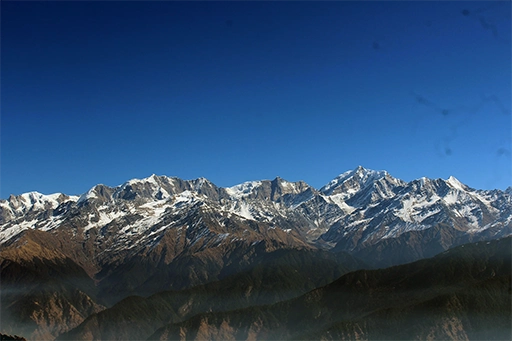
Dayara Bugyal Trek
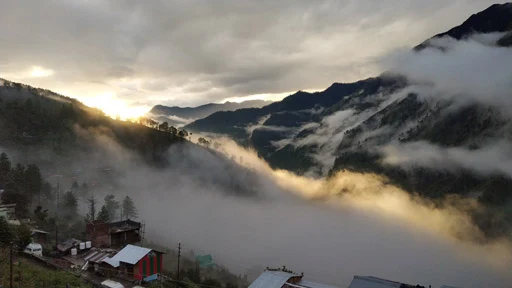
Har Ki Dun Trek
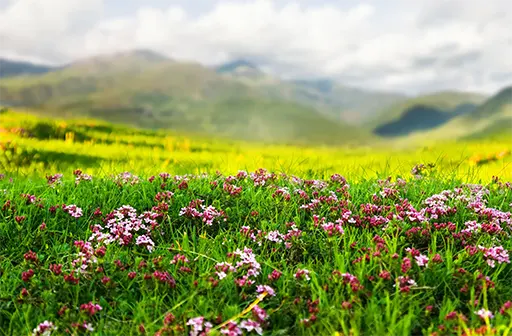
Valley of Flowers Trek
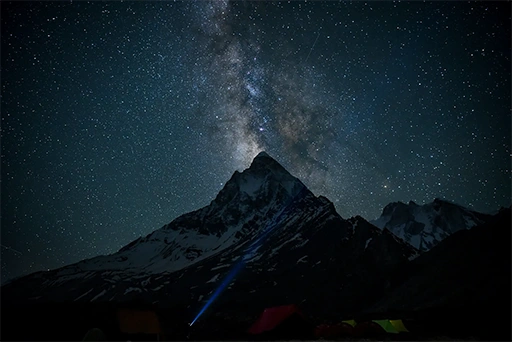
Gaumukh Tapovan Trek
India's Highly Recommended Trekking Company
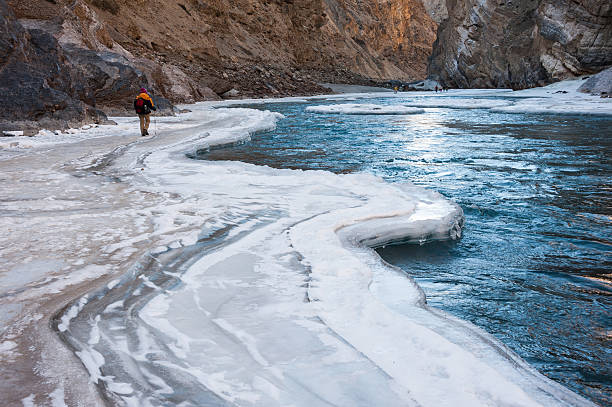
Chadar Trek (Frozen River)
₹35,000 (flat 40% off), ₹ 21,000, (leh hotel to leh hotel), service tax @ 5% (gst), + single tent occupancy: ₹ 2,000, + backpack offloading: ₹ 5,000, batch availability.
- Overview & Itinerary
Chadar Trek in Ladakh is a unique experience, unlike any other trek in the Himalayas. Walking on a frozen river with towering mountains on either side is simply breathtaking. The trek, situated at an altitude of 11,150 feet, feels like a journey to the North Pole with temperatures dropping to -30 degrees. It's an experience of a lifetime that shouldn't be missed by any hiking enthusiast.
The Chadar Trek is an exciting winter trek on the frozen Zanskar River, with sightings of blue sheep, snow leopards, and ibex adding to the adventure. This expedition is one of the most breathtaking experiences on Earth, as you trek across the ice and snow and revel in the beauty of the frozen surroundings. The rewards of this trek are truly unforgettable, and the chance to discover the natural wonders of the Himalayas is something that cannot be missed.
The Chadar Trek in the Leh region of Ladakh is a popular winter trek and one of the longest in the Indian Himalayan region, covering 62 km in 9 days. It is a dream for many trekkers, as it offers magnificent scenery and challenges, such as walking on a frozen river. The trek is a test of endurance and perseverance in extreme weather conditions, but the sense of achievement and the natural beauty of the region make it all worthwhile.
The Chadar Trek offers more than just walking on ice over the Zanskar River, it also attracts adventure seekers with its unique and breathtaking sights along the way. The trek begins at the Magnetic Hill and takes you through fascinating frozen waterfalls, towering cliffs, and stunning landscapes. The experience is truly out-of-this-world, making it a must-try for those seeking an unforgettable adventure.
Best Time to Visit: The optimal time for the Chadar Trek is from mid-January to mid-February as the Zanskar River freezes, and trekkers can traverse unbroken rivers of ice. This period offers a captivating landscape, and the experience will become a cherished memory.
Trek Itinerary
Arriving at Leh airport is a breathtaking experience, with stunning views of snow-capped peaks just before touchdown. Known for its picturesque setting, be sure to keep warm clothes handy as the chilly climate may surprise you. The airport's location in the valley adds to its charm and offers visitors a unique perspective on the surrounding landscape. Don't forget to take in the stunning scenery before heading off to explore the rest of what Leh has to offer.
- Keep your woolen cap and gloves handy at the Airport.
- Airport pickup is not included in the cost.
- Orientation Briefing of the trek at 12:00 noon (Mandatory)
- Check-in Hotel (10:00 am | centrally heated room | attached washroom in running condition | hot water in buckets.
- Bring a copy of your ID proof and 2 photographs. Foreigner, a copy of passport and visa.
- Keep the boarding pass with you, it will be needed for permission on the third day.
- The network is available (only post-paid).
- ATM is available.
- Visiting any very high-altitude place or pass is not advisable.
- Consumption of alcohol and smoking is strictly prohibited.
- Spend the day in the room itself to acclimatize.
New regulations for the Chadar Trek require trekkers to spend at least two days in Leh to acclimate to the weather conditions and prevent altitude sickness. This health problem, commonly known as AMS, has become a concern and should be taken seriously. Strict adherence to this rule is essential to ensure trekkers' safety while enjoying the beauty of the Chadar Trek.
- Rest + Acclimatisation day.
- Sightseeing is included in the cost (Hall of Fame, Shey Monastery, Thiksey Monastery).
- Visit any very high altitude place or pass is not advisable.
- Stay in Hotel | centrally heated room |attached washroom in running condition | hot water in buckets.
Today is a crucial day as it determines the next steps. It's advised to wake up early and head to the Medical Camp promptly to avoid any delay due to the tourist crowd. The tests, though quick, might take longer than anticipated. The afternoon is reserved for finishing any insurance formalities required. This day's outcome will have a significant impact on what's to come, so make sure to be punctual and prepared.
- Wake up early and get ready for medical tests | height & weight, blood pressure, and oxygen level.
- Drive/Walk to the Government Medical camp.
- Get your Oxygen and BP reading (There is a long queue due to the rush of tourists. It may take 3-4 hours depending on the rush).
- Late afternoon insurance formalities.
- Enjoy the evening in Leh.
Today, you will journey towards the first campsite at Tsomo Paldar via Chilling and Shingra Koma. Shingra Koma is a distinctive spot in Chadar, located at a U bend in Zanskar. It offers breathtaking views and is sure to be a highlight of your trip. This will be a highly picturesque drive, allowing you to take in plenty of stunning landscapes along the way.
Walking on the thin layer of Chadar in this region can be challenging, especially with gumboots on. However, the sight of various rock formations along the way provides a mesmerizing view. Identifying the fragile and steady ice surfaces may take time, but with patience, it can be accomplished. Gradually, walkers can understand the ice patterns and know which surface is safe to walk on.
- Breakfast at the hotel included in the cost
- Drive: Shingra Koma 75 km, 3-4 hrs
- Gumboots are mandatory
- Carry two thermos flasks of 1 liter each
- Hot lunch on the way
- Stay in tents | triple sharing
- Drive through Gurudwara Pathar Sahib (3,500 m / 11,500 ft), Magnetic Hill (3,350 m / 11,000 ft), and the confluence of the Zanskar and Indus (3,100 m / 10,200 ft)
Note: When walking in gumboots, expect to slip and fall occasionally. To protect your back during falls, consider bringing a small backpack. Additionally, be prepared for a slower pace than normal.
Chadar trek gradually gains altitude from Tsomo Paldar to Tibb Cave, taking around 6-7 hours to cover a distance of 400 ft. With a starting altitude of 11,400 ft and reaching 11,800 ft, the trek is unique as it does not involve quick successions of altitude gain. Trekker spends a chilly night in the tent at Tsomo Paldar before embarking on the trek. There are frozen waterfalls in the Zanskar region whose origins are unknown, leading to many myths among locals. A hike through this region will allow you to follow the powerful Zanskar River and enjoy its calming emerald-green waters. A midday break for lunch is provided at Tibb Cave.
- Make sure you fill your thermos with warm water before you leave
- Pass through a waterfall that never freezes
- It will be sunny only around 9-10 in the morning
- Hot Lunch on the way
- Visit a small cave, in that cave the local porters rest for the night
The 13 km long trail towards the Nerak campsite is the most anticipated part of the Chadar trek. It leads to the most iconic landmark of the trek- the frozen waterfall, which is a masterpiece of nature and a favorite of trekkers worldwide. The trek will offer a hot lunch break before reaching Nerak. The Nerak will be the coldest campsite on the trek, with temperatures dropping to as low as -30°C at night. It is crucial to layer up with appropriate clothing to withstand the bitter cold. However, if you make it to the waterfall on time, there may be an opportunity for something special.
- Attraction Frozen waterfall
- Nerak is the first village in the Zanskar region
- If we reach Nerak Camp on time, we can go to Nerak village
- Stay in tent | triple sharing
The Chadar trek is notorious for its unpredictable weather patterns, with instances of the ice formations disappearing on the way back from Nerak. Nevertheless, new layers of Chadar may form during the journey. Regardless of the route, the terrain remains challenging and exciting for trekkers willing to explore this unique experience. The trek requires careful attention to the weather conditions and suitable gear for the sub-zero temperatures. Despite the hardships, the trek is a fulfilling and memorable adventure with stunning natural beauty and cultural significance. Chadar Trek is a must-do for any trekking enthusiast. Eight days of walking on a frozen river in the Himalayas will be an unforgettable experience that will leave a lasting impression. These will be some of the best days of your life, and the memories will stay with you forever.
Take the return route to Tibb Cave for one last trip down memory lane. Take in the sights and bid farewell to the locals en route. Savor your final stay in the tents, but be cautious as you do so.
Wake up early to begin a long walk back, but don't think of it as simply retracing steps. Many things could have changed along the way, such as the melting and thinning of the Chadar or the beauty of visible rocks. This is the beauty of the Chadar trek and nature itself. Finally, reach Shingra Koma and prepare yourself for the journey ahead.
- Drive to Leh 70 km, 3-4 hours
- You will reach Leh by the evening
- Stay in a hotel (Centrally heated room) (Running hot water in taps)
After completing your trek in Ladakh, there are plenty of other sights and experiences to enjoy. You could explore the historic Leh Palace, visit the Shanti Stupa for stunning views of the city, or head to Pangong Lake for a peaceful retreat. Additionally, make sure to try delicious local food and immerse yourself in the unique culture of the region. With so much to see and do, your stay in Ladakh is sure to be unforgettable.
The cab will be arranged at an additional cost from Trekkaro Leh Hotel to Leh Airport. (Check-out time: 10:00 AM)
How to reach
The best way to reach Leh is by taking a flight to Kushok Bakula Rimpochi Airport, which is located just 4 km away from the main city. The airport is well connected to Delhi and other major cities in India and also receives flights from Srinagar, Jammu, Chandigarh, and Mumbai. International travelers can also reach Leh via this airport.
Upon arrival at Leh airport, Trekkaro will take responsibility for all your further travel arrangements. Whether you need help booking transportation to your next destination or planning your next outdoor adventure, our team will be there to provide expert guidance and exceptional service. You can sit back and relax, secure in the knowledge that Trekkaro has everything covered. With our local knowledge and vast network of trustworthy partners, we'll make sure your journey is seamless and stress-free from start to finish.
There is no direct or indirect train to Leh.
Due to heavy snowfalls in Ladakh, the Manali-Leh Highway and Srinagar-Leh Highway are not accessible during winter, prohibiting travel by both road routes.
The Manali-Leh and Srinagar-Leh highways usually close by October or November due to heavy snowfall in the region. These highways connect various remote areas in the Northern region of India, including Leh-Ladakh. The closure of these highways leads to a complete cut-off of Leh from the rest of India during the winter season.
Things to carry
- Basic Gears
- Accessories
- Mandatory Documents
• Backpack & Rain Cover (40-60 Litres)
• Trekking Shoes
• Gum Boots
• Trekking Pole
• LED Torch/Headlamp
• Two Water Bottle (one liter each)
• Basic Medications (or prescribed if any)
• Trekking Jacket
• Three (Five in winter) Warm Layers
• Two trek pants (one Wear and one carry)
• Two collared t-shirts
• Thermals
• Sunglasses
• Sunscreen Lotion (SPF 50/70)
• Lip Balm (SPF 30)
• Sun cap
• Synthetic hand gloves
• Two pairs of Socks
• Raincoat/Ponchos
• Daypack (20 liters), if you opt to offload your backpack
• Toiletries
• Cutlery & Lunch Box
• Plastic cover (for wet clothes)
• Original and photocopy of government photo identity card- (Passport, Aadhaar Card, Driving license, or voter ID)
• Passport size 2 photographs
Terms & Conditions
1. Accommodation : (as per itinerary)
- Guest house (centrally heated room)(attached washroom) in Leh on Day 1, Day 2, Day 3 & Day 8 (twin sharing basis, triple in very rare cases).
- Camping during the trek (Day 4 to Day 7)
2. Meals : Day 4 Breakfast to Day 8 Lunch (Veg + Egg)
3. Transportation : (as per the itinerary)
- Leh (Guest house) to trekking point (Day 4)
- Trekking point to Leh (guest house) (Day 8)
4. Leaders & Guides : Trek leaders are assisted by certified and experienced local guides.
5. Trekking Equipment : High-quality tents, sleeping bags, ice axes, ropes, micro spikes, gaiters, etc. as required.
6. Safety Equipment : First aid, medical kit, oxygen cylinders, stretchers, etc. will be available at all the campsites to deal with emergencies.
7. Hot Water :
- Hot water: Hot water in buckets on Day 1, Day 2, Day 3
- Running hot water in taps on Day 8
8. Leh Sightseeing is included in the cost (Hall of Fame, Shey Monastery, Thiksey Monastery).
9. Facility of keeping extra luggage at Leh when leaving for the trek
1. Food in Leh.
2. Any kind of personal expenses.
3. Porter to carry personal luggage.
4. Pre Medical Check-up and Rescue fees, Wildlife/environmental charges, ALTOA NOC, and entry fees up to Rs. 6,000 to Rs. 8,000 will be paid to the authority on the spot.
5. Pick up and drop from Leh airport.
6. Any kind of emergency evacuation charge, hospitalization fee, etc.
7. Any additional cost due to the final decision incurred by the Administrative.
8. Insurance: It is mandatory to take high altitude risk insurance before joining this Expedition (as per the ALTOA guidelines).
9. Anything not specifically mentioned under the head.
Cancellation Policy
Cancellation requests are not taken over the phone.
In case you wish to cancel your trek please e-mail us at [email protected]
1- Cancellations up to 21 days prior to departure date - 70% refund
2- Between 21 days to 14 days prior to departure - 50% refund
3- Between 14 days to 10 days prior to departure- 30% refund
4- Less than 10 days of departure – No refund or you can transfer your trek (same batch date & same trek) to your dear one OR apply for TREKCASH Voucher 1 0 days before your trek date which comes with 2-year validity.
a) Change of trek batch date is dependent on the availability of seats in the batch.
b) In case of transferring a trek to your dear one, he/she should satisfy all the mandatory requirements laid down by Trekkaro.
c) Trekkaro holds the right to change/cancel the policies, without prior notice.
Refund Policy The applicable refund amount will be processed within 10 working days. If we have to cancel/suspend your trek before the date of departure or at the last moment due to a natural calamity/unforeseen circumstances (like rains, earthquake, landslides, strike, curfew, etc.), then you will get the TrekCash Voucher of the total fee you have paid to us and you can redeem it within 2 year on any trek but where this is of a higher price, you will be expected to pay the difference. The TrekCash voucher will be generated within 10 working days and sent to your email address by us.
Note: In the instance of exchanging a TrekCash Voucher for your dear one, he/she ought to fulfill all the obligatory necessities set around Trekkaro.
Trekkaro team will specifically ensure your safety with...
1. Daily oxygen saturation & pulse reading (if required in trek) :- We go on treks that feature a different lifestyle to the one we typically lead. Everyday living generally overlooks healthy habits, yet when it comes to trekking and surviving in an unfamiliar environment for more than a day, our bodies must adapt. Oxygen saturation measures the ratio of oxygen-saturated hemoglobin to total hemoglobin in the bloodstream. To ensure everyone remains in good health, our team will carry out oxygen saturation and pulse readings before we set off. It is important that everyone is conscious of their well-being.
2. Oxygen cylinders and medical kit :- During high-altitude treks, the body does not get enough oxygen. It isn't always that you cannot survive high-altitude treks, but to be safe, we are always prepared with oxygen cylinders in case you are not accustomed to the environment. On the trek, one of our team members carries an oxygen cylinder and all the essential medicines.
To prevent high altitude conditions - Exercise, cycle, and swim more to prevent high altitude conditions. The more you practice, the easier it will be.
3. Stretchers on every campsite :- Even though we are physically and mentally prepared for the environment, accidents or uncertain situations still happen. In those cases, we have stretchers at each campsite, so in case of emergency, porters will drop you safely to base camp where we can do further treatment.
4. High-Quality Trek Equipment :- You can survive in extreme cold with Trekkaro's quality tents and sleeping bags. Our sleeping bags can hold cold up to -5 to -20 degrees Celsius. Tents are always warmer, so Trekkaro can provide you with quality shelter.
In spite of the fact that we are prepared for the storm, you should let us know if anything concerns you regarding safety.
5. Radio (for communication between camps and guides) :- Our camps are a bit far from each other. But they connect through radio, although there is a problem with the network in the hills. If you miss anything, if the weather is bad, or if we require medical help from the base, we can still communicate via radio.
6. Technical team on all snowy slopes All treks come with an adventure. However, safety is an important aspect of all treks. We ensure the turn with our technical team whenever we find risky slopes or areas. We already mentioned that our team is well-trained and knows how to handle hassles in emergencies.
Expectations
When you take an adventurous trek with us, then be assured that whatever we do is more than your expectations. In fact, our wish to excel goes beyond the point where your boots hit the trail – it begins the moment that you get in contact with us, and it never ends. There is nothing more satisfying than hearing from our trekkers that they’ve just had “another trip of a lifetime with Trekkaro ”.
Your Expectations
• Safety, of course, is non-negotiable. Safety is embedded in our business and it’s something that we take very seriously in all our treks. It's the primary reason we're very popular in just a year.
• Personalized Service, Care, and Attention to Detail For some organizations, this is, surprisingly, negotiable. But it isn’t for us. After safety, if we can do one thing right, every time, it’s to ensure that we sweat the small things.
• The Best Guides If you are already trekking with us, then you’d be forgiven for thinking our guides are superhuman. It doesn’t mean a feat to entertain, cook, guide, and facilitate, but our guides, handle it with grace, and all the while the attention is on you.
• The Best Itineraries It takes a lot of refinement to make a perfect trek, from dawn to dusk there are a lot of moving parts and the potential for things to go awry. For the last year, we’ve balanced on the tightrope of offering the right amount of activity, flexibility, and trek time. Whilst utilizing the best lodgings in the most unique places.
• Value We’re not in the business of making money and providing you with nothing. Our treks aren’t expensive, they represent excellent value for money, and for those seeking to maximize their time, there is no better way.
Our Expectations
It may come as a surprise, but the reality is that it is a two-way street (or trail), and you are ultimately responsible for the nature of the experience that you have with us. And not only that, but you also have an influence on the experience of others in your small group.
• Attitude This is your vacation, and the attitude that you bring will set the tone for your experience. We get that at times it’s difficult (we plan to challenge you) and we get that at times it’s a bit uncomfortable (this is not a cruise trip). All we ask you to keep an open mind, a big smile on your face, and readiness for the unexpected.
• Physical preparedness Our treks are designed for everyday people. You definitely don’t have to be an athlete, but to be fair to yourself and your group members, you do need to be ready. Worried about it? Do not stress it, our team is 100% dedicated to helping you pick the right trek, bring the right gear, and be physically and mentally prepared.
• Know who’s in charge As we’ve mentioned, you rightly expect when you join our trek to be in good, safe hands. For us to ensure the entire group’s safety, we suppose you, as our guest, to listen to your lead guide. They are the expert when it comes to decisions made on the trek.
How To Reach
Things to carry, brief description, gallery of this trek, people reviews, short itinerary.
The cab will be arranged at an additional cost from Leh Airport to Trekkaro Leh Hotel.
ATM point and Mobile connectivity
Leh has the last ATM point before you start your trek if you need to withdraw money. Leh is the last place before starting your trek where you’re likely to get a stable mobile signal (only Postpaid). Finish all your important phone calls here and inform anxious family members about limited phone connectivity.
Why trekkaro?
We’ve been the leaders in providing Free Trekking Gear (FTG) on treks for more than 5 years. How’d we get here? By redefining the way, everyone must trek. Check out how we’re creating the future of trekking around the globe.

Trekkaro is the world's only free trekking gear company, providing high-quality gear from the Decathlon brand to trekkers at no cost. Say goodbye to the hassle and expense of buying or renting gear for your next trek. Trekkaro offers everything from trek shoes to jackets rated for temperatures as low as -10 degrees, as well as poles, gaiters, and microspikes. Join Trekkaro today and experience the freedom of trekking without the burden of expensive gear.

Trekkaro offers free cancellation policies for all trekkers. If you need to cancel your trek for any reason, we provide a TrekCash Voucher that is equal to 100% of the amount you paid. This voucher has a 2-year validity, so you can use it towards any future trekking adventure with us. We want to make sure that our trekkers have the flexibility they need to plan their trips with confidence.

Trekkaro is the best trekking company in India, according to its impressive 4.9/5 rating on Facebook and 4.8/5 rating on Google. Customers rave about their experiences with Trekkaro, leaving glowing reviews and recommending the company to others. With such high ratings, it's clear that Trekkaro is a top choice for anyone looking to explore the beautiful landscapes of India through trekking.

We always help keep you safe from the moment you book to the moment you (reluctantly) head home.

No matter the trek difficulty, our treks balance well-planned itineraries with the flexibility to do your own thing and make the experience your own.

When you trek with us, you experience first-hand our commitment to making the trek a force for good in everything we do.

- Trekking & Travel Events
- Travel Organizations
- Himalayan Treks
- Maharashtra Treks
- Karnataka Treks
- Travel Guides
- Weekend Getaways
- Trekking Tips & Advice
Chadar Trek: The Ultimate Guide for 2024!
- Trekking Destinations
Embark on a journey across the frozen Zanskar River, amidst snow-clad landscapes and majestic mountains. Welcome to Chadar Trek, the ‘Frozen River Trek’, a thrilling adventure deep within Ladakh’s icy wonderland. This blog post offers comprehensive information about this unique trek, from travel and accommodation to gear, guides, and permits. Read on to unravel the mysteries of the trek.
- Max Altitude: 11,123 Ft. (3,390M)
- Average Trekking Fees: ₹20,000 – ₹25,000
- Distance: 60 – 65 kms
- Difficulty: Difficult
- Duration: 7-8 days
- Ideal For: Experienced Trekkers Only
- Best Season: January - February
- Region: Ladakh
Table of Contents
Introduction to Chadar Trek

Imagine embarking on a journey that takes you across a frozen river blanketed by a sheet of ice, with majestic mountains and snow-covered landscapes as your backdrop. This is the essence of Chadar Trek , one of the most thrilling and unique experiences trekking in India offers.
Known as the ‘Frozen River Trek’, the trek unfolds in Ladakh’s icy wonderland. The Zanskar River, cloaked in a thick layer of ice during winter months, creates an enchanting pathway for trekkers. This extraordinary natural phenomenon, where the river transforms into a frozen highway, is what gives the trek its name – ‘Chadar’ means blanket in Hindi.
The appeal of the trek lies not only in its unique setting but also in its cultural significance. For centuries, this icy path has been used by locals as a trade route during winters when all other paths are blocked by heavy snow. Now, it’s a sought-after adventure for thrill-seekers worldwide, drawn by the combination of physical challenge and breathtaking scenery.
As for timing your trip, the best time to go on the trek is from January to February . It’s during these chilly months that the Zanskar River freezes solid enough to walk on. But brace yourself – temperatures can drop down to -30 degrees Celsius at night !
A word of caution before you pack your bags for this adventure: this trek is not for the faint-hearted! The freezing temperatures, high altitude and challenging terrain require trekkers to be physically fit and mentally prepared. It’s recommended that participants have prior trekking experience and are comfortable with walking 5-6 hours daily on uneven icy terrain.
Ready to conquer the icy expanse? Strap up those trekking boots! The frozen river awaits…
Preparing for Chadar Trek
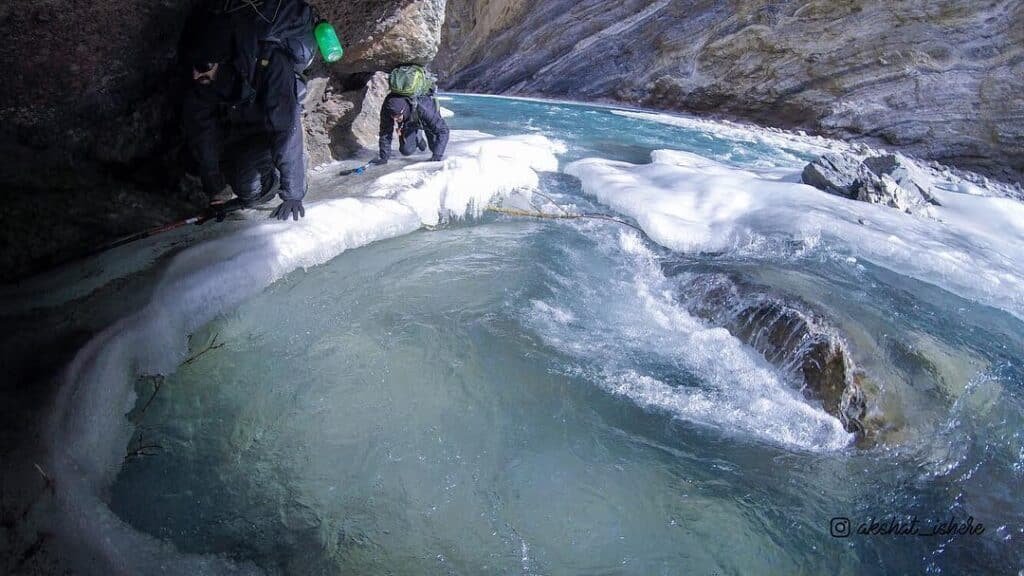
Adventure doesn’t knock on your door, you need to go knocking!
And when you’re knocking on the door of an adventure like the frozen river trek, preparation is key. So let’s dive in!
Physical Fitness Preparation
To conquer the icy path, you need a fair amount of physical fitness. High-altitude trekking is not a walk in the park! You’ll be treading on a frozen river, battling low temperatures and thin air. Regular cardiovascular exercises can be your best ally here. Engaging in activities such as running, cycling or swimming for at least 30 minutes every day, about two months prior to the trek can significantly boost your stamina.
Essential Gear and Equipment
As the saying goes, “There’s no such thing as bad weather, only unsuitable clothing”. For the trek, gear up with winter essentials such as:
- Trekking Shoes: Opt for high ankle waterproof shoes with good grip.
- Insulated Water Bottle: Hydration is crucial at high altitudes.
- Headlamp: Power cuts are frequent in Leh.
Remember to pack light yet smart!
Recommended Clothing
In the brutally cold terrain of Zanskar River valley, your clothing is your lifeline. Layering is the secret sauce to withstand the extreme temperatures.
- Base Layer: Thermal innerwear that traps body heat.
- Middle Layer: Fleece jacket for insulation.
- Outer Layer: Waterproof and windproof jacket.
Don’t forget thermal socks, woollen cap, gloves and sunglasses!
Acclimatization and Altitude Sickness
High altitude equals low oxygen levels. Your body needs time to adjust to this new environment – a process called acclimatization.
Importance of Acclimatization
Acclimatization minimizes the risk of altitude sickness which can turn fatal if ignored. Spending two days in Leh before starting the trek can help your body acclimatize.
Symptoms and Prevention of Altitude Sickness
Watch out for symptoms like headache, nausea or breathlessness. If you notice any of these signs:
- Descend immediately
- Keep yourself hydrated
- Avoid tobacco and alcohol
Tips for Acclimatizing Properly
- Increase altitude gradually
- Maintain a healthy diet
- Stay hydrated
Remember, slow and steady wins the race! Take it easy on the first few days of trekking.
Embarking on this difficult trek demands grit, determination and above all – thorough preparation. With these tips in your toolkit, you’ll be ready to brave the Icy Wonderland! The majestic Zanskar awaits you – tread its frozen path and etch an unforgettable memory into your adventurous hearts!
Getting to the Chadar Trek Base
The journey to the trek begins with an exhilarating travel to Leh, a high-desert city in the Himalayas. Nestled at an altitude of 3500 meters, Leh isn’t just any pitstop. It’s the gateway to your ultimate adventure!
Flights are the most convenient way to reach Leh, with regular services from Delhi. The aerial view of snow-capped mountains is a sight that sets the mood for your trekking expedition. Alternatively, if you’re up for a road trip, there are buses from Manali and Srinagar, but remember these routes are accessible only during summer and not during winter, so the only way to access Leh is via flights during the winter season .
Once you touch down in Leh, don’t rush off to the base camp yet! Your body needs time to adjust to the high altitude. Spend a couple of days exploring Leh’s charming monasteries and bustling markets. This period of acclimatization is crucial for a successful trek ahead.
With lungs full of mountain air and hearts pounding with excitement, it’s time to set off towards the trek base camp located at Chilling. There are shared taxis available from Leh which will take you on a scenic drive along the Indus River till you reach Chilling.
From Chilling, it’s a small hike to Tilad Do, your first encounter with the frozen Zanskar River and your actual starting point of this icy adventure. Be prepared as this is where reality hits – The Chadar Trek is not just another walk in the park!
While the journey to reach Chadar can seem daunting, Nomads of India are here to guide you every step of the way.
As we always say – The journey matters as much as the destination!
Budget & Costing
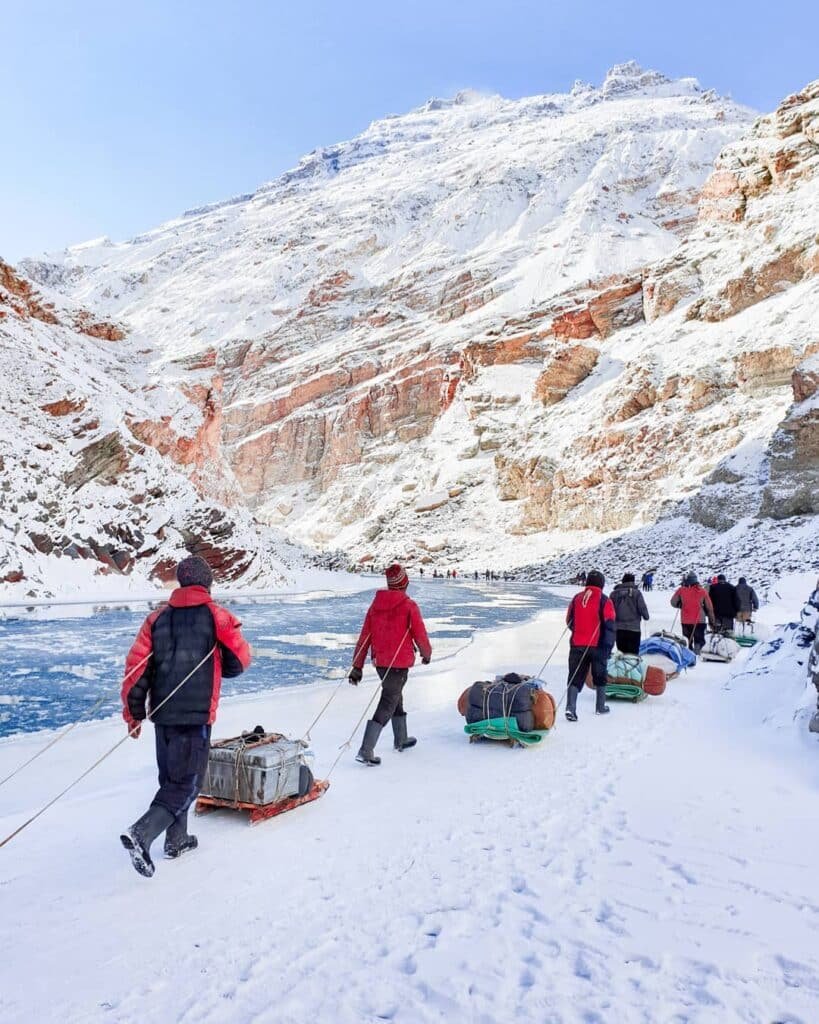
Before embarking on this adveture, it’s essential to plan your budget carefully. The total cost would depend on various factors such as mode of travel, accommodation type, gear and equipment, guides, permits, and other miscellaneous expenses.
Here are some estimated costs for your reference:
- Flights: A round trip flight from Delhi to Leh can range anywhere between ₹10,000 – ₹20,000 depending on when you book.
- Accommodation: Budget hotels in Leh can cost around ₹ 1,000 – 2,000 per night while a more luxurious stay can go up to ₹ 5,000 per night.
- Trekking Gear: Buying new trekking gear can hit your wallet hard. Consider renting equipment like trekking shoes, insulated water bottles and headlamps which can cost around ₹ 1,000 – 2,000 .
- Trek Package: A comprehensive package from a reputed trekking company usually costs between ₹ 20,000 – 25,000 . This generally includes accommodation, meals during the trek, first aid kit, guide charges and permit fees. The group size is usually around 20-25 people
Remember that these are estimated costs and actual expenses may vary. It’s always sensible to carry some extra cash for any unforeseen expenses. Happy budgeting!
But hey, don’t just take our word for it! Pack those bags, lace up those boots and let’s get ready for an unforgettable trip of a lifetime! We’ll continue our trekking story in our next section: Itinerary .
Next Stop: A day-by-day guide through this epic journey…
Chadar Trek Itinerary: Your Daily Dose of Adventure
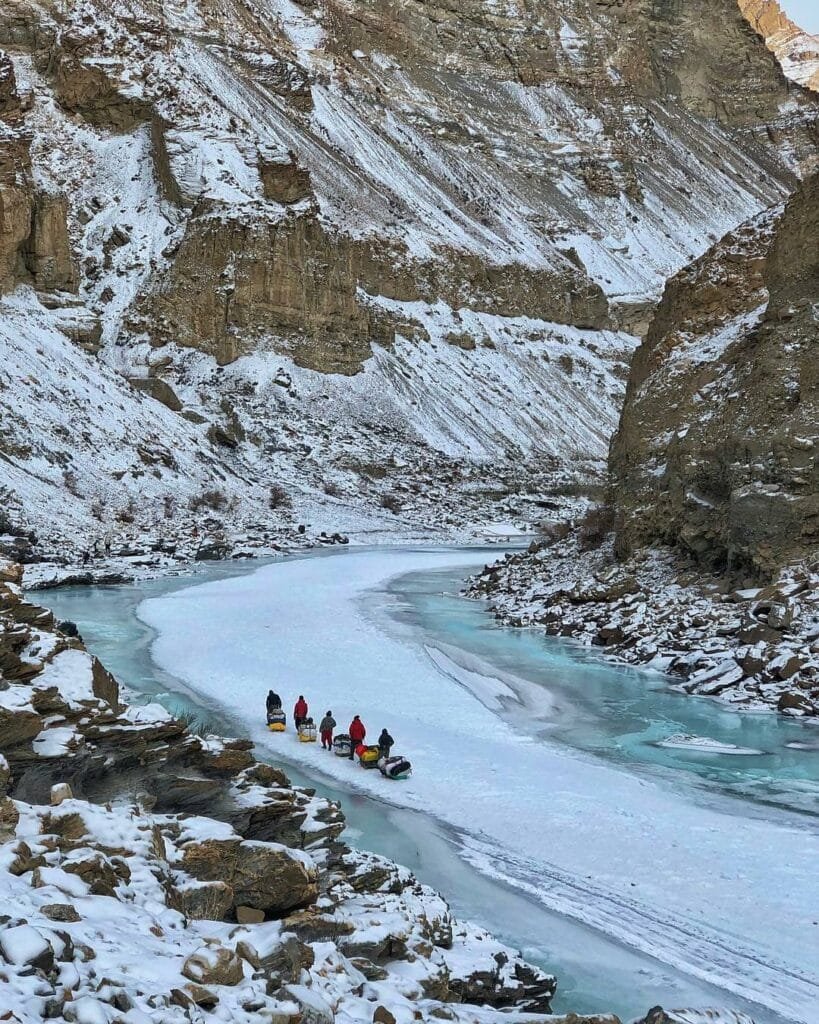
Day 1: Your Arrival in Leh (3,500 M)
Your journey begins in Leh, the gateway to Ladakh with towering peaks. During the winter, the only viable route to Ladakh is by air, and flights from Delhi to Leh provide captivating aerial views of the Himalayas. Make sure to secure a window seat for breathtaking vistas.
Dedicate the first day to acclimatizing to the high altitude. As you transition from sea level, your body will need time to adjust to the mountain environment. While the Leh winters are harsh, this marks just the start of your cold weather experience.
2nd Day: Rest & Acclimatization in Leh (3,500M)
This day focused on helping you adapt to the altitude and climate. Take the opportunity to explore the city market, immerse yourself in the local culture, and visit nearby sites. Gradual movement aids in acclimatization. Also, utilize this time to review your checklist and make any last-minute purchases for the trek. Leh offers an excellent market for trek essentials.
Day 3: Further Acclimatization in Leh (3,500M)
On day three, the process of acclimatization continues. A necessary medical examination at the Tourist Information Centre is planned, playing a vital role in acquiring the required permits from ALTOA and the Wildlife Department for commencing the trek.
4th Day: Trek from Leh (3,500M) to Shingra Koma via Bakula (3,215M)
Distance: 70 km | Duration: 2-3 hours
Today marks the start of your trek as you drive to Bakula, the trek’s starting point. Beginning early, you’ll follow the scenic route along the Indus River, passing the confluence of the Indus and Zanskar Rivers at Nimmu. This picturesque 70 km journey, lasting about 3 hours, treats you to breathtaking views as you navigate narrow hairpin bends. As you approach Bakula, the frozen expanse of Zanskar unfolds before you. Upon transitioning to the Chadar, your trek leaders will guide you in traversing the icy terrain. Embrace the learning curve of walking on this glassy ice using the Penguin Walk technique, and you’ll quickly become adept.
One notable feature of the trek is the consistent, level terrain. There are no steep ascents or descents, and minimal altitude gain reduces the risk of altitude-related issues. Mastering today’s walk signifies adequate acclimatization, boding well for the trek ahead.
The appearance of the Chadar varies with weather conditions. It might be glassy, covered in powdery snow for better traction, or thinly iced in certain sections, requiring navigation through slush or along the riverbank. Safety lies in following the sledge route used by porters.
Depending on your pace, you should reach the next campsite in 3-4 hours. This marks your first night of Chadar camping.
Day 5: Trek from Shingra Koma to Tibb (3,280M)
Distance: 14 km | Duration: 6-7 hours
Waking up to the freezing cold entails leaving the warmth of your sleeping bag and tent. Yet, the hospitable people of Zanskar ensure a comforting start with hot tea and meals. Today’s 14 km journey to the next campsite spans 6-7 hours due to the challenges of Chadar walking. Remember to refill your thermos with warm water, as standard bottles succumb to the cold. Sunlight is a rarity in this gorge, appearing briefly due to the surrounding towering mountains. As you traverse the vast valley, relish the crisp air and the deep blue hue of the Zanskar river, mirroring the sky on clear days. Frozen waterfalls adorn the route. Pause by the river to cook meals and ensure energy levels remain ample. The final stretch to Tibb, about 200 meters, is captivating. Arrival at the campsite is anticipated by late afternoon.
Day 6: Trek from Tibb (3,280M) to Nerak (3,400M)
Distance: 12 km | Duration: 5-6 hours
Day six presents an encounter with the highlight of the trek, Nerak Waterfall. A substantial journey lies ahead, necessitating an early start to reach the waterfall by late afternoon. Amid the Zanskar Valley’s early sun departure, staying active is vital to staying warm. Noteworthy are the broken ice formations in the frozen river, forming captivating geometric patterns. Midway, a unique lunch awaits within a spacious cave. After arriving at the campsite, you’ll visit the awe-inspiring Nerak waterfall, a 30-minute walk away. Keep an eye out for domestic Yaks and relish the sight of the traditional wooden bridge juxtaposed with a modern counterpart. Time spent at Nerak waterfall is followed by dinner back at the campsite.
7th Day: Trek from Nerak (3,400M) to Tibb (3,280M)
Distance: 12 km | Duration: 6-7 hours
Following the exhilarating Nerak waterfall experience, you’ll trace your steps back to the Tibb campsite. The return journey, while familiar, offers a fresh perspective. The ever-changing frozen Zanskar River reacts to temperature fluctuations, transforming its appearance. Listen closely to the evolving sounds underfoot, a captivating aspect of Chadar trekking. Alongside the trail, local porters in traditional attire, called ‘Gonchas,’ demonstrate remarkable ease traversing the icy terrain. Their cheerful greeting of ‘Julley’ resonates – a Ladakhi welcome. Encounters with local songs and their adept sledging add cultural flair. As you penguin-walk to Tibb, the locals effortlessly overtake you.
Day 8: Trek from Tibb (3,280M) to Bakula (3,215M) and Return to Leh (3,500M)
Distance: 12-13 km | Duration: 7-8 hours
The final leg takes you full circle to Bakula, a 7-8 hour trek. From there, a 3-hour drive returns you to Leh, where you’ll spend the night in a hotel.
Day 9: Departure from Leh
The trek concludes. Given the unpredictable high-altitude weather and conditions, allocate buffer days between the trek’s end and your departure to accommodate travel arrangements.
“Every day on Chadar Trek is different, bringing new challenges and experiences!”
Camping & Accommodation
On the trek, your home under the stars changes every day! Camping sites are allocated by authorities based on safety considerations. You’ll be provided with high-quality tents that can withstand harsh weather conditions.
Activities & Attractions
Chadar Trek isn’t just about challenging yourself physically; it’s also about immersing yourself in nature’s beauty. From watching a sunrise over frozen Zanskar, visiting ancient monasteries in Leh, and walking through fascinating ice-formation landscapes, each day promises new sights that will leave you spellbound!
“Chadar Trek isn’t just a journey; it’s an experience that stays with you forever.”
Up Next? A Peek Into The Highlights Of Chadar Trek
But wait! There’s still so much more we haven’t touched upon —like those hypnotic frozen waterfalls or our encounters with local culture! So let’s continue our snowy saga and explore some highlights from this once-in-a-lifetime adventure!
Highlights of Chadar Trek
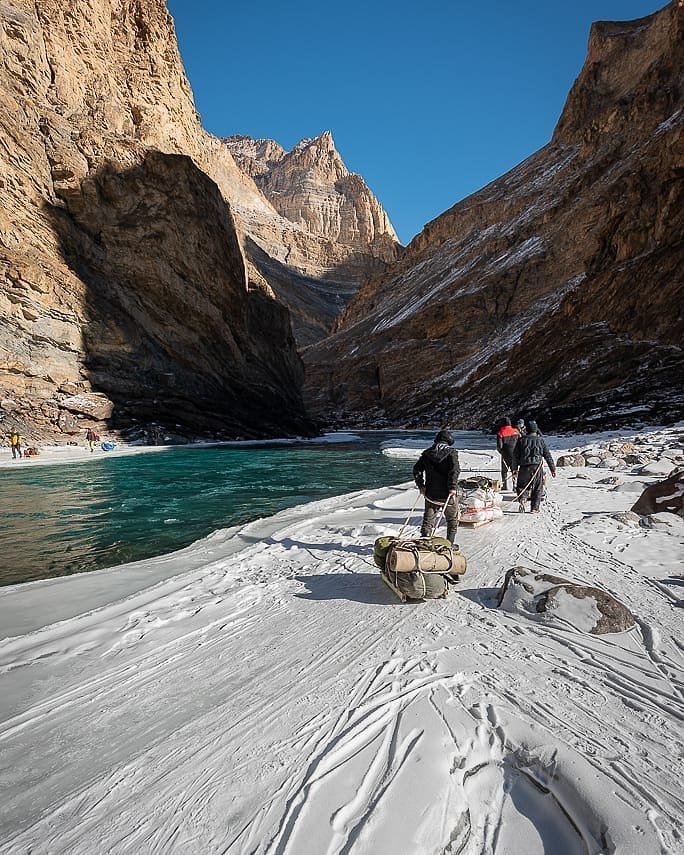
Embark on a journey where each step unveils a new wonder, each turn presents a vista more stunning than the last. Be it the awe-inspiring frozen waterfalls or the tranquil Zanskar River , this trek is replete with unique experiences and unforgettable sights.
Dance with Frozen Waterfalls
Imagine a waterfall, frozen in time, creating a spectacle so surreal that it leaves you breathless. The trek introduces you to such magnificent frozen waterfalls, an ethereal artwork of nature that defies description. It’s akin to walking through a dream, where cascading waters have been paused mid-fall, held captive by the cold winter air.
Surrender to Zanskar’s Charm
Next on the list is the hypnotic allure of the Zanskar River. Dressed in its winter attire, a glossy sheet of ice, it’s truly mesmerizing. The river becomes your constant companion along the trek, its gentle whispers echoing through the silent valleys. As you walk over its icy surface, you’ll be treated to views so enchanting they seem straight out of a fairy tale.
Lose Yourself in Nature’s Artistry
The landscapes here are nothing less than divine poetry etched in snow and ice. Each day breaks to unveil scenic views that can move even the most hardened hearts. The pristine white snow fields contrasted against clear blue skies will leave an indelible impression on your soul.
Immerse in Local Culture
Finally, don’t miss out on embracing the rich local culture of Ladakh. This trek isn’t just about physical endurance; it is also about understanding and appreciating the resilience of locals who thrive in these harsh conditions. Interact with them; their warmth and hospitality will add another layer to this already fulfilling experience.
The Chadar Trek experience ? It’s more than just an adventure. It’s a transformation, a shift in perspective that only the daring ones get to witness. The frozen Zanskar river beneath your feet, the milky way above your head at night, and the adrenaline rush piercing through your veins – it’s an unforgettable journey etched in ice and memories.
Recall those moments of struggle, pushing through physical boundaries, braving extreme conditions. Remember how you emerged stronger, filled with a sense of achievement? That’s personal growth! You didn’t just conquer a trek; you conquered yourself.
“It’s not the mountain we conquer but ourselves.” – Edmund Hillary
And now? Now it’s time to pass on the torch. Encourage others to step out of their comfort zone and embrace this icy adventure. Share your experiences, tell them about the breathtaking views, the thrill of walking on a frozen river, and the silence of the mountains.
Because at the end of the day, it’s not just about reaching the summit or completing a trek. It’s about experiencing something extraordinary, something that makes your heart race and eyes sparkle with wonder.
So go on, and inspire someone today to embark on their own trek adventure. For there is no joy greater than inspiring another soul to explore the beauty of this world.
Don’t forget – every mountain top is within reach if you just keep climbing.
The Chadar trek has not been banned. However, it’s important to note that the status of trekking routes and regulations can change over time. Before planning your trip, it’s advisable to check with local authorities and tour operators for the most up-to-date information on trekking permissions and bans.
The cost of the Chadar trek can vary depending on several factors, including the tour operator you choose, the duration of the trek, the inclusions (such as accommodation, meals, transportation), and any additional activities. On average, the cost could range from approximately ₹20,000 to ₹35,000 or more per person. It’s recommended to compare different tour packages and choose one that aligns with your budget and preferences.
Yes, the Chadar trek is considered to be a challenging and potentially risky adventure due to its extreme weather conditions and the frozen Zanskar River. The temperatures can drop significantly, and the frozen river conditions can change rapidly, leading to cracks or holes in the ice. Trekkers need to be prepared for sub-zero temperatures, altitude-related concerns, and the unpredictable nature of the ice. Proper planning, experienced guides, and appropriate gear are crucial to mitigate the risks associated with this trek.
The Chadar trek is known for its difficulty and harsh conditions, making it less suitable for beginners. It demands a certain level of physical fitness, mental resilience, and prior trekking experience. It’s advisable for individuals attempting the Chadar trek to have some experience in high-altitude treks, cold-weather conditions, and challenging terrains. If you are a beginner, it’s recommended to gain trekking experience on less demanding trails before considering the Chadar trek. Always consult with trekking experts and guides to assess your readiness for such a demanding adventure.
- trekking guides
- No comments yet.
Add a comment
Leave a reply · cancel reply.
Your email address will not be published. Required fields are marked *
This site uses Akismet to reduce spam. Learn how your comment data is processed .
- Share via...

- Treks in Himachal Pradesh
- Treks in Uttarakhand
- Treks in Sikkim
- Treks In Jammu & Kashmir
- Uttarakhand
- Himachal Pradesh

Chadar Trek Guide 2024: Distance, Route, Map, Best Time & Itinerary
Table of Contents
Displaying a surreal backdrop of vibrant colors, the Frozen River Trek popularly known as the Chadar Trek is one of the most challenging and strenuous treks in the Ladakh region of Jammu and Kashmir State in India.
Therefore such a trek is only and only meant for those amateur and experienced trekkers that have one or two trekking experiences and also, wish to experience the ultimate thrill and excitement.

This trek is a winter trail in the Zanskar region of Ladakh . Moreover, the Zanskar region is famous for its stunning scenery and Tibetan-style Buddhist monasteries.
This arduous trek trail on the ice-clogged river under the gleaming blue winter sky passes through numerous beautiful valleys, mountain caves, and frozen waterfalls.
It is also one of the most strenuous treks in the Indian Himalayas as trekkers have to pass through rugged rocks and temperatures may surprisingly dip to minus 10 degrees, a rare climatic condition that can be difficult to acclimate to.
Chadar Trek Images
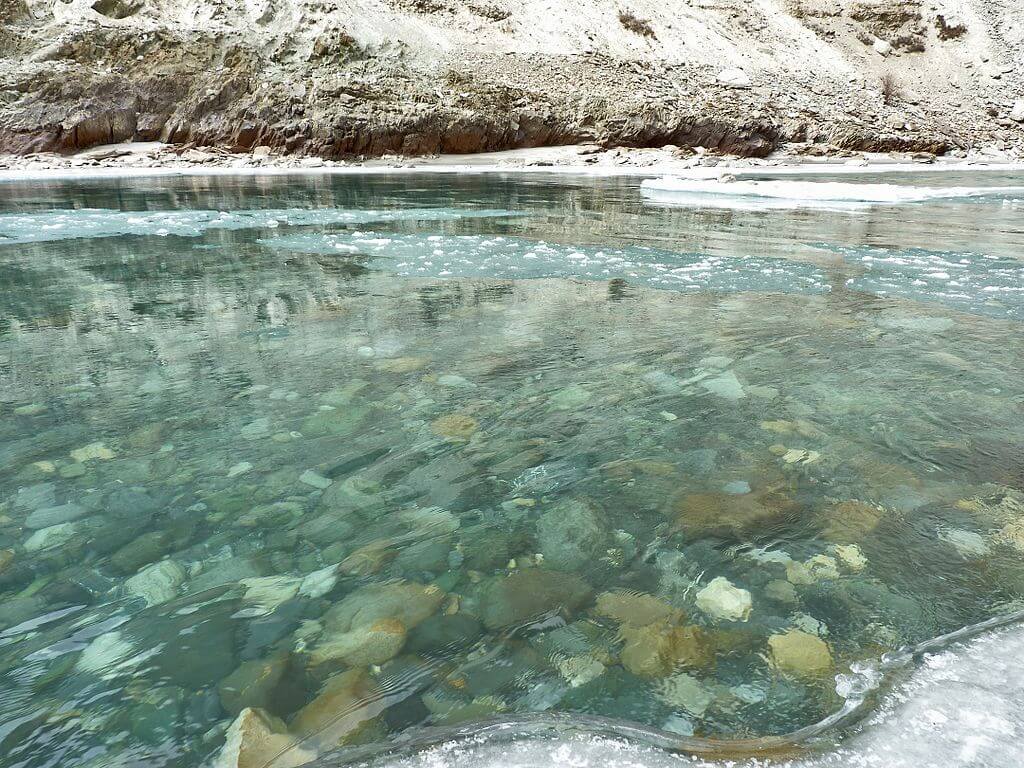
Where is Chadar Trek?
During the winter season, the Zanskar River freezes, giving trekkers a perfect solid platform for trekking. So just imagine, the trail to the Zanskar valley is going to be a challenging yet thrilling experience for the trekkers as the frozen vertical cliffs are 600 m high, and the Zanskar river is about 5 m wide.
Best Time to Visit Chadar Trek
The ideal time to visit the Frozen River Chadar Trek is between mid-January to February as during this time the upper layer of the Zanskar River freezes. The river looks like a sheet of ice; hence, it is referred to in the local language as ‘Chadar’ which means blanket.
Read more: Hidden Hill Stations In India
The winter in Ladakh region is frigid with nature. From January to February the days are relatively warmer but there will be a chill in the air. January is the coldest month in Ladakh. Early mornings, evenings and night times are extremely cold.
Daytime temperatures in Leh, and on the trek, will be between –25°C to 6°C and night-time temperatures can drop to -25°C to – 35°C. There is heavy snowfall in January and February and everything around is covered in pristine white snow.
Chadar Trek Highlights
- Trek along the conventional winter trading route connecting Padum to Ladakh along the frozen Zanskar River.
- This is an arduous adventure with only a couple of groups making the trek every year. The conditions on the river can vary so a flexible approach is required!
- Gain insight into the local culture of Zanskar and you will get a unique opportunity to homestay in the beautiful Zanskari villages along the way.
- Go for a sightseeing tour to explore the architecturally rich Gompas and forts around Leh as you
- let yourself acclimatise to the altitude.
How to Reach Chadar Trek?
Leh Kushok Bakula Rimpochee Airport is the main airport in Leh City. There are quite a number of flights like Air India and Go Air that connect Leh with Delhi and with a few other major cities in India. You can opt for air travel and have a very unique and thrilling experience of flying over the mountains.
Leh is inaccessible via roadways and railways during this time period(winter season).
Read more: Sham Valley Trek Ladakh
Places To Visit Near Chadar Trek (Zanskar Region)
1. Zanskar Valley
An acute and mesmerizing sight, Zanskar Valley is popular for the challenging treks it offers. With the craggy landscape of the surrounding mountains, the snow-covered peaks, the smooth flow of the misty clouds, the breathlessness offered by the isolation, and the flawless glory of nature, the valley is a breathtaking sight. This valley sits in the Zanskar range of the great Himalayan Mountains.
The range, rising to an elevation of about 6000 meters, is home to several exotic flora and fauna species. On the way to the valley, you can witness captivating meadows, gleaming streams, and the Drang-Drung Glacier among other sights.
2. Pensi La Pass
Known for separating the Zanskar valley from the Suru valley, Pensi La Pass is located at 4400 meters above sea level in the Zanskar range of mountains.
Rich with exotic medicinal plants, blue-green water springs and a spectacular view of the circumscribing mountains, this region is the best campsite for trekkers who wish to refresh themselves before resuming their journey. A variety of fauna are also present here including the commonly observed marmots and brown bears .
The Pass is also bounded by glaciers on both sides, from which streams flow into the Suru and Zanskar river, creating an enchanting sight.
But it is accessible only during the months from May to September, and the region is submerged and hazardous due to heavy snowfall observed during the rest of the months.
Named after an ancient Indian Buddhist master called Padmasambhava who was known as the second Buddha, the historically rich town of Padum rests at an altitude of 3669 metres in the Zanskar range.
The most populated town of Zanskar, Padum also serves as the abode of flora and fauna species.
Once the known capital of the ancient Zanskar Kingdom, the region still holds ancient relics like intricate carvings on a large rock situated on the banks of the river Lung-nak, dating back to the 8th century.
The town also consists of two ancient Buddhist monasteries situated on the hilltop. Apart from these attractions, the breathtaking beauty of the surrounding areas from this region is too lovely to be put into words.
Also acting as a trekking base, the landscape comprises of vast grasslands, huge agricultural fields, lush green forests, beautiful streams and the ruggedness of the mountains.
4. Zanskar River
As mentioned above, the Zanskar River trek or the Chadar Trek is a winter trail and is undertaken by some of the bravest souls of the land. One of the largest tributaries of the river Indus, Zanskar River emerges from the north-facing Himalayan slopes.
Further, the Zanskar River bifurcates into the Doda tributary, which begins in close proximity to the Pensi La Pass and flows alongside the Zanskar Valley towards Padum, whereas the Kargyag river tributary forms the second branch emerging from the Shingo La and Tsarap river.
The confluence of these two tributaries forms the Lungnak river which is also called as Lingti or Tsarap river. The entire area of the Zanskar river forms a U-shaped valley owing to the surrounding glaciers.
A captivating sight by day as well as during the night, the river provides an enthralling trek, especially during the winter months at a whopping elevation of 3800 metres making it a must-visit site.
Situated between Kargil and Padum, Rangdum is an elliptically shaped plateau in the Kargil district of the Jammu and Kashmir State. Situated at an elevation of 3657 metres, the plateau lies in the Suru Valley region about 100 kilometres away from the Kargil city.
Surrounded by colourful hills on one side and dazzling white glaciers on the other, the region is an alluring place. The Drang-drung glacier can also be witnessed from this region.
A beautiful region in the north of India, Zanskar is home to such amazing places that you can explore to relish your lovely vacation.
Frozen River Chadar Trek Itinerary
Day 1: Delhi – Leh (Rest for acclimatization)
Take a flight from Delhi to Leh. I would suggest a morning flight. On arrival at Ladakh, take a taxi in order to reach the hotel. Then you can visit the local markets of Leh like the Tibetan market for clothes and the Moti market in the evening. Try to return early from the markets and take proper rest in the hotel.
Day 2: Leh – Shey – Thiksey – Hemis
So, today you will be heading on a sightseeing tour to some important monasteries in the area. You will be visiting Shey Gompa, which was once the summer capital of Ladakhi kings; Thiksey Gompa, which is said to be one of the most beautiful structures in Ladakh and the famous Hemis Monastery belonging to Drukpa Order. Then, you may stay at the guest house in Leh.
Day 3: Leh – Chilling (3200 mts/ 5 hrs drive)
Start the day with a hearty breakfast and then embark on a trip to Pishu Village, through the roads that are bestowed with the sheer charisma of nature. Overnight, stay in the guest house.
Day 4: Chilling – Zaribago (3250 mts / 5 hrs)
Try to wake up by 7 am. I know it is difficult to wake up so early when you are on vacation. Yet, to make your vacation special try to follow some tips. Then get fresh and eat a proper, light, and healthy breakfast. Also remember to carry some biscuits, fruits, water bottles, and napkins along with you.
Begin the first day of the trek to Zaribago, which will take approximately five hours to reach. Overnight, stay in Zaribago.
Day 5: Zaribago – Deepyokma (3300 mts/ 5 hrs)
Today, it is going to be a thrilling yet exciting experience as you will walk on the frozen Zanskar River till you reach Deepyokma. Overnight, stay in the Deepyokma camp.
Day 6: Deepyokma – Nyarakpulu (3400 mts/5-6 hrs)
Today you need to reach Nyarakpulu below the Nyarak village from Deepyokma by trekking for about 5-6 hours. Overnight, stay in the camp.
Day 7: Nyarakpulu – Lingshed (3800 mts/ 4 hrs)
Depart from Nyarakpulu and have an hour’s walk to reach the small village of Lingshed. Relish the local culture and pleasing atmosphere of the private houses equipped with central heating systems.
Day 8: Lingshed (3800 mts)
Get ready for a fun-filled and exciting day of the Frozen River Chadar Trek. Witness the breathtaking landscapes of Lingshed, visit the monasteries and spend time with the natives of Lingshed. Stay in a Lingshed guest house.
Day 9: Lingshed – Nyarakpulu ( 3400 mts/ 5 hrs)
Today you need to trek till Nyarakpulu. Overnight, stay in a Nyarakpulu guest house.
Day 10: Nyarakpulu – Tso Mopoaldar (3200 mts/8 hrs)
Today, get ready for a long walk of around 5 hours from Nyarakpulu to the campsite at Tso Mopoaldar.
Day 11: Tso Mopoaldar – Tilatdo
Post a nutritious breakfast and embark on a trek till Tilatdo. Overnight, stay in Tilatdo.
Day 12: Tilatdo – Chilling – Leh
Return to Chilling. Drive ahead and reach Leh. Overnight, stay at a hotel in Leh.
Day 13: Leh – Delhi
Now your trip is still not got over. You still have to reach your home. So, reach the airport in time to catch the flight to Delhi and also, for those who have come by road, I wish you a safe journey ahead. Do not forget to capture some photos,and shoot videos while driving through the hills, forests, and then the plains.
I know you must be feeling quite tired and also sad at the same time because your trip has now come to an end. But I hope you enjoyed your trip to Frozen River Chadar Trek. Till then, keep on trying new trekking activities. We will meet soon with a new trek!
Frequently Asked Questions About Chadar Trek
When should i book for chadar trek.
You should book this trek two to three months in advance so that you get an ample amount of time to prepare for the trek.
What is the Minimum Age Required for Chadar Trek?
The Chadar trek is a moderate trek with a maximum altitude of 3850 mts/12628 ft, so the minimum age required is 15 years.
What kind of shoes will be Required for Chadar Trek?
Trekking shoes with good ankle support are a must for any trek in the Himalayas. Quechua Forlclaz 500, Hi-Tec Colman, and Salomon are some of the ideal shoes with value for money.
Is it Safe to Drink Water From Streams?
Himalayan stream water is safe to drink as well as for cooking but it is better if you can carry a few chlorine tablets for disinfecting water.
Which Vehicles are Used for Transportation Purposes?
Most of the Himalayan roads towards the trek are rugged, so a vehicle with good ground clearance like Mahindra Bolero, Scorpio, Safari Dicor, Tata Sumo, etc are used for transportation purposes
Is Chadar Trek for Beginners?
What i believe is that yes, chadar treks are for beginners but if they follow your guide instructions properly so there is no harm and the rest of thing is dependent upon yourself.
- Share This Post:
Related Articles
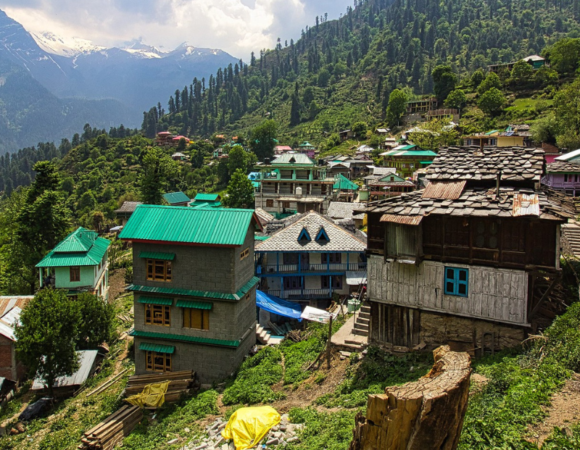
10 Best Hill Station In Himachal Pradesh, Highlights, FAQ’s
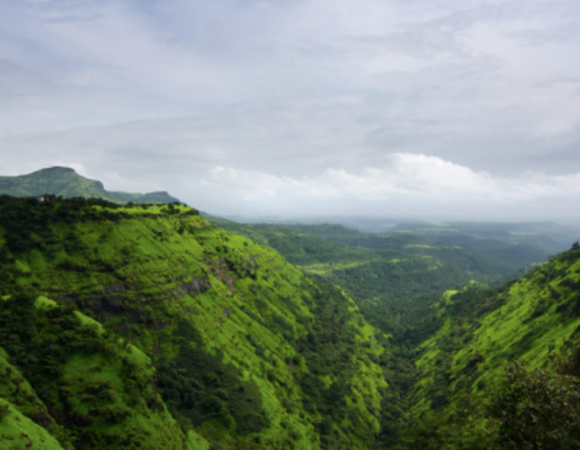
10 Best Hill Stations In Maharashtra, Highlights & FAQ’s
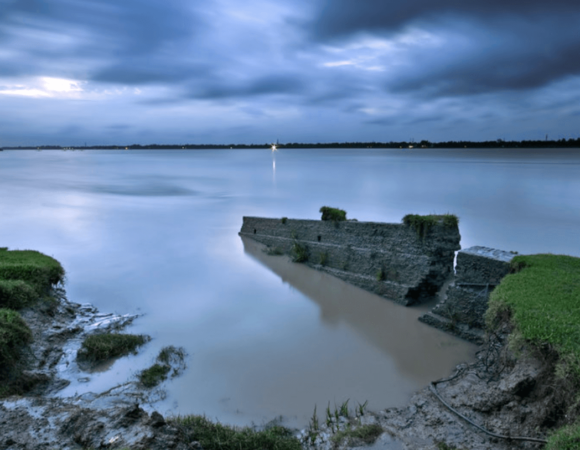
10 Best Hill Stations In West Bengal – Best Time, How to Reach Highlights & FAQs
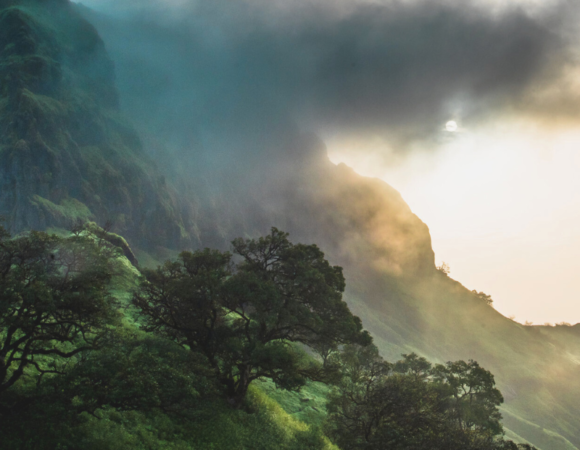
10 Best Maharashtra Trekking Places, Highlights, Treks & FAQ’s
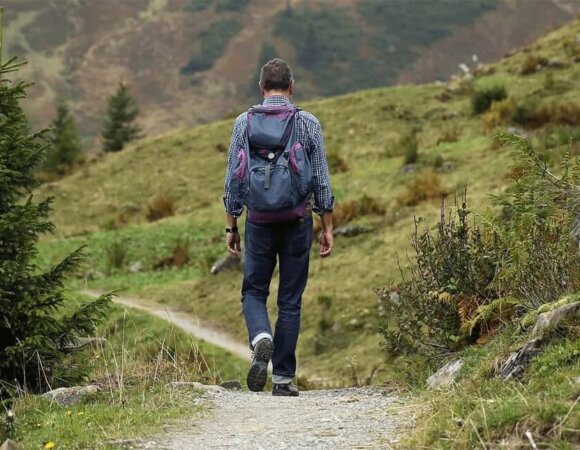
10 Best Trekking Places Near Delhi In 2024 & FAQ’s

10 Best Treks in Himachal That You Can Do in Winters
Add a comment cancel reply.
Save my name, email, and website in this browser for the next time I comment.
Things To Carry On Your Trek
Book your experience with us.
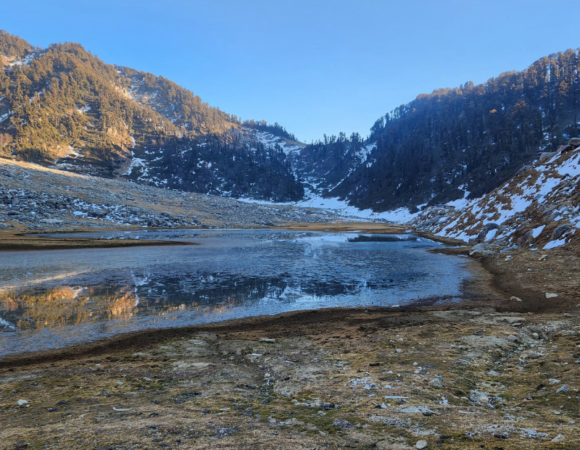
- Amenities 5
Kareri Lake Trek
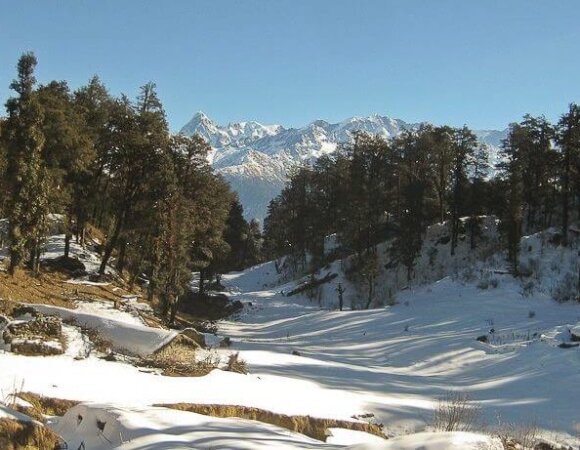
Dayara Bugyal Trek
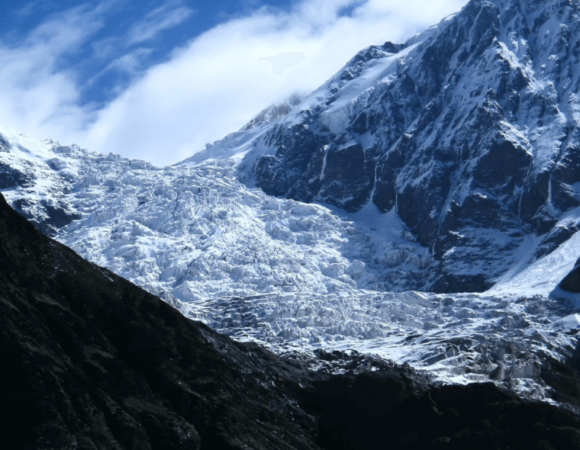
Pindari Glacier Trek

Snowline Trek
Book your unforgettable experience with us, reset password.
WhatsApp Us
- More Networks
Chadar Trek
Can You Help Us With Photographs Of This Trek?
We are looking to enrich this documentation with more photos. Pictures go a long way in explaining the trail, more than words ever can. If you have done this trek, can you share your photos with us? We will include them on this page, with due credit to you. Click here to contribute .
The Complete Guide to Chadar Trek
Chadar trek is no doubt a great trek to do. But the trek is now being controlled by a mafia, led by ALTOA (All Ladakh Tour Operators Association). Members and associate members of ALTOA decide which local operator will run the trek, how many people must trek in a group, who the transporters will be, and also demand to be paid a regular sum of money in various forms. They neither promise the safety standards of Indiahikes nor any of our service standards. When Indiahikes refused to be a part of such arm twisting, ALTOA members resorted to violence and hooliganism. Read more about it here .
Indiahikes was instrumental in bringing Chadar to the forefront of the trekking map in India. It is with great regret we announce that we will not run the Chadar trek this year. We did not wish to work with cartels or hooligans. But we can help any trekker seeking our help to do this trek with our advice and suggestions about different aspects of the trek. We have everything that any trekker would want to know about and are willing to answer your queries regarding this trek.
➤ Short Itinerary
Why chadar is the most glamorous trek in india.
- The Chadar frozen river trek is extremely glamorous. It is easy to see why. Travel magazines worldwide show incredible pictures of Buddhist monks walking bare feet on the frozen river. The Discovery and the National Geographic channels have both made films on the Chadar trek. Anyone who returns from the Chadar trek adds to the aura around it by talking about the conditions in a revering way.
- It is a 6-day trek in inhospitable conditions. It is a trek over a frozen river in Ladakh. The average mean temperature during the day is minus 10. At the night, temperatures fall to minus 20 and 25. Ice forms break and change colour on the river every few hours. In places, the Chadar (or ice) does not form over the river. Trekkers then have to forge a new trail climbing over snow-covered embankments to descend to a spot on the river where the ice is more stable. The truth is that extreme conditions are not hard to beat.
- With multiple layers and sensible trekking, the Chadar trek is not very difficult. But what sets it apart is its unique experience. Everything about it is unique: the scenery, temperature, atmosphere, the frozen river, sledges, unusual campsites, caves and the ever-changing Chadar. So unique that it has to be experienced. In our Indiahikes list of treks, the Chadar, by far, is the most unique trek.
➤ Trail Information

Complete day-wise trek details
Day 1: report at leh. stay overnight..
The only way to get to Leh in the winter months is by flight. All flights land in Leh in the morning before noon. As your aircraft enters the Ladakh region, look below to see the undulating mountain ranges enveloped in a white blanket of snow. The temperature in Leh is always in the negative. Keep a jacket, woollen cap and gloves handy in the flight to face the blast of cold air the moment you land the plane. Leh is covered by a blanket of snow. It's white all around. Sometimes the roads have a coating of a thin sheet of ice. Watch out when you walk on them and be wary of slips and falls. The city of Leh is only partly open during the winter months. Only the shops catering to the local needs are open. Buy all your gear from your city and don’t keep any major shopping to do at Leh. Leh at 11,800ft is higher than your entire trek. It is colder too. Daytime the temperature hovers at around -10 degrees and after sundown drops to -16 or more. Get used to the cold at Leh during the day in the sun but get into your rooms once the sun goes down.

Day 1: View. Picture from Indiahikes Archive
Day 2: Drive to Chilling.
3 hours. trek from the road head to tilat sumdo. 2 km 1 hour..
Chilling, the start of your walk on the frozen Zanskar river is 64 km away from Leh. Drive on the Leh Srinagar highway till Nimu where the Indus meets the Zanskar. At Nimu take the road heading left and drive along the Zanskar. The road goes up along the Zanksar. Spot the frozen sheets of ice or Chadar forming on the river already.
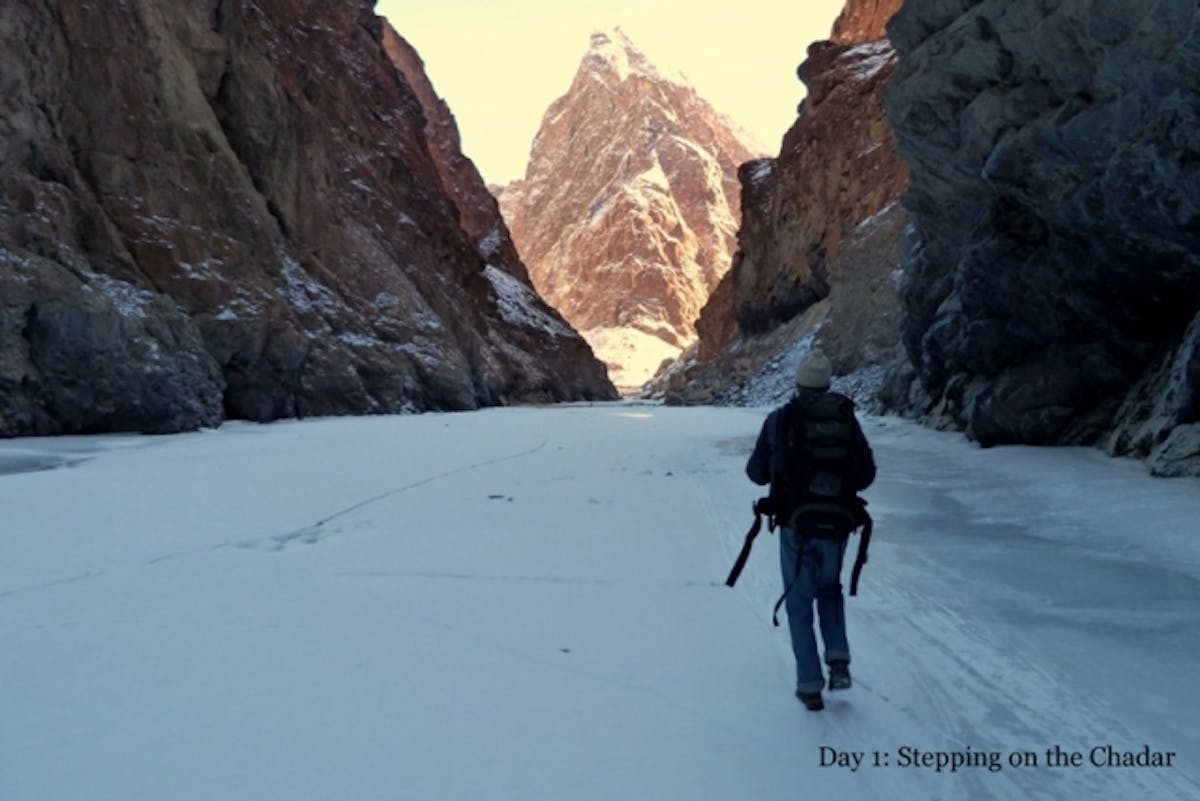
Stepping on the Chadar. Picture from Indiahikes Archive
An hour and half more along the Zanskar brings you to Chilling. A few army sheds and a couple of shut buildings dot the almost shut hamlet of Chilling. The road goes a few km beyond Chilling. Drive ahead until you can see the end of the road. This is where you leave the road and hit the Chadar. Take your first few steps on Chadar carefully getting a feel of the surface you are stepping on. The Chadar surface can be of various kinds – a coating of fresh powder snow, hard and shiny ice, a freshly formed chadar (sheet of ice), chadar that's weak and breaking or another new texture. It is easy to walk on a fresh coating of snow. The snow gives you a good grip and you can walk normally. An old hard and shiny surface of ice is what is tricky initially. Do a penguin kind of walk on such a surface without lifting your feet too much off the ground. The Tilat Sumdo campsite comes within an hour of your trek. Sumdo means confluence. A local tributary joins the Zanskar from your left. An elevated level field makes a good camping spot. On the opposite side are a few caves where those not carrying tents can camp. The locals on their journey through the Chadar tend to stay in caves. Tilat Sumdo will be your first experience of camping out in freezing temperatures. A campfire will make it better but it comes at the cost of the last traces of vegetation (dried) left on the banks of the Chadar.
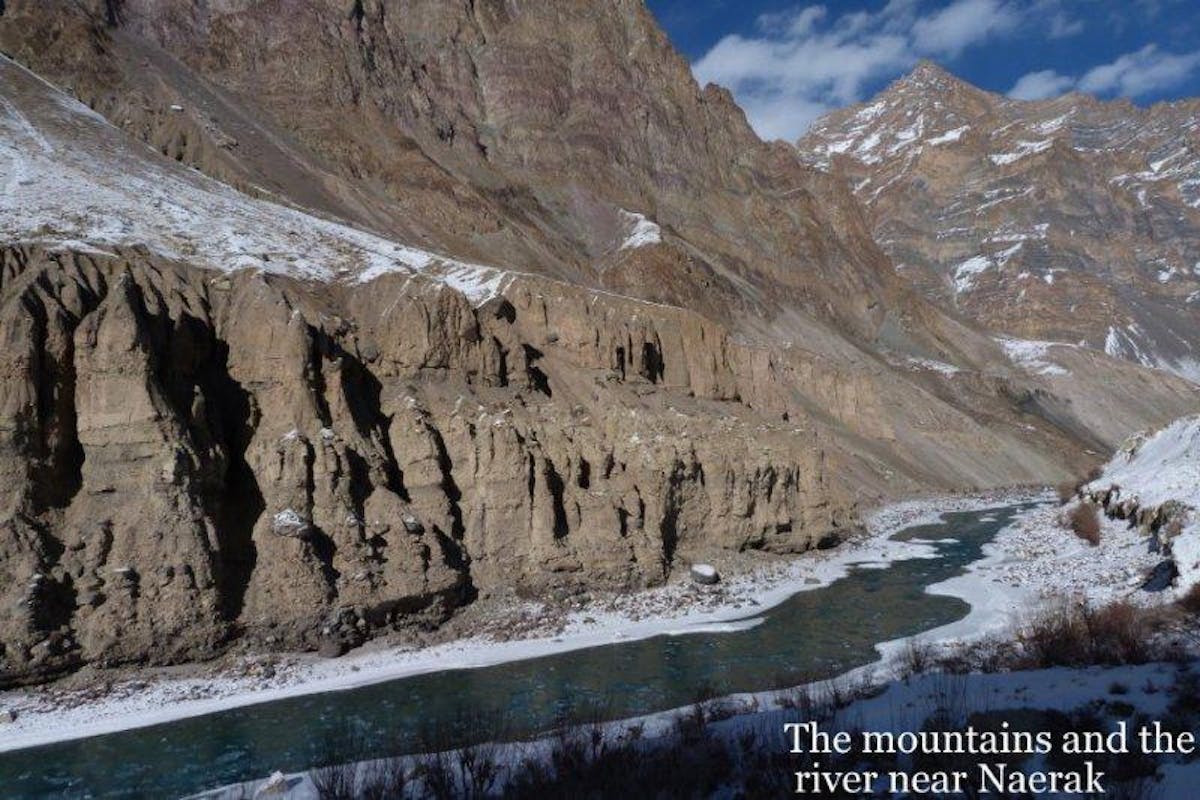
River near Naerak. Picture from Indiahikes Archive
Day 3: Trek from Tilat Sumdo to Shingra Koma. 9.5 km, 6 hours
Wake up with the sun at about 7 am and prepare to leave the campsite by 9 am. Though the sun is up, Tilat Sumdo like most parts of the Chadar gets direct sunlight only during midday. Another reason why the Chadar forms and remains.
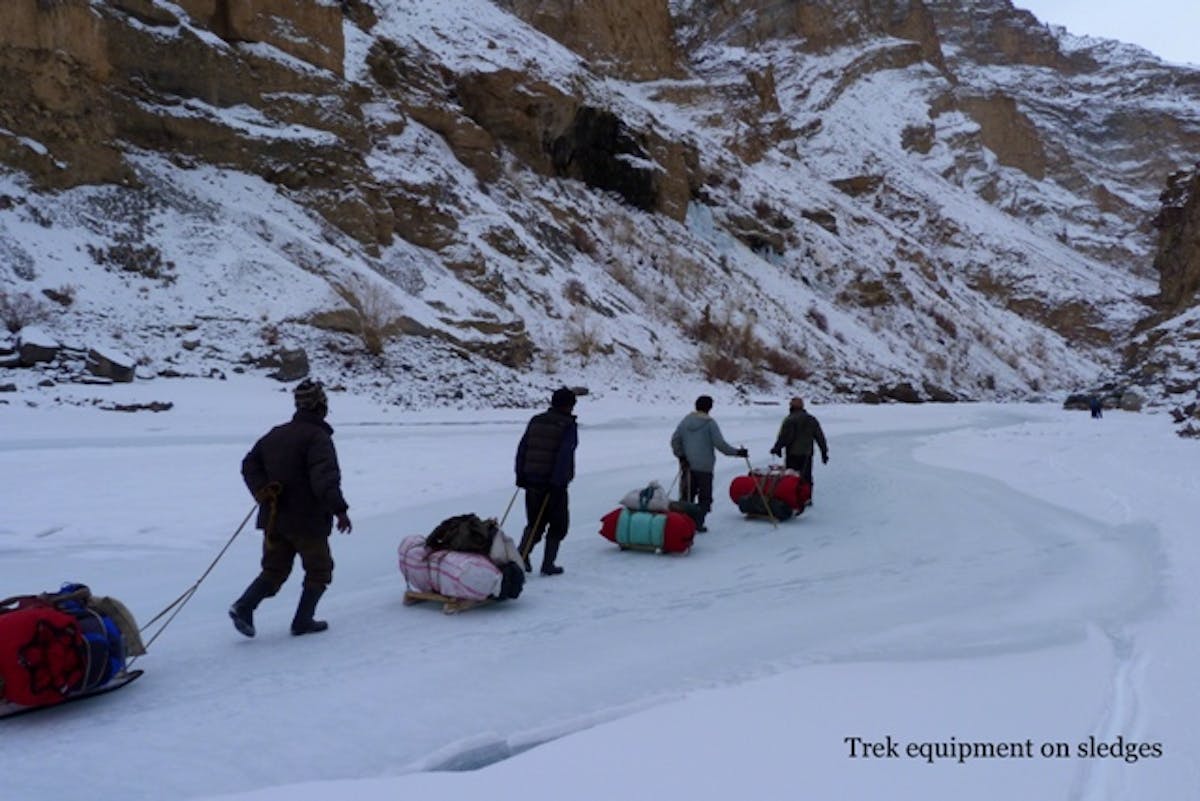
Trekking! Picture from Indiahikes Archive
The morning walk on the Chadar may feel like a walk inside a deep freezer. Your face should be the only exposed skin but it's enough to give the deep freeze feeling. As you walk on the Chadar, listen to the sounds it makes. Depending on the thickness of the Chadar, the sounds change. You will soon start recognizing where the Chadar is thick and where it is thin and dangerous.
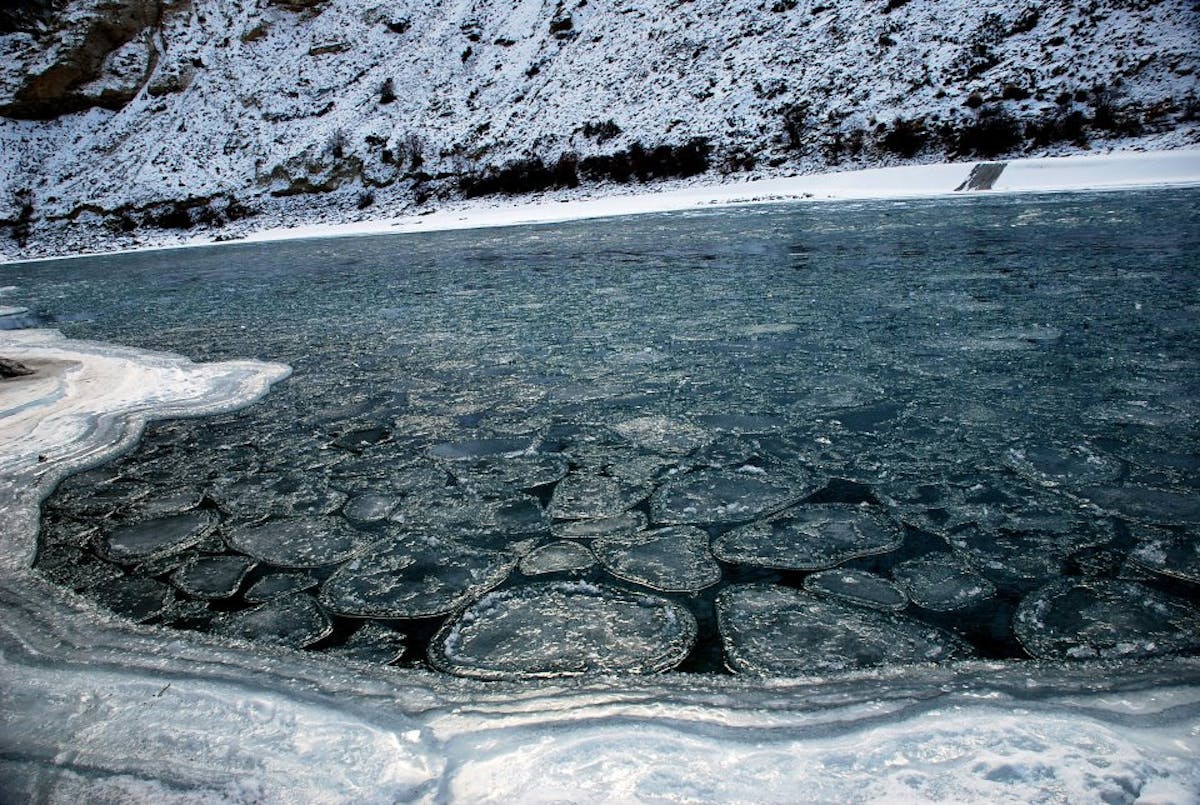
Crystal Clear Waters. Picture from Indiahikes Archive
There can be certain sections where the Chadar has formed only on the real corners of the river and the corner is under a low overhang. Do not fear to get down to your fours or even lie down on your tummy and crawl through those sections. Shingra Koma is almost 10 km away from Tilat Sumdo. The 10 km can be covered in about 6 to 7 hours. Midway through the trek around noon, find a sunny section where your cook can dish out a quick hot meal of Maggie and tea. Packed lunches are ruled out on the Chadar trek because the food will become way too cold by noon to be eaten. Hot quick meals on the way are the only way out. While on the Chadar, do not be surprised to spot pug marks. The big cats roam around pretty freely though they are elusive to the human eyes. Shingra Koma is a big camping ground on your right as you walk upstream. It's right below a huge stone wall which is straight out of a Hollywood movie. The Zanskar river takes a beautiful turn right in front of the campsite and sharp peaks rise on the other side of the river. Shingra Koma gets its name due to the abundance of a plant called Shingra.
Day 4: Trek from Shingra Koma to Tibb. 15 km, 7 – 8 hours
The trek from Shingra Koma to Tibb is a long one. It is also one of the most beautiful days of the trek. Watch the small waterfalls on the left standing still in the form of icefalls.
A couple of hours into the day's walk brings you to a massive waterfall on the left. Prayer flags flutter on the trees in front of the waterfall. You know that the place is revered by the Ladakhis. Surprisingly the waterfall is not frozen. Notice the greenish moss growing on the rocks under the water.
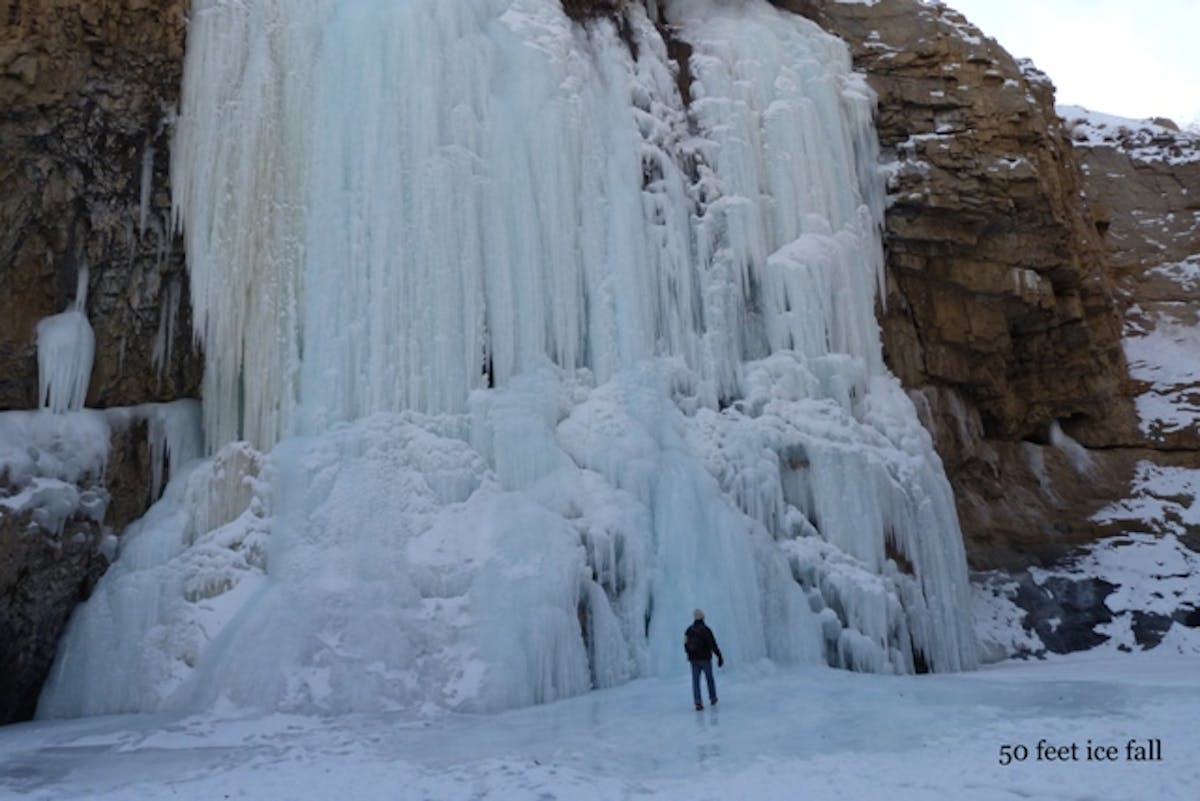
Ice fall. Picture from Indiahikes Archive
The legend goes that, one-year Nerak ran dry and a holy man went to Kailash to pray for water. He came back with a pot full of water and 2 fish. The condition was that he does not place the pot anywhere. On the journey back, it so happened that he placed the pot and this spot and two fishes jumped off creating this massive waterfall. The rocks behind seem to have two nostrils. One which is full of water and the other dry. According to legend, this waterfalls has its source at Kailash in Tibet.
The lunch point for the day is exactly the midway and under an overhang of rocks. Post lunch, the Zanskar river passes through narrow gorges where the width of the river can be covered by 4 people holding hands. The narrow gorge hardly gets any sunlight and so the river is non-existent. Generally, a thick chadar forms end to end here.
Two more hours of walk through the various hues and forms of Chadar brings you to a large camping area on your right – Tibb. To the left again are caves where 8 to 9 people can be comfortably accommodated. The Tibb campsite also has more dry vegetation around.
Day 5: Trek from Tibb to Nerak. 12 km, 7 hours
The trek from Tibb to Nerak is 12 km long. This is the day when you encounter the much-awaited frozen waterfall. The day is beautiful too going through the cliffs and gorges and valleys of Chadar. 5 hours into the trek and after your lunch break is when you see the first sights of Nerak. Prayer flags around Juniper shrubs by the Chadar signal that you are now close to Nerak and before that the waterfall.
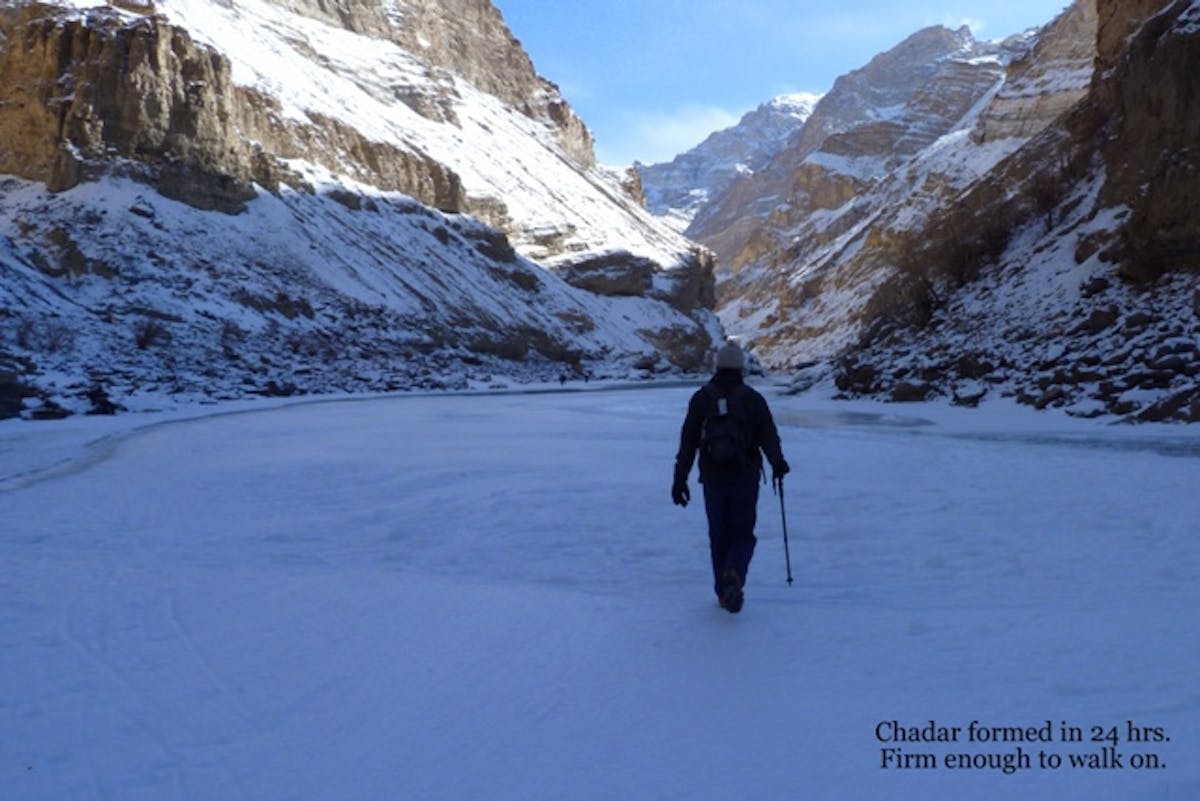
Walk on Chadar. Picture From Indiahikes Archive
A kilometre ahead around a bend under the shade of the gorge lies the famous Nerak waterfall. The Nerak pul or bridge lies just ahead of the waterfall. The bridge is an old wooden bridge but can still take a wait of 4-5 people at once. It's a nice experience walking on the rickety bridge and catching the sight of the waterfall from the top.
The trail goes along the Chadar and 20 minutes of walk brings you to Nerak where a small trail takes you up to the Nerak campsite.
Nerak is a village located about 2,000ft higher than the river bed. The Chadar trekkers camp not at the village but the camping ground 200 ft higher than the river. There is a lone shelter at Nerak campsite which serves as a Rafting point in the summer months. During winters, it serves as a shelter for the Chadar trekkers.

Campsite. Picture from Indiahikes Archive
Nerak is notorious for its really cold nights and winds. The temperature can dip as low as -25 or lower. This is going to be the coldest point of your trek.
The return from Nerak
The return path is theoretically a retrace of the route you took the last 3 days but in reality, can feel like a new one. The dynamics of the Chadar can make the whole place look and feel different. Old Chadar breaks, new ones form where there was none earlier, the texture of the Chadar changes and so on. Sometimes the Chadar breaks right under your feet and floats away like a raft. You have no option but to run on to the safer sheet ahead. You see the same broken raft getting stuck somewhere downstream and other icicles clinging onto it to form a whole new Chadar elsewhere. The Chadar trek is an experience. Your experience and what you see will be different from anyone else.
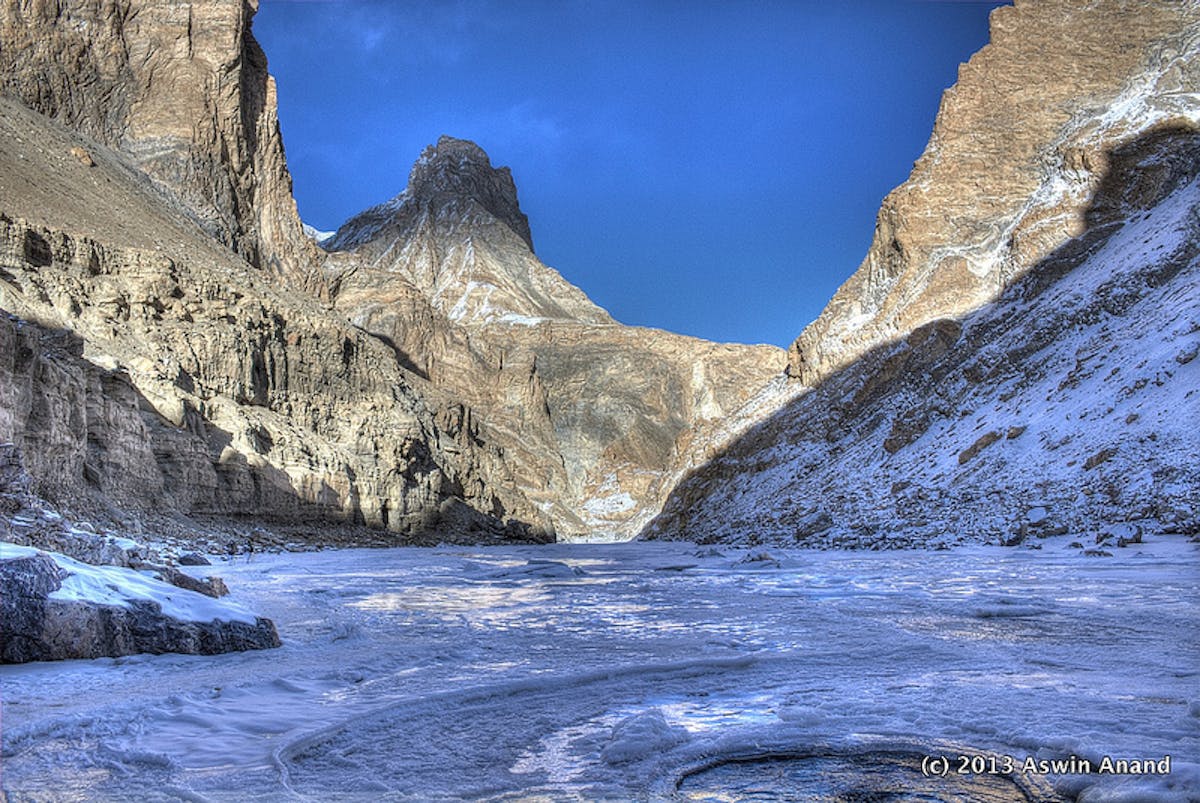
Unbeatable Beauty. Picture from Indiahikes Archive
Click on the images below to view full screen

➤ What to Pack for your Trek

Bare Necessities
- Trekking shoes: Carry trekking shoes and not sports shoes. The trail will be slippery in several places and will require shoes with good grip and ankle support. You can watch this video to learn to choose the right trekking shoes .
- Backpack (40-60 litres): A backpack with sturdy straps and a supporting frame. Rain cover for the backpack is essential.
- Daypack (20 litres): As this is a crossover trek, you would only need a daypack if you are offloading your backpack.
- Three layers of warm clothes: Carry two sweaters and a padded jacket. If you are more susceptible to feeling cold, add another layer.
- Three trek pants: Carry light cotton trek pants. One of your pants can be tights that you can wear as an inner layer while trekking, especially on the Pass day.
- Three collared t-shirts: Carry light, full sleeved t-shirts that prevent sunburns on the neck and arms. If you’re too cold, you can wear two shirts together for more insulation.
- Thermals: Carry thermals (top and bottom) to keep yourself warm at night. Keep your thermals fresh and don’t wear them while trekking.
Accessories
- Sunglasses: Sunglasses are mandatory. In June, there will be abundant snow on Hampta Pass, and you would need it to protect yourself from snow blindness.
- Suncap : At high altitudes, the sun is extra harsh, as the UV rays don’t get filtered. So carry a sun cap to protect yourself.
- Synthetic hand gloves: Avoid woollen gloves as they will get wet if you touch snow. You can add a fleece glove as an inner layer, and wear two gloves on each hand if you’re more susceptible to cold.
- Balaclava : You’ll need this to cover your head, as most of the heat escapes from your head.
- Socks (2 pairs) and a pair of woollen socks: Apart from two sports socks, you can take a pair of woollen socks for the night.
- Headlamp/LED torch: Mandatory
- Trekking pole : Watch this video to understand why you need a trekking pole .
- Toiletries ( Sunscreen , moisturiser, light towel, lip balm, toilet paper, toothbrush, toothpaste)
- Cutlery: Carry a spoon, coffee mug and a lunch box. We insist on trekkers getting their cutlery for hygiene reasons.
- Two water bottles: 1 litre each
- Plastic covers: While packing, use plastic bags to compartmentalise things and carry a few extra plastic bags for wet clothes.
Mandatory Personal Medical Kit
- Diamox – 10 tablets (to prevent AMS)
- Crocin – 6 tablets (fever)
- Avomine – 4 tablets (motion sickness)
- Avil 25mg – 4 tablets (allergies)
- Combiflam – 4 tablets (Pain killer)
- Disprin – 6 tablets (headache)
- Norflox TZ & Lomofen– 6 tablets each (diarrhoea)
- Digene – 10 tablets (acidity)
- Omez/ Rantadine – 10 tablets (antacids)
- Crepe bandage – 3 to 5 meters
- Gauze – 1 small roll
- Band-aid – 10 strips
- Cotton – 1 small roll
- ORS – 10 packets
- Betadine or any antiseptic cream
- Moov spray (aches, & sprains)
➤ How to Get Fit for the Trek

Chadar Lake is classified as a difficult trek . You trek up to an altitude of over 11,123 feet. You have to make sure your lungs are strong for this.
Cardiovascular Endurance
The Chadar Lake trek requires a good amount of endurance. You can begin by jogging every day . Start jogging at a slow pace and then keep increasing your pace day by day. Make sure you can jog 4 km in 20 minutes before the start of the trek. It takes time to be able to cover this distance in the given time. Swimming, cycling and stair climbing without too many breaks in between can help too.
This is another area you should work on. There is a lot of trekking distance that you will cover at high altitudes carrying your backpacks. You have to walk on uneven terrain during the trek. It could be taxing for your legs. For this, strengthening your legs will help. You can do some squats to strengthen them. Do around 3 sets of squats, with 8 squats in each set .
Flexibility
Another aspect that will help you trek comfortably is flexibility. For this, you can do some stretching exercises – stretch your hamstrings, quadriceps, hip flexors, lower back muscles and shoulders regularly. On your trek, you must arrive on the slopes with your muscles relaxed. Carrying a backpack, however, light can become a strain after a while. These exercises will help you to be in good shape before the trek.
Working out indoors
If you can’t go out and jog because of time and space constraints, here’s a video you can use to work out indoors.
Upcoming Treks
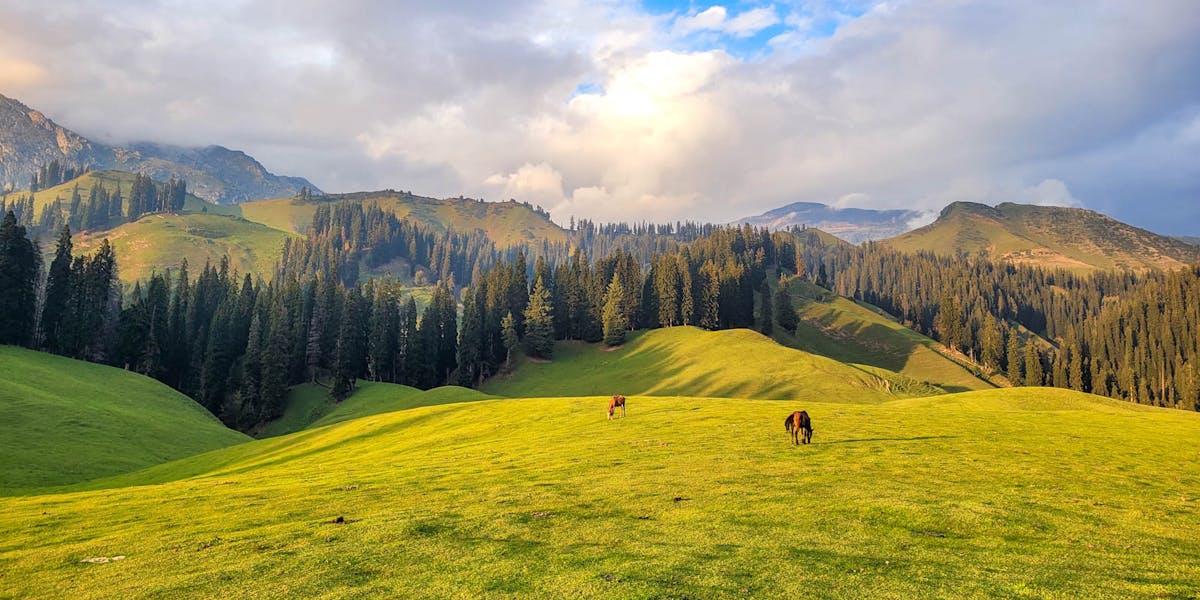
Nafran Valley
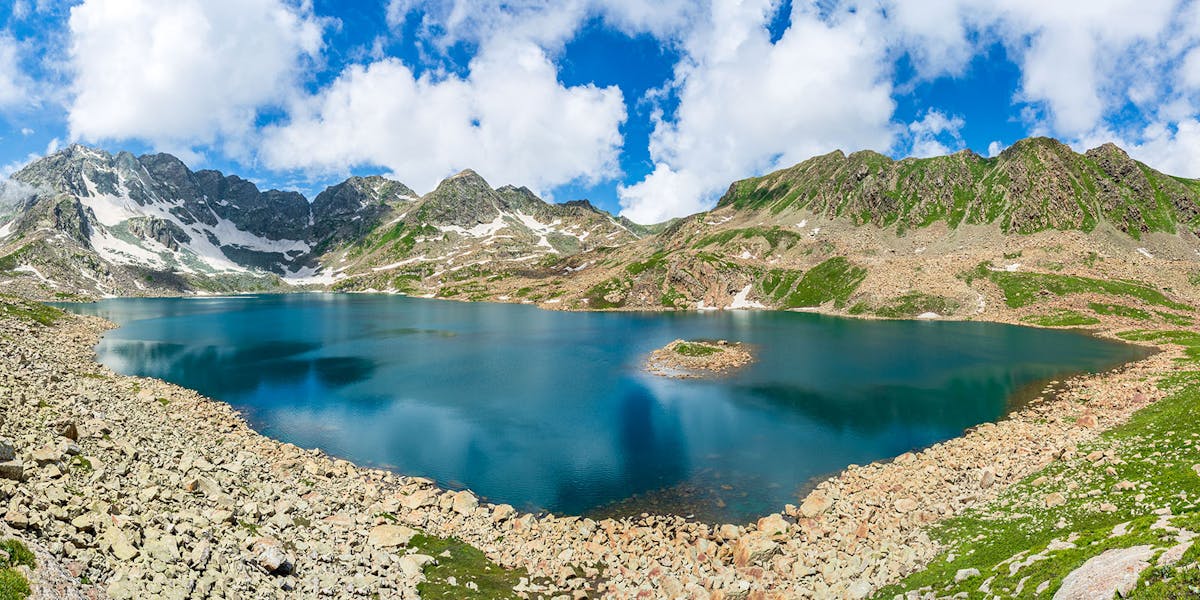
Bodpathri Trek
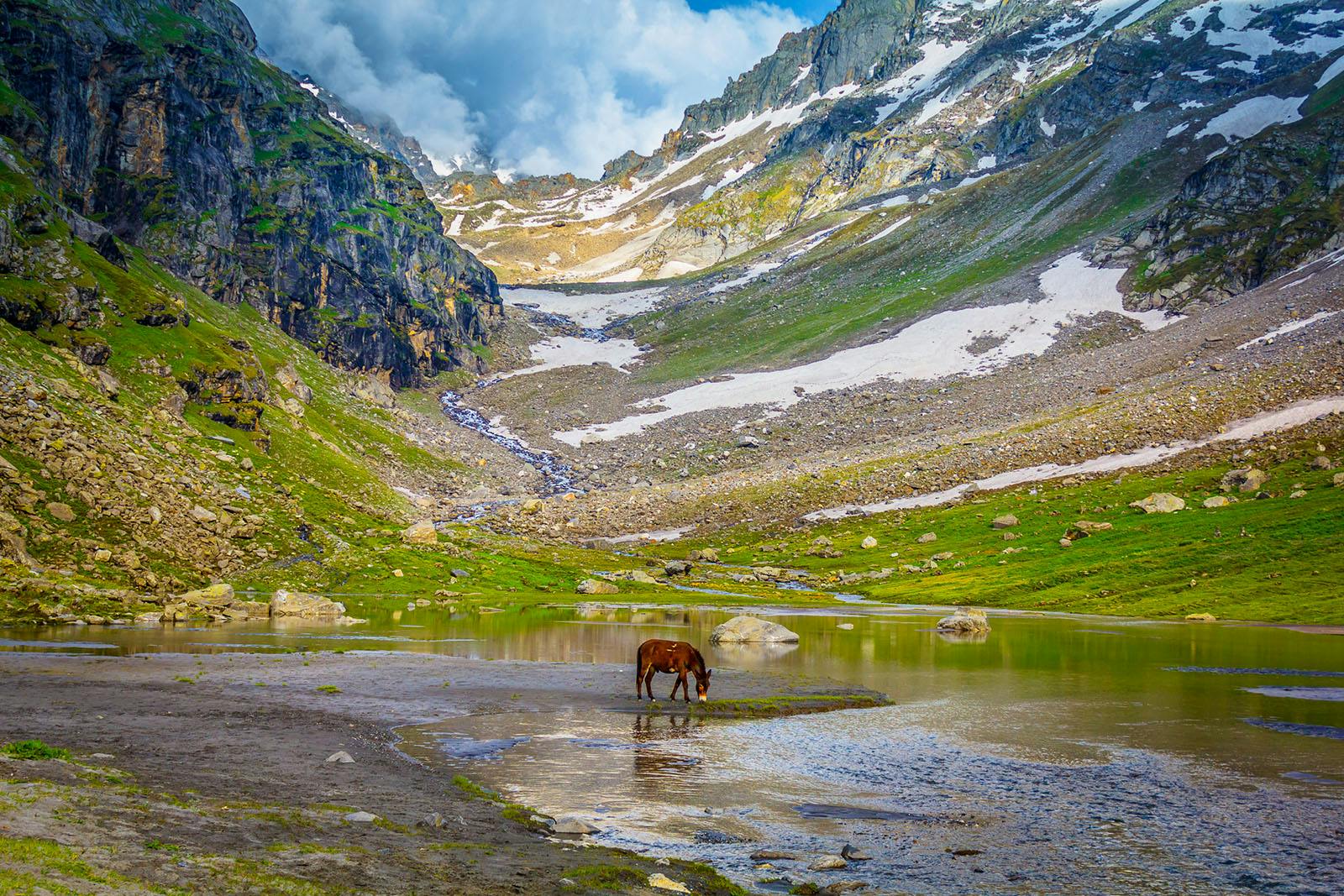
Hampta Pass

Valley of Flowers
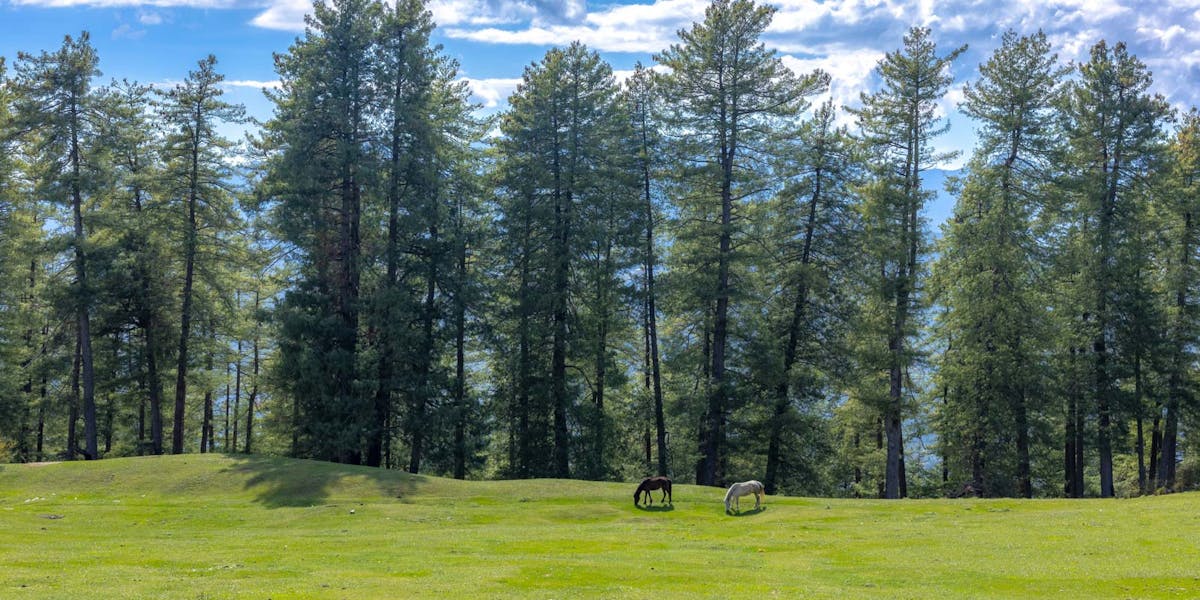
Bijli Mahadev Trek
Sign up for our much loved Weekly Mailer
We have terrific trekking tips, trek updates and trek talks to look forward to
Treks by Categories
Treks by season, treks by month, treks by duration, treks by difficulty.
- Easy - Moderate
- Moderate - Difficult
Treks by Region
- Uttarakhand
- Himachal Pradesh
- Lahaul and Spiti
- Jammu & Kashmir
- West Bengal
- Chhattisgarh
Treks by Experience
- Family Treks
- Stargazing Treks
- Senior Treks
- Adventure Therapy
- Summer Camps
- Youth Camps
- Cancellation policy
- Work with us
- Our sustainability practices
- Privacy Policy
- Terms & Conditions
080 468 01269 Mon to Sat - 9.30 AM to 7.30 PM Sun - 9.30 AM to 6.30 PM
Bengaluru Office
139, Defence Colony Road, Defence Layout, Sahakar Nagar, Bengaluru, Karnataka 560092
Dehradun Office
Mohabbewala, Titan Road, Near Titan Factory, Chandramani Khalsa Dehradun - 248002
© 2024 Indiahikes Private Limited
All images are copyrighted by their respective authors.
- Weekend +91 87 6262 3333
- Himalayan +91 9886 444 809
- International +91 84968 85968
- [email protected]
- One Day Treks
- Two Day Treks
- Himalayan Treks
- International Treks
- Private Treks
- Group Adventures
Featured Tour
Chadar Frozen River Trek Guide
- Guide to Chadar Trek

Introduction to the Chadar Trek
Chadar Trek, as the name suggests, is a beautifully frozen carpet of ice in the Zanskar region of Ladakh. The Chadar trek is one of Ladakh's most popular and unique treks and attracts trekkers from all over the world. It is considered one of the most difficult treks in India as it involves walking on a frozen river. But this isn't the negative side of the trek. If everything goes well, it can be an experience of a lifetime.
This page is your comprehensive guide for the Chadar trek. Here, we have consolidated all the information you need to safely complete the Chadar trek. This guide will help you with a general overview to understand the nuances of the Everest Base Camp Trek, along with links to a lot more information like - Chadar trek difficulty, the best season for the Chadar trek, physically preparing for the Chadar trek, things to carry, how to go to the Chadar trek, and a lot more!
1. Chadar Trek – 10 Reasons why Chadar frozen river Trek is the greatest adventure of all time
Here's why you should choose to do the Chadar trek -
It is the most challenging trek in India
The route is a 1000-year-old path
Chadar trek best time to visit is only in winter trek; you get to trek on a frozen river
The Chadar trek distance is 105 km long. The path is covered with a sheet of ice.
Chadar trek temperature can go as low as -15 to -25°C
Unpredictable weather
Climbing and maneuvering on the solid white sheet of ice is challenging
You get to spot snow leopards
Frozen river expedition within a closed canyon valley offers serene and extremely picturesque locations
Spot the famous frozen gigantic Nerak waterfall
Read more here: https://www.treknomads.com/blog/10-reasons-why-chadar-trek-is-the-greatest-adventure-of-all-time/
2. Chadar frozen Zanskar river trek – Getting fit for the Chadar trek
As we know that the Chadar trek in Ladakh is the most challenging in India, we must remember that we should have an excellent fitness level to match the trek's requirements. The Chadar trek height is at the height of 11,150 ft. Firstly, no matter how good a trekker is, you must continue practicing specific exercises and follow a good workout routine to be a good fit for the Chadar trek. Secondly, training your body is not enough; you must also train your mind to face tough situations. We suggest working out at least eight weeks before your trek to adjust adequately to the high altitudes. We have one full blog on a fitness regime for the Chadar trek. Our fitness experts have planned the regime concerning the trek's requirements. Do check out the link below-
Read more: https://www.treknomads.com/blog/guide-getting-fit-chadar-trek/
3. Chadar – Things to pack for the Chadar trek
The Chadar trek to Ladakh will be extremely tough due to the temperature drop; if you don't carry your warmers and other essentials, you will have a tough time on the trek. However, you do not need to burden your shoulders with extra things. Please do not overstuff your bags. Carry lightweight clothes that can keep you warm. For example, woolens add bulk to your bags and occupy a lot of space. Hence, you can replace woolen jackets with fleece jackets. You will also need winter skincare essentials such as moisturizer, lip balm, sunscreen, etc. to protect your skin in sub-zero temperatures. Lastly, remember to carry toiletries, sanitary kits, and first aid kits in case of minor injuries.
Read more: https://www.treknomads.com/blog/things-to-pack-for-the-chadar-trek/
4. The Common FAQs about Chadar Trek Answered
TrekNomads is always keen on resolving the client's queries and doubts. The Guide to Chadar Trek might keep pinning questions to your minds. Don't worry! Our customer-focused team tries its best to answer your questions. We have collected a list of commonly asked questions by our clients and answered them in a blog. It covers all questions, from the Chadar trek cost to the food accommodations and arrangements our team makes during trekking. Visit the link below to get access to the FAQ blog.
Read more: https://www.treknomads.com/blog/common-faqs-about-chadar-trek-answered/
5. Preparing yourself mentally for the Chadar trek
The Chadar trek is undoubtedly an outstanding trek in India, but it is equally tricky. It requires lots of mental and physical preparation to face the challenges that come your way. You must get used to the extreme cold, tiring walks, and challenging trails. You can do this only if you are mentally prepared for the trek. No matter how physically fit you are, if your mind isn't trained well to face these challenges, you will end up facing a lot of issues. Trust us; we have seen a few such cases during our trekking journey. This is why we bring you all the required information related to each trek. We believe 'the well-informed you are, the well-prepared you will be.'
Read more: https://www.treknomads.com/blog/preparing-yourself-mentally-for-the-chadar-trek/
6. Chadar – Nutrition during the Chadar Trek
You will need more energy to explore the beauty of the Chadar trek route. How will you get that? No, you don't need to have any heavy meals that could make you feel bloated and sleepy. Also, we want you to avoid eating food that makes you burp. Please! We don't recommend non-vegetarian diets either. A vegetarian diet rich in carbohydrates, protein, and the required amount of fat is sufficient. We recommend carrying some instant energy bars, dry fruits, and snacks that provide more energy when you are about to get tired.
With so many variables in the equation, we understand that it can take time to finalize the list of foods to carry with you on the trek. However, TrekNomads will simplify this for you. Read the blog to learn more:
Read more: https://www.treknomads.com/blog/chadar-nutrition-during-the-chadar-trek/
- Testimonials
- Customized Private Treks
- Corporate Outings
- Cancellation Policy
Online booking system by Vacation Labs | © 2024 TrekNomads
.png?w=auto&h=400)
Chadar Trek
Chadar trek overview.
Situated in the Leh region of Ladakh, the Chadar trek is one of the most magnificent treks in the Himalayas that allows you to cover a distance of 62 kilometers in just nine days. It is one of the most popular and longest trekking trails that provides a dream come true experience to the trekkers while hiking along the dramatic mountains. The Chadar lake trek feels like a journey to the North Pole as the temperature drops to -30 degrees Celsius, thereby grading it high on the difficulty level.
The Chadar trek Ladakh lets the trekkers walk on a thick layer of ice that covers the Zanskar river. It is not the only reason that draws thrill seekers to this fantastic attraction, but people are attracted to several other fascinating and ethereal sights. This trek brings you close to the natural wonders of the world, such as the frozen Nerak waterfall, white sand, and knee-length snow, and all these beautiful sights in your trekking experience will ignite your senses and will create a mark down your memory lane.
The landscape and the overall experience of the Chadar frozen river trek will also leave an imprint on the heart of the trekkers. So, if you are looking for a remarkable trekking experience, the Chadar trek should be on the top of your bucket list.
Book Chadar Trek Package
Chadar trek, ladakh - frozen river trek, quick facts of chadar trek.

- Maximum altitude: 11150 feet
- Grade: Difficult
- Duration: Nine days
- Trekking distance: 62 kilometers
- Trail type: One-way trail. The trek commences and ends at Shingra Koma.
- Rail head: No rail head
- Airport: Kushok Bakula Rimpochee Airport (Leh)
- Snow Season: January and February
- Service from: Leh Airport to Leh Airport (Transport included)
- Base camp: Leh
- Best season: Winter season (January and February)
- Region: Ladakh
Who can Participate: - Serious trekkers who are fond of experiencing freezing temperatures.- Should have a minimum age of 15 years.- People with enough stamina to cover a distance of five kilometers in just 30 minutes.- Has an experience of at least one high-altitude trek of 5000 meters or 16400 feet.- Should have the capacity to carry a 12 to 16 kg backpack.
Why to Go for Chadar Trek?
Chadar trek is one of the best trekking experiences that you should have at least once in a lifetime. Walking on the frozen sheet of ice on the surface of the river with dramatic snow-capped mountains on either side is indeed a remarkable experience in itself. This trekking experience allows you to witness the Nerak waterfall which is completely iced from top to bottom. There is also a possibility that you may encounter exotic wildlife, like snow leopards, blue sheep, and ibex in the chilling surroundings of your trek. Thus, it is a do-before-you-die adventure that lets you witness the in-depth Zanskari cultures, jaw-dropping scenery, and bone-chilling climates.
Short Itinerary for Chadar Trek
Day 1 : The Chadar trek Ladakh starts with your arrival at Leh. Rest for the day or explore the attractions of Leh.
Day 2 : The second day of your Chadar Lake trek will be your acclimatization day when you will be adapting to the cold weather conditions of the surroundings.
Day 3 : Go to the Government Medical Camp to get all your medical tests done. Complete all your insurance formalities and other documentation work before moving forward for the Chadar winter trek.
Day 4 : It is the actual day of the Chadar trek Ladakh when you will move from Leh to Gyalpo through Chilling and then to Tilad Do.
Day 5 : On the next day, the journey included in the Chadar trek package will continue to the Tibb Cave.
Day 6 : It is an iconic day of the Chadar winter trek as you will reach Nerak from Tibb Cave, where you can witness the Frozen Waterfall that garners the interest of tourists from across the globe.
Day 7 : The seventh day included in the Chadar trek package will be a return day from Nerak to Tibb Cave.
Day 8 : Moving forward, you will return to Shingra Koma through Gyalpo and then take an adventurous ride back to Leh.
Day 9 : It is officially the last day of the Chadar Lake trek when you will be returning to your homes with tons of memories of the trek.
Chadar Trek Detailed Itinerary
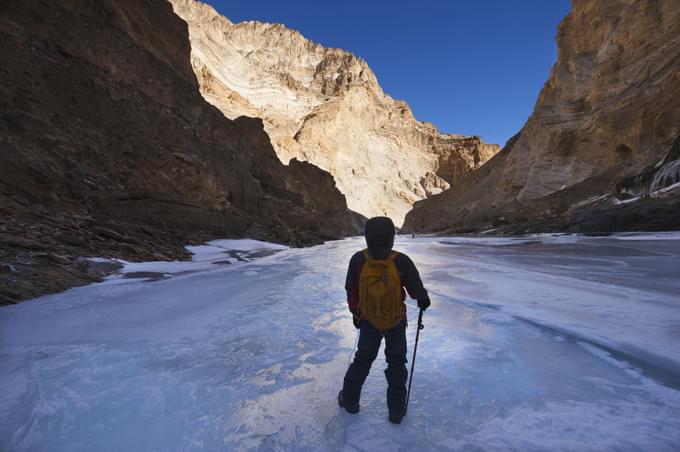
- The Chadar trek commences after you arrive at the Kushok Bakula Rimpochee Airport in Leh.
- On your way to your hotel on the outskirts of Leh, you will experience gorgeous snow-capped mountains that will definitely leave you awestruck with their striking beauty.
- It is advisable to keep your woolen caps and gloves handy as you may feel an immediate drop in temperature when you arrive at the Leh airport.
- After you reach Leh, you can rest for the day and acclimatize to the cold weather conditions.
- The weather in Leh will give you a taste of what it will be like when you go for the Chadar trek.
- In the evening time, you can go window shopping on the streets of Leh market to grab things that you would require in the trekking expedition.
- You are not allowed to start your trekking journey on the same day of your arrival because it is extremely necessary for your body to adapt to the cold weather condition as the temperature may drop even further when you start climbing towards the Zanskar River.
- Now, get back to your rooms and have a good night's sleep to revitalize your body for the trip.
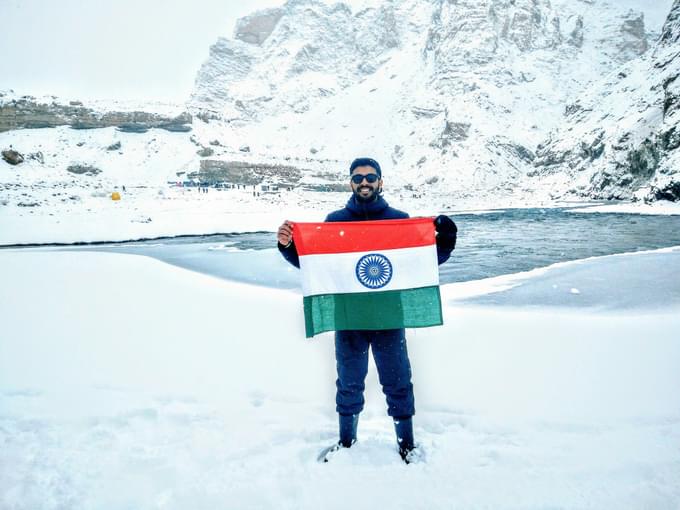
Rest and Acclimatize in Leh
- Considering the health conditions of the trekkers and according to the new regulations, trekkers who are willing to go on the Chadar trek are required to acclimatize their bodies completely to the cold weather conditions in Leh for two days.
- In order to acclimatize, you can either spend the day visiting the nearby attractions of Leh or rest in a centrally-heated room at your hotel.
- Every trekker is advisable not to go to places with higher altitudes on this day.
- The second day gets completed by packing your travel backpack with all the essentials and rest for the day.
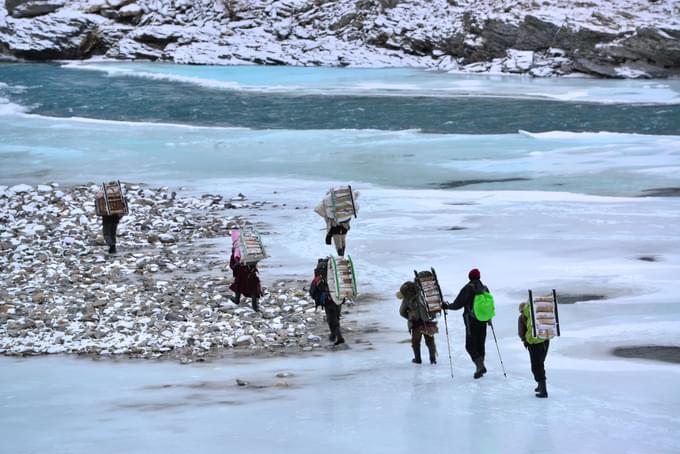
Undergo Medical Checkup in Leh
- The third day is the most significant day of the trek. This day decides whether your body is eligible for continuing the Chadar trek or not.
- For this, you need to wake up early in the morning and drive or walk to the Government Medical Camp.
- You must reach the location as early as possible because the tests get delayed due to the rush of tourists. It will not take more than three to four hours to complete all your checkup depending on the rush.
- After the tests, you must proceed further to finish any insurance formalities, wildlife permits, and other significant documents.
- By any chance, the tests state that you are unfit for the Chadar trek, you can take a physical wild card and select the ‘Flavor of winter Ladakh’ tour without any additional cost.
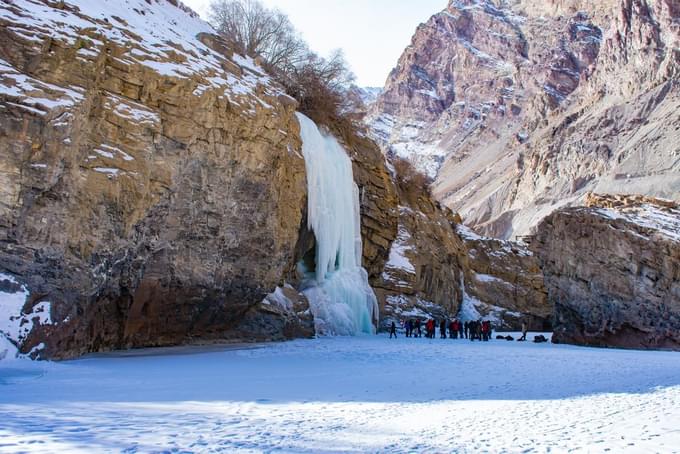
Move from Leh to Gyalpo via Chilling and Tilad do
- This is the actual day of your Chadar trek. On this day, you will head towards your first campsite in Shingra Koma through Chilling.
- The day will start with a drive from Leh that will let you spot some scenic attractions in Ladakh.
- On your way, you will come across plenty of remarkable sights, like Gurudwara Pathar Sahib, Magnetic Hill, and the convergence of the Indus and Zanskar river.
- After a short drive of 90 minutes along the Zanskar River, you will reach Chilling.
- It is the place where the car will drop you at the end of the road. From there, you will start your walk on the Zanskar river.
- Initially, it may be difficult for you to walk on the ice with your gumboots on as the sheet may be thin, but you will understand the ice patterns slowly and gradually.
- It is advisable to plant your foot and walking sheet on the ice to check the steadiness before moving on it wholeheartedly.
- You must also ensure that the weight of your backpack is not heavy so you can carry it yourself effortlessly.
- After a walking struggle of about one and a half hours, you will reach your first campsite at Gyalpo, where you will experience your first sub-zero temperature camping.
- Rest for an overnight sleep in Gyalpo.
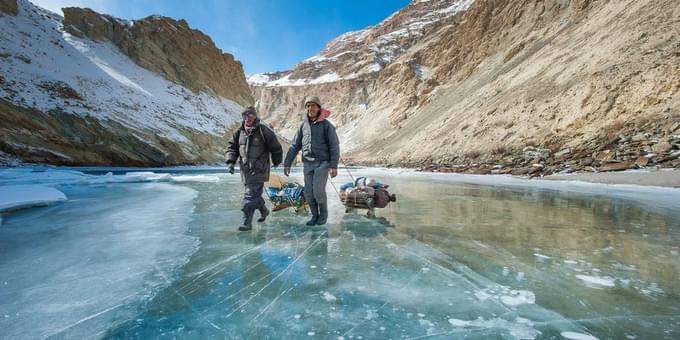
Gyalpo to Tibb Cave
- Chadar trek is one of the treks where you will not be able to see altitudes in quick succession. But, when you slowly move to Tibb Cave from Gyalpo after five to six hours, you will find yourself rising at an altitude of 300 feet.
- After spending a chilling night in your tent at Gyalpo, you are required to have a sumptuous breakfast to regain energy for the further trekking expedition. A hot cup of tea will also revitalize your senses in this cold temperature.
- After breakfast, the trek will resume, and the next campsite is Tibb Cave.
- While trekking, you will come across plenty of attractive frozen waterfalls, but the emerald green water of the Zanskar river will keep on flowing all along the trail.
- Midway to Tibb Cave, you can have your lunch.
- Post lunch, you will continue your trek, where you will discover varied rock patterns that shine uniquely as the rays of the sun fall on them.
- Finally, the day ends when you reach the campsite at Tibb Cave which is completely covered with dry sand.
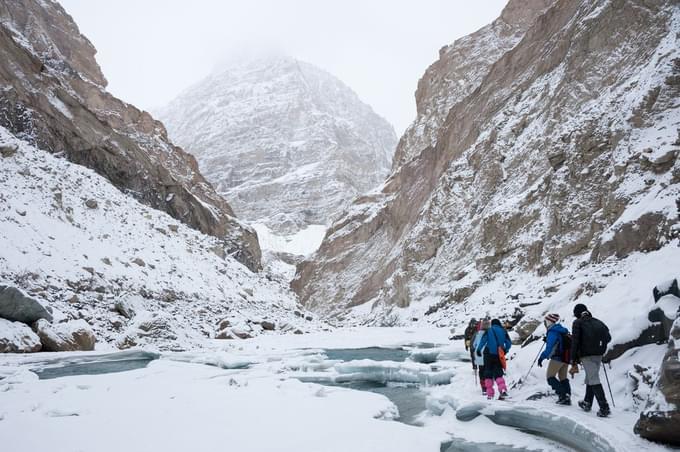
Tibb Cave to Nerak
- The destination of Day 6 will be Nerak, which is a 13 kilometers long trail that takes you to the exemplary landmark of the Chadar trek named the Frozen Waterfall. The Frozen Waterfall is one of the beautiful attractions that garner the interest of tourists from around the globe.
- You will be served with hot lunch on your way to Nerak.
- It is by far the coldest campsite where the temperature drops to -30 degrees Celsius at night. Hence, you must wear appropriate clothing to keep the chilling atmosphere at bay.
- Day 6 ends with reaching Nerak campsite, which is situated around 15 to 20 minutes from the Frozen Waterfall.
- If the trekkers reach the Nerak campsite on time, they can also pay a visit to the Nerak village.
- The day ends with an overnight sleep in the Nerak camp.
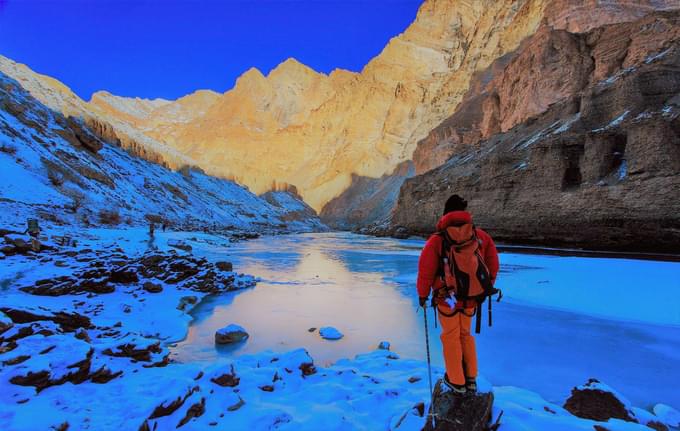
Nerak to Tibb Cave
- Day 7 will be the returning day of your Chadar trek. It is indeed your last chance to embrace and relive the moments on the Zanskar River near the Frozen Waterfall.
- Chadar trek is completely a unique experience in itself. The weather conditions are very unpredictable in this region. You may find that the layer of Chadar has completely vanished from where you have come. However, at the same time, you will find that a new layer has been formed in some other place. Thus, it is advisable to take back all the memories in your backpack before returning from the trek.
- Say goodbye to the locals and start your trek on your way back to the Tibb Cave.
- On your way back, you will find locals negotiating the conventional woolen Gonchas at the Chadar where the monks are returning to Leh from the monastery at Lingshed. You may also find the young students returning to school after their vacation in Leh. This sight of local people is heartwarming to see as they are surviving in such a cold climate yet keep a long smile on their faces.
- You can sign off for the day after reaching Tibb Cave.
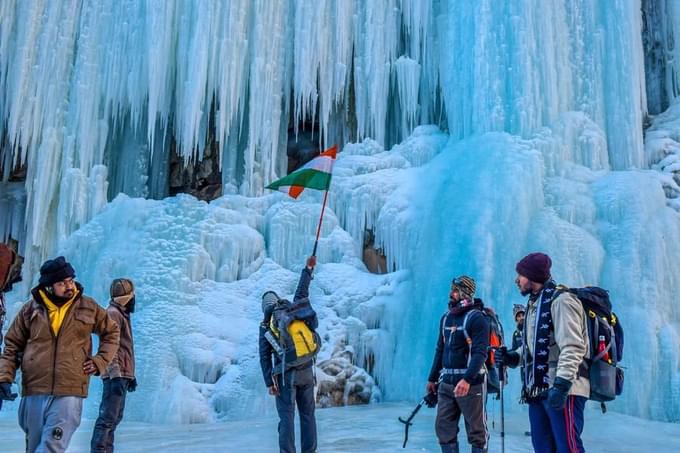
Tibb Cave to Shingra Koma via Gyalpo and then to Leh
- On Day 8, it is time to go back home and you need to wake up early to cover a long distance from Tibb Cave to Shingra Koma.
- While moving down to Shingra Koma, you will discover high walls of mountains rising on the sides of the river that almost looks like a castle.
- You will also notice the steps and footprints of foxes, ibex, or snow leopards on the Chadar trek.
- If you are lucky, you may even spot snow leopards. But you must rest assured that someone will keep a watch on you all the time on your way back to Gyalpo.
- You will not get a chance to retrace the steps while going back as the way might have changed a lot. The layer of chadar has melted and become thin. You may also see the formation of rocks on your way down to Shingra Koma.
- After reaching Shingra Koma, you will be asked to board a bumpy ride back to Leh at around 6.30 pm in the evening.
- You can rest after the tiring day at Leh in the warm guest house and get ready for your way back home on the next day.
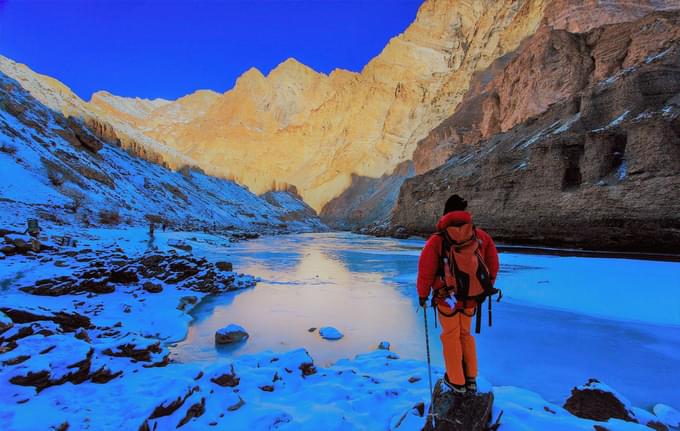
Depart from Leh
- Day 9 will officially be your last day of the Chadar trek as you move back to your home, taking all the memories of the trek with you.
- The day starts with a delicious breakfast, and then you can get ready for checkout from the guesthouse by packing all your belongings.
- Say goodbye to your guesthouse and reach the Leh airport, from where you can head towards your destinations further!
- Your Chadar trek experience ends here.
General Trivia About The Trek

- Chadar trek does not include any kind of ascending and descending paths similar to the other Himalayan treks as you will be walking on a frozen sheet of ice on the Zanskar river all the time.
- Although Himalayan waters are considered safe for drinking, the trekking experts advise purifying the water by boiling it with chlorine tablets during the trek.
- The trade route between Zanskar and Ladakh regions that has existed for more than 1000 years is known as ‘Khado Sanglam’ in the local dialect.
- Zanskar river freezes completely during the months of January and February to form a walkable path of ice.
- There must at least be a group of six to seven people to go on the Chadar trek with a maximum of 15 to 18 people.
- February is considered to be the toughest time to go on the Chadar trek as the fluctuating temperatures during the day and night can cause broken trails along the way.
- The temperature on the Chadar trek drops to as low as -30 degrees Celsius, and thin air keeps flattering your skin at every inch of your walk.
- Chadar trek is unique as it is a complete surprise package of slippery ice sheets, occasional cave stays, unusual campsites, and brisk-changing weather conditions.
- If you are lucky, you may spot an old snow leopard or other wildlife on your trekking expedition.
- Pictures of the beautiful frozen Nerak waterfall are surely a remarkable way to account for the memories.
Know Before You Go to Chadar Trek
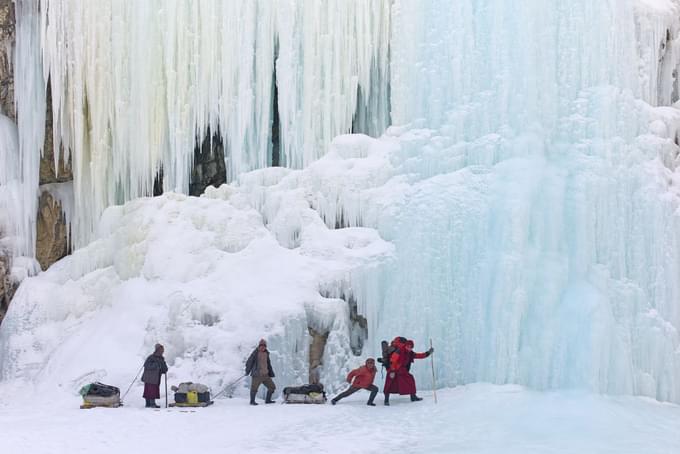
When you are going on a trekking expedition, it is essential to keep the do's and don’ts in mind. These tips will help the trekkers stay connected with their fellow travelers and prevent them in case of an emergency situation. Here are some of the important tips that trekkers should consider on the Chadar frozen river trek:
- Inform your friends and family about the trek and give the number of your trekking organization to them so they can contact you in case of any emergency.
- Wear warm clothes at all times and carry stuff that can keep you warm at all times as the temperature may drop drastically and unexpectedly during your trek.
- Do not forget to carry your first aid kit and all the necessary medications as bruises and cuts are relatively common during treks and hikes.
- Keep yourself hydrated at all times. People are more likely to skip drinking water due to the cold climate.
- Walk actively and carefully as the sheet of ice may be slippery.
- Do not litter everywhere as it is strictly prohibited to throw plastic and biodegradable stuff on the trekking trails.
- Avoid contaminating the waterfalls while bathing with chemical soaps because villagers use this water for drinking purposes.
- Remain polite towards your trek leader and co-trekker at all times.
- Do not skip your meal under any circumstances.
- Always be together with your trekking group, and do not wander anywhere on your own.
- Ensure that you carry all the trekking essentials in your backpack.
- Follow the instructions given by the trekking leader to ensure safety and security at all times.
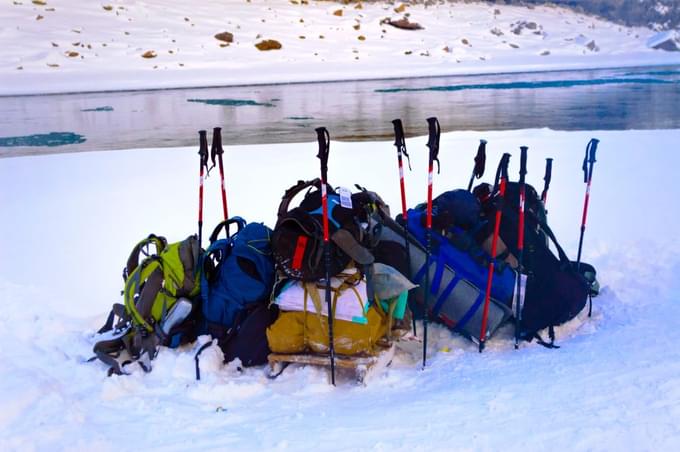
Basic Gear: - Backpack (50 to 60 liters) with appropriate shoulder straps and raincoat- 2 thermos flask water bottles of one liter each- Medical kit after consultation from the doctor- A walking stick- Snacks, like dry fruits, energy bars, electoral / ORS, and much more.
- 1 full sleeves non-cotton T-shirt
- 2 fleece T-shirts
- 1 fleece jacket
- 2 pairs of thermal inners (both upper and lower)
- 1 down feather or hollofil jacket
- 1 pair of fleece or wool gloves
- 1 pair of waterproof gloves
- 1 pair of waterproof jackets and pant
- 1 pair of Windstopper pant
Personal Utilities:
- Antibacterial powder
- Hand sanitizer
- Chapstick or Lip balm
- Moisturizer
- Quick dry towel
- Sunscreen cream
- Toilet paper and wipes
- Toothbrush and toothpaste
Hand Gears:
- 1 balaclava
- 1 head torch
- 1 neck-gaiters
- Dark sunglasses with side cover, UV protected (do not wear contact lenses)
- 1 woolen cap
Foot Gears:
- 6 pairs of cotton socks
- Gaiters (optional)
- Floaters or flip flops (optional)
- 1 pair of gumboots (it is advisable to buy them from Leh)
- 1 pair of trekking shoes (optional yet highly recommended)
- 6 pairs of woolen socks
- Chadar trek route map
- Sleeping bag
- Hot water bag
- Valid ID proofs (passport & driving license) and their copies
- 4 passport size photographs
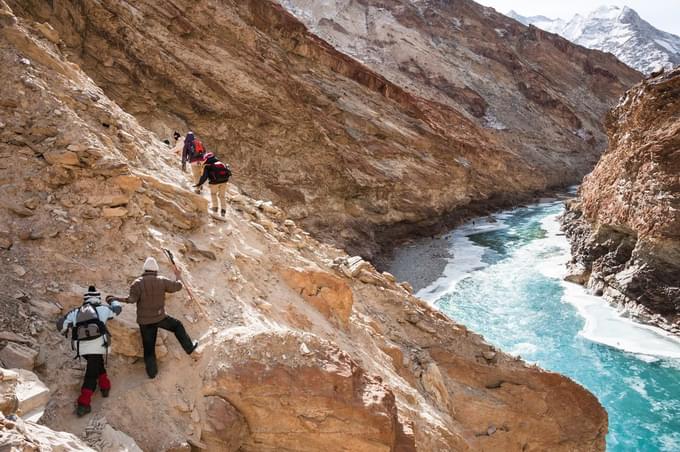
By Air- The easiest way to travel to the starting point of the Chadar trek Ladakh is Kushok Bakula Rimpochee Airport located in Leh. This airport is situated about 4 kilometers from the city's center and receives daily flights from Delhi, Mumbai, Srinagar, Chandigarh, Jammu, and several other places in India. Even if you are traveling from beyond the geographical boundaries of India, you can take a connecting flight from Delhi, Mumbai, and Kolkata to Leh. Go Air, and Air India are some of the airlines that operate frequently on this route. Traveling to Leh by air is an amazing experience, and it makes for a wonderful start for the trekking expedition.
By Train- You can also board a train to Leh. The train used to travel to Leh is New Delhi Jammu Tawi Rajdhani Express, which travels from New Delhi to Jammu. After reaching Jammu, you can take a bus to Srinagar and then to Leh.
By Road- After you reach the Leh airport, you will be traveling through two road routes, namely the Manali-Leh highway and the Srinagar-Leh highway. The visitors will discover beautiful snow-clad mountains and gorgeous roads while driving their way to the hotel. If you are visiting this place in extremely cold conditions (i.e., between October and November), these routes remain closed due to heavy snowfalls. From the airport, your trekking authorities will take you to your hotel so you can relax and start your trek afresh.
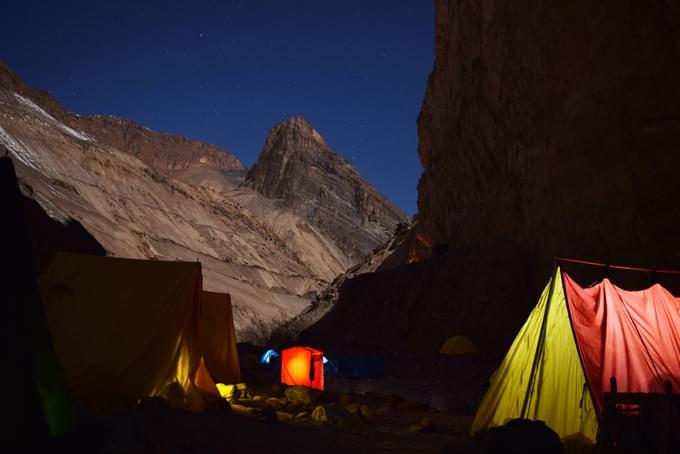
- The best and the only time to go on the Chadar trek is during the winter season, i.e., when the Zanskar river freezes. These winter months of January and February are best suited to admire the natural beauty of the Himalayas that has been preserved for centuries.
- If you are thinking of which month to plan your itinerary for Chadar frozen river trek, it is advisable to do it during the month of February as the ice is the most stable at this time.
- With temperatures ranging between -5 and -25 degrees Celsius, trekkers feel that February is the toughest winter time for Chadar trek.
- The fluctuating temperatures during the day and night in the month of February makes the trekking experience even more difficult as you may encounter broken trails along the way.
- On your trekking expedition, Nerak is the coldest among all the campsites, where the temperature drops down to as low as -30 degrees Celsius at night. You may also get a chance to visit the Nerak Village if you manage to reach the waterfalls on your trek.
- The heavy snowfall of the Pensi La Pass creates a thick sheet of ice on the surface of the Zanskar river and cuts the place from the rest of Jammu and Kashmir.
- Even the locals wait for winters to come so they can create a walkable path of ice and go back home. Hence, the winter season, i.e., January and February are the best months to go on a Chadar trek with your friends.
You May Also Book
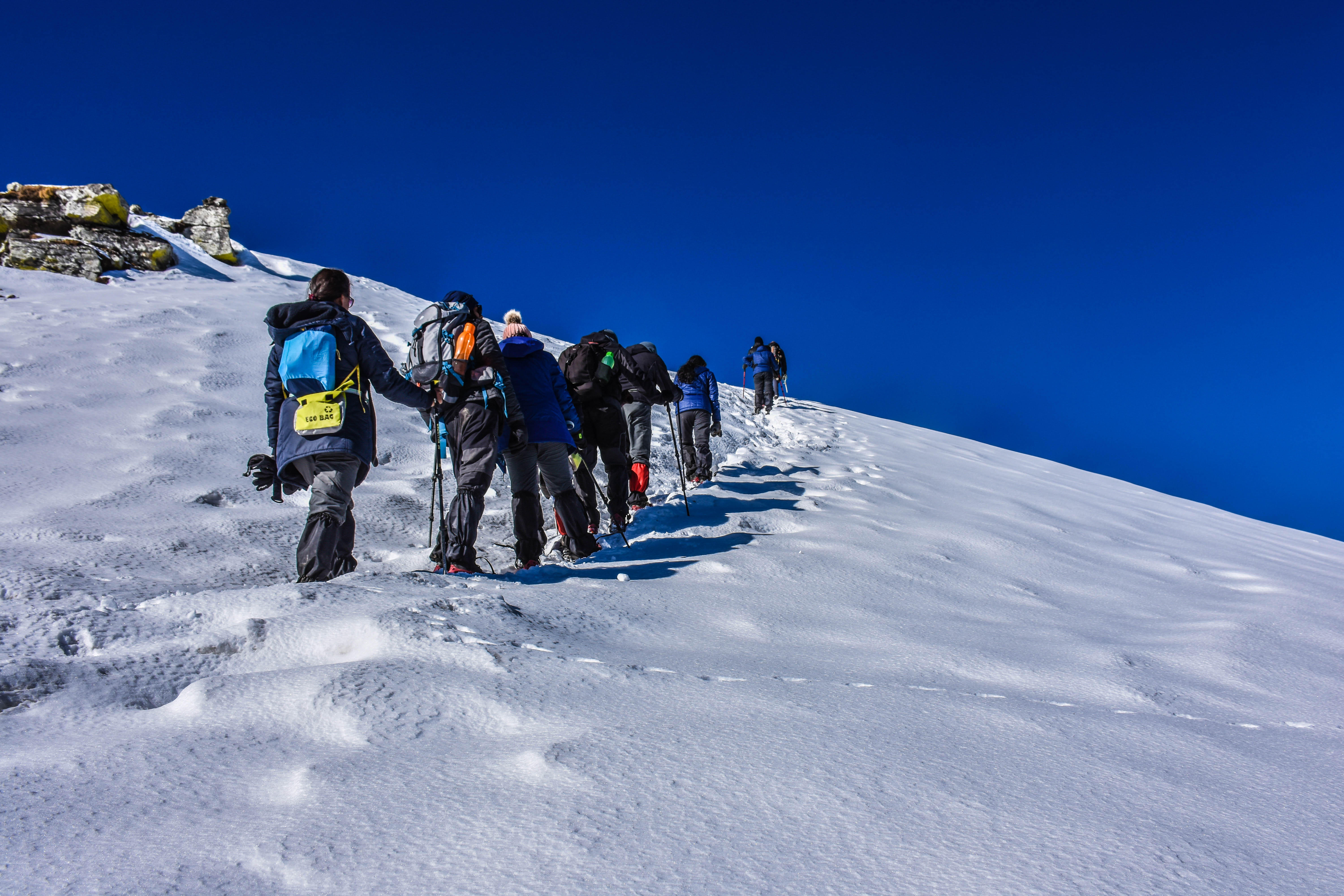
FAQ's of Chadar Lake Trek
How difficult is the chadar trek.
The Chadar trek is regarded to be one of the most difficult treks in India. It gives you a larger-than-life feeling with its extreme weather conditions amidst the natural surroundings. What makes the trek even more difficult is that trekkers are required to walk on the surface of the thick layer of a frozen river. Hence, a trekker should have enough stamina to cover a distance of five kilometers in just 30 minutes is a good fit for the Chadar trek Ladakh.
You can also check your body mass index (BMI) to find if your fitness level matches the difficulty of the trek. If your BMI is normal, you can plan your fitness regime for trekking. On the contrary, if your BMI is not normal, you are required to consult your trusted physician before adopting any fitness regime. Moreover, consultation from a medical practitioner is recommended if you are suffering from any chronic illness.
What are the best months to visit this trek?
The best months to visit the Chadar trek are between the first week of January to the second week of February. During these months, a thick sheet of ice gets formed on the Zanskar river, which makes a great trekking path for adventure lovers.
What is the minimum and maximum age limit of the Chadar trek?
The minimum age limit of the Chadar trek is 13 years, but children between 13 to 17 years of age should always be accompanied by their parents or guardians. For people above 60 years of age, you need to carry a detailed medical certificate that states you are perfectly fit for an adventurous activity like trekking.
What is the cellular network connectivity of the trek?
The cellular network connectivity of the trek is relatively nice upto Leh. But, it becomes difficult to find any network connectivity once you proceed to elevate on your trekking expedition to the Himalayas.
When will there be snow on this Chadar trek?
You will always find snow on this Chadar trek as the trek takes place during the months of January and February when the place experiences extreme snowfall.
What is the cost of the Chadar trek?
The cost of the Chadar trek starts from 17000 to 28000 per person. However, this cost may be subject to change if you may wish to rent a porter or mule. The hospitalization or emergency fees also need to be borne by the trekker apart from the general charges. Hence, you must get all the terms clear with your traveling authority before booking your expedition. On the contrary, if you book your trekking tickets online, you may avail yourself of the additional deals and discounts to make your trip cost-effective.
Is Chadar trek for beginners?
Chadar trek involves walking over a thick sheet of ice on the surface of the Zanskar river. This nine-day trek includes extreme weather conditions with snow all around. It becomes difficult to walk on ice because of the uneven formation. Surviving in the extreme temperatures of -30 degrees Celsius is a remarkable experience in itself. Hence, the Chadar trek is not for beginners as a beginner would not know the knick-knacks of handling the extreme situations of the trek.
What kinds of tents or sleeping bags will be provided to us on the trek?
On the Chadar trek, each trekker is provided with four-season tents and the sleeping bags are rated to prevent people from temperatures between -15 to -20 degrees Celsius.
Are there any toilet facilities on the trek?
No, there are no toilet facilities on the Chadar trek. You need to work in compliance with the rules and regulations of the villagers.
Is it safe for a solo woman traveler to travel in fixed departures?
Yes, it is completely safe for a solo woman traveler to travel in fixed departures. The trekking organization takes complete care of the safety and security of women in the group.
Will I get a certificate of trek completion?
Yes, you will get a certificate of Chadar trek completion once you return from your expedition. This certificate for trek completion will not be available if you return from the trek midway.
Treks in Himachal
Treks in uttarakhand, treks in ladakh, treks in nepal, treks in north-east, treks in kashmir.
.png?w=auto&h=400)
The content and images used on this site are copyright protected and copyrights vests with the respective owners.
© 2024 www.heyhimalayas.com All rights reserved.

- Best Hikes In The World
- Appalachian Trail
- European Hikes
- Nepal Hikes
- Patagonia Hikes
- See All Hikes
- Mount Kenya
- Mount Kilimanjaro
- Mount Toubkal
- See All Mountains
- South Africa
- New Zealand
- Switzerland
- United Kingdom
- Packing Lists
Chadar Trek – One Of The Most Wild And Beautiful Hikes On The Planet
Asia , India
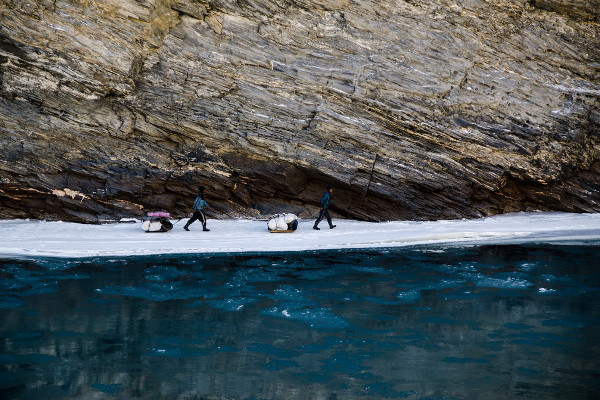
The Chadar Trek, or Zanskar Gorge, is widely known as one of the most difficult treks in the world . If you're an avid trekker, then chances are this wild and challenging trek is on your bucket list.
Chadar Trek Overview
The Chadar Trek is one of the most wild and beautiful hikes on the planet . Frequently covered by the world's top adventure channels and media outlets, the Chadar Trek takes hikers through a frozen river valley into the very heartland of India’s Ladakh region.
The region’s harsh desert environment and towering mountains make the Chadar trek one of the most popular treks in the Ladakh area . Very few treks are as remote as the Chadar and even fewer are conducted in high winter. The trek is not for the lighthearted as temperatures are often lower than -10 degrees celsius in the day and -20 at night.
Cut off entirely from the outside world, the Zanskar river is the only outlet for locals wishing to venture further into the Ladakh region. The trail has been used for nearly a thousand years by the Buddhist monks living in the region. You’ll trek the same route, walking over the frozen river as you cut a path towards Naerak. You will need to have a good level of stamina and fitness to have a really good time.
Accommodation is riverside camping.
Please Note: The Chadar trek is ideally suited to seasoned trekkers looking to experience one of the most remote places on earth.
Regional Map
The Chadar Trek is located in the Zanskar region of Ladakh which is part of the Indian state of Jammu and Kashmir .
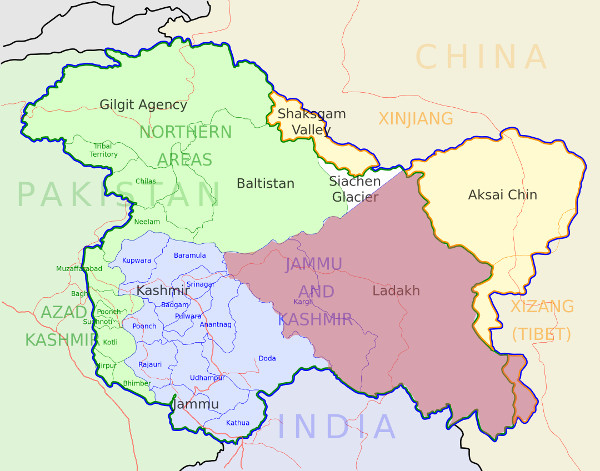
Chadar Hike Itinerary
Below is a detailed Chadar Trek itinerary. Please note that this is a typical itinerary that we would expect many operators to adhere to. However, some tour operators offer variations on this route.
Day 1-2: Arrival in Leh (3500 m)
After taking a flight from Delhi, you will arrive in Leh – the highest airport on earth! Take in the cool mountain air as you explore town before bedding down in your hotel for the night.
Day 3: Drive to Chilling – Hike to Tilad Do (3100 m)
After breakfast, your operator will take you by car to your starting point at Chilling roughly 3 hours away. Along the way, you will no doubt visit the important Buddhist temple of Shanti Stupa. Once in Chilling you will drive a little further to Tildad Do where your hike begins. The drive is fairly high and windy and you’ll need to hold your nerve as the road becomes tighter and more narrow.
You will then trek for several kilometres to reach your first coming ground. Along the path, you will walk for the first time on the river ice and get to grips with the cold weather of the region. Set up your tent quickly before the cold night sets in!
Day 4: Tilad Do to Shingra Koma (3170 m)
Today, you will be walking for almost 12 km as you venture along the valley floor towards your campsite at Shingra Koma. Make sure to follow the lead guide as you will be walking on river ice that can often crack.
As you walk, make sure to take in the incredible rock faces and surrounding snow-capped peaks as you walk in the footsteps of generations before you. The landscape is truly spectacular during winter and very few people get to witness such remote valleys.
Day 5: Shingra Koma to Tib Cave/Tibb (3225 m)
Today, you continue your journey along the river valley taking in the incredible gorges and frozen inlets as you venture towards Tib Cave.
The cave is a huge opening in the rock face in which you will camp for the night to shelter from the snow. Make sure to drink plenty of butter tea to keep your body warm and strong.
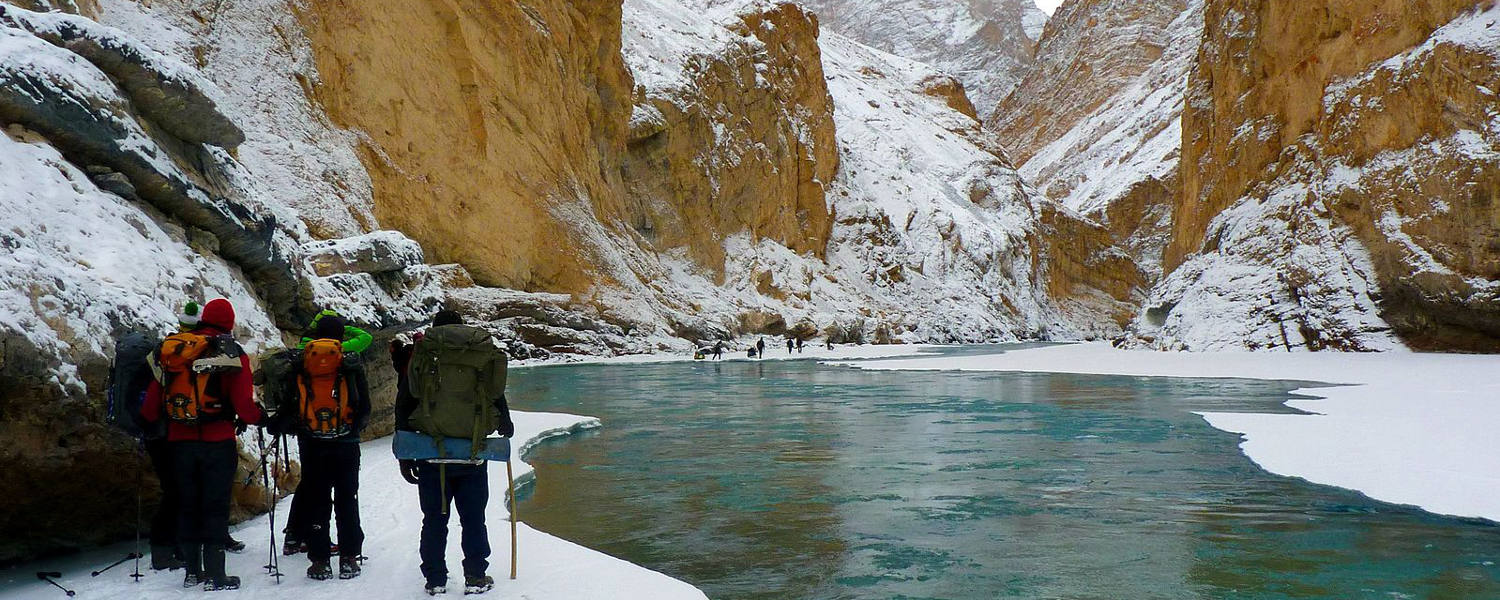
Day 6: Dib Cave/Tibb to Camp at Naerak (3390 m)
Today, you’ll be walking for roughly 10km as you trek the most beautiful section of the valley. Along the route you’ll be dazzled by one of the world's largest frozen waterfalls and large prayer flags fluttering in the cool breeze.
In the late afternoon, you’ll reach the village of Naerak where you have the chance to explore and talk to the locals – maybe share a drink or two!
Day 7: Naerak to Tibb
Today, your return journey begins as you proceed back to Tibb. However, your path may very well be different as the river reacts to the slightest temperature changes. Sections that were frozen may now be running and vice versa. Always follow the steps of your guide.
Day 8: Tibb to Shingra Koma
As you return down the river valley, you’ll have plenty of time to react on the stunning landscape and take pictures to show your relatives and friends back home. Keep a sharp eye out for wildlife including foxes, ibex and the elusive snow leopard. Although rarely spotted, you can be assured the leopards are watching.
Day 9: Shingra Koma to Chilling – Chilling to Leh
This is your last day on the Zanskar River. You’ll trek back to Tilad Do where you will say a final goodbye to the locals before taking a car back to Leh. Relax in a warm and cozy bed for the night to rest your tired muscles.
Day 10: Departure
Today, you say farewell to your crew and depart Leh for Delhi. Here, you will take your international flight home.
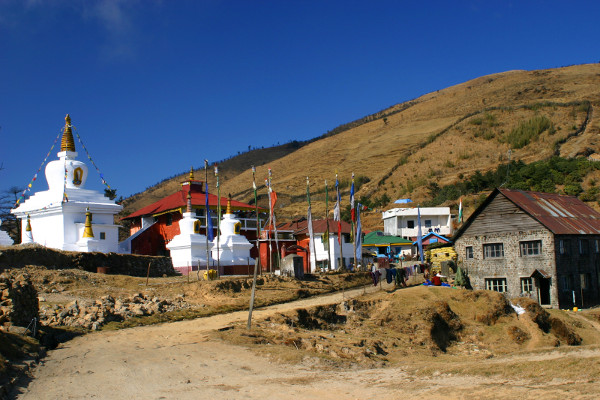
Chadar Trek FAQ
How much does the chadar trek cost.
The cost of the Chadar Trek varies depending on what operator you use. Local agencies often offer a guided trek for as little as US$250 per person (excluding flights). However, for an established western operator, you should look to pay at least double this. The trek can be dangerous and finding the right operator is important as your safety should be paramount.
You will also need to factor in flights, equipment, visas, vaccinations and food and drink. Each operator will offer a slightly varying package when it comes to food and drink on your trek.
- Visa, Vaccinations, Insurance etc: ~$300-$500
- Equipment (buying and hiring): ~$300-$800
- Flights to Leh: ~$1,000
- Tour Agency: ~$250 – 350 for a cheap local agency to ~$500 – 1000 for a Western trekking agency
- Tips: ~$50-$100
- Misc (additional food, unplanned travel / hotels ect): $200
- Total Costs: $2,200 – $4000
Are permits required for the Chadar Trek?
Permits are generally included with your trek costs. However, operators will often ask you to pay around US$50 for a wildlife/environment charge levied by the Indian government.
When is the best time to complete the Chadar Trek?
The best time to trek the Chadar Trek is January and February during the peak winter season . This is when the river is frozen and can be walked on (gently).
The Chadar Trek does not operate at any other point in the year.
Is altitude sickness a risk on the Chadar Trek?
Yes, the entire area is at high-altitude, and you’ll want to make sure you arrive several days before your trek to acclimatise to the thin air.
It is important to have a detailed understanding of the risks associated with high altitude trekking and how the body acclimatises.
We recommend you read our detailed article on Altitude Sickness and Acclimatisation .
How difficult is the Chadar Trek?
The Chadar Trek is considered to be one of the toughest treks in the Ladakh Region. The trail is cold, icy, often steep and always at high altitude.
Only experienced trekkers are recommended for this trek. You will need to be in good physical condition before attempting the route and have a good stamina built up.
The freezing temperatures also make the trek difficult with temperatures often exceeding -20 degrees at night and -10 degrees during the day.
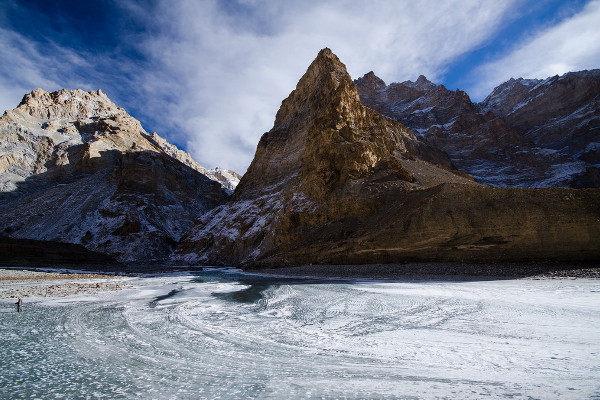
What gear do I need for the Chadar Trek?
Trekking in the Ladakh region requires a number of essential pieces of trekking clothing and equipment. The Chadar trek however requires some cold weather gear that is often not nesscary on the summer treks.
Many pieces of equipment can be rented or bought in Leh, but we recommend bringing the most important pieces of gear with you. The important thing is warmth. You’ll need a winter sleeping bag (may be provided) and good quality thermal gear.
To help you plan and prepare for your trek, we have written a detailed hiking gear list for multi-day treks .
What travel insurance do I need for the Chadar Trek?
Trekking insurance is a must on multi day hikes. This is particularly important on the Chadar Trek which is extremely remote. If an accident should occur that requires medical assistance and evacuation you will definitely want trekking insurance that can cover the costs of air ambulance and treatment.
Moreover, it is prudent to have insurance that covers you for any travel related risks, like lost, stolen, damaged or delayed baggage; flight delays and interruptions; and tour operators default.
Moreover, it is prudent to have insurance that covers you for any travel related risks, like lost, stolen, damaged or delayed baggage; flight delays and interruptions; and tour operators' default.
Are there any recommended guidebooks for the Chadar Trek?
There are a number of excellent guides we recommend for the Chadar Trek. These are:
- Trekking in Ladakh by Radek Kucharski.
- Trekking in the Indian Himalaya by Lonely Planet
- Trekking Guide to the Western Himalayas by Depi Chaudhry
- Ladakh: the Essential Guide: Including Kashmir & Manali by Partha S. Banerjee
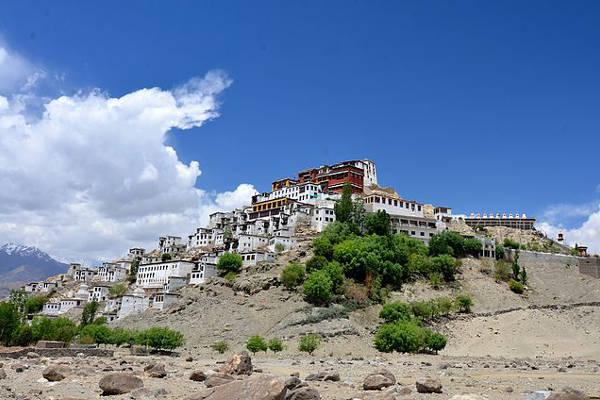
Are there other Indian Hikes besides the Chadar Trek?
Absolutely. We also recommend doing hikes like the Singalila Ridge , Markha Valley and Ladakh for unparallelled sightseeing and experiencing Indian culture and history firsthand.
Continue browsing
See more information on India . Or check out these other Indian Hiking articles:
- Hiking the Himachal Pradesh
- Trekking the Uttarakhand
- Roopkund Hike India
- Arunachal Pradesh India Treks
- Guide to India hikes
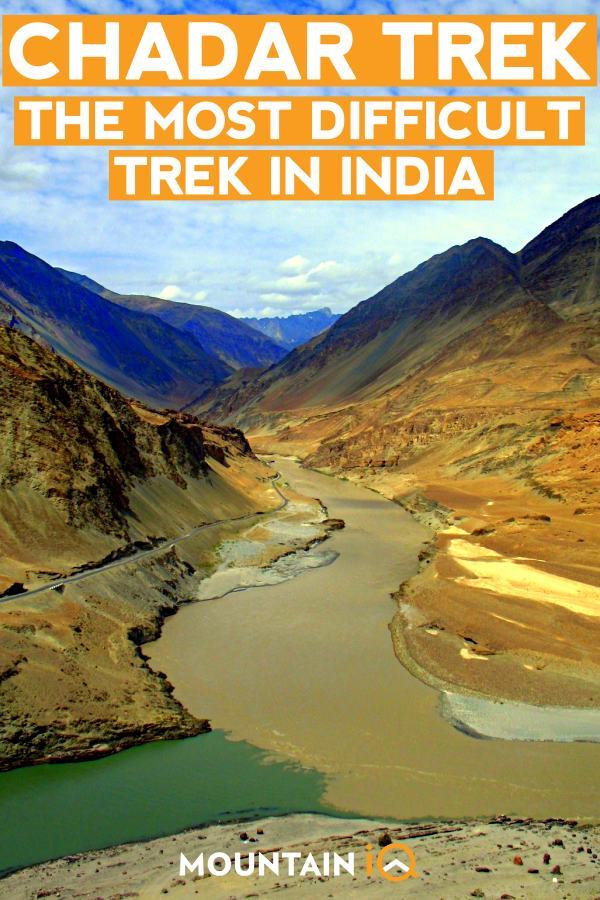
About the author
Mark Whitman
Mark has trekked extensively in Asia, Europe, South America and Africa. He founded Mountain IQ in 2014 with the sole aim to be the best online information portal to some of the most popular mountain destinations around the world. When not writing for Mountain IQ, Mark is out exploring the outdoors with his wife!
Leave a Reply
Your email address will not be published. Required fields are marked
We work with local guides to offer great value adventures at unbeatable prices

Chadar Trek, Ladakh: Everything You Need to Know
Nestled in the stark landscapes of Ladakh , the Chadar Trek is an adventure unlike any other, offering trekkers the unique opportunity to walk on a frozen river amidst towering mountains and surreal icy formations. In this comprehensive guide, we'll delve deep into everything you need to know about embarking on the Chadar Trek, from its route and highlights to essential tips for a successful expedition.
Also Read: 10 Best Trekking Destinations in India for October and November
1. Understanding the Chadar Trek:
The Chadar Trek, also known as the Zanskar Frozen River Trek, is a winter trekking expedition that takes adventurers along the frozen Zanskar River. The trek derives its name from the 'Chadar,' which refers to the thick blanket of ice that forms over the river during the winter months. This iconic trek is not just a test of physical endurance but also an opportunity to witness the raw beauty of Ladakh in its most pristine form.
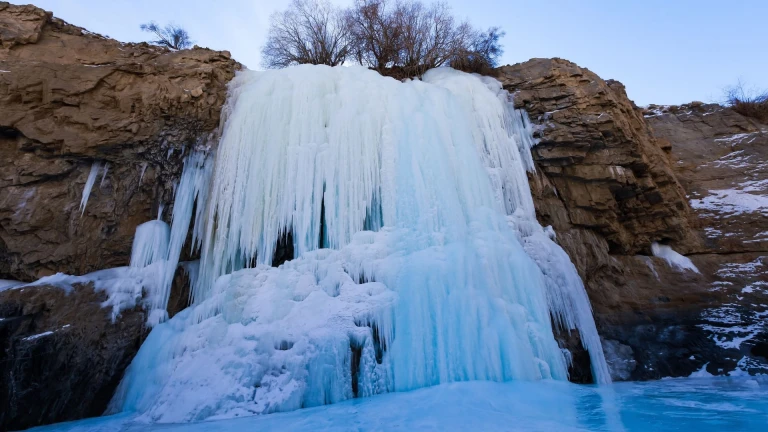
2. Route and Highlights:
The Chadar Trek typically starts from the village of Chilling, located about an hour's drive from Leh, the capital of Ladakh. From here, trekkers embark on a thrilling journey along the frozen river, navigating through narrow gorges, icy cliffs, and surreal ice formations. The trek offers stunning views of the towering Himalayan peaks and allows trekkers to immerse themselves in the remote wilderness of Zanskar Valley.
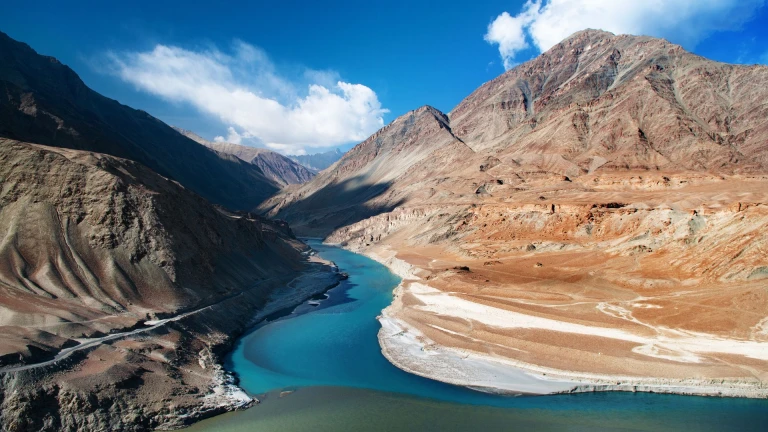
One of the highlights of the Chadar Trek is the opportunity to witness the mesmerizing beauty of the frozen waterfalls along the route. These cascading ice formations, sculpted by nature's hand, create a magical ambiance that leaves trekkers in awe of their surroundings.
3. Best Time to Visit:
The ideal time to undertake the Chadar Trek is during the winter months of January and February when the Zanskar River freezes over, creating a solid ice sheet that is safe for trekking. During this period, temperatures in Ladakh plummet well below freezing, often reaching as low as -30°C (-22°F). However, the harsh conditions are what make this trek so unique and rewarding, offering trekkers a chance to experience the raw beauty of Ladakh in its most extreme form.
4. Difficulty Level and Fitness Requirements:
The Chadar Trek is considered to be one of the most challenging treks in the world, primarily due to the extreme weather conditions and the rugged terrain. Trekkers are required to cover long distances each day, often walking for 6-8 hours on the icy surface of the river. Additionally, the sub-zero temperatures and high altitude can take a toll on the body, making it essential for trekkers to be in excellent physical condition and adequately prepared for the challenges ahead.
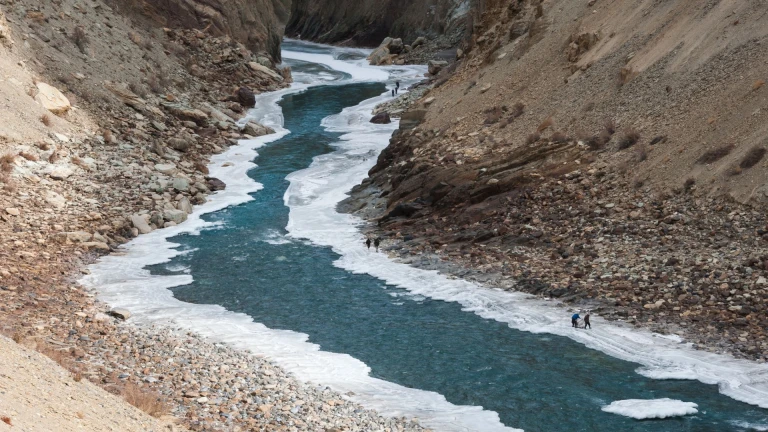
5. Essential Gear and Packing List:
Packing the right gear and equipment is crucial for a safe and comfortable trekking experience on the Chadar Trek. Some of the essential items to carry include:
Insulated, waterproof trekking boots with good grip
Layered clothing including thermal innerwear, fleece jackets, and windproof outer shells
Waterproof pants and gaiters to protect against snow and ice
Insulated sleeping bag suitable for extreme cold temperatures
High-quality down jacket to keep warm during rest breaks
Sunglasses with UV protection to prevent snow blindness
Headlamp or flashlight with extra batteries for night trekking
Personal hygiene essentials including wet wipes, hand sanitizer, and toilet paper
First aid kit with essential medications for altitude sickness, cold, and injuries
It's crucial to pack light while ensuring you have all the necessary items to stay warm and comfortable in the harsh winter conditions of Ladakh.
6. Permits and Regulations:
Before embarking on the Chadar Trek, trekkers need to obtain the required permits from the Ladakh Tourism Department or local authorities. As per the new directives received from the local authorities in Leh, it is mandatory for all participants to undergo a medical examination at Leh and spend 3 nights in Leh before departure for the trek. Also the forest department & ALTOA have made it mandatory to obtain a special permit to trek on the Chaddar. Rs 5000 /- per person has to be paid for the medical checkup & permit individually by each participant at Leh.
Additionally, it's essential to follow Leave No Trace principles and adhere to all regulations to minimize environmental impact and preserve the fragile ecosystem of the Zanskar Valley.
Documents to carry:
A photo ID proof like driving license, voter ID, passport. ID proof would be required at the airport and the hotel. Also, the ID proof would be required to make the permit for the Chadar trek.
4 Passport size photos to make the permit and insurance.
A medical certificate of your fitness for the trek. The medical certificate should be from a recognized doctor.
Indemnity certificate
Covid-19 vaccination certificate
7. Hiring Guides and Porters:
Due to the challenging nature of the Chadar Trek, it's highly recommended to hire experienced local guides and porters who are familiar with the terrain and weather conditions. Experienced guides not only provide valuable insights into the region's culture and history but also ensure safety and navigation through treacherous sections of the route. Porters can help carry heavy equipment and supplies, allowing trekkers to focus on enjoying the journey without the burden of excessive weight.
8. Must Visit or Must Do during the Chadar Trek:
While the entire Chadar Trek is filled with stunning landscapes and unique experiences, there are a few must-visit places and must-do activities that trekkers should not miss:
1. Shingra Koma: Located along the route of the Chadar Trek, Shingra Koma is a picturesque camping site surrounded by towering cliffs and frozen waterfalls. Trekkers can spend the night here, marveling at the star-studded sky and enjoying the warmth of a bonfire amidst the icy wilderness.
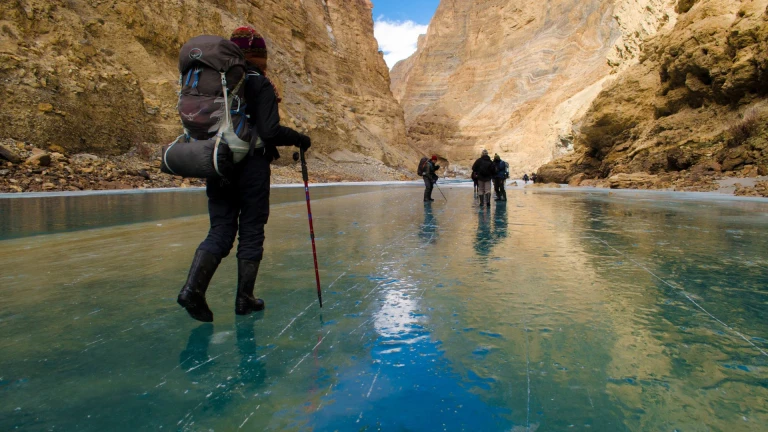
2. Nerak Village and Frozen Waterfall: Nerak Village is a remote settlement nestled in the heart of the Zanskar Valley, accessible only by foot during the winter months. Trekkers can visit the famous Nerak Frozen Waterfall, a towering ice formation that glistens in the sunlight, creating a mesmerizing spectacle against the backdrop of snow-capped mountains.
3. Chadar Formation and Ice Patterns: As trekkers make their way along the frozen river, they'll encounter various formations and patterns created by the natural movement of ice. From intricate icicles hanging from rocky cliffs to smooth, glass-like surfaces stretching as far as the eye can see, the Chadar Trek offers a visual feast of unique ice formations that are a photographer's delight.
4. Cultural Encounters: The Chadar Trek provides opportunities for cultural immersion as trekkers interact with the indigenous people of Zanskar Valley, including the hardy Ladakhi porters and guides. Trekkers can learn about the traditional way of life in this remote region, including age-old customs, rituals, and beliefs passed down through generations.
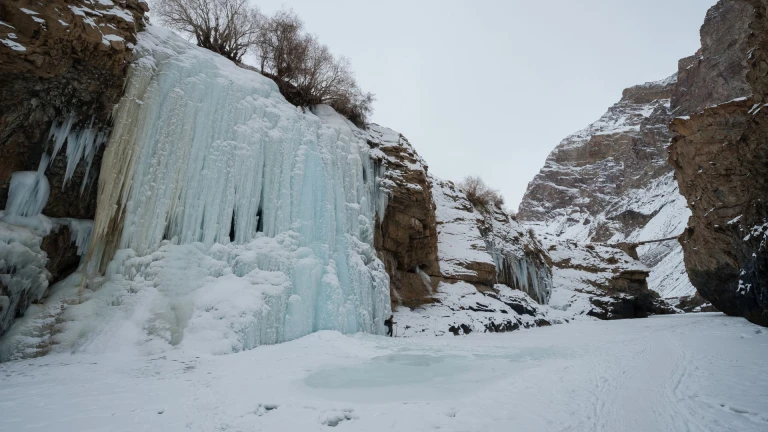
The Chadar Trek is not just a physical journey; it's an expedition into the heart of Ladakh's winter wilderness, where every step is a testament to the resilience of the human spirit and the beauty of nature in its most extreme form. From walking on frozen rivers to camping under starlit skies, the trek offers a once-in-a-lifetime experience that leaves trekkers with memories to cherish for a lifetime. So, gear up, brave the cold, and embark on an unforgettable adventure into the frozen kingdom of Ladakh.

By Manya Shastry
Hampta Pass Trek: Everything You Need to Know
IndiGo Launches Direct Flights to Colombo from Mumbai
Subscribe to TripZilla
Get updated on travel deals and trip ideas!
Related Posts
10 amazing hacks for comfortable train journeys in India
Make your Indian train journey comfortable with these 10 hacks: choose the right class, pack essentials, stay hydrated, wear comfy clothing, charge devices, bring entertainment, prioritize safety, book lower berths, use travel apps, and socialize.
10 Food Items That You Must Try While In Sri Lanka
Embark on a culinary escapade through Sri Lanka's vibrant streets and discover the top 10 mouthwatering dishes that define this island paradise!
10 Hidden Destinations In Northeast India
Immerse yourself in the magic of unexplored landscapes, vibrant cultures, and breathtaking adventures. Ready to redefine your wanderlust?
10 Important Things you should know about South Korea before traveling
Explore the wonders of South Korea with 10 Important Things to Know Before Traveling. This blog unveils cultural insights, from decoding Hangul to navigating bustling streets.
10 Luxury Hotels in Bangalore That Are Too Good To Be True
From regal palaces to eco-chic retreats, join us as we uncover the city's 10 Luxury Hotels that redefine opulence!
Latest Posts
10 Best 3-Day Trips from Mumbai - Location, Things to do and more!
Escape the urban hustle with our guide to the 10 Best 3-Day Trips from Mumbai
10 Best Hotels to stay in and around Nai Delhi / New Delhi
This guide explores 10 fabulous options, from luxurious escapes to budget-friendly gems. Find comfort, convenience, and a touch of India's magic.
10 Premium hotels in Pune for Luxury Lovers
Looking for a luxurious stay in Pune? Ditch the hostels and explore our list of 10 premium hotels!
10 Cozy Stays in Kullu Manali for Couples
Escape to the majestic Himalayas and create unforgettable memories with your loved one.
Flash Flood at Courtallam Falls, Tenkasi: Are You Prepared for Monsoon Dangers?
Flash flood at Courtallam Falls highlights monsoon travel risks.
Chadar - The Frozen River Trek
Walk on a Frozen River. Literally! / The ultimate Ice Walking Experience of Ladakh
Available Batches
Brief description.
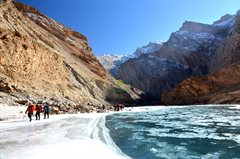
Brief Itinerary
Detailed itinerary.
Arrive in Leh (3,500 M)
The trek starts from Leh, which is a headway into Ladakh that is home to some of the highest peaks in the region. Because the roads are shut, the only way to get to Ladakh in winters is through air. There are flights that fly into Leh through Delhi and this two hour journey is where the magic begins. Try to get a window seat on the plane for the bird’s eye view of the Himalayas is absolutely mesmerizing.
Day one is reserved for you to make your way to Leh and get settled into your accommodation. Since you will be coming to this altitude from sea level, the body will need time to get comfortable with the altitude and the mountain air. Winters in Leh are quite harsh but the cold you experience here is only just the beginning!
Rest and Acclimatization in Leh (3,500M)
Day two is reserved for rest and acclimatization to the altitude, too. This is important to allow your body to adapt to its new environment and reduce chances of adverse health conditions. You can go around and explore the city market, delve into the colors and culture of this high-mountain city and visit some places nearby. A little movement around the city would be good for acclimatization. Also, use this time to go through your checklist and do some last-minute shopping for what you might be missing for the trek. Leh has the best market for trekking essentials.
While the body acclimatizes, we take this time to get together with the group for a debriefing session where we get to know each other better and delve into the happenings of the next few days - schedule, what to expect, basic do's and don'ts in the mountains, how to maintain the sanctity of the environment and other such matters of importance.
Day 3 is also reserved to adapt to the cold winters of Leh. The only other thing on the agenda is a mandatory medical check-up at the Tourist Information Centre which is essential to obtain a NOC from ALTOA and a permit from the Wildlife Department to trek on Chadar.
Leh (3,500M) to Shingra Koma via Bakula (3,215M)
Distance: 70 kms
Duration: 2-3 hours
Today is going to be our first actual day on Chadar – the first day when we trek in this winter wonderland. But not before we drive to Bakula which is the starting point of the trek. We start early in the morning to drive along the beautiful Indus River and past the confluence of Indus and Zanskar rivers at Nimmu. This short 70 km drive which should take close to 3 hours to cover, offers some of the most spectacular views as the vehicle goes around some narrow hairpin bends. As we inch closer to Bakula, we start to see the frozen marvel – Zanskar, waiting in all its glory. Once out of our vehicle and on the Chadar, the trek leaders will give you some quick tips on how to best manage yourself on this sheet of glassy ice. It will take a while to get a hang of it so don’t worry if you don’t get it right, right away – no one does. Walk around as much as you can using the Penguin Walk and you will soon find yourself giving tips to others.
The best thing about Chadar trek is that you walk on a flat surface throughout the trek. There are no steep ascents or descents and very little chance of catching AMS since you don’t gain any altitude throughout the trek. If you are comfortable today, you are already acclimatized and you should be able to finish the entire trek without any major issues.
Depending on the weather, the Chadar changes its forms. It can be hard and glass-like in some patches, or it can have a layer of powder snow on it giving you a better grip, or you could face thin ice in certain areas, so you might have to walk in slush or dodge that entire patch and go over the rocks on the side of the river. Walk together as a team and always follow the sledge route used by the porters as it is the safest route on Chadar.
We should reach the next campsite within 3-4 hours, depending on our speed and will spend our first official night camping on Chadar.
Shingra Koma to Tibb (3,280M)
Distance: 14 kms
Duration: 6-7 hours
The hardest part from here on is getting out of the warm sleeping bag and your cozy tents to step out into the freezing cold. However, the people of Zanskar are known for their hospitality – you will always wake up to a hot cup of tea and a meal waiting for you - all of which makes waking up in subzero temperatures just a little bit easier.
Today is a long day with 14 long kilometers to our next campsite. Since walking on Chadar is not the easiest, this should take anywhere between 6-7 hours to cover. Remember to top up your thermos with warm water – regular water bottles cannot fight the cold of Chadar and the water tends to freeze up. Sunshine in this bend of the land is a scarce commodity as well. You will only see the sun for an hour or two on the trail and that too, in patches since the walking trail is fenced by giant mountains on both sides. Marvel at the views as you walk in this huge valley with nothing but pure crisp air and huge rocks on both sides. The color of the Zanskar river is a vibrant deep blue that matches the blue of the sky on a clear, sunny day. The trail also offers frozen waterfalls all along the way. We stop along the river to cook our meals so that we are not walking empty-bellied. The last 200M to Tibb is stunning. Expect to reach the campsite by late afternoon.
Tibb (3,280M) to Nerak (3,400M)
Distance: 12 kms
Duration: 5-6 hours
At the end of today we get introduced to one of the biggest highlights of Chadar trek, the mother of all waterfalls – Nerak Waterfall. It is going to be another long day, so we begin early and aim to reach the waterfall by late afternoon so that we have all evening to marvel at it. The sun makes an exit from the Zanskar Valley early and the only way to keep warm is to keep moving. The ice in various patches is broken in the middle of the frozen river, forming geometrical structures of various shapes and sizes, which are fascinating to see. The lunch today is peculiar too, inside of a cozy cave, mid-way through our day. The cave is massive and can fit 12-15 people comfortably. Once we make it to the campsite, we feast our bellies to some snacks and make our way to the gigantic Nerak waterfall. It should take us about 30 minutes to get there. Along the way, we might even see a few domestic Yaks grazing the higher grounds. Right next to the waterfalls is a bridge across the river, which takes you up to Nerak village. It’s fascinating to see the old wooden bridge under the new concrete/steel bridge. We spend some time at the Nerak waterfall, before heading back to the campsite for dinner.
Nerak (3,400M) to Tibb (3,280M)
After that thrill of a climax which is Nerak waterfall, we start our journey back to where we came from. Today, we head back to Tibb campsite but nothing on Chadar is ever the same. If you think you know the route back and can predict the challenges for the day, you are in for a surprise. The frozen Zanskar river reacts to the slightest change in temperatures, and constantly keeps changing its form – hence, even though the trail is the same, it is different! Pay close attention to all the changing sounds as you walk on different kinds of surfaces – it is fascinating. Along the way, we see local porters wearing traditional woolen robes called ‘Gonchas’, with colourful beads around their neck and their traditional hats. It’s fascinating to see the locals negotiating the frozen river, as they seem to walk like the wind, absolutely comfortable with the slippery uneven icy surface. They greet you using the local phrase ‘Julley’ which is the Ladakhi term for hello/welcome. You might also catch a few locals singing traditional Ladakhi songs while pulling their sledges and enjoying the journey. We penguin walk our way to Tibb, as the locals zoom past us with such ease.
Tibb (3,280M) to Bakula (3,215M) and drive to Leh (3,500M)
Distance: 12-13 kms
Duration: 7-8 hours
For our last day of the trek, we head back to where we started from – and we’ve come a full circle. To reach Bakula, we should take 7-8 hours. The drive back to Leh should be close to 3 hours from there on. We stay the night at a hotel.
Departure from Leh
The trek ends here. If you plan to stay for a few more days to explore the wonders of Ladakh, the article below might help start you off on what places to consider. Places that you must visit in Leh Ladakh
Like we indicated before, the weather on high-altitude is unpredictable as are many other conditions. We would suggest you keep spare days between the end of the trek and your travel arrangements to head back home.
What's Included
- Camping during the trek on twin sharing basis and hotel stay in- Leh on Day 1, Day 2, Day 3 and Day 8 on twin/triple sharing basis.
- Meals during the trek starting lunch on Day 4 till lunch on Day 8
- Trek equipment includes Dome Tents (twin sharing), Siachen sleeping bags, mattress
- Helmet, Gaiters, Harness & Carabiners as required
- Experienced & mountaineering certified trek Leader with first aid certification.
- Services of Guide, Cook and Support team
- Transport from leh to Road head and return
What's Not Included
- Meals during hotel stay in Leh
- Any expenses incurred on medical examination in Leh
- Gum Boots will not be provided by us. Please carry your own Gum Boots or buy the same in Leh.
- Inner Line Permit Fee
- Any kind of personal expenses
- Any kind of Outdoor Insurance
- Portage of personal luggage
- Anything not specifically mentioned under the head price Includes
- Altoa & Environmental / Wildlife Permit Fee. Approx Charge 6k to 8k to be paid on the spot to the authorities
Are you Eligible for this Adventure?
Climbing up to an altitude of 3,400M, Chadar - The Frozen River Trek is as challenging as it is beautiful. Although it does not involve too much of a gain in altitude, adapting to the extreme temperature which drops to as low as -30 degrees and walking on a frozen river for 9 days is what makes this trek difficult. It is perfect for someone with prior trekking experience looking to level up a notch!
Max Altitude

BRS Level Required
Chadar - The Frozen River Trek is a level 5 adventure on the Bikat Rating Scale.
This makes it mandatory for you to have high-altitude experience of preferably multiple treks marked at level 4 on the BRS. The altitude, the terrain and the nature of the climb demand a certain level of skill and a need for you to be aware of how your body reacts to the various features of a high altitude environment.
If you do not know what level of BRS trek would suit you best, worry not! Fill out this Form:

we will send you a progression chart to help you comfortably get out of your comfort zone in order to level up and ultimately reach your highest potential in the big, bad world of outdoor adventure.
Packing List
This is a list of essential items for individuals doing the trek with Bikat Adventures. This list contains only those items which the participants are required to bring with them. The list excludes those items which are provided by Bikat Adventures on the trek. We have divided the items into five categories. All the items in the list are essential except for those marked as optional.
Trekking Gear
- Ruck sack bag with rain cover. Qty -1
- Day Pack Bag - Recommended for treks with summit day
- Head Torch with spare Batteries. Qty -1
- U V protection sunglasses. Qty -1 Here is how you can choose the best sunglasses for trekking.
- Water Bottles: 2 bottles of 1 liter each
- Non-skid, deep treaded, high-ankle trekking shoes Qty -1
- Pair of light weight Slipper/Sandals Qty -1
- Quick Dry Warm lower or Track Pants. Qty - 2
- Full sleeves T-shirts/ Sweatshirts. 1 for every 2 days of trekking
- Pair of thick woolen socks. 1 pair for every two days of trekking
- Thermal Body warmer Upper & Lower. Qty-1
- Undergarments. Qty - 1 for every day of trekking
- Warm jacket closed at wrist & neck .Qty-1
- Full sleeves sweater. Qty -1
- Rain wear ( Jacket & Pants ) . Qty-1
- Pair of waterproof, warm gloves. Qty-1
- Woolen cap. Qty-1
- Sun shielding Hat. Qty -1
- Personal toiletries kit (Small Towel, Toilet paper, paper soap, Bar soap, toothbrush, toothpaste, cold cream, etc.)
- Sun screen lotion small pack. Qty -1 Here is your Sun Protection 101 to stay safe in the bright sunny outdoors.
- Lip Balm small pack. Qty-1
- Small size, Light weight & Leak proof lunch box. Qty-1
- Plate. Qty- 1
- Spoon.Qty-1
- Tea/Coffee (plastic) Mug.Qty-1
Miscellaneous
- Camera (Optional)
- Carry your medicines in plenty in case you have any specific ailment. Consult your doctor before joining the trek.
- Dry fruits, Nuts, Chocolate bars (Optional)
Frequently Asked Questions
Eligibility, is this adventure good for me, what’s a good fitness benchmark for this adventure, what skills do i need to complete this adventure, what is the minimum and maximum age limit, about the activity, where is it located, what are some of its highlights, what are some of its challenges, what is the best season for this, what is the accommodation type, what is the temperature like here, is it technically challenging, connectivity, how do i reach the starting point, is there cellular network available throughout, where is the nearest atm, if i choose to travel to the base with you, what is the pick-up point, what time is the drop-off on the last day, what are the nearby attractions that i can explore, equipment & gear, what equipment is provided to us, what can i rent from you, where will i receive the rented items, where do i have to return the rented items, what gear do i need to bring, are there local shops to rent/buy equipment, facilities & additional services, can i offload my bag, can i leave any extra luggage i carry at the base of this adventure, what are the meals like, what are the washroom/ toilet facilities like, what should i do if i get my period on this adventure, what are the medical facilities available to me on this adventure, are there any electricity charging points on this adventure, mandatory documents, what documents do i need to carry, do i need insurance for this, do i need a permit for this, certification, do you provide a certificate of completion, when and how will i get the certificate of completion, international travel, will i need a visa, when should i apply for the visa, what kinds of insurance do i need to travel here, what is the specialty of this when compared to other mountain ranges, till which month can i make a booking for this, what is the qualification of the outdoor leader provided to us, how do you choose your outdoor leaders, is it safe for women, what is the ratio of outdoor leader to participants, what do you do in case of an emergency, what are the rescue options on this adventure, how do you choose your equipment, can i attempt this adventure if i have a specific medical condition, sustainability, what kind of camping do you practice on your outdoor adventures, why are you against fixed camping in the outdoors, how do you manage overcrowding on certain trails, what are some things to remember when using a dry toilet, why should i avoid wet wipes in the outdoors, where should i dispose of my sanitary waste if i am on my period, why should i carry my own utensils on an outdoor adventure, booking process, what happens after i make the payment, do you create a whatsapp group of participants before the start date of the activity, do i need to submit a medical certificate, do i need to submit an undertaking form.
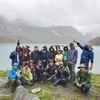
Small Group Size
Our batch sizes are capped at 15 for smaller treks with the trek leader and trekker ratio of 1:8. This ratio, in our years of experience, has proven to deliver the best trekking experience for individuals as well as groups. Capping the size of the group ensures individual attention to each trekker so that no signs of distress or need during the trek go unnoticed. It also helps to form a more cohesive cohort with better group energy which helps define the rhythm and pace of days on the trek. As you go higher up on the BRS scale, since the stakes are higher, expeditions have an even smaller group size with the ratio of expedition leader to climber set at 1:2.
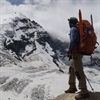
Qualified Trek Leaders
We follow a rigorous regime of hiring and training our experts in the field. Each trek leader is a certified mountaineer with years of experience in the field. In addition to their qualification, they also go through practical and situational training to tackle any and all kinds of sudden conditions that may present themselves on the ground. Being unpredictable is the core nature of the mountains but being ready for any circumstance as best as possible is a controllable asset that we try to nurture. Our field experts are also trained in basic medicine and first-aid response. Watch: Forerunners - The Making of A Trek Leader At Bikat Adventures
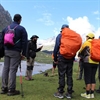
Guided Progression
Since Bikat Adventures is a learning-based organization, we help you climb up the ladder of difficulty within the sphere of outdoor adventure systematically. Our on-ground training modules are designed to handhold you through the upskilling process so that you are ready to take on bigger challenges.
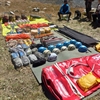
Equipment Quality and Check
All the gear used on our treks and expeditions is tried and tested, maintained for good quality, and is overall top-notch in quality and condition. We are continually looking to obtain the best of everything there is in the market so as to ensure optimum safety.
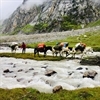
Support Systems
Along with the staff you see on-ground, we have a team of superheroes working in the background to give you the best experience possible. Our background team also comprises local staff from each area who know the region best. Having local support helps with studying the area, pre-planning, execution, and in receiving timely support in case of emergencies in these remote locations.
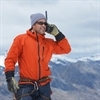
Communication
Our on-field staff is in constant contact with our teams based in primary locations so as to eliminate any avoidable delay in reaching additional help and support when required. We try to use the best tools for communication available, including satellite phones, in regions where they are not restricted.
What our customers Say

Cancellation Policy
Cash refund
Cancellations up to 30 days prior to departure date
5% deduction
Cancellations between 30 days to 15 days prior to departure date
50% deduction
Cancellations within 15 days prior to departure date
Voucher refund
Cancellations up to 5 days prior to departure date
No Deduction
Cancellations within 5 days prior to departure date
- Cash refund is applicable only in case of bookings made without using any promotional offer code or vouchers
- This is only a brief of cancellation terms. For finer details please refer Detailed Cancellation Policy.
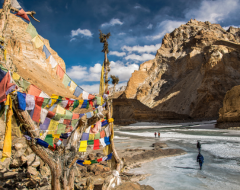
Subscribe for latest updates & offers
Similar adventures.

Sumda Chey Winter Trek
A mystical winter trek where adventure meets culture.
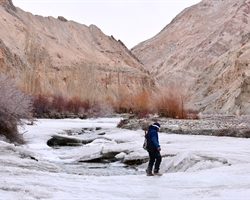
Markha Valley Winter Trek
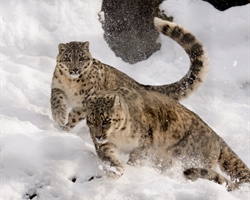
Snow Leopard Trek - Spiti
Trekked by many, discovered by a handful, enter your email, events by categories.

Mountaineering

Scuba Diving
Events by months.
- January July
- February August
- March September
- April October
- May November
- June December
Events By Nights
- 5 & More Night
- Environmental Policy
- Privacy Policy
- Term & Conditions
- Work With Us
- Address: 303, 3rd Floor, Tower B4, Spaze Itech Park, Sector 49. Gurgaon
- Pre Sale - 7838148127 , Post Sale - 8588878499, 9667639126
Bikat Adventures
- Cancellation & Refunds
- Content Sharing
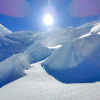
© 2024 Bikat Adventures - All Rights Reserved
Powered by: novel knett software solutions, submit enquiry.
🗓 Best Time To Visit: January to February
⏰ Open Hours: N/A
🏞 Things To Do: Trekking, Photography, Camping, Nature Walks
💰 Budget: INR 15,000 - 25,000 per person
🧳 Traveller Types: Adventure Seekers, Nature Lovers, Photographers
🔍 Known For: Unique frozen river trek, Beautiful landscapes, Leh Palace, Zanskar River
📍 Distances: Leh Airport - 9 km, Srinagar Railway Station - 421 km, Leh Town - 5 km
🥾 Trek Difficulty: Moderate to Difficult
🧣 Essential Gears: Thermal Clothes, Trekking Shoes, Trekking Pole, Sunglasses, Sunscreen, Medicines
📜 Permit: Mandatory Ladakh Autonomous Hill Development Council (LAHDC) permit
🔺 Altitude: 3,850 meters
Chadar Trek: A Complete Guide to the Frozen River Trek in Ladakh
Have you ever dreamed of walking on a frozen river, surrounded by snow-capped mountains and stunning scenery? If yes, then you should definitely try the chadar trek, one of the most unique and adventurous treks in the world. The chadar trek is a winter trek that takes you along the frozen Zanskar river in Ladakh, a region in the northern part of India. The chadar trek is not for the faint-hearted, as it involves braving the extreme cold, the slippery ice, the unpredictable weather, and the remote wilderness. But if you are up for the challenge, the chadar trek will reward you with an unforgettable experience, a sense of achievement, and a glimpse into the culture and lifestyle of the local people who have been using this route for centuries.
In this article, we will tell you everything you need to know about the chadar trek, from what it is, why you should do it, how to reach it, when to go, what to expect, what to prepare, and how to book it.
What is Chadar Trek?
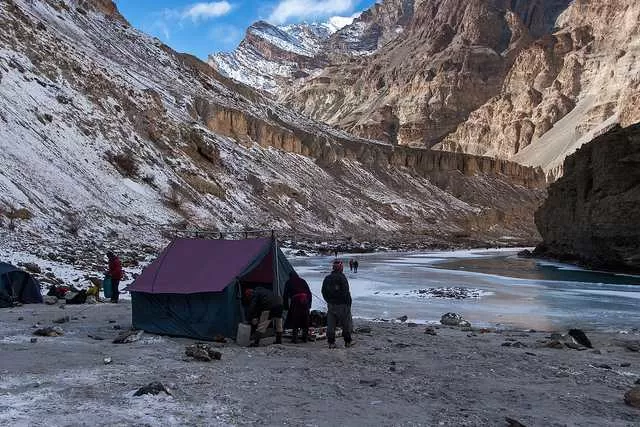
The word chadar means blanket in Hindi, and it refers to the thick layer of ice that covers the Zanskar river during the winter months. The Zanskar river is a tributary of the Indus river, and it flows through a deep and narrow gorge in the Zanskar valley, which is part of the Greater Himalayas. The chadar trek is a trek that follows the frozen river for about 105 km, from Chilling to Naerak and back. The chadar trek is also known as the frozen river trek or the Zanskar trek. The chadar trek is one of the oldest and most traditional routes in Ladakh, as it was used by the local people, especially the Zanskari people, to trade and communicate with the outside world when the road access was blocked by snow.
Why Chadar Trek?
The chadar trek is not just a trek, it is an adventure, a challenge, and a learning experience. Here are some of the reasons why you should do the chadar trek:
1. The chadar trek is a unique and rare trek, as it is one of the few places in the world where you can walk on a frozen river. The chadar trek is also a seasonal and unpredictable trek , as it depends on the weather and the river conditions, which can change anytime. The chadar trek is also a dynamic and diverse trek, as it offers different landscapes, terrains, and views, depending on the time of the day, the angle of the sun, and the thickness of the ice.
2. The chadar trek is a thrilling and exciting trek, as it involves walking, sliding, crawling , and sometimes even swimming on the frozen river. The chadar trek is also a challenging and demanding trek, as it requires a high level of fitness, stamina, endurance, and mental strength. The chadar trek is also a risky and adventurous trek, as it exposes you to the extreme cold, the slippery ice, the unpredictable weather, and the remote wilderness.
3. The chadar trek is a cultural and educational trek, as it introduces you to the culture and lifestyle of the local people , especially the Zanskari people, who have been living in this harsh and isolated environment for centuries. The chadar trek is also a spiritual and inspirational trek, as it passes by many ancient and sacred sites, such as monasteries, shrines, and caves, that are revered by the Buddhists. The chadar trek is also a social and fun trek, as it allows you to meet and interact with other trekkers, guides, porters, and locals, who share your passion and enthusiasm for the chadar trek.
Best Time to Go for Chadar Trek
The best time to go for the chadar trek is from mid-January to mid-February , when the Zanskar river is frozen enough to support the weight of the trekkers. The chadar trek is not possible before or after this period, as the river is either too thin or too thick to walk on. The chadar trek is also not possible during the summer months, when the river is flowing and not frozen.
The best time to go for the chadar trek also depends on the weather, the river condition, the availability, and the preference of the trekkers. The weather in Ladakh during the winter months is very cold, dry, and windy, with temperatures ranging from -5°C to -25°C.
How to Reach Chadar Trek
The chadar trek starts and ends at Chilling , a small village in the Zanskar valley, which is about 65 km from Leh, the capital of Ladakh. To reach the chadar trek, you need to first reach Leh, and then take a taxi or a bus to Chilling. To reach Leh, you have two options: by air or by road.
By air , you can take a flight from Delhi, Mumbai, Bangalore, or other major cities in India, to Leh, which is the nearest airport to the chadar trek.
By road , you can take a bus or a car from Manali, Srinagar, or other nearby towns in Himachal Pradesh or Jammu and Kashmir, to Leh, which is the nearest road head to the chadar trek. The road distance is about 475 km from Manali, and about 420 km from Srinagar, and the road duration is about two days, with a night halt at Keylong or Kargil, respectively.
The best way to reach the chadar trek is by air, as it is faster, easier, and more reliable than by road. However, you need to be prepared for any changes or cancellations, and acclimatize yourself to the high altitude and low oxygen level in Leh, before starting the chadar trek.
The chadar trek is a unique and adventurous trek that takes you along the frozen Zanskar river in Ladakh, a region in the northern part of India. The chadar trek is a winter trek that is only possible for a few weeks in the year, when the river is frozen enough to support the weight of the trekkers.
The chadar trek is a challenging and rewarding trek that requires a high level of fitness, stamina, endurance, and mental strength. The chadar trek is also a cultural and spiritual trek that introduces you to the culture and lifestyle of the local people, especially the Zanskari people, who have been using this route for centuries.
The chadar trek is also a scenic and beautiful trek that showcases the natural beauty and splendor of the Zanskar valley, the Himalayas, and the Ladakh region. The chadar trek is a once-in-a-lifetime opportunity, as it is threatened by the effects of climate change, global warming, and tourism, which may alter or melt the ice in the future.
Chadar Trek Reviews
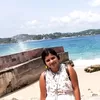
Places To Visit In India

Travel Blogs for Chadar Trek - Trekking In Ladakh - Frozen River Trekking In Ladakh
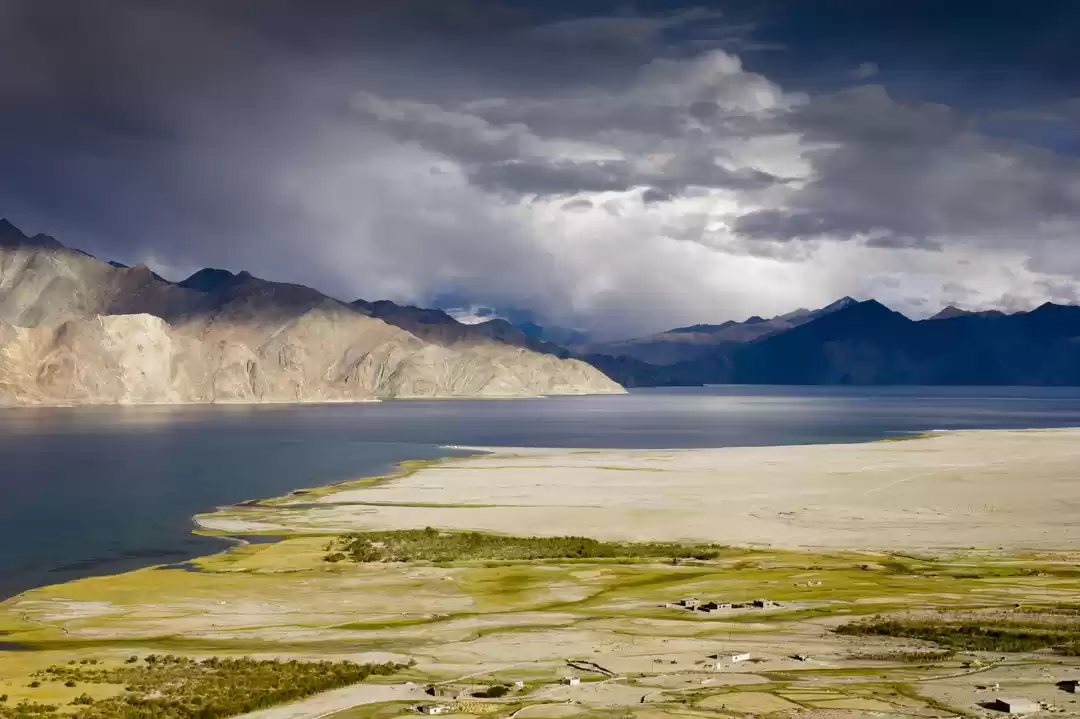

About Chadar Trek in Ladakh – Experience, Guide & FAQs answered
Ladakh , Treks & hikes
Last Updated on: May 29, 2018
The Chadar Trek is undoubtedly one of our favourite Himalayan treks. The first time we heard about Chadar Frozen River Trek in Ladakh, we were intrigued. When I came to know about the conditions in which we have to trek, I was a bit sceptical. Just imagine walking on a frozen river for almost 8 hours a day at an altitude of almost 11,000 feet. And did I mention the temperature? It is always below zero ranging between -5 to -35 degrees. Not inviting at all! I was finally convinced and we successfully completed the trek; but not without a few hiccups. So here we share our experience on Chadar Trek and a few tips to plan Chadar Trek.

Table of Contents
Chadar Frozen River Trek | Chadar Trek
Chadar TrekTrek is considered one of the toughest treks in India. After all, you have to walk over a river, sleep on ice and might even have to wade through knee-deep ice cold water! I will not call it glamorous as many tend to call it; simply because, when Chadar Trek is associated with the word ‘glamorous’, it becomes one that needs to be ticked off the long ‘glamorous’ list. The Chadar Frozen River Trek is an experience, a feeling of wonder. We had done this trek long back in January 2014 – a time when there was not much rush of trekkers at Leh. Chadar Frozen River Trek was our second Himalayan Trek after Roopkund Trek the year before. While Roopkund made us fall in love with trekking, Chadar Trek made us understand the responsibility of being a better trekker or traveller.

What is Chadar Trek?
I always say that Ladakh is a place that never fails to awe its visitors. During the summers, Ladakh is vibrant with all the colours and sound of life. The same place bears a desolate and bleak look during the winter months. It is almost cut off from the rest of the world during this time and almost all the passes connecting Leh are closed due to heavy snowfall. The only way you enter Leh is by flight! Some of the villages become inaccessible during the winters due to snow and one can reach such village by trekking through frozen rivers!!!
The Zanskar River is a wild river gushing through the ravines and treacherous canyons of Ladakh. During the summers, the mighty river flows with all its fervour. But, during the winters, the river freezes and calms down. A blanket of ice forms over the river – thus letting the locals who are trapped in the inaccessible Zanskar villages walk over it and reach towards civilization in case of exigencies. This frozen blanket or “Chadar” (Chadar literally means blanket) is the only way in and out for the Zanskari villagers in winter.
The temperature during this time can be as low as -10 degrees in the morning and -25 to -30 degrees in the evening! A seven to eight days hike in inhospitable conditions over the river would take you from Padum, capital of Zanskar valley to Chilling, near Leh. The Chadar Trek, according to me is not just a trek; it is a symbol of hope and optimism. It signifies the indomitable spirit and courage of the people of the region.
Is Chadar Trek or Chadar Frozen River Trek Difficult?

Chadar Trek, as such, does not have a difficult trail. Yes, I repeat it again – the trail is not difficult , but it is definitely tricky. There are not much ascents and descents as you have in other treks. But, negotiating your way over a thin layer of ice over a fast-flowing blue river is no mean feat. The sub-zero temperature also does not help much. At Chadar, it is a constant fight of willpower to carry on with the trek!
For the trekkers, the Chadar Frozen River trek starts from Chilling, a few kilometres ahead of the Zanskar-Indus Sangam point and leads through the narrow canyons of the Zanskar valley. The trek ends at the Nerak village.
Chadar Trek – an unforgettable experience

Time spent on the Chadar Trek was surely an unforgettable experience. At one time, we were simply awed by the splendour and magnificence of nature. The breathtaking views of golden mountains, frozen waterfalls, hanging icicles the babble of river few inches below our feet simply mesmerized us.
On the other hand, we were also trying hard to cope with the harsh conditions of the terrain. For city folks like us where the temperature in summer goes as high as 40 degrees, trekking at sub-zero temperature is difficult. There were times when we were actually cursing ourselves as to why we are enduring such difficulty!
The first couple of days were really difficult for us. The chilly winds seemed to freeze us to the bones. As long as there was sunshine above us, all was well. As soon as we entered a shadow area, the biting cold returned.
Mornings in Chadar Trek
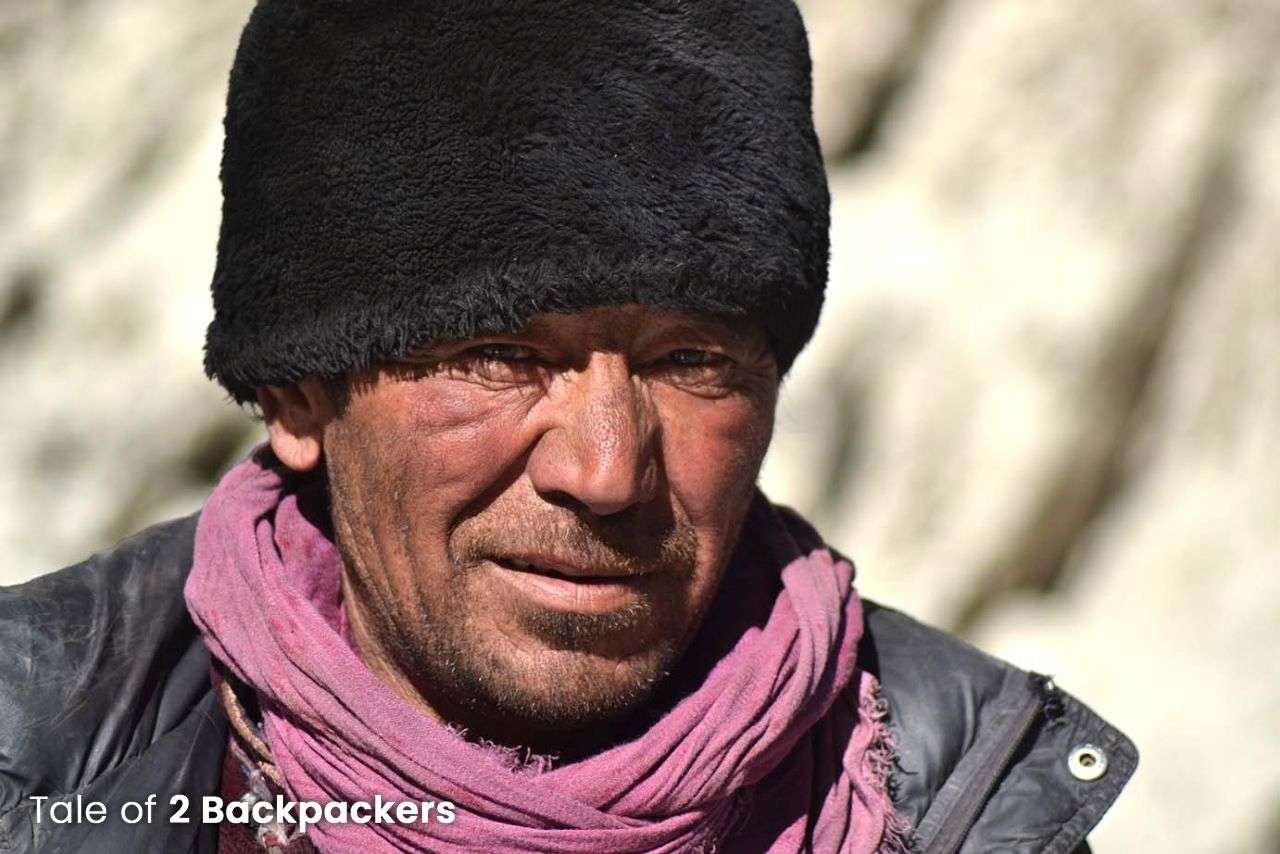
Early morning at the Chadar Trek made us feel that we were inside a refrigerator. At night, we slept inside 2 sleeping bags and covered ourselves fully. I did not cover my nose and mouth while slepping, because I feel nauseated if I do so. When I used to wake up in the morning, I would find ice frozen on my hair and top of my nose. After waking up, my hands and feet used to go numb totally. The only therapy there was to walk and walk fast until our feet responded again. Well, going for daily ablutions was also quite a pain. But this is something that cannot be avoided! So I just used to clench my teeth and go towards the toilet! Phew, it was really some experience.
Gradually, as a couple of days passed, we started getting a hold of the Chadar. We started understanding the place and the terrain. The sound of the flowing rivers underneath our feet sounded like music to our ears. The sound of the flowing river changes according to the thickness of the Chadar or ice blanket. The guides have great knowledge about this and by the sound of the river, they can predict quite accurately whether it is safe to move on that patch of ice. Finally, we also started mastering the technique to walk over the ice. One needs to walk like a penguin-like stance on the ice so as to not slip and fall.
Chadar Trek | Walking over Ice
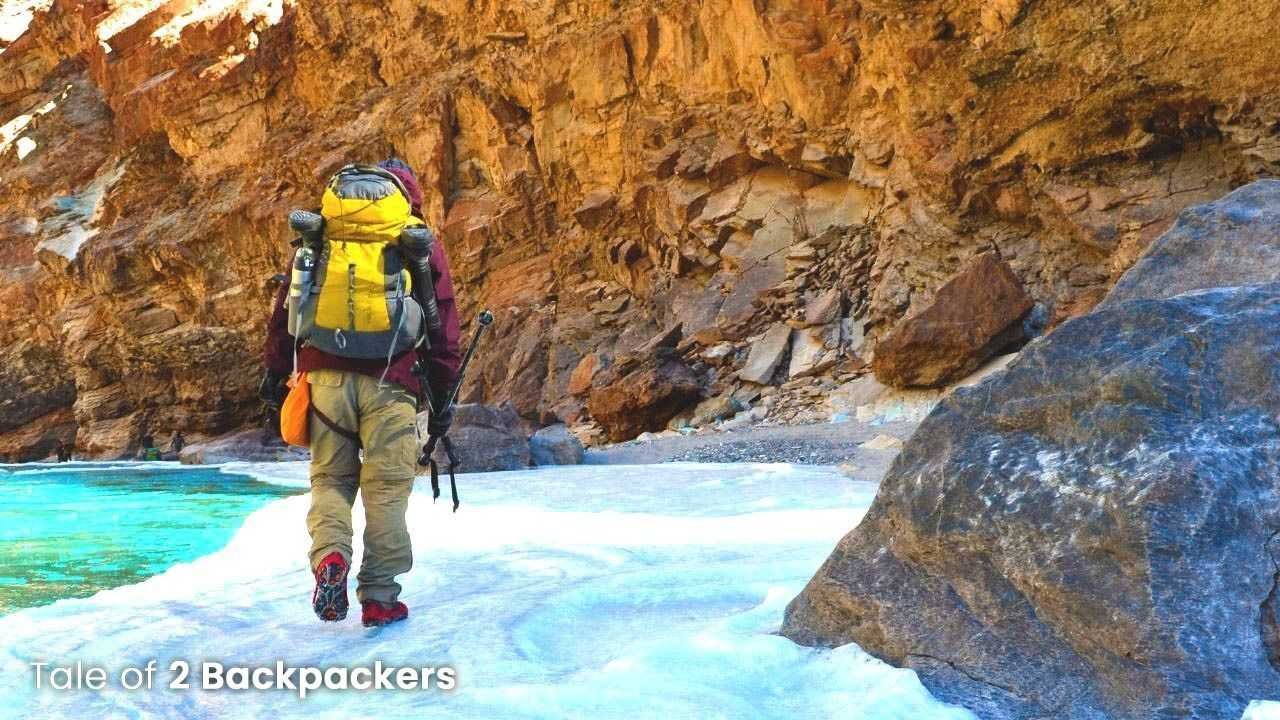
The entire trail path of Chadar Trek might not be uniform. At places, we found fresh snow, while at other places we had to tread on hard ice. Walking on soft snow is relatively easy than walking on hard iceAs I mentioned before, we had to walk slowly in a penguin kind of way. On the first few days, we lost count the number of times we fell down while walking. Gradually, we started walking in the perfect way. Experienced trekkers, as well as the locals, fall down on hard ice. The only thing you do in such situation is to rise again and start walking again with the same zeal and spirit.
You might be given crampons to walk over the ice. It will definitely make your walk easier, but it is not good for the ice blanket. The pressure of the crampons breaks the ice easily.
And at some places, there was no ice blanket at all. It is broken, weak or not formed. The river flowed with all its might!! Here we had only 2 options – either we made our way through the chilling water. Gumboots came handy during this time. Or if the water was quite deep, we had to climb over the mountains to cross the broken Chadar. What an experience it was!
Evening and nights at Chadar Trek was always beside the campfire trying to warm ourselves. We always used to have an early dinner and go off to sleep early. But the campsites below the clear starry skies were a beauty to reckon. Those were some of the best starry skies I had seen.
Chadar Trek campsites
Chadar Trek boasts of some very difficult campsites. The locals usually stay at the caves during the night. If you are going with some trekking agency, you might be provided with tents. Personally, our favourite campsite is the Shingra Koma campsite. It is a big campsite beside a frozen stream. As you walk down the stream exploring, you will encounter a frozen waterfall. The whole place will look as if straight out of some Hollywood movie.
Chadar Frozen River Trek route
Leh is the basecamp of the Chadar Frozen River Trek. Tilat Sumdo is the first campsite for the trek. But once you arrive at Leh, please spend at least 2-3 days for acclimatization. In the winter months, you have to fly into Leh. So acclimatization becomes even more important. Spend these 2-3 days doing nothing. Acclimatization is very very important to prevent AMS.
Chadar Trek starts and ends at the same point. And on the way, we encountered ice sheets, countless frozen waterfalls and all the wonders of nature. The route we followed for the trek:
Leh – Tilat Sumdo – Shingra Koma – Tibb – Nerak – Tibb – Shingra Koma – Tilat Sumdo – Leh
Day 1,2 & 3: Leh (11,400 ft)

After arriving at Leh, we stayed at Leh for 3 days to acclimatize. The first 2 days, we confined ourselves to the hotel and only roamed a little on the streets of Leh. On the third day, we visited the Shanti Stupa in the evening.
This rest for 3 days is required. And I will keep on reiterating this, AMS and acclimatisation throughout this blog.
Day 4: Leh – Tilat Sumdo (10,390 ft)
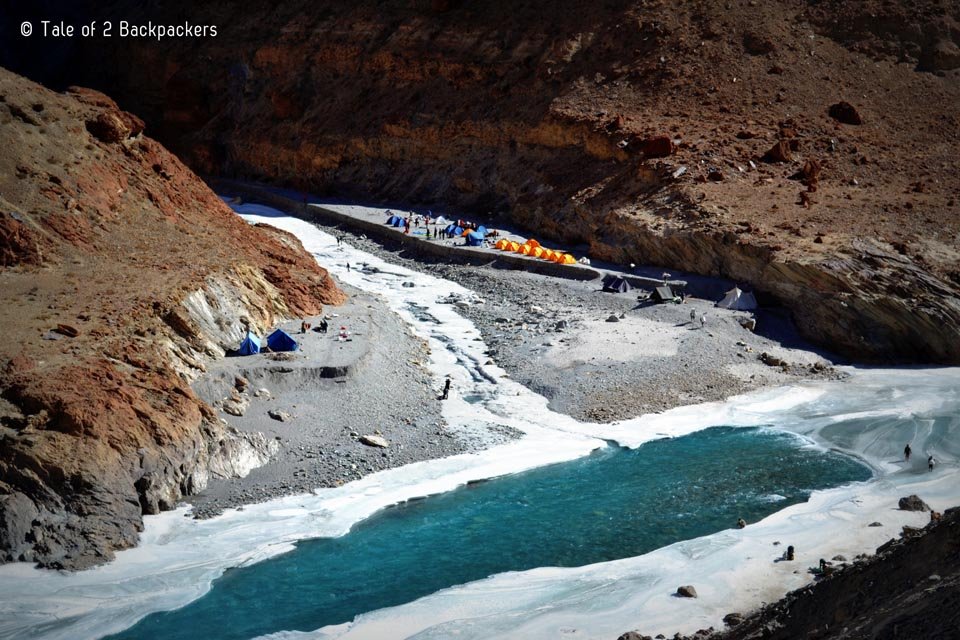
We started from Leh by road and arrived at Chilling. On the way, we stopped at Nimoo, the confluence of the Zanskar and Indus River. The rivers were frozen during this time. It looked so different from the time we had visited earlier during August. From Chilling, we had to climb down to the river bed. The place is known as Tilat Sumdo. It was our campsite for the night.
We reached at Tilat Sumdo in the afternoon. Once we were there, it was the time to get acquainted with our fellow trek mates. Our trek leader briefed us about what lay ahead of us for the next 8-9 days. We also took an acclimatisation walk on the icy river bed. Our trek leader showed us how to walk on thick hard ice. It was difficult for the first time. I kept on falling down. But the others encouraged me to again get up and walk. I guess that day the number of times I fell down in one day exceeded that of my entire life till that day!
After all the fun of walking and falling, our trek leader called it a day early so that we could get a nice rest. “The real fun starts tomorrow”, he grinned at us.
Day 5: Tilat Sumdo – Shingra Koma (10,550 ft, 10 km)

The next day, we started our trek from Tilat Sumdo to Shingra Koma, which is about 10 km away. The walk was not easy. We had to walk in the penguin kind of way. And of course, pay heed to our guides. They know the region the best.
Day 6: Shingra Koma – Tibb (10,760 ft, 14 km)
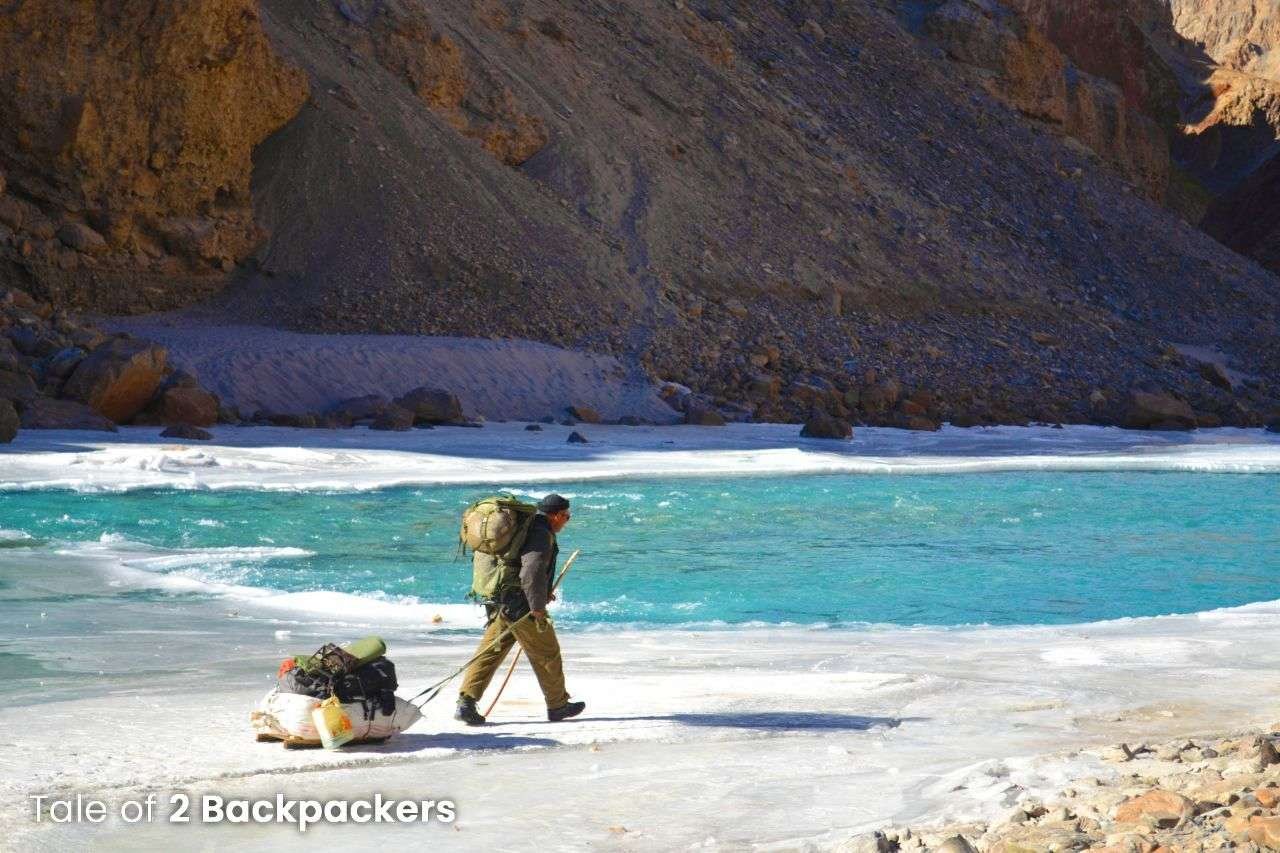
The biggest challenge this day was to wake up early in the morning and get ready for the day’s trek. It was so cold! All my hands and feet were numb. It was actually a great pain to go to the toilet and then get ready for the trek.
It was a long day of the trek and it took us about 6 to 7 hours to reach Tibb. We started by 8 AM and walked over the ice blanket. The sun, as usual, played hide and seek with us. Just as the sun god hid behind the clouds, we could feel the cold. As we trekked, we simply wandered at the splendour of nature all around us. The ochre mountains on both sides looked like canyons and the frozen waterfalls on them left a confound impression on us. It was something that I would never forget. On the way, we even came across the paw marks of snow leopards. Finally, by afternoon we reached our campsite at Tibb. There is a cave there where the locals usually stay for the night. We, however, stayed at tents.
Day 7: Tibb – Nerak (11,150 ft, 12 km) | Which did not happen

Yes, we could not continue our way to Nerak this day, we started as usual after fighting off with the cold. We went along quite a long way when our trek leader stopped us. Apparently, the ice blanket had broken at one of the places and the water was also quite deep. By this time, we already had waded through knee-deep water wearing our gumboots. But here the water was quite deep. After deliberating some time, it was decided that we would climb up the mountain-side and cross the water part.
Well, this was also not an easy task. The mountain trail was gravelly with loose stones and gravels. And it was definitely steep. Just a miscalculation of steps and I would fall deep down in the water. I saw many of my teammates took the trail and went on to the other side. When my turn came, I took the names of all the Gods I remembered. I was scared. Very scared. I did not want to fall down to the water.
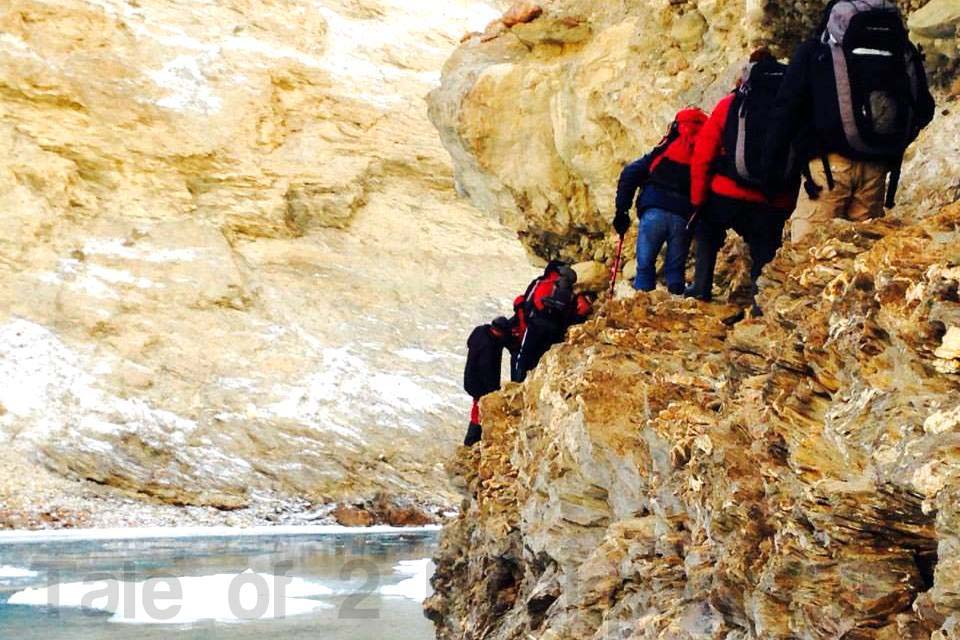
I started slowly treading my way through the trail made for the trekkers. There were tricky parts where Agni and my team leader helped me negotiate. At one moment, I felt that I would simply fall down. But finally I managed to cross the patch. And yes, I was quite happy at the feat. But at the same time, a thought lurked behind my mind. I was now apprehensive about how many such trails we have to cross. Nevertheless, we started again.
After about an hour of trek, we stopped again. This time also, the blanket was broken and the water was too deep to wade through. One of the guides went ahead to see the path ahead. He back with a bad news. He informed us that the path beyond was broken totally. Even if we managed to cross this stretch, we would not be able to do it further.
It was time for a decision. Our team leader decided not to go further and we camped there for the night. It was decided by the guides and our leader that we would wait there for another full day. If the Chadar formed within this time, we would continue. Otherwise, we have to retrace our way. All of us prayed to whichever Gods we believed so that the ice blanket formed again. We did not want to return back after coming so close to the destination.
Day 8: Somewhere in between Tibb and Nerak (The Chadar did not form)
Well, the Chadar did not form even this day. So we used our spare day at the same place. If it did not form the next day, we were to return.
Day 9: To Nerak
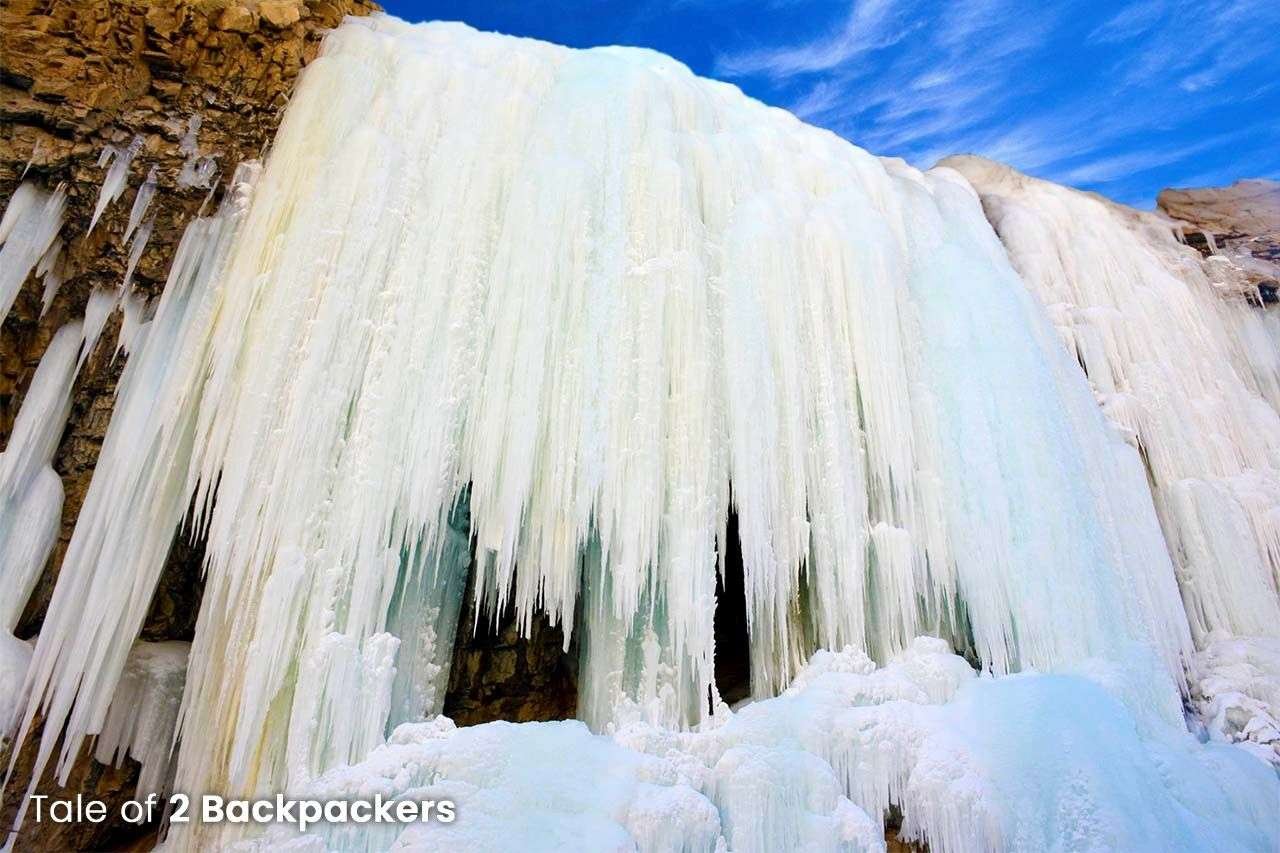
Thankfully, the weather gods took pity on us and listened to our prayers. The ice blanket was formed and we started our trek again. We reached Nerak early. Nerak is known for the huge frozen waterfall. Next to the waterfall is a bridge that takes to Nerak village. We camped at Nerak for the night.
Day 10: Nerak – Tibb
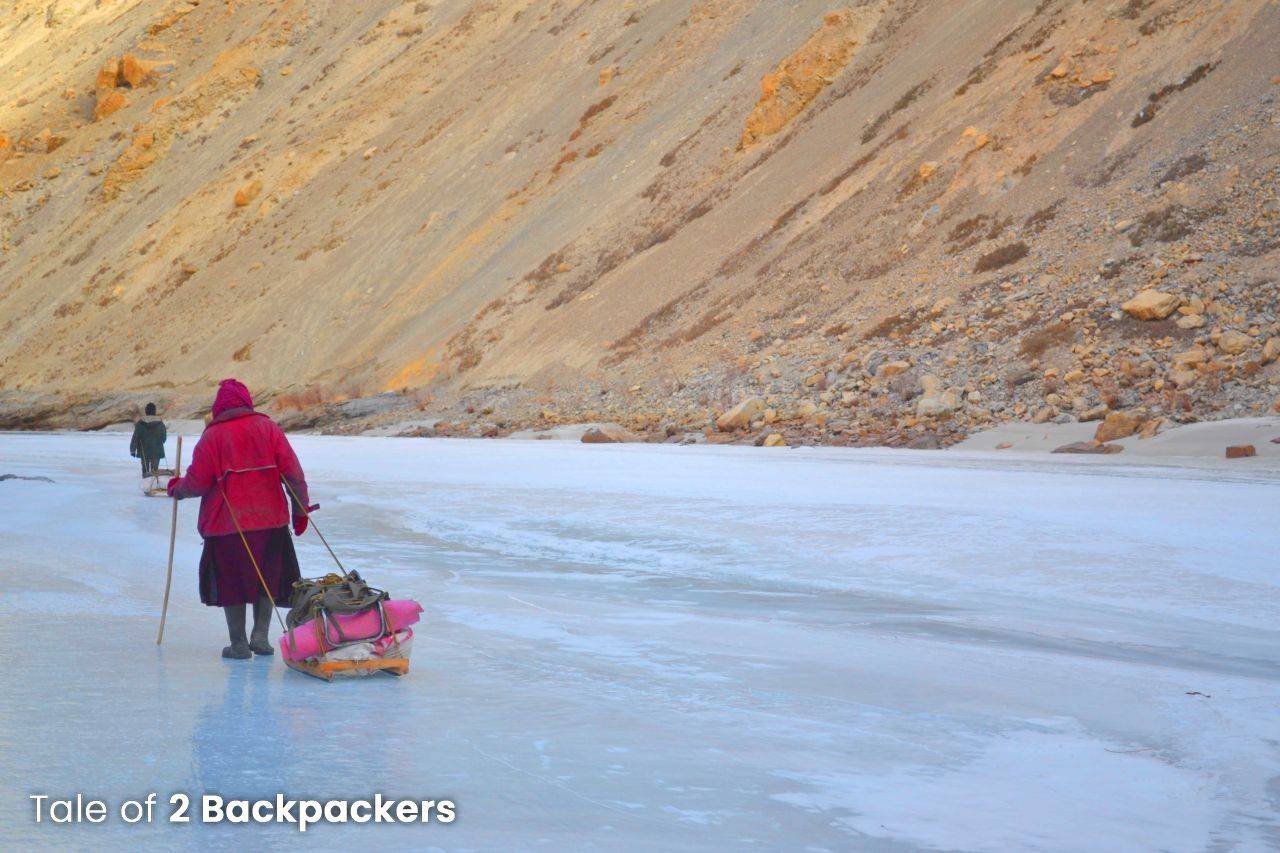
We retraced our steps through the same trail. However, the trail was no longer the same. Well, the mountains were definitely at their place. But the ice blankets, river course changed. It felt as if we were trekking on a different route. That is the beauty of Chadar.
Day 11: Tibb – Shingra Koma
We followed the same way back.
Day 12: Shingra Koma – Tilat Sumdo – Leh
We trekked back to Tilat Sumdo and then returned to Leh by a car.
What is the best time for Chadar Trek?
Chadar trek completely depends on the ice blanket or Chadar formed on the Zanskar River. The best and only time that you can do this trek is between mid-January to mid-February.
Chadar Frozen River Trek | FAQs answered
Is the chadar trek difficult.
Yes, Chadar Trek is definitely a difficult high altitude trek. Physical fitness is absolutely essential for this trek and those suffering from asthma or other chronic diseases should not go for this trek.
What is the experience required for doing the Chadar Frozen River Trek?
You need to have done at least 4-5 Himalayan treks before you decide to do Chadar trek, out of them at least one should be a moderate one. The trekker must also have an experience of trekking more than 2500 m before. The trekking trail is not difficult per se, but the conditions of the trek are quite harsh. We would definitely not recommend first-timers to go for this trek.

When we went for the trek, we had already done 3 high altitude Himalayan treks. But we found that there were a couple of first-time trekkers too in a different group. The trek operators might allow a novice trekker to do Chadar trek for some income, but this is absolutely not the right thing. It is neither good for you and nor for Chadar.
What to pack for Chadar Trek?
Since you will be trekking in sub-zero temperature, clothing is very important. Layering is the mantra at Chadar trek. Wear layers of clothes. We usually wore our thermals inside, then a tee, a fleece and then our windproof jackets. Sometimes, I used to wear t tee-shirts. Here is a list of things that you need to pack for the trek.
- Warm clothes including fleece, heavy jackets and thermals.
- Balaclava and other woollen cap or scarf
- Several pairs of socks
- Good trekking shoes
- Gumboots to wade through the water parts
Other important things to carry for Chadar Trek:
- Trekking Pole
- UV-protected sunglasses
- Water bottles
- Thermal water bottles
- Hot water bags
- Headlamps and torches
- Basic medicine kit and toiletries
- Toilet Paper
How to reach Leh?
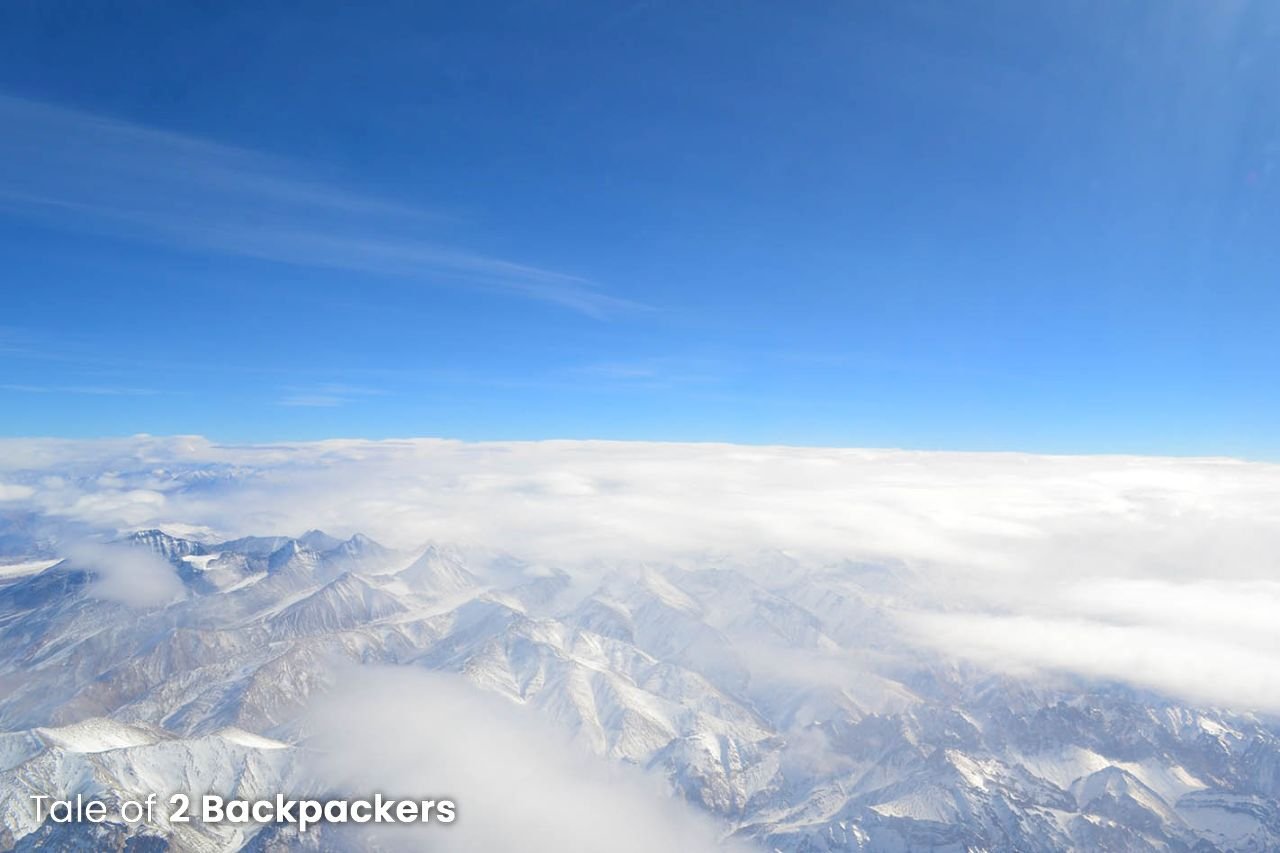
The only way to reach Leh during the winter is by flight. Leh Airport is connected with all the major airports of India. While on the flight, you can see the snow-covered mountain ranges and the Zanskar river from a height.
How will be mobile connectivity in the trek?
You will get BSNL connectivity in Leh. There will be no mobile connectivity during the trek.
How many days are required for the trek?
A total of 8-9 days are required for the trek. You will need 1 day to acclimatize and then another day for the medical checkup at the Government check-up centre. We would always recommend you to spend atleast 2 days for acclimatization to prevent AMS.

What is AMS?
AMS or Acute Mountain Sickness is actually the effect on the body at a higher altitude environment. AMS is quite common in higher altitudes, usually above 8000 ft. the occurrence of AMS depends on the altitude, the rate of ascent and individual susceptibility.
The symptoms of AMS are headache, dizziness, fatigue, shortness of breath, loss of appetite, nausea, disturbed sleep, and a general feeling of malaise. While trekking it is extremely important to look for the symptoms of AMS. And if you feel any of the above discomfort, you should immediately report to someone and see a doctor.
AMS can hit anyone at any time. Severe AMS has even taken life of even fit persons. So acclimatization is very important while you are in Leh, even if you come for a Ladakh trip.
If you experience the symptoms of AMS on your trek, please let others know. Do not ignore them. At such conditions, do not ascend further with the symptoms. Often Diamox is suggested as a preventive to AMS. Please consult with a physician before if you want to take it. Also, remember, Diamox is a preventive and not a curative drug. So you have to take it from before the start of the trek. There is no point in taking Diamox after you have AMS. There can be certain side effects of taking Diamox like frequent urination and tingling sensation in hand.
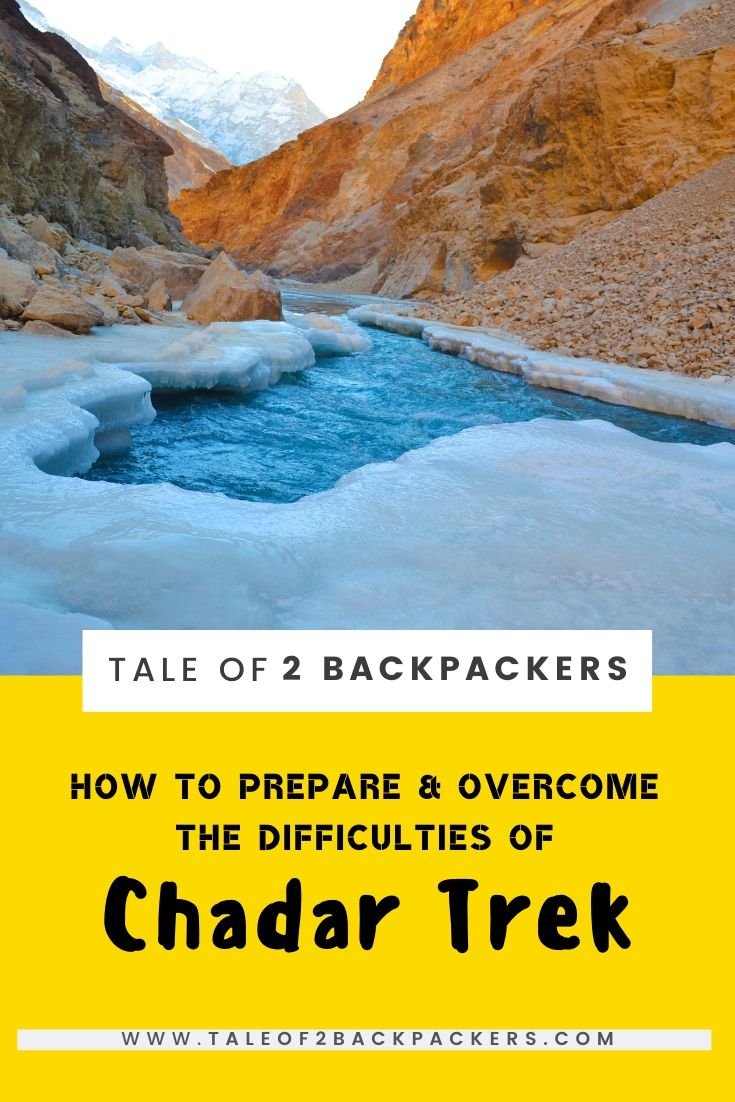
What is acclimatization?
During the peak season, when you can enter Leh by road, you can stop a night at a lower altitude (Kargil is usually suggested as a stop for the night before entering Leh). But during the winter months, you will be coming to Leh directly by flight. Delhi is at an altitude of 709 ft while Leh is 11,480 feet. There is such a gain in altitude within just a couple of hours. The body needs time to adjust to this change in altitude and so it is very important to stay at Leh for at least 2 days doing simply nothing. This process is known as acclimatization.
Responsible trekking at Chadar Trek

By now, you must have understood that the region has an extremely fragile environment and ecosystem.
The frozen Zanskar River offered a lifeline to the Zanskari villages to reach Leh, when snow closes all the land routes. The Chadar trek was their winter lifestyle. But with the popularity of this trek, also came a threat. During the last few years, the number of trekkers in Chadar increased exponentially. It had an adverse effect on the Chadar trail. With more trekkers walking on the ice blankets, it is creating a pressure on them and the blankets are broken.
Also the trekkers, guides and porters think little before littering the ice with garbage. Defecation also creates a problem in the higher altitudes. The normal decomposition process is already slower in the high altitudes. So it is not rocket science to understand that with so many trekkers, the toilet pits will become the breeding grounds of bacteria, which would ultimately contaminate the soil and water. Because of this irresponsible human activity leading to plastic waste, human waste and other harmful wastes, we heard that the Chadar trek is going to be banned in the future. While we do not agree that banning can be a solution to these problems, but we definitely urge all the trekkers to be more sensitive and understanding of the local and ecological issues.
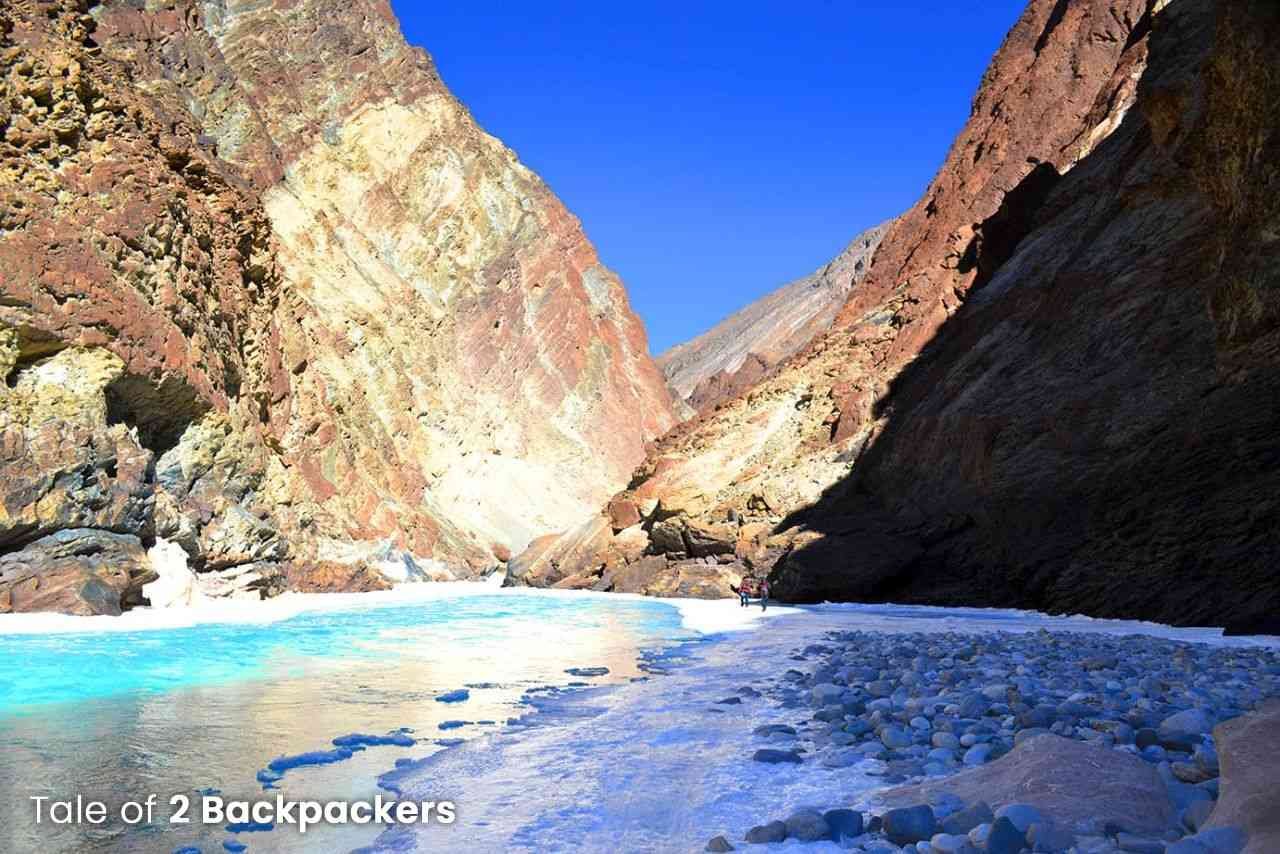
Some Tips to help you with Chadar Trek
- Acclimatise. Acclimatise. Acclimatise. This is the first tip that we would give you. Yes, we are repeating it every now and then, but this is most important. Spend at least 2-3 days in Leh doing nothing to get yourself acclimatized.
- Carry sufficient warm clothes as the temperature can be really harsh. And keep extra socks. They can be really helpful.
- Keep your backpack light and pack well. You would not like to get burdened with a heavy backpack on your trek!
- Drink water at regular intervals.
- Do not skip your meals.
- Absolutely refrain from alcohol and smoking. Not even a swig of brandy for tackling the cold. It will do more harm.
- Listen to your guide. Do not challenge them. They know the area much better. So follow their words religiously.
- Do not carry plastic items and please do not litter the trail.
- Do not use soap and shampoos in the waterfalls (if it is not frozen) and the open water sources. The locals use this water as their drinking water.
- For relieving yourself, please go to the designated area for the toilet.
- Keep buffer days while planning your trek. You never know when you get stuck in the trail.
- Avoid wearing crampons or microspikes. It is not good for the ice blanket. Initially, you will find it difficult to walk on ice, but you will definitely get a hold of it soon. You might fall down, but let that not deter you from walking.
- Be careful with your camera and other equipment. A guy in our group slipped while taking photographs and his camera fell in the river and was carried away!
Finally, enjoy and appreciate Chadar Trek with all its challenges. And while you do that, respect the nature, the landscape and the locals. While you definitely get the bragging rights of completing the Chadar Trek, but that should not deter you from doing your bit and being responsible.
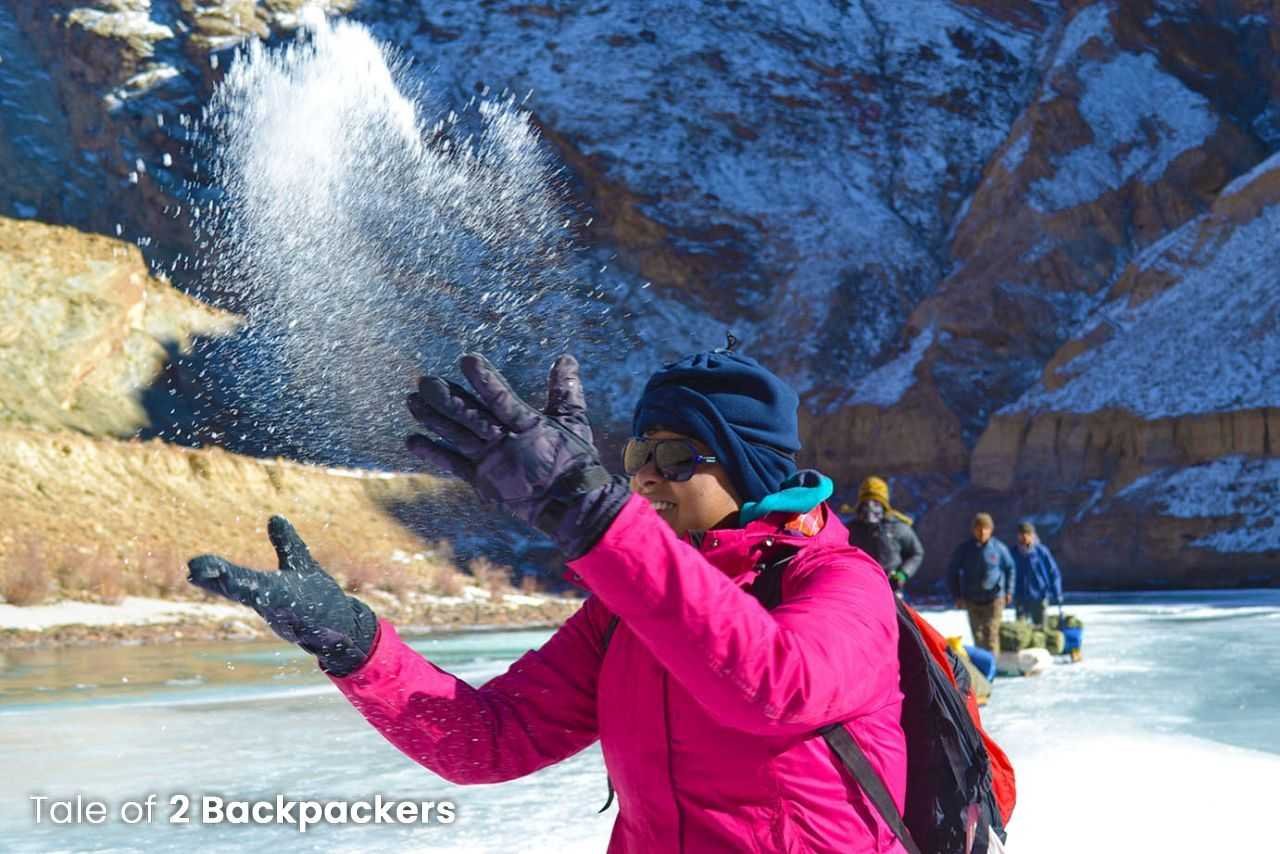
Chadar Trek was a changing point in a number of ways for me. The first thing that I realized on the trek was that we take nature around us so casually. We all are responsible in some ways or the other for environmental issues, either by using plastics or by our lifestyle or by some other reason. We might not be able to rectify all, but we can do whatever there is in our hands. Chadar Trek made me realize the importance of a responsible traveller, a responsible human being.
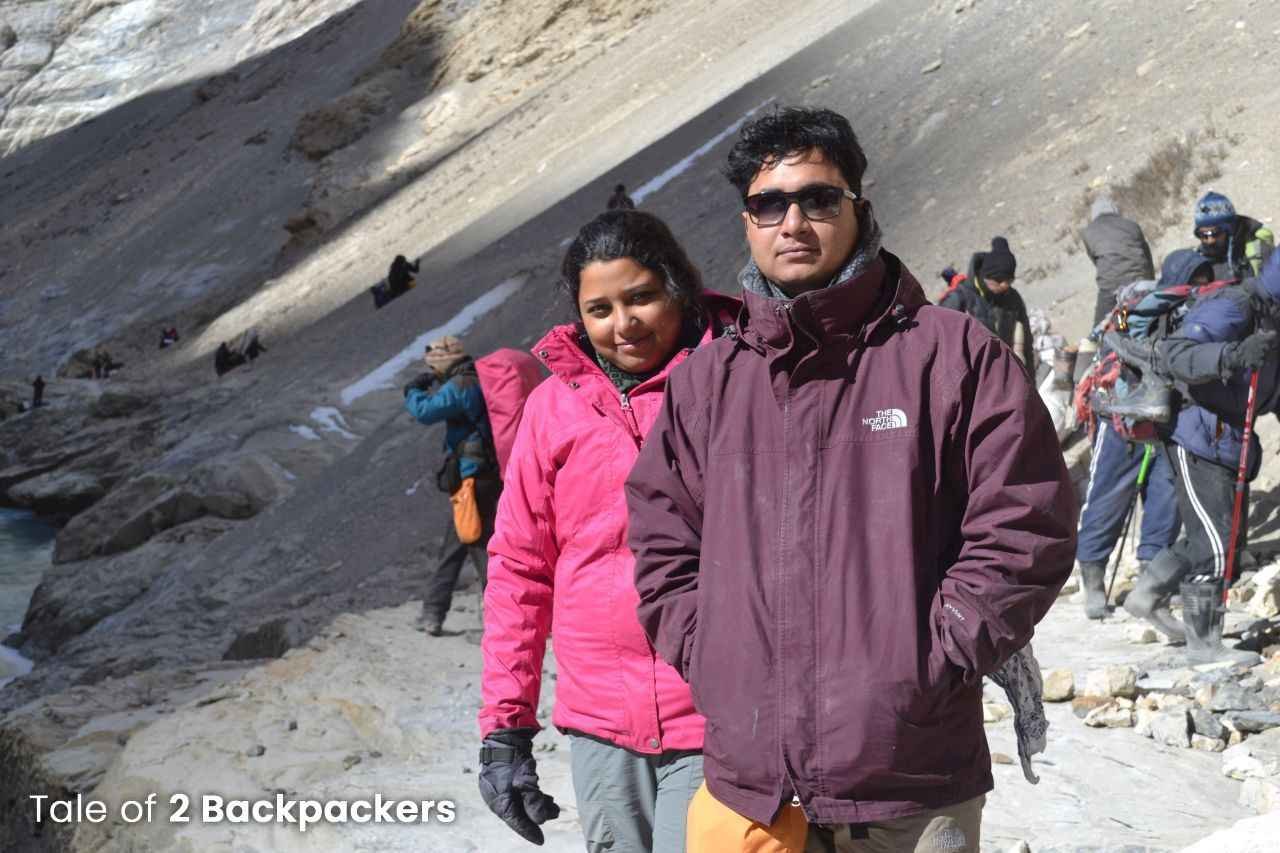
Chadar brought out the best and worst in me. In such harsh conditions, I found out my worst qualities as well as realized what I am capable of.
And the most important lesson that Chadar trek taught me is that everything in the world is ephemeral. Nothing lasts forever. Just as the Chadar is dynamic, changing its shape and course all the time, life too is not meant to be lived confined. Challenges are a part of life and are meant to be met with a smile on face and determination in the heart.
Have you done the Chadar Trek? How was your experience? Let us know in comments below. If you want to know anything else about the trek, please ask in comments below or send us a mail.
Pin this for a later read!
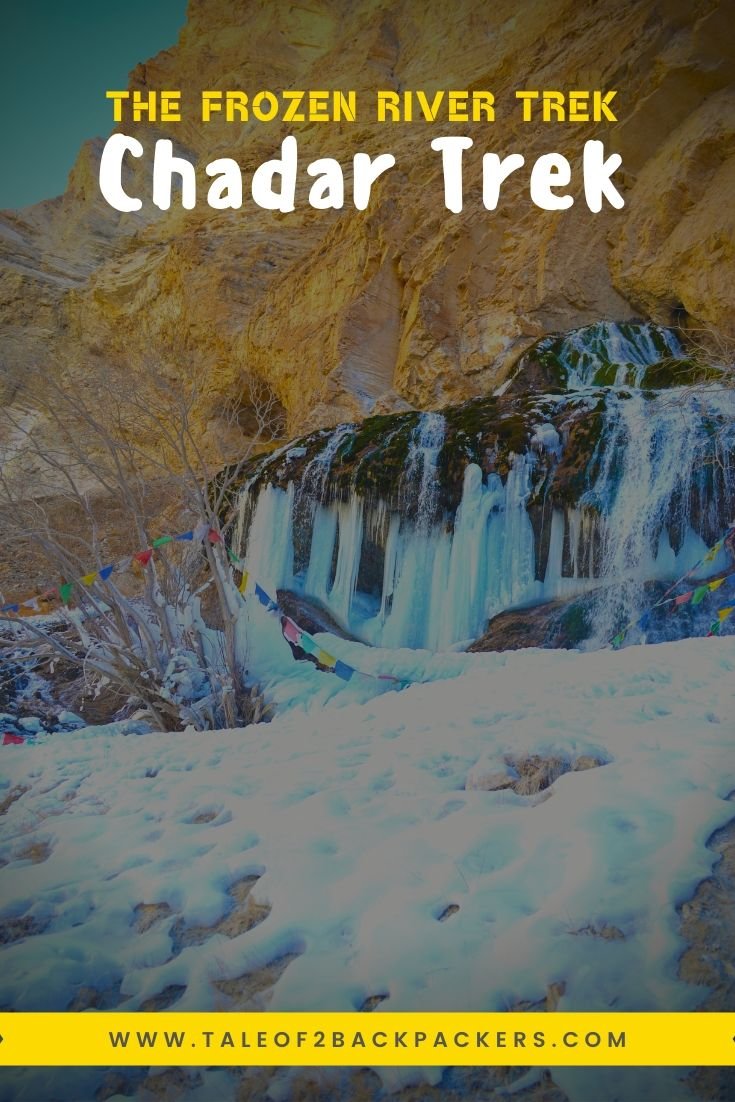
Reproduction of the content, including the photographs without prior consent/permission of the writer and photographer, is not encouraged at all and a violation of the same will attract legal action. If you need anything, Contact Us .

Hey! we’re Agni & Amrita.
We have been travelling together since the last 15 years and writing independent and personal travel content since 2014. Travel is one of the best teachers and through this blog, we aim to share our experiences and travel tips. We encourage you to travel more and see the world through your eyes and not through filtered templates.
Find more about us.
RELATED POSTS
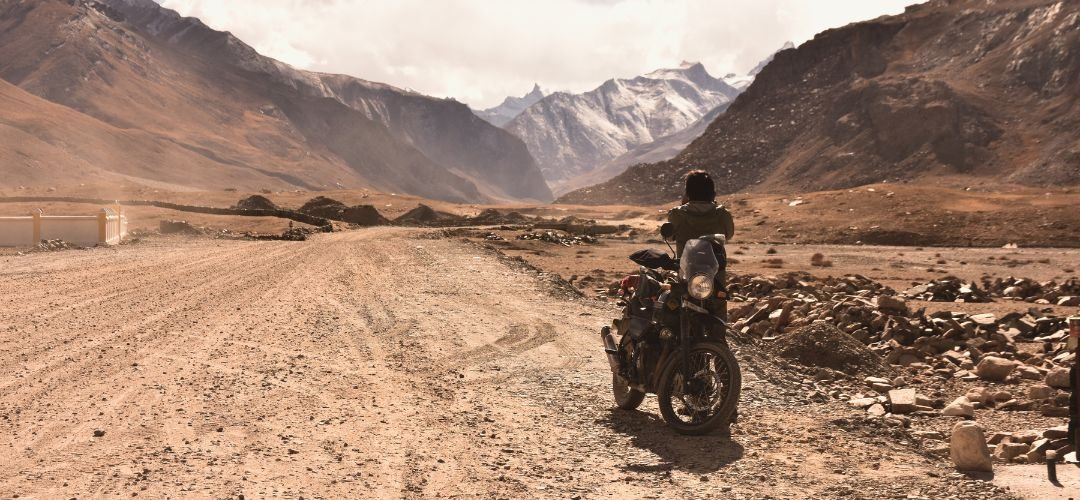
Best Zanskar Itinerary – How to Visit Zanskar Valley in 8 days
About this blog: Zanskar Valley is fast becoming one of the most sought-after destinations for adventure seekers. Nestled in one of the remote corners of the Himalayas, Zanskar valley is one of the most difficult places to reach. After our trip to Zanskar Valley, we...
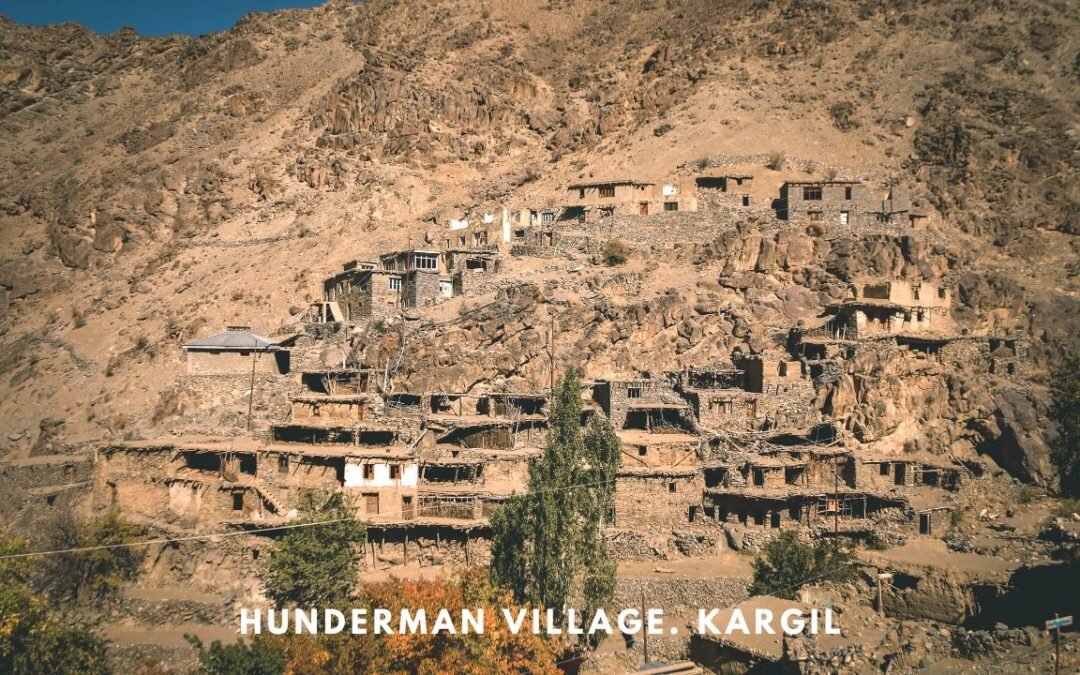
Hunderman – Ghost Village near Kargil with Museum of Memories
About this Blog: A few days back, we had visited Kargil and from there explored Hunderman, a lesser-known destination. Hunderman is a small village located near the India-Pakistan border. Very recently it has started attracting tourists. The village is also the home...
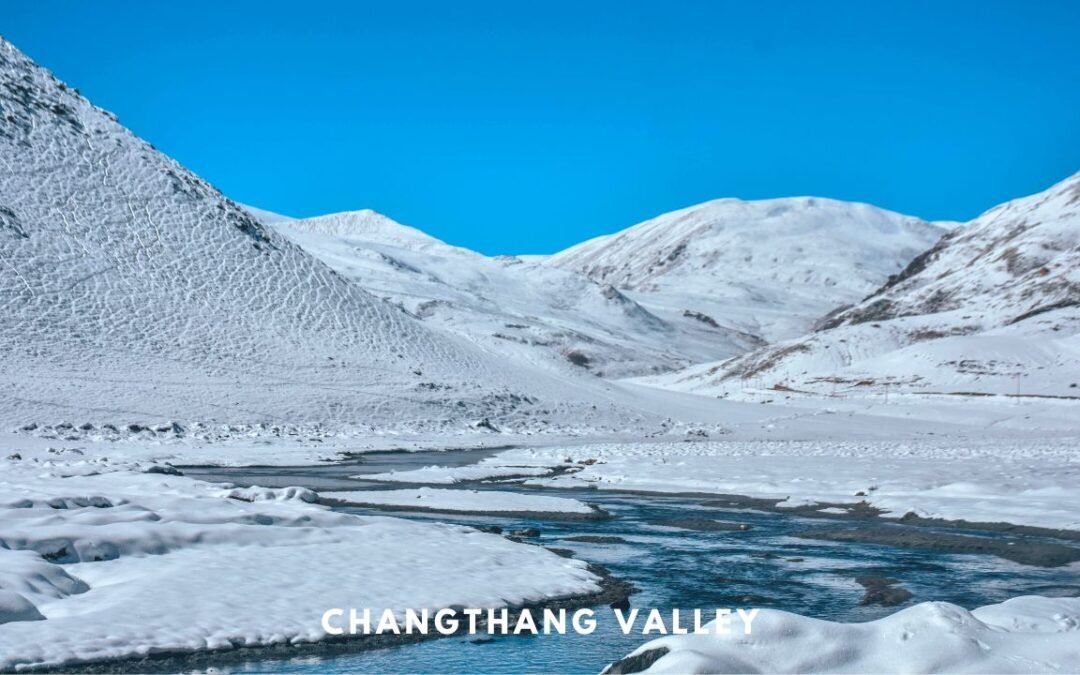
A Trip to Changthang Valley in Ladakh and a Failed one to Tso Moriri
About the Blog: In our last blog, we had written about the Changpas, the semi-nomadic tribe living in the stark and cold Changthang region of Ladakh. We met with them while on our way towards Tso Moriri Lake. We were actually unable to complete our trip because of...
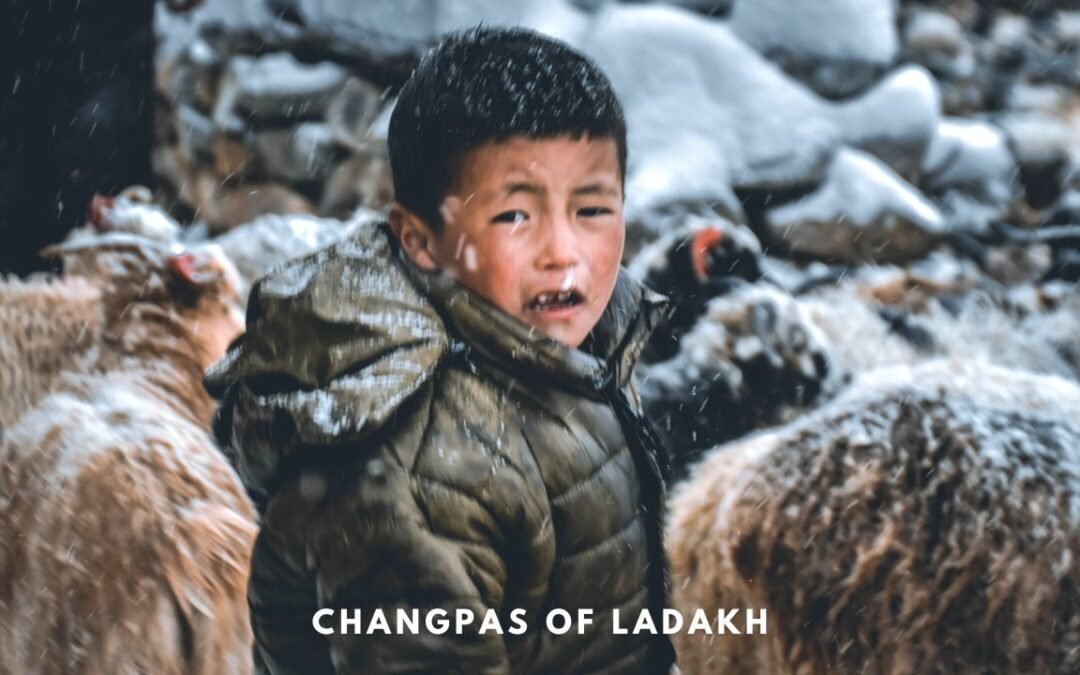
Changpa Tribe of Changthang, Ladakh – The Story of Pashminas
About this Blog: The Changpa tribe is a semi-nomadic tribe found in the high altitude Changthang region of eastern Ladakh. They are known for rearing the Changthangi Goats or the Pashmina goats that yeild the fine wool to produce the exquisite fabric Pashmina. In our...

Sham Valley in Ladakh – A Complete Travel Guide
About this Blog: Sham valley is another beautiful valley of Ladakh. Located near Leh town, Sham valley is a popular sightseeing destination from Leh. Read this travel blog to know about it, attractions and places to visit in Sham Valley and other relevant information....

Basgo Monastery, Ladakh – Ruins of Palace and Fort
About the blog: Basgo Monastery is a beautiful and important place to visit in Ladakh. Located about 40 km from Leh town on the Srinagar-Leh Highway, you can see the ruins of Basgo Gompa and fort from a distance. Basgo has an interesting history and was once the...
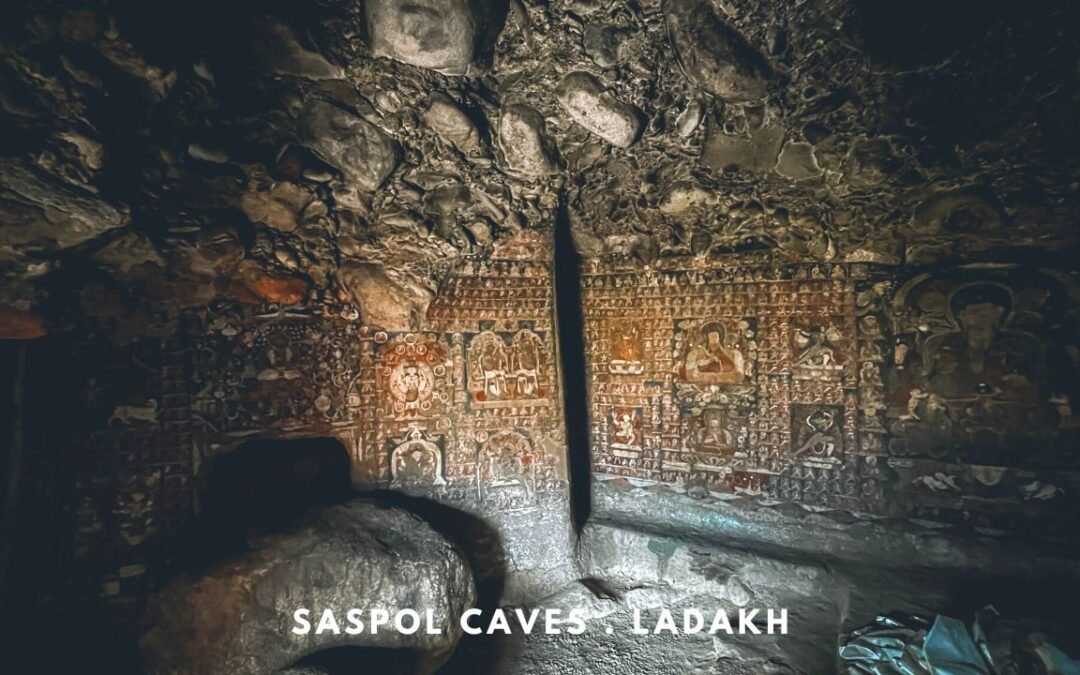
Saspol Caves – Best-kept Secret of Sham Valley, Ladakh
About the blog: Saspol Caves are one of the finest examples of Buddhist art found in Sham Valley of Ladakh region. Located in Saspol village about 60 km from Leh, the Saspol Cave temples contain beautiful and vibrant wall paintings. We had visited Saspol Cave in our...

Mangyu Monastery – A Hidden Gem in Sham Valley, Ladakh
About this blog: Mangyu Monastery is one of the oldest monasteries in Ladakh. Located in Sham Valley, the Gompa belongs to the early period monasteries built between 1000 – 1300 AD. We visited Mangyu Gompa on our last trip to Ladakh. This travel blog shares our...
28 Comments
Your pictures bring your experience alive. Have heard so much about Chadar and after seeing your post, want to head there now.
Thanks Ami… Chadar is definitely an experience…
I really enjoy to read your Chadar Trek diary, it also encouraging me to do this trek in the future.
Thank you so much. Glad that we could inspire you!
I love reading your final thoughts after the trek that everything in the world doesn’t last forever and I totally agree with you. Thats why we should appericate everything we have and try not to ruin it. Also I would love to do this trek, it looks amazing (and a bit cold). 🙂 I would seriously consider doing is trek if I was in the Leh area, it is on the plans but I havent chosen which hiking trails I would like to do. My time will come.
Thank you Danik. It was really cold there. 🙂
This adventure looks so cold! And amazing! I haven’t done a trekking adventure yet and I’m not sure it is on my bucket list. I am more into long distance cycling!
Yes, it was cold! But was also beautiful.
What a great post! I admire your strength for being able to do this trek! As a Canadian, I understand how cold those temperatures can feel and cannot even imagine trekking and sleeping outside in those conditions. I’m very impressed! Nerak looks so beautiful and would be the place I would be most excited to visit. I also appreciate that you pointed gave tips on how to be a responsible traveller and not abuse the natural landscape!
Thank you Erica.
I can not even imagine walking on a frozen lake for 8 hours. AND it isn’t completely frozen. Isn’t there some rule about it needing to be completely frozen to a certain depth before walking on it? And having ice frozen on your nose when you wake up cannot be healthy. I obviously have anxiety issues, I would have been scared too. All that being said, it is beautiful. And you didn’t die. And this is a huge accomplishment!!!
I can totally understand your anxiety. I too was scared before going for the trek. But it went on well and we were back all hale and hearty.Yes there are rules about walking on frozen rivers. The guides look after that.
I am enjoying reading all about your hikes in the Himalayan Mountains. I may never get to do these myself. So it is interesting to read about ones like the Chadar Trek. Even as a Canadian I am a winter wimp. So walking on a frozen river at such cold temperatures would not be my kind of thing. Although I can see why the beauty would drive you to want to visit. What an adventure you had!
Thanks Linda. I am also not particularly fond of very cold. But Chadar trek experience was totally out of the world.
Amrita, I am overwhelmed with admiration for your perseverance, fortitude, and endurance! I was near tears just reading about your Chadar Trek experience in Ladakh and the many challenges you faced. I cannot imagine waking up with ice on my face and hair and slogging through frigid water, let alone navigating the mountain ledges. You must feel so accomplished and now have yet another amazing experience in your memory to draw should you ever face difficult times. (If you can do this, I believe you can do anything.) I am in awe of you.
I would love to have seen snow leopard tracks and that beautiful frozen waterful first hand. While you provided really important tips for anyone attempting this trek, I am grateful to have seen both wonders–along with many other natural beauties–through your eyes.
Thank you so much Jackie for your words. This means a lot to me as I am one of your admirers. Thanks again.
The thought of walking on a frozen river at almost 11,000ft for about 8 hours a day would intimidate me too! After reading your post I believe you that the Chadar Frozen River Trek is the most challenging in India. I bet you feel so accomplished now! I love reading about difficult hikes like this, but they are not for me! Waking up with ice on my nose, no thanks….lol.
Thank you Elizabeth. Yes, Chadar Trek is one of the most challenging treks in India. I would not say the most challenging!
Just reading the first para about the altitude and temperature and time, it already sounds exhausting. So, super congratulations for completing the trek inspite of these harsh realities!!! You’ve been to Roopkund already? Whoa! Hats off to you!!!! //Ice frozen on the hair on my nose// – What???? OMG! That’s brrrrrrrrrrrrrrrr cold! I have never walked on thin ice or frozen river so far, and I can’t imagine how would it be to do it all day long for days together! The frozen waterfalls of Nerak looks so so so splendid!
Haha! I liked the way you described the experience about ice on hair and nose! Chadar Trek is a really an experience.
Wow that trek looks very intense. I love hiking and have done many multi day treks but nothing like that. I am not a fan of the cold and I can’t imagine hiking in those temperatures!! Your pictures though are amazing and it is certainly a challenge I could be tempted to do one day!!
Thank you Clare. The trek was a test to my perseverance and will power!
Fantastic post. Your narration was so beautiful. Do we have a satellite phone facility during the trek?
Thank you so much. Glad that you liked the article. Yes, there will be satellite phones with your trek leaders.
I am planning to do the trek in Jan 2022 and just happened to check your post today. Ideally, how many months should one book this trek in advance ? it is just the beginning of winter so would it be fine to book now or one should wait for some more time and then go ahead based on the winter conditions on leh. what do you suggest ?
Assuming that you are trek fit, you can book the trek even 15 days before. But please be sure of your fitness and learn about winter conditions in Ladakh if you plan to do this trek. email us if you have any more queries. Thanks and have a great trekking experience.
Really loved your honest and fantastic narration of the Chader trek. I have been waiting to do this since a couple of years and I am finally planning to do this in Jan 2024. I will be traveling solo, and wanted to ask you about any good trekking group which cater for women trekkers as well, cause there are so many, and it’s difficult to understand which ones are actually good. Many thanks for this lovely post I really enjoyed reading it.
Thank you so much! We are so glad that you are doing the Chadar Trek. It is a lifetime experience for sure. You can do the trek from any reputed trekking companies in India. We did it with Indiahikes. Thanks again.
Trackbacks/Pingbacks
- Trek every month and make the most out of your holidays - Part 1 - […] the Chadar Trek seems difficult, but it is definitely manageable. The trek itself is not very arduous, but the […]
Submit a Comment Cancel reply
Your email address will not be published. Required fields are marked *
Save my name, email, and website in this browser for the next time I comment.
Submit Comment
This site uses Akismet to reduce spam. Learn how your comment data is processed .
- Group Enquiry? NEW
- A Complete Guide to Chadar Trek
- Jammu And Kashmir
Guide to Chadar Trek, one of the most adventurous and thrilling treks in the world, offers the best chance to explore a whole new world in the Zanskar Valley. This Guide will help the trekkers to beat all the challenges while trekking through the frozen Zanskar River, unfolding the mystery of the Himalayas.Embark on this unforgettable adventure as part of your Leh Ladakh holiday packages .
The lower sections of this gorge are extremely popular in summers with tourists trooping in for river rafting expeditions. In winters the Zanskar River freezes and trekking enthusiasts flock to this region to enjoy hiking expeditions.
During the winters, the road to Zanskar Valley is closed due to snowfall and this makes the frozen river the only way to access the valley. The trek across the frozen river is called the ‘Chadar’ (ice sheet) trek and it holds many surprises and scenes of breathtaking beauty, which attracts tourists and trekkers from all over the country and the world.
Quick Navigation
What is chadar trek.
The Zanskar River freezes in the winters. The entire river looks like a sheet of ice and hence is referred to, in the local language, as Chadar. From a tourism point of view, this trek has been popularized as the frozen river expedition and draws in several amateur and professional trekkers from different parts of the country and the world.
Chadar trek in the beautiful landscape of Ladakh is one of the most adventurous and most difficult treks in the country. The distance that is covered on foot is approximately 105 km and on an average, a trekker covers 15 to 17 km every day. The temperatures are usually 15 to 20 degrees during the day time and plummet to -25 to -35 degrees during the night in this region.
As per the chadar trek guide, while most of the trek is completed by walking, trekkers may even have to climb icy rocks and boulders during the journey. During the journey, the trekkers will walk on the sheet of ice to cover the distance and will rest in caves during the night time.
Due to the extremely cold conditions that a person has to face during this expedition, it is advisable that every aspirant fully understands the conditions that he will face ahead and prepare accordingly. A person should be acquainted with walking long distances and be prepared for tough camping situations. It is advisable that every trekker carries warm clothes, a sleeping bag and sturdy shoes for the trek.
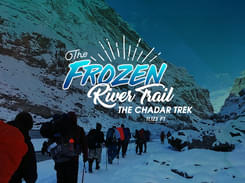
Best Offers on Himalayan Treks: Enquire Now
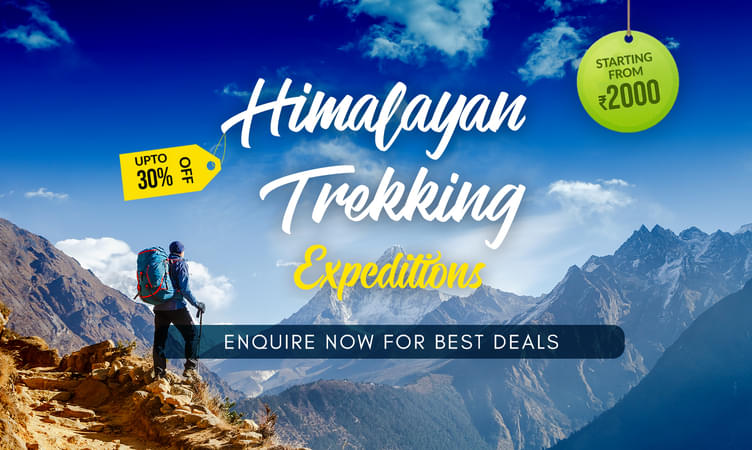
Why Chadar Trek?
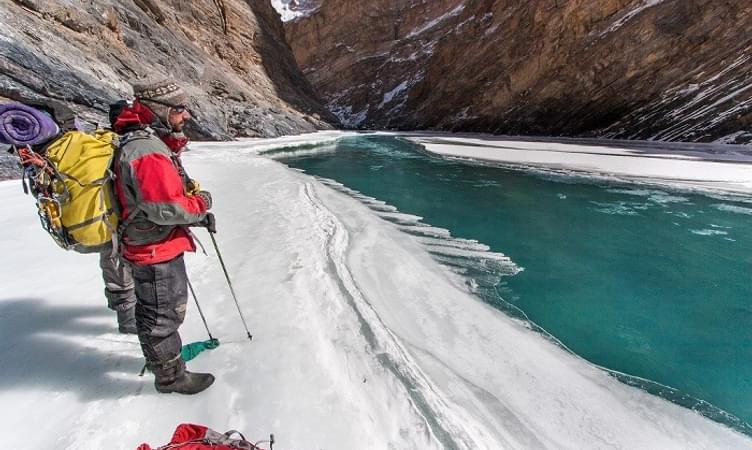
For adventure enthusiasts, trekking is not just an expedition. Trekking is a mode to relieve oneself of the worries of day to day life, revive the spirit of adventure and excitement by undertaking tough challenges and winning them. This trek is not just any other trekking experience.
Trekkers have to face the toughest of challenges, tread through chilly weather and landscape and sleep in caves during this expedition. According to the chadar trek guide, this trek holds the secrets of the beautiful Himalayas and enables a person to enjoy the mesmeric beauty of the snow-clad mountains and beautiful city of Leh.
For every person who seeks adventure and is ready to face the harshest conditions and take up the most challenging tasks, this Guide to Chadar Trek is a must. The excitement of walking on ice and climbing on icy rocks is unbeatable and matchless. This trek is an absolute must-do for those who have a flair for high altitude trekking and taking on challenges as they come in life.
When is the Best Time?
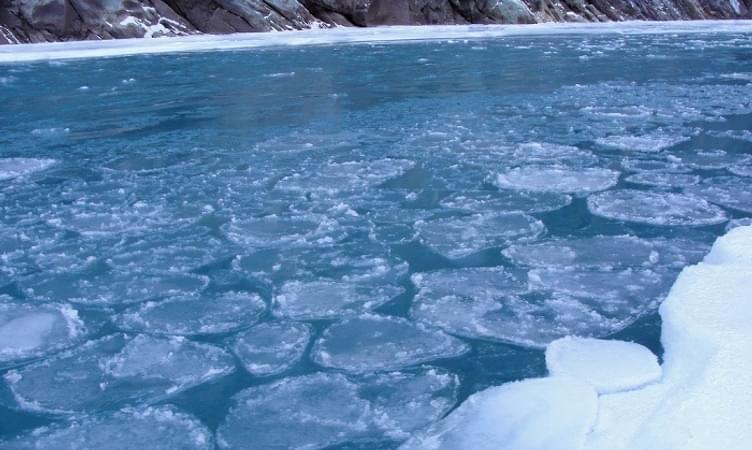
The best time to take the trek is in January and February. Precisely, from January 15 to the end of February is just the right time to set out on this wonderful and adventurous trek. The river freezes into a beautiful sheet of ice and the surroundings are clad in snow presenting a pristine white trail for hiking expeditions.
The snow clad mountain peaks that will accompany you all along your way to your destination glisten and gleam in the morning rays of the Sun. This is a breathtaking view to watch and the trek is incomplete without being able to enjoy such mesmeric beauty.
The beauty of the landscape is the most rewarding part of the trek. Although the trek itself is quite arduous and tasking, the beauty that opens up before the trekkers compensates for the all the trouble and effort put in.
The frozen river trek is the most rewarding trekking trails in the country and will test your physical stamina and mental focus before opening up its secrets to you. Although the summers attract a large number of water sports enthusiasts from all over the country, this trek in the winters still remains the most popular activity in Leh.
How Difficult is Chadar Trek?

As per the Chadar trek guide, this trek is one of the most difficult and challenging treks in the country . The Zanskar River freezes into a sheet of ice and is the only route to access the Zanskar Valley during the winters. All mountain passes are shut down due to snowfall, leaving the Chadar or the frozen Zanskar River as the only route for passage.
The ideal or best time for this trek is in the months of January and February as the swift river is harnessed in the bounds of blocks of ice and the surroundings are all covered in the pristine white beauty of snow. The temperatures are incredibly low during the day time and plummet to uncomfortably freezing temperatures during the night time. Trekkers who want to explore the Zanskar trek must be prepared for facing unsettling temperatures and harsh camping conditions. The total distance covered in the trek is around 105 km, most of which is covered on foot. There might also be instances wherein the trekkers are required to climb icy rocks and boulders. The nights are spent in caves near the frozen river and hence all participants should come prepared with the warmest jackets, sleeping bags and sturdy shoes. The camping conditions, unlike in other trekking expeditions, are extremely tough and hence each participant should be mentally and physically prepared for the challenges ahead.
How Cold Does it Get?
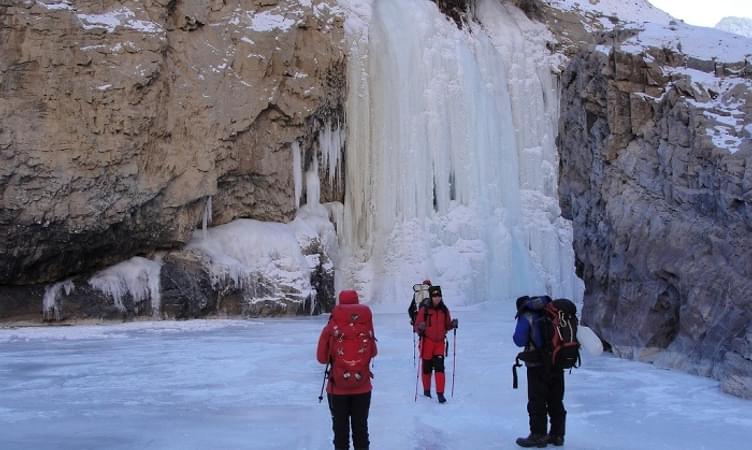
The Chadar trek expedition is conducted in the winters. The best time to set out on this expedition is in January and February. The swift and steady River Zanskar lies harnessed in bindings of ice and everything around is covered in pristine white snow.
The temperatures are amazingly low during the day time and hover between 15 to 20 degrees while they plummet further to -25 to -35 degrees during the night time. The climatic conditions of this region are quite harsh and extremely cold. So for any visitor who wishes to explore the Zanskar trek, it is extremely important that he is physically and mentally prepared for the trek
The total distance covered during the trek is around 105 km and most of it is covered by walking through these extreme conditions. You may also be required to climb icy rocks and boulders during the journey which makes it extremely essential for you to be physically and mentally fit.
The journey is arduous and tasking, especially because of the extremely cold temperatures. Furthermore, while during the day time you will have to walk over the chilly sheet of ice or the frozen Zanskar River, during the night time, you will have to sleep in caves near the frozen river.
How Long Do We Walk Each Day During the Trek?

The total distance covered along the trek is 105 km. Trekkers will be required to walk around 15 to 17 km a day to complete the trek. The trail is along the frozen River Zanskar which lies harnessed and bound in its icy bindings and the snow-clad surroundings are a treat to watch.
The most rewarding aspect of this tough and challenging trek is that it rewards everyone with the secrets hidden in the snow-covered slopes of the Himalayas and opens up a vista of breathtaking Himalayan beauty to its visitors. During this guide to the Chadar trek, you will be required to walk along the length of the frozen River Zanskar and also, at times, climb icy rocks and boulders.
The temperatures are unsettlingly low and every aspirant must be physically and mentally prepared for the tough camping conditions. The Chadar is the only connecting route during winters into the Zanskar Valley and the Ladakhis and Zanskaris use this route twice a year. The climatic conditions may not be exactly favorable but the adventure and challenges that the trek has in store for the adventurous make it one of the most popular high altitude trekking trails in the country.
Most of the journey is covered on foot by walking on the pristine white solid sheet of ice and a little bit of climbing and maneuvering. The nights are spent in chilly caves near the frozen river, which makes it mandatory for every trekker to carry along the warmest of jackets, sleeping bags, and sturdy yet warm shoes.
Trek Itinerary

The journey begins at New Delhi from where participants interested in the Chadar Trek will be transported to Leh. This is followed by a visit to nearby monasteries or any local festivals that are happening at the time.
On the third day you will be taken on a full day tour of Phyang, Liker and Alchi for sightseeing.
On day four, you will proceed from Leh to Chilling to Zaribago and cover the distance over five hours of trekking. You will spend the night in a camp at Zaribago and proceed for the next destination in the morning. On the fifth day, you will move from Zaribago to Deepyokma which is a four hour trek on foot.
The evening is spent in Deepyokma and the next morning i.e. on the sixth day you will trek to Nyrakpulu. This distance is covered in four or five hours of trekking. The next morning you will trek for one hour from Nyrakpulu to Lingshed. You will spend the eight day in Linghshed relaxing, sightseeing and preparing for the next day’s trip.
From Linghshed you start trekking on the Chadar. On the ninth day, you will trek through the icy surroundings of Linghshed. After spending a day in the beautiful environs of the Himalayas and the mystical Zanskar River, you trek on for four hours to Tsomopaldar.
The next day i.e, on the 11th day you move from Tsomopaldar to Tilatdo in a five hour trek. On day 12, you undertake a five hour trek from Titado to Chilling. On day 13, you are transported back from Leh to New Delhi . The entire journey is of 13 days and is one of the most amazing experiences that you can have.
How Big are the Groups?
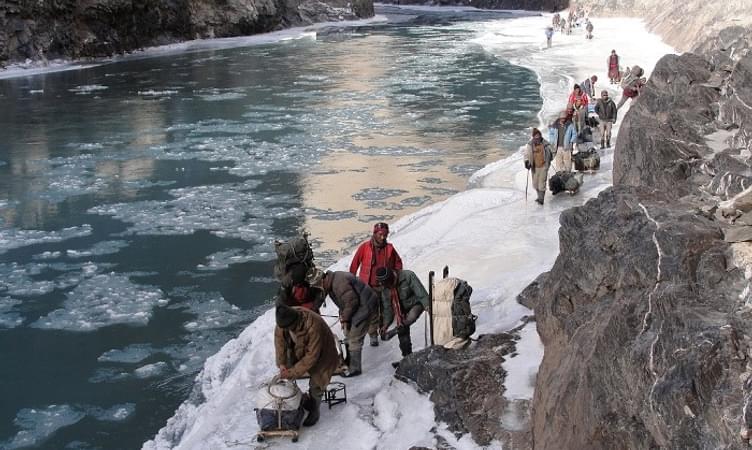
Ladakh Trekking with a group of friends is definitely an enjoyable experience. You can set out on this expedition with your friends, colleagues or family. Usually, at least six persons are required for the expedition. However, as many as 15 or 18 persons can be included in the group. Usually, a large group does not exceed this number.
The objective of keeping the groups relatively small is to ensure good management and also make sure that all guests have a wonderful and memorable experience. Usually, the groups consist of like-minded people who can enjoy and relish the beauty of the region in spite of the harsh conditions.
The groups usually consist of both men and women. To ensure the safety of women during the trek, the guides and other support crew are carefully selected for the trips. The trek is usually led on by a professional trekker who has completed the basic and advanced mountaineering course and certified in the first-aid course.
The team will be accompanied by a local guide, a cook, a helper, a porter and other staff. Complete care is taken to ensure the comfort and safety of all participants during the arduous trek on the frozen Zanskaar River.
Accommodation Arrangement for the Trekkers

In the mainland, all accommodation is made in A Class hotels with all meals included in the package. Comfortable accommodation will be arranged for trekkers. Usually tents are used while camping and persons are generally accommodated in a two man tent. However, due to the harsh and extremely cold climate, trekkers are advised to get some essential items such as steam crossing sandals, insulating fleece jacket, rain proof jackets, insulating gloves, warm sleeping bags etc to protect themselves.
During the trek on the Chadar, the campsites will be set up in caves in the area and hence having all these warm clothes and items is mandatory. Before setting out for the trip, every participant must be fully aware of the conditions that he will have to face during the trek and prepare accordingly.
During the Chadar trek, care will be taken to ensure safety of all participants. However, trekkers will also have to take a few measures for their own safety and health. The trek is usually conducted in groups of at least six persons and is led by a professional trekker who has completed his Basic and Advanced Mountaineering course.
In addition, these lead trekkers are also certified in Wilderness ‘First Aid’ in order to ensure quick medical help during the expedition. Furthermore, other staff such as porters, cooks, helpers and local guides is also sent along on the expedition to ensure successful and fruitful completion of the trip.Trekkers can also enjoy bike trip to Srinagar .
Type of Food Being Served
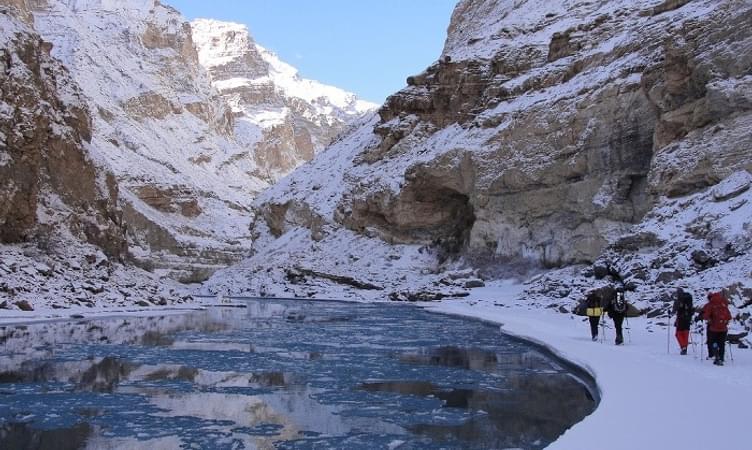
The food that is served during the expedition is decided and cooked carefully. Usually Indian vegetarian dishes and egg dishes are served during the trek. It is important that the dietary needs of the participants are met during the duration of the trek. The climatic conditions of the region are very extreme and different from those in the mainlands.
So in order to keep all trekkers in good health and energised for the journey ahead, well cooked vegetables and eggs are provided in order to keep them fit and healthy for the journey. Hygiene and safety are a priority during the trek and especially while cooking the food. So utmost care is taken while preparing the food for the guests.
The trek covers a journey of about 105 km and most of the distance is covered on foot. For this reason, it is very important that is no mistake or shortcoming in meeting the dietary needs of the trekkers. So a high protein content diet is chosen for the trekkers and this is met by choosing the best vegetables and eggs.
The trek is extremely tough and occasionally requires climbing on icy rocks and boulders. Furthermore, the temperatures of the region hover between 15 to 20 degrees during the day time and -25 to -35 degrees in the night time, which makes it essential for the trekkers to remain energised and high on metabolic heat. Camping in Ladakh will also be one of the perks of this trekks.
How to Get Safe Drinking Water During the Trek?
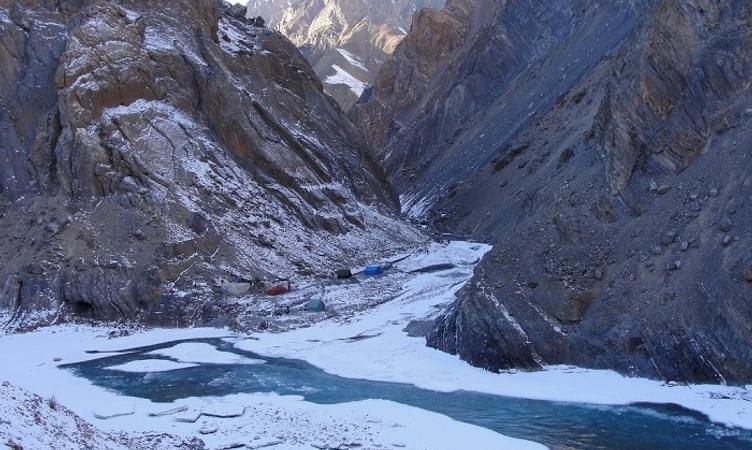
Himalayan water is generally considered safe and pure enough to be consumed directly. However, since the participants or trekkers are from different parts of the country, it is advisable to check with the lead trekker about filling stations. Usually, during the trek, water from the region is purified by boiling with chlorine tablets and then made available for drinking.
It is always best to check with the lead trainer about such arrangements before you start trekking and understand his plan of action. Do not consume water from any source without first checking with your leader. As the region would be new to you, it is always best to consult someone who is well-acquainted with the region.
The journey begins from Chilling in Leh and continues till you reach the Chadar. The distance is about 105 km and the temperatures will vary from 20 degrees to -25 degrees. It is essential that you carry warm sleeping bags, sturdy shoes and warm jackets with you in order to face the harsh conditions of the region.
The frozen river trek does sound difficult but it is one of the most enjoyable and adventurous trekking expeditions you can have in India. With the gain in altitude, the temperatures drop dramatically and blankets of white snow greet you into the mystical land of the Himalayas. To stay safe and fit for the journey, prepare yourself mentally and physically and arrange for all supplies beforehand.
Ground Transportation
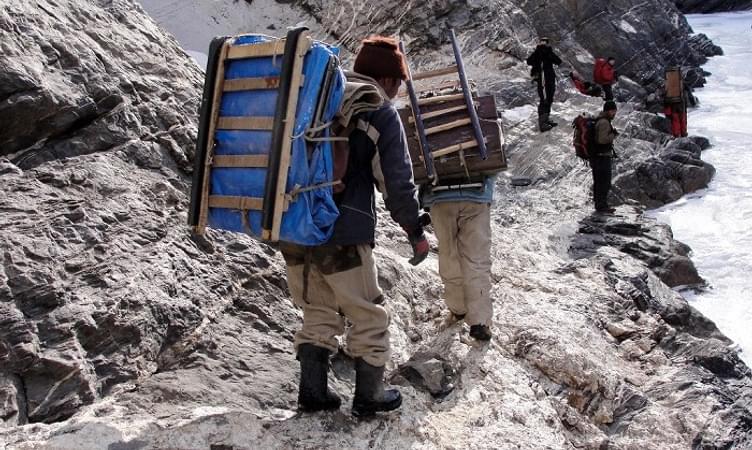
Your journey to the trek will begin from Leh. All ground transportation is done in the best of vehicles that suit the terrain. You will be taken from your source in Toyota Qualis, an Innova or a Scorpio. These vehicles are the best to travel in this rugged region and hence these vehicles are used for all ground transportation of guests. Special care is taken that all guests have a comfortable transportation before the trek begins so as to ensure that they are not worn out or tired before the trek begins.
The journey into the beautiful Himalayan ranges is one of the most sought after experiences among trekkers all around the globe. The mysteries of the Zanskar Valley and the snow clad Himalayas have time and again attracted professional and amateur trekkers and mountaineers from all over the world.
The trekking expedition into the Chadar is one of the toughest and most challenging trails in the country. Nevertheless, more and more trekkers participate in the this trek every year before of the spectacular beauty of the Himalayas that can be enjoyed during the trek.
The Ladakh trek begins from Chilling and continues till the beautiful white blanket of snow which is actually the River Zanskar in a frozen state. The trek involves long distance walking and trekking and hence it is essential for the participants to be fit and healthy. Also the temperatures of the region are incredibly low which make it mandatory for every trekker to carry warm clothes and supplements.
Medical Evacuations/Emergencies
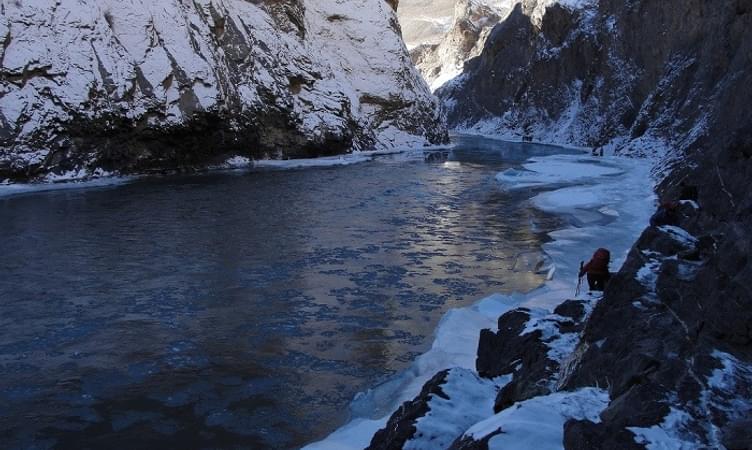
Safety is a priority during trekking trips and Thrillophilia takes measures to ensure that all its guests can enjoy the trip in safety. Although there will be no doctors accompanying the troupe that goes out on the expedition, the lead trekker is usually trained in Wilderness First Aid course, which ensures that primary medical aid is always at hand.
Furthermore, the lead trekker is trained in the basic and advanced courses of mountaineering and trekking and he ensures that all safety guidelines are followed and all trekkers are able to enjoy the beauty of the region by avoiding untoward incidents.
In case you are on any kind of medication or undergoing treatment, consult your physician before deciding to set out on this expedition. Although the beauty and charm of the Himalayan ranges are almost impossible to resist, it is important that you are physically and medically fit for the expedition.
If you need personal trail medications, carry them with you. If you are in doubt about your fitness level for the expedition, consult your physician or a professional trekker for advice. It is important that you gauge your fitness level well ahead and plan your expedition accordingly. If you are declared unfit, do not venture out for the expedition.You must be well aware of Ladakh Weather to avoid medical emergencies.
Other Facts You Should Know
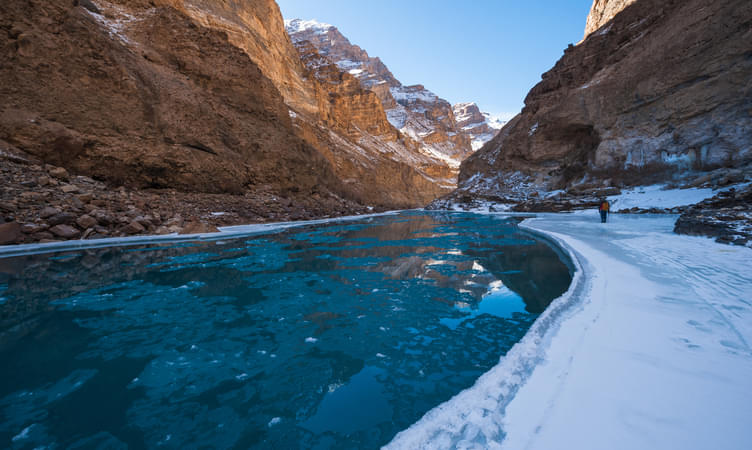
This trek is one of the toughest and most challenging treks in the Himalayan region. The frozen Zanskar River is the only means of communication for the Ladakhis and the Zanskaris in winters. This route is popularly used by trekking enthusiasts in the winters. However, this route will soon be shut down after the road from Chilling to Padum is completed.There are lot of Ladakh tours you can choose from us.
Things You Must Carry
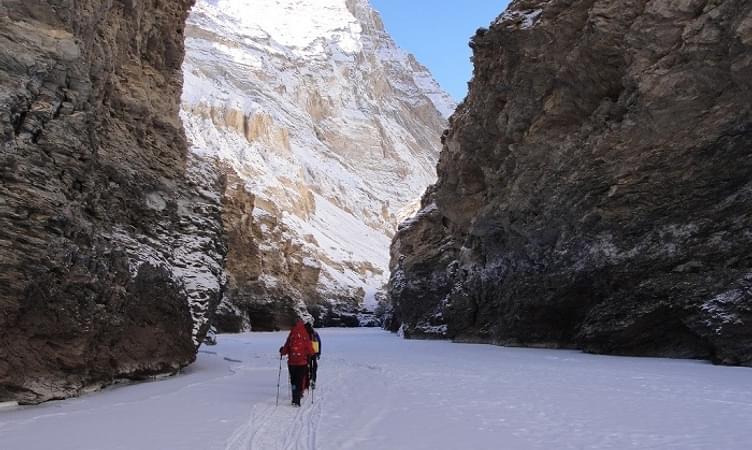
Thrillophilia arranges for ground transportation, accommodation, tents, kitchen and dining tents, kitchen equipments, stools, tables and mattresses, food (vegetarian and non-vegetarian items), cooks, helpers, porters and guides. Furthermore, Thrillophilia will also include the charges of monument entrances, wild life fees and camping charges in your registration fees.
Apart from all this, you will have to carry with you-
In case you do not already own these things, you can hire it from Thrillophilia. You can rent sleeping bags, trekking shoes and clothing etc. The package charges do not include the cost of any kinds of personal expenses such as tips, insurance, laundry and phone call charges, any kinds of beverages or any other cost incidental to any change in the itinerary.
While setting out for the trek, it is essential that you are dressed in long sleeve, hiking shirt; long quick dry hiking pants. You can also carry a hat with a retention cord on windy days.
Your duffel bag can carry your sleeping bag, your complete set of spare clothing, long and regular underwear, inner and outer socks, a pair of fleece sweaters, insulating hats, a pair of running shoes, your toilet kit, your toothbrush, soap, towel etc.
Fitness Required
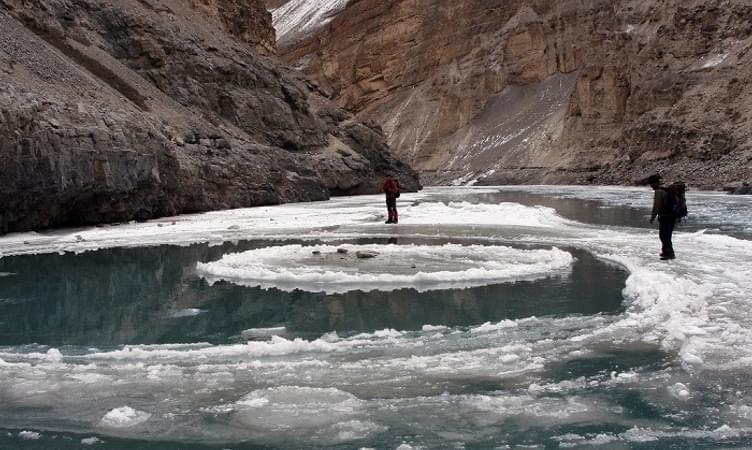
The trek to Chadar is extremely arduous and tasking. Not only does it test your physical stamina but also your medical health. It is essential that you are in the best of health before you set out for this expedition. Usually, the lead trekker is a trained professional in the basic and advanced courses of trekking and mountaineering and also trained in Wilderness first aid.
But to avoid any critical or untoward situation in terms of health and fitness, it is best that you consult a professional or a physician and get yourself checked before participating in the Chadar trek. In case you are on medications, make sure you carry your medicines with you while venturing out for the trek.
The climatic conditions that trekkers have to face during a trip to Chadar are extremely harsh and cold. It is essential that you are physically and medically fit to take up this challenge. The temperatures hover between 15 and 20 degrees during the day time and between -25 and-35 degrees during the night. The nights are usually spent in caves near the frozen Zanskar River in extremely cold conditions.
Hence, it is mandatory that you understand the challenges that lie before you completely and fully before stepping out for the expedition and prepare yourself accordingly. Carry warm clothes, warm bedding and food supplements to keep you energised during the trek. Also, carry chlorine or other water purifying tablets to filter and clean your water before drinking.Special care must be taken during Trekking in Ladakh in Winters.
Approximate Cost
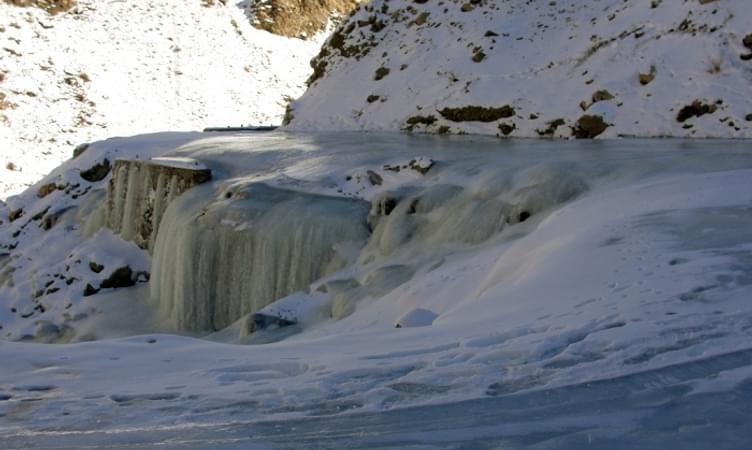
The approximate cost for the expedition of 13 days and 12 nights starts at about Rs 52,000 per adult. The cost may vary from individual to individual depending on the type of accommodation chosen or available, number of people travelling, activities possible and availability, changes in government fee on entry or taxes, credit card fee as per payment gateway charges etc.
The total cost includes the cost of ground transportation using Toyota Qualis, Scorpio or Innova, accommodation in A class hotels including all meals, tents, kitchen equipments, stool, tables and mattresses, meals, support staff and entry fees to monuments, wildlife areas and camping fees.
This package charge excludes the cost of sleeping bags, trekking shoes and clothing, any kind of personal expenses, tips, laundry, insurance and phone calls, any kind of drinks and cost incidental to change in itinerary etc.
Apart from this, you will have to bear the expenses of hiring or buying the equipments and essential items required for the trek such as day size packs, trekking boots, stream crossing sandals, water bottles, fleece jackets, rain proof jackets, insulating gloves, sunscreens, sunglasses, emergency first aid kit etc.
These items are vital for survival during the trek and hence must be carried by everyone participating in the expedition. You will also need special clothes such as long sleeve hiking shirts, long quick dry hiking pants, hiking socks, trekking poles etc. Some of these items can also be purchased from Leh if you do not own them yourself. Apart from Trekking you can also enjoy Bike trip in Leh Ladakh.
How to Plan a Cost-Effective Trek

Planning is very important to make a trek cost-effective. If you wish to cut down unnecessary costs, you need to plan your trip in detail. Just packing a ruck sack and heading for the Himalayas isn’t enough when it comes to planning a trekking trip.
You will need to plan things such as time of the programme, choice of the route and route details, choose the route type, check your capacity, capability and experience of your team members, collect information, plan for food, take gear and equipment, medicines, making the budget etc. For your personal expenses, take account of factors such as items to be packed, guide, porter, cook, check your physical and medical fitness, use of food and dos and don’ts at the campsite.
By planning out all these things beforehand, you can cut down a lot of unnecessary expenses during your trip. Prepare a checklist and tick out everything you have arranged. An organised approach to planning a trip is the best way to make your trip fruitful and cost-effective.
Before you set out for the trek or decide on going trekking, do a little homework by researching on the destination, the geographical and climatic conditions, on the things that you will need to carry and the things that will be provided to you from the agency that will facilitate your travel and then prepare a checklist. With an itemised checklist, you cut down the chances of missing out anything and hence the cost of buying an item or renting it last minute. You can also do budget Jeep Safari in Ladakh that will give you sight to breathtaking views.
Common Trekking Mistakes

1) Lack of Physical Fitness: Get yourself physically checked and only when you have been given a clean chit by the physician should you plan a trekking trip in high altitudes. High altitude trekking requires a lot of physical stamina, strength and endurance and for this reason it is highly essential that you are in the best of form. Persons suffering from heart diseases, high blood pressure, diabetes etc should refrain from trekking in high altitude regions.
2) Poor Packing: While setting out on a trekking expedition in the Himalayas, it is important that you pack all your stuff wisely. Remember that when you are climbing uphill, each and every gram in your rucksack will weigh heavy and hence wise packing is absolutely necessary.
So if you are a beginner, consult an experienced trekker before packing. If you are experienced, prepare a checklist and then pack only the most essential items.
3) Dehydration: Many people avoid drinking water in chilly conditions. This results in dehydration. So keep your water bottles close and drink in as much as you can. This will allow your body to maintain its water balance. By not drinking enough water during trekking, you aid in your body’s dehydration and make it weak and tired during the trek.
4) Wrong Outfit: Dressing up right is not just for parties and night outs. It is important that you are dressed in the right clothes and gear to enjoy your trekking experience at high altitudes. Do not wear flowy or frilly clothes that will make navigation difficult. Make sure you wear warm woollen and polyester clothes that suit the weather and help you trek easily.
5) Trekking at Night: You may feel adventurous enough to trek at night, but the best way to avoid trouble while trekking in the Himalayas is - avoid trekking at night. The slopes are slippery and there are no lights to show the way. If you venture out at night, you are sure to invite serious trouble.
6) Wearing the Wrong Shoes: Since you will be spending most of your time walking, it is best that you choose the right shoes for yourself. Strong and sturdy shoes with metal spikes are perfect for walking in the snow. There are different types of shoes for different terrains and you should choose your shoes carefully if you want to make your trekking experience enjoyable. A wrong set of shoes or even socks in the wrong terrain can spoil all the fun in your expedition.
7) Skipping Food: Eat well when you are on an expedition such as the frozen river trek. Many people skip their food not realising that this can cause a lot of problems. While on such a tough task, it is important that you give your body all the energy and nutrition you can to make it strong and sturdy enough to face harsh conditions. By skipping food, you make your body weak and less resistant to the severe conditions of the region.
8) Avoiding Weather Report: Do not forget to check the weather report before you start trekking. Neglecting or avoiding the weather report can land you in serious trouble, especially at such high altitude regions. Check for websites that offer such information and keep yourself updated before setting out for the adventure.
Is the Trip Customisable?

Yes, the trip is customisable and can be designed to suit your preferences. Himalayan expeditions are carried out in different time frames depending on the weather and climatic conditions. If you wish to travel independently, you can choose your time frame and preferred group size.
The charges will depend on the number of people in your group, trek area, trek style and duration of the trek. Before going on a trekking expedition in the Himalayas, it is best that you take a few things into account such as the geographical and climatic conditions of the region, the things you will require, common trekking mistakes that people make while trekking in such a terrain etc.
Also, plan your journey well ahead of time. Use a very organised approach to plan your travel. Do your homework by researching well on the region, the climatic conditions, the trek route, the different trek styles, the best season to trek in the region etc to make your expedition fruitful and enjoyable.
Armed with this information, you can plan your trip wisely and make it an enjoyable and memorable experience. Most people overlook such matters considering it to be trivial and are in for a big mess when they start trekking.You can also do rafting in Ladakh.
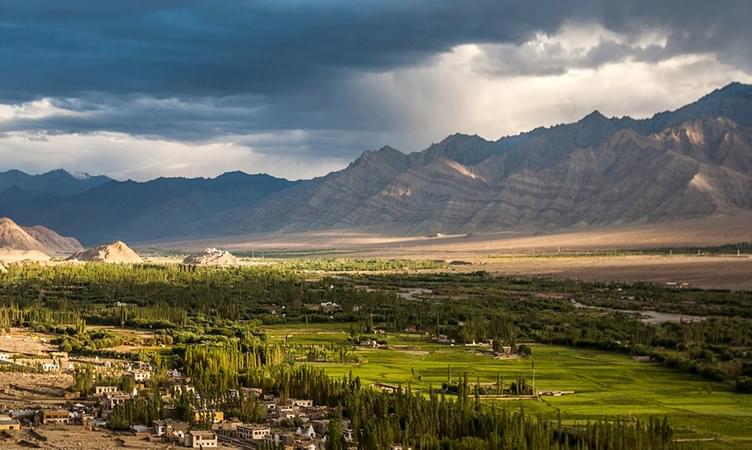
Best of Leh

People Also Ask About Ladakh
Is chadar trek for beginners, is chadar trek dangerous, how long is chadar trek, can chadar trek be done solo, what is the best time to go for chadar trek.
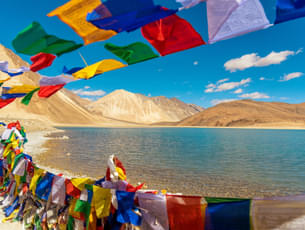
Trending in Ladakh
Trekking in ladakh.
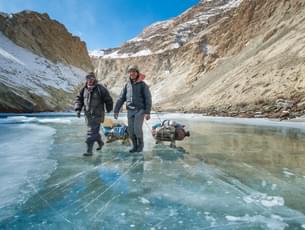
Ladakh Top Attractions

Heaven, Peace, Silence, and Tranquility at one place? Come and spend a few hours at Pangong Lake in Ladakh! A pristine place in Ladakh marked by subtle to high peaks around, crystal blue waters and the vast expansion catches the eye so much, so long as if a magic is happening right in front of the eyes. Let our Ladakh holiday packages transport you to this mesmerizing destination, where nature's grandeur unfolds in every corner.Pangong Lake, also known as Pangong Tso, lies calmly at a breathtaking elevation of 14,270 feet. Interestingly, the lake is 12 km long and marks itself between the laps of India and China. Rather, 60% of the portion is stretching in the neighboring nation and this excites every traveler to be here.The surreal clean blue waters are actually brackish or salty in nature and this feature doesn’t let any aquatic life survive in the same. Moreover, the temperature range between -30 to -10 degrees make even this salty lake freeze with thick ice sheets, which is quite opposite in case of salt ridden water bodies.This picturesque landscape location enhances its beauty with the arrival of migrating birds every year and attracts many travelers in search of adventure, photographs, bird-watching and chilling experience. Pangong has another unique and catchy feature; when it acts like a chameleon and changes its color from blue to green to even grey at times. The brackish water of Pangong attracts the migratory birds every year during winters in Ladakh.
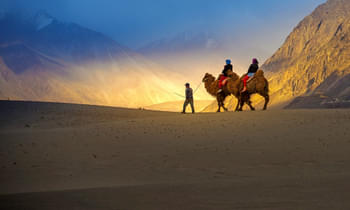
One of the most beautiful parts of the moonscapes of Ladakh, Nubra Valley is a deep-cut gorge created by the combined effects of Shyok and Nubra (Siachen) rivers. A high altitude cold desert, Nubra Valley is actually an extension of the Tibetan Plateau (Qing-Zang Plateau) that starts in China and extends up to Ladakh. This valley in the plateau separates the Ladakh Range from the Karakoram Range. But more than anything, Nubra Valley is the most beautiful region in all of Ladakh. Home to wonders like the Diskit Monastery,Hunder Sand Dunes, Samstanling Gompa, Yarab Tso Lake, and the villages of Turtuk and Panamik.Located about 160 km from Leh, the capital of Ladakh, Nubra Valley is a great attraction to all those who come here. The gateway to the upper reaches of the country, especially Siachen, Nubra Valley has an oasis of a town in the heart, Diskit, making a great place to stop you and reflect at the beauty around. And while you are at it, take a short detour to the famous white sand dunes of Hunder. The shapes and forms that these dunes take during different times of the year mesmerize every visitor who comes here. To make it further interesting, there are the double-humped Bactrian Camels, offering rides through the dunes.And when it turns dusky, head to the Diskit Monastery and visit the towering statue of Maitreya Buddha which looks over the entire valley and blesses it for another day to come.Planning a Trip to Ladakh, Experience of Chadar Trek - The Frozen River Trek
More Ladakh Attractions
Ladakh travel guides.
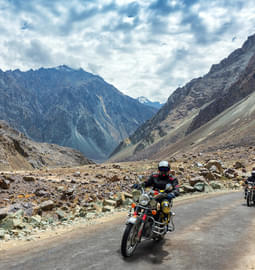
Ladakh Reviews

Popular Nearby Places Around Ladakh
More things to do in ladakh, more on ladakh tourism, popular related destinations.
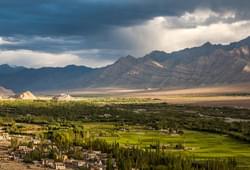
Best Domestic Packages
Best international packages, domestic honeymoon packages, international honeymoon packages, places to visit in india, international places to visit, things to do in india, international things to do, popular on thrillophilia.
- We assure the privacy of your contact data.
- This data will only be used by our team to contact you and no other purposes.
Your enquiry has been received successfully. Our destination expert will reach out to you soon!

CHADAR TREK
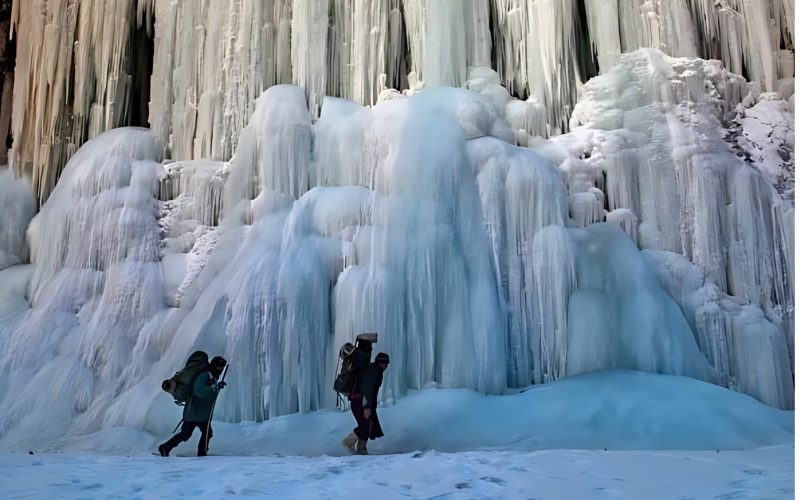
- Level : Moderate
- Altitude (Meters) : 3850
- Location : Leh
Embark on a once-in-a-lifetime expedition unlike any other Himalayan trek – the Chadar Trek in Ladakh. Prepare to be in awe of a fantastical landscape where a frozen river transforms into your path and dramatic mountains pierce the sky.
Traverse the Zanskar River: Hike across a mesmerising expanse of the frozen river, aptly named “Chadar,” a Hindi word for “sheet.” The glassy surface reflects the majestic Himalayas, creating a breathtaking panorama.
Embrace the Challenge: At an altitude of 11,150 feet, the Chadar Trek offers a unique experience compared to high-altitude treks. While the altitude is manageable, the frigid temperatures, plummeting to -30°C at night, demand proper gear and a spirit of adventure.
Feel the adrenaline rush as you navigate this icy terrain, reminiscent of a North Pole expedition. Be prepared for an adventure that tests your limits and fosters camaraderie among fellow trekkers. Imagine your rations carried on traditional sleds, adding to the unique charm of this trek. Embrace the simpler way of life as you rely on essential supplies to fuel your journey. Seek refuge in natural caves, providing a glimpse into how past explorers braved these harsh conditions. These unique stopovers add an element of historical intrigue to your trek.
The Chadar Trek isn’t just about conquering the elements. Connect with the Zanskari community, known for their warmth and resilience. Experience their way of life and immerse yourself in their rich culture.
The Chadar Trek is an experience that goes beyond words. It’s a test of your physical and mental fortitude, a chance to witness breathtaking natural beauty and a cultural exchange you won’t forget.
- Day 1: Arrive in Leh (Dramatic Himalayan city)
- Day 2: Acclimatise & explore Leh
- Day 3: Medical checkup (Mandatory for trek safety)
- Day 4: Drive Leh to Shingra Koma via Bakula (Scenic start)
- Day 5: Trek Shingra Koma to Tibb (Frozen river adventure begins)
- Day 6: Trek Tibb to Nerak (Challenging landscapes)
- Day 7: Trek Nerak back to Tibb
- Day 8: Trek Tibb to Bakula, drive to Leh (Return to civilization)
- Day 9: Depart Leh (Farewell to your Ladakh expedition)
- The Scenic Flight: Your Ladakh adventure begins with a breathtaking flight over snow-capped Himalayan peaks. Get your cameras ready for those incredible aerial views!
- Leh, the High-Altitude Heart: Land at one of the world’s highest airports in Leh. Feel the chill and gather your bags for a transfer to your cozy accommodations.
- Acclimatization is Key: Spend the rest of the day adjusting to the altitude. Explore Leh’s quiet winter streets but take it easy to help your body adapt.
- Guided Exploration: Your trek leader will take you on a gentle acclimatization walk, introducing you to Leh’s unique winter atmosphere.
- Mandatory Medical Check: Following Leh’s regulations, you’ll undergo a medical checkup at SNM Hospital to ensure your readiness for the trek.
- Essential Clearances: At the Tourist Information Center, complete your medical checkup and obtain the necessary ALTOA NOC and Wildlife Department permits.
- Rest Up in Leh: Enjoy another night at your Leh hotel to prepare for the frozen river adventure ahead.
- The Scenic Drive: Embark on a thrilling journey along the Indus River, stopping at the awe-inspiring confluence of the Indus and Zanskar Rivers at Nimmu.
- Hairpin Bends & Dramatic Landscapes: Be prepared for 70 kilometers of winding roads and mesmerizing scenery.
- First Views of the Chadar: As Bakula nears, catch your first glimpse of the frozen Zanskar, fueling your excitement.
- Chadar Walking 101: Your leaders will give you essential tips on navigating the icy Chadar.
- Shingra Koma Camp: Explore and photograph your campsite for the night.
- Leaving Your Warm Cocoon: Brave the morning chill to start your trek! The Zanskari staff with their warm hospitality will provide hot tea and breakfast.
- A Long & Scenic Trek: Today covers 14 kilometers on the Chadar (approx. 6-7 hours). Fill your thermos with warm water, it’s crucial!
- Hidden Sunlight & Frozen Wonders: Experience the mountains casting long shadows and the deep blue of the Zanskar River contrasting with the ice. Spot incredible frozen waterfalls!
- Mid-Trek Refuel: Enjoy a hot, energizing lunch prepared by your team midway.
- Arrival at Tibb: Reach Tibb by 3 p.m. and soak in the stunning final stretch of the trek.
- Behold the ‘Mother of All Waterfalls’: Today’s highlight is the majestic Nerak Waterfall, a frozen spectacle.
- Staying Warm & Exploring: Get an early start for this active day. Explore the Nerak Waterfall if you reach the campsite before 3 p.m.
- Ice Sculptures: Witness the river’s ever-changing ice formations, a natural art gallery.
- The Chadar’s Constant Change: Retrace your steps to Tibb, but the frozen Zanskar will surprise you with its ever-shifting form.
- Meeting the Zanskari: Observe local porters in their traditional ‘Gonchas,’ adding a touch of cultural richness to your journey.
- Farewell to the Chadar: Your final Chadar trek day takes you back to Bakula (7-8 hours).
- Return to Civilization: Drive back to Leh, bidding goodbye to the frozen river adventure.
- Leh Souvenirs & Prep: Relax at your hotel, squeeze in last-minute shopping, and get ready for your departure flight.
- Cherish the Memories: Fly home, carrying unforgettable memories of one of India’s most incredible treks.
- Convenient Pick & Drop: We’ll handle your transportation to and from the designated starting point of your trek, eliminating any pre-trip logistics.
- Expert Guidance: A knowledgeable and certified guide will accompany you throughout the journey, ensuring your safety, sharing their expertise on the local flora and fauna, and navigating the trails with ease.
- Culinary Delights: A dedicated chef will whip up delicious and nutritious vegetarian meals throughout the trek. Savor fresh, local ingredients prepared over a campfire or camp stove, from the first day’s hearty dinner to the last day’s energizing brunch.
- Comfy Accommodations: Rest easy each night in a cozy tent. Whenever possible, we’ll upgrade your stay to comfortable guesthouses, offering a touch of luxury amidst the wilderness.
- Camping Equipped: Leave the bulky gear to us! Your camping necessities, including tents, sleeping bags, and cooking equipment, are all covered.
- Porters & Mules: Focus on enjoying the scenery while our reliable porters and mules handle transporting the camping gear. For an additional fee, you can also have them carry your personal belongings, ensuring a lighter and more enjoyable trek.
- Unimpeded Exploration: All necessary entrance fees to the forest are included, granting you access to pristine natural beauty.
- Transportation to Trailhead: This trek departs from a designated starting point. Transportation to and from your hometown is your responsibility, though we can recommend convenient options upon request.
- Personal Expenses: This includes tips for your guides and porters, any personal medications you require, and any costs associated with conference calls or data usage during the trek.
- Enhanced Mobility: While our package covers the transportation of camping gear, for an additional fee, you can have our porters and mules help transport your luggage (up to 12 kg per bag per person) for Rs 350 per day per bag. This allows you to explore with a lighter pack, maximising your comfort on the trails.
- Transparent Pricing: Our focus is on providing a straightforward and exceptional trekking experience. By understanding what’s excluded, you can ensure you’re fully prepared for your adventure.
Essential Gear Guide
- Waterproof, Snow-Proof Trekking Boots: A must-have for challenging terrain and snowy conditions.
- Sneakers/Sports Shoes: Comfortable for around the campsite.
- Woollen Socks: Keep your feet warm and dry.
- Main Backpack (50 ltr): For carrying the majority of your gear.
- Daypack (20–30 ltr): For essentials during daily hikes.
- Duffel Bag: Optional for additional storage.
- Waterproof/Breathable Jacket & Trousers: Essential for rain and snow protection.
- Insulated Jacket: Choose synthetic or down feather fleece for warmth.
- Thermal Layers (Upper & Lower): Base layer for cold conditions.
- Trekking Pants: Comfortable and durable.
- Shorts: For warmer sections of the trek.
Season-Specific Clothing
Adapt your clothing choices based on the time of year you’re trekking. Consider the average temperatures and weather conditions for the Goechala Trek during your chosen season.
Hand & Head Protection
- Gloves: Liner gloves with an outer waterproof shell.
- Sun Hat & Woollen Cap: Protection from sun and cold.
- Bandana/Face Mask: Versatile for dust or warmth.
Accessories
- UV Protection Sunglasses: Essential for high-altitude glare.
- Water Bottle/Hydration Pack: Stay hydrated.
- Headlamp: With extra batteries.
Trekking Gear
- Trekking Poles: For stability and support.
- Sunscreen, toiletries, and water purification: personal essentials.
- First-Aid Kit: Include your regular medications and AMS prevention.
Camping Equipment (if applicable)
- Sleeping Bag: Choose a suitable temperature rating.
Departure Date
Call- +91-81988383681 | +91-7696131323, cancellation policy.
Cancellation due to Natural Disasters or Unforeseen Circumstances:
Suppose a trek is cancelled at the last minute due to a natural disaster or unforeseeable circumstances (such as floods, earthquakes, landslides, attacks, or bandh). In that case, Trekking Cougars will issue a Trek voucher for the full amount. The voucher can be used for the same or a different trek over the next year.
Client Cancellations:
- Cancellations made within 30 days of the trek’s start date will receive a full refund.
- Cancellations made between 30 and 20 days before the trek will receive a 50% refund.
- There will be no refund for cancellations made less than 20 days before the trek begins.
Please note that all refunds are subject to a 4% cancellation charge to cover processing fees. Additionally, trek insurance is non-refundable.
Trekking Cougars Responsibilities:
Trekking Cougars assumes no responsibility for any damage or injury to your clothing, equipment, or other belongings while on the trek. The trek fee covers all expenses associated with the trek, from start to finish, as outlined in the specific trek itinerary.
Get in Touch

- Cultural Trips
- Wildlife Expeditions
- Destinations
- Outdoor Programs
- Discover trekking
- Health and fitness
- Experiential learning
- Trekking tips
- Outdoor skills
- Trekking gear
Chadar Trek
Proceed booking, already a member.
Username or E-mail
Forget Password?
Don't have an account? Create one.
Or continue as guest, adding item to wishlist requires an account, why book with us.
- Small groups - (6-12)
- Experience nature
- Sustainable experiences
Got a Question?
Do not hesitate to give us a call. Our team of experts will be happy to talk to you.
+91-9667867679 [email protected]
- 8 Days/7Nights
- 11100 ft./3384
- 12 Participants
Chadar Trek Overview
Imagine a long stretch of a frozen river, a white wonderland featuring a frozen waterfall that seems straight out of Chronicles of Narnia. Chadar Trek in Ladakh is no less than a dream. Every landscape you encounter on the trail teleports you to a dreamy winter wonderland. From walking on a thick sheet of ice to navigating a translucent river bed with azure blue water beneath, Chadar Trek checks all the boxes to feature as one of the most thrilling adventures to embark on.
Your eyes are in for a treat at every step. The landscape changes, the form of the river changes, and temperature and weather fluctuate every hour, making this trek one of the most unpredictable terrain to traverse. Embarking on Chadar trek is equivalent to signing up for an adventure of a lifetime.
One of the most glamorous trekking trails, the Chadar trek in Ladakh attracts hundreds of adventure seekers as the Zanskar river completely freezes with the onset of winter. Zanskar River enwraps itself in a white sheet of snow allowing explorers to admire its unprecedented beauty. A challenging walk along the frozen river is a dreamy sight. The river changes its appearance throughout the trek. In some places, you gently walk on a thick sheet of snow while many sections of the trail require you to tackle the icy cold water of Zanskar.
While the frozen water of Zanskar appears like a dream, trekkers are boggled by the completely frozen waterfall of Nerak. It takes a moment to soak in the beauty of this sight.
Chadar Trek takes you on a life-altering journey and unravels the hidden wonders of Ladakh. While it is a dreamy escape, the trek is physically demanding, primarily because of harsh weather conditions. The trail opens in the peak winter months of January to February, providing an adrenaline-packed experience to last a lifetime.
Chadar Trek Itinerary
Day 1 : arrive in leh (11,450 ft.).
Experience a scenic drive through the valleys of Himachal Pradesh, following the Sutlej river for approximately 6-7 hours and covering a distance of 203 km. You’ll have the opportunity to visit one of the most remote villages in the region.
Day 2 : Acclimatization in Leh (11,450 ft.)
It is recommended to rest in Leh for a minimum of two days after arriving. You can spend the day exploring Leh city and visit the monasteries nearby. It is strictly prohibited to consume alcohol or smoke. Remember to indulge in hot soups and keep yourself warm.
Day 3 : Rest and Acclimatization in Leh (11,450 ft.)
Today is the last day of acclimatization. Trekkers have to get their medical check-ups done at the Tourist Information Centre. It is mandatory to pass this test to proceed further. The medical check-up is compulsory to obtain an NOC for the Chadar trek.
Day 4 : Leh to Singra Koma (75km drive) followed by a hike to Tsomo Poldar (10,500 ft.)
Trek Distance – 3km
Trek Duration – 2 to 3 hrs
The real adventure begins on day 4. Your journey to a most thrilling trek starts with a drive from Leh to Singra Korma. A picturesque drive along the Zanskar River takes you to the starting point at Singra Koma.
Chadar remains completely frozen in some sections with thick ice formed over the blue water of Zanskar, while in some sections it is a thin layer that requires utmost care to traverse this geographical marvel. As the river changes its form throughout the trail, you tread your path in a slushy river bed or climb to the rocky portion to reach the other side.
After walking for 2 to three hours, you will reach the first campsite at Tsomo Poldar.
Day 5 : Tsoma Poldar to Tibb Cave (10,950 ft.)
Trek Distance – 14 km
Trek Duration – 7 to 8 hrs
The trail is long today and you will cover a distance of 14 km. It takes roughly 7 to 8 hours to cover the distance as traversing a frozen river is strenuous. Though it’s a gradual walk along the river bed, the diverse forms of Chadar and frigid temperatures make the walk a tedious affair. But, you will have soothing blue shades of Zanskar to keep you company.
The landscapes surprise you throughout the trail. You cannot help but halt for a while to soak in the beauty of the trail. Zanskar flows silently, guarded by giant rocky cliffs on both sides. Frozen waterfalls pique your interest on the way to Tibb Cave.
The next campsite is Tibb Cave, a naturally formed small cave that acts as a resting place.
Day 6 : Tibb Cave (10,950 ft.) to (Nerak 11,100 ft.)
Trek Distance – 13 km
Trek Duration – 6 to 7 hrs
The most iconic landmark of the Chadar Trek awaits you today. Located roughly 13 km from Tibb Cave, Nerak is home to a frozen cascading waterfall. A first glimpse of the waterfall mesmerises you. Trekkers often gawk at this nature’s marvel in awe. This breathtaking beauty, however, comes with harsh temperatures, dipping as low as -25 degrees Celsius.
After basking in the natural beauty of Nerak waterfall, the team heads back to the campsite.
Day 7 : Nerak (Nerak 11,100 ft.) to Tibb Cave (10,950 ft.)
Retrace the same trail to Tibb Cave. However, the trail you navigated while on your way to Nerak appears different in many sections as Zanskar keeps changing its form due to slight temperature changes.
You will reach Tibb Cave late afternoon and rest for the night.
Day 8 : Tibb Cave (10,950 ft.) to Shingra Koma then Drive to Leh (11,450 ft.)
It’s time to be captivated by the surreal beauty of Zanskar for the one last time. You will reach the road head to Shingra Koma in the afternoon and head with Leh with memories of a lifetime.
How to reach the base camp of Chadar trek?
Nearest Airport – Leh Airport, Ladakh
Chadar trek starts from a place Shingra Koma . The distance between Shingra Koma and Leh is around 70km and is covered in 3 hours. To begin the trek, one must first reach Leh, conveniently connected by air to major cities.
Flying is the only option to reach Leh in winter. Leh is accessible by road before October. Both Srinagar-Leh and Manali Leh shut down in the peak winter season due to snowfall.
Chadar Trek FAQ
What is the distance of chadar trek.
The total distance of the Chadar trek is 62 km . You walk an average of 6 – 7 hours daily.
Is Chadar Trek suitable for beginners?
The trek is not recommended for absolute beginners. We recommend prior experience with short hikes before attempting the Chadar trek.
How difficult is Chadar Trek?
Chadar trek is a difficult grade trek. T raversing the frozen river becomes challenging and tricky, despite the minimal altitude gain. You will be navigating a frozen river for a few days. It is tricky and demanding to trudge the path carefully.
What will be the temperature in Chadar Trek?
Chadar trek temperature ranges between -10 °C to -25 °C . You will have cold and windy days and chilly nights with freezing temperatures.
What is the best time to visit Chadar Trek?
The best time to visit Chadar trek is the peak winter months of December and January when the Zanskar River is completely frozen.
Will there be snow on the trek?
Yes, snow will be abundant. There is a probability of witnessing snowfall on the Chadar trek.
Where is Chadar Trek located?
Chadar Trek is in Ladakh. The trek starts from Shingra Koma .
What is the starting point of Chadar Trek?
The trek starts from Shingra Koma . The place is around 2 hrs away from Leh city.
What is the duration of Chadar trek?
The total duration of the Chadar trek is 7 nights and 8 days .
It takes 8 days to complete the Chadar trek, including travel to and from the base camp and the acclimatization in Leh.
What is the altitude of Chadar Trek?
Chadar trek is at an altitude of 11,123ft. The trek starts from Leh city at an 11,482ft.
Can we do Pin Bhaba Trek on our own?
All trekkers heading to Chadar must obtain NOC from local authorities after clearing the medical checkup. It is suggested to book the trek with a reliable agency.
Do we need prior experience to do the Chadar Trek?
Though prior experience in high altitude trek is not a compulsion, Chadar trek takes you to an altitude of 11,123 ft. It is recommended that trekkers must have adequate physical fitness with some exposure to hiking or trekking in challenging terrain.
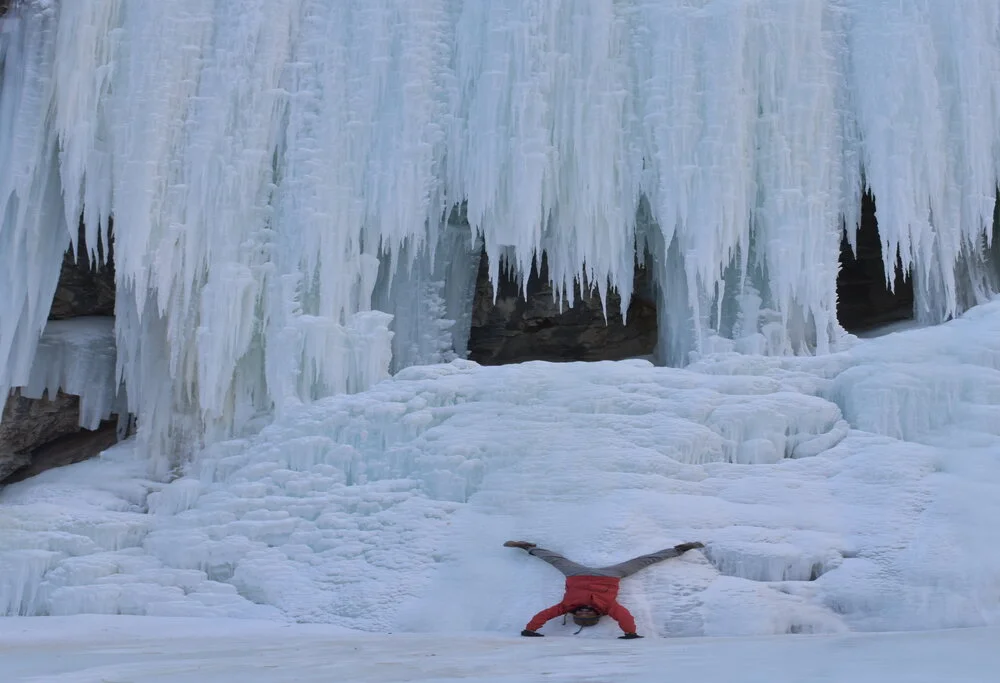
How should I prepare to avoid AMS?
The most important thing to do on a trek to avoid AMS is to drink water, more than your daily intake. Water is an excellent way to avoid AMS. Along with this, you should also have all the nutritious meals we provide on the trek. If you still are sceptical about getting AMS, we would advise you to carry Diamox tablets with you. However, according to the situation your Outdoor leader will advise whether or not you should take it.
I have a medical condition. Can I join the trek?
We encourage everyone to trek, even if or not they have a medical condition. We have an in-house doctor at OWLS with whom you can discuss your medical condition and accordingly, we can help you better prepare you for the trek.
What document do I need to carry?
Please keep the following documents ready before filling out this form
- Health form (for all participants of Kashmir and Himachal Pradesh treks) and (for all participants <15 and > 60 years of age)
- RTPCR for children <15 years/Vaccination certificate for adults (for Nepal treks)
Should I bring snacks to eat on the trek?
Although we provide filling breakfast, lunch, and dinner along with morning tea and evening snacks, you can carry some light snacks for munching on the trail. You can carry protein bars, dry fruits, and homemade snacks like Shakkarpara to help you give that extra energy on the trek.
Who will be leading my trek?
All our Outdoor Leaders are trained and experienced leaders. They have completed basic Mountaineering Course, and are equipped with basic first-aid knowledge. Our leaders are certified Wilderness First Responder course
Do I need to get my medical kit for the trek?
You don’t need to carry your medical kit. If you have your prescribed medications, you need to carry them on the trek
What kind of arrangement is available for accommodation on the trek?
The accommodation will be on twin sharing basis. One tent will be shared by two trekkers.
Is there any arrangement for offloading on the trek?
Yes. Communicate your requirement to the trek leaders beforehand, as it will be difficult to arrange to offload at the last minute. The offloading charges will be Rs 350 per bag, and your bag should not weigh more than 9 kg.
Note: At OWLs, we suggest our participants carry their backpacks and avoid offloading. However, in case of pressing circumstances, you can opt for offloading.
Is there any option to keep our luggage at the base camp?
Yes, you can leave the extra luggage at the base camp. However, do not leave valuables like laptops, jewellery, or any other expensive items in the base camp.
What will be the toilet facilities on the trek?
The OWLS team will set up a toilet tent near the campsites. The toilets will be dry toilets and you will have to use toilet paper. There will be a pit dug by the team and you will have to cover your nature’s call with dry soil. Avoid using wet wipes, as they are not biodegradable. At OWLS, we thrive to leave no trace in the mountains.
At the base camp, you will have regular concrete toilets.
What will be the food arrangement on the trek?
The food offered will be as per the nutritional requirements. As you will be walking every day for 4-6 hours, you will be burning a good amount of calories. The team makes sure that the food you will be offered is healthy and helps you sustain through the day. The regular meal comprises eggs, locally grown vegetables, rice, roti, and pulses. The menu changes from day to day.
What will be the status of the mobile network on the trek?
You will have access to mobile networks in Leh. The network becomes sketchy once you move towards the starting point.
Are there any ATMs at the base camp?
The last ATM will be in Leh.
How to prepare for Chadar Trek?
Chadar trek is a difficult-grade trek. The trek takes you to an altitude above 11,000ft and has long hiking hours over multiple days. Although altitude gain is less than other difficult grade treks. Nevertheless, tackling some challenging ascents, especially navigating the frozen Zanskar River, demands you to be in good physical shape. To be able to explore the trek conveniently, you must intensify the fitness routine a minimum of two months in advance.
Sample workout for Chadar Trek
Getting fit for a Himalayan trek of difficult treks like the Chadar trek demands better strength and stamina. On these treks, you navigate challenging terrain for 6 to 8 days. The trek takes you to an altitude of 11,123ft.
Note – The time duration of each workout is 45 minutes with medium intensity. Along with strength-building exercises, improve your cardiovascular endurance and try to run 5 km in 30 to 35 minutes.
Sample Workout for Chadar Trek
Find out a detailed Work Out Plan for Easy, Moderate and Difficult Himalayan Treks here.
What to pack for Chadar Trek?
The must-haves, trekking backpack( 50/60 ltrs) -01, trekking shoes -01, trekking clothes, down jacket -01, raincoat/poncho -01, thermals -01 (if trekking in winter), woolen gloves – 01, waterproof gloves – 01, dry fit full sleeve tshirts -02, trekking pants/trousers -02 , woollen socks -03, dry fit socks – 03, woollen cap -01, sun hat -01, spare undergarments – as per the requirement, trek accessories , trekking poles – 01, sun protection (sunscreen, sunglasses), water bottles (1 litre each), lunch box, spoon, mug, first aid kit or personal medication, small biodegradable bags to take the waste/ used clothes , toilet paper/tissues, toiletries – lip balm, mouisteriser, lightweight towel, toothbrush, toothpaste.
Read more about trek essentials for Himalayan treks here.
Related Tours

Ali-Bedni Bugyal Trek

Brahmatal Trek
You will receive an email containing a link allowing you to reset your password to a new preferred one.
Verification mail has been sent.
Please check your mail to verify your account.
Click Here to Login
- How To Reach

33°54'07.9"N 77°00'03.9"E
- Chadar Trek

Inquire Now
Pickup point.
Leh Airport, India
Minimum Age
- During winters, the water in the Zanskar river remains frozen and hence Chadar trek is also known as Frozen river trek.
- It is one of the most difficult treks which involves a temperature of less than -20 degree centigrade.
- Trekkers from all over who are in quest for thrill and adventure experience this trek once in their lifetime.
"CHADAR" refers to the blanket or sheet because the Zanskar river transforms itself from a fast river into a white blanket of ice all through winter. Your trek adventure will begin in the beautiful mountain city of Leh, all our trekkers generally reach Leh by using flight. This proves to be a quality choice for you to reach Leh. The altitude is 11,400 feet above mean sea level along the beautiful Zanskar River which remains totally frozen in the course of the December to February. The trek starts to evolve from the freezing factor of Zanskar River which is chilling. This trek is over a frozen river within the Zanskar region of Ladakh and it's very specific from all different treks within the Himalayas.
The Chadar trek is over a frozen river and the ice can flip dangerous from time to time. It's very important to discover a secure course over the perilous sheet of ice. During the trek, you do no longer camp here on the meadows or the wooded area clearings but within the caves which can be along the banks or you set up the tents at stable ice. Here, the temperature stays chilly and freezing (-20) and falls down at night time, so keep warm layers to shield the body in opposition to chilly bloodless and save you the freezing of blood.
Trekmunk as a Chadar Trek Organizer will make sure that you get once in a lifetime experience that will stay in your memory for years to come. Find your way through Ladakh with a different lens by pursuing this trek. The Chadar trek cost 54,500 rupees which covers all the inclusions from the base camp.
The Chadar trek is your chance to pledge a connection with the majestic Himalayas, serene lakes, and rugged terrain. Trekmunk has the perfect itinerary for your trekking plans. Place your trust on us to lead you through the most enriching route you've ever marched across. Join the Trekmunk team on this rare trek and discover the concealed enthusiast in you.
Best Time to Visit
The best time to venture out to Chadar Trek is during the winter months of January and February when the whole region remains frozen. Quietness and isolation are at its best during the post rainstorm at Chadar Trek. The area is honoured with substantial snowfall during winters. In any case, you can see the best of Chadar Trek post-storm as paradise on earth.
Brief Itinerary
Detailed itinerary, day 1: arrival in leh.
Chadar trek starts from Leh. Land in Leh through flight or train. Your stay will be in the inn after you reach. Leh is at an elevation of 11,400 ft, consequently, you ought to be acclimatized entirely well. Utilize this day as a chance to rest and get your body acclimatized to the high altitude. Mobile networks are accessible in Leh. You can utilize this day to look for the overlooked things. You can furthermore wander around and get adjusted to the way of life. Leh is very well known for its social fortunes, cloisters, castles, and sanctuaries.
Day 2: Rest day in Leh
Rest day for acclimatization. You can visit nearby tourist places in Leh. One more day to become accustomed to the low temperatures or to find the wonderful Leh! Aside from undertakings and strange views, Leh is notable for its religious communities and castles. Venture into the historical backdrop of Leh through the Shey Palace, Thiksey Monastery, and ThikseyGompa. Leh is acclaimed for its bistros and hanging out spots.
Aside from social legacy, Leh is famous for its passes and lakes like Nubra valley, Pangong lake. We don't permit wandering of trekkers to such places. This is to maintain a strategic distance from strain on the body that may go against the procedure of acclimatization.
Day 3: Medical Check up Day
You will be taken for a Medical Check up on this day as it has been made mandatory by Ladakh Government to avoid any accidents. After that, you can take a rest and go shopping, prepare for the trek.
During the evening, a few activities will be arranged in order to increase the interaction between the trekkers. Trekking is a team activity and in order to reach the summit, it is very important to climb together. You will certainly light up in the hues of the place, welcoming strangers to become a part of your life. Dinner will be served at night. This will mark the end of the first day of the trek.
Day 4 : Drive from Leh to Shingra Koma and Trek to Tsomo Palder
On this day, we will pick you up from Leh. From Leh, we will drive to Shingra Koma. Today in the morning, we will drive with a small brief halt at the magnificent confluence of River Zanskar and Indus and then again, take a drive to the chilling, one of the most famous villages in Ladakh, known for craftsmanship, especially the metal works. The stretch from Leh to Shingra Koma is scenic, and we drive past several grasslands, alpine forests, and lofty mountains. The transition in the beauty of the landscapes will be worth it. You will feel like you have finally made your way to heaven. Once we reach Shingra Koma, we will settle a bit and get ready for the further trek to Tsomo Palder. You can roam around and embrace the beauty of this amazing place.
Touching the Chadar for the first time, we will start the trek along the magnificent frozen river Zanskar till Tsomo Paldar. Overnight stay will be arranged in a cave/camp/tent.
Day 5: Trek from Tsomo Palder to Tibb Cave
This will be the fifth day of the trek. On this day, we will make our way from Tsomo Paldar to Tibb Cave. We will pass through some magnificent beautiful waterfalls and frozen ice cliffs on the left – it is like walking through a giant freezer! The walk additionally crosses through narrow gorges, in which the trekker may need to climb briefly on to the rocky river. The sharp bends and current of the river break the ice in some locations. Lunch will be served on a flat rocky hillside with the aid of the river.
Dinner will be served at night. Overnight stay will be set up at Tibb Cave. This will mark the end of the fifth day of the trek.
Day 6: Trek from Tibb to Nyerak Pullu
Again one of the fantastic days on the Chadar trek. However, the caution is that this day might be a little difficult. The vistas are lovely although as we skip through giant frozen waterfalls, ice cliffs and one may even catch sight of the mountain fox. Nyerak village is placed high above. You can interact with friendly folks. Sharpen your photography skills, write, or just meditate! Undoubtedly, this is one of the best places to widen your camera gallery with the most beautiful pictures.
We will play some games, indulge in storytelling until the dinner is served. We will sleep overnight in a cave/tent.
Day 7: Trek from Nyerak to Tibb Cave
This will mark the seventh day on this frozen expedition called Chadar trek. Though technically it is the same way back, it is also quite different. The Chadar or the blanket of ice that is forming at the River Zanskar is continually converting, breaking up and forming itself once more.
Revel in the beauty of this beautiful cave. Dinner will be served at night along with lots of life stories. Overnight stay will be set up here.
Day 8: Trek Tibb Cave to Shingra Koma and Drive to Leh
Today we trek from Tibb to Shingra Koma. It’s right below a huge stone wall which is straight out of a Hollywood movie. The Zanskar river takes a beautiful turn right in front of the campsite and sharp peaks rise on the other side of the river.
Today you will have blended sentiments, misery because the trek ends today. The path changes through the landscape of Indus valley and Ladakh extend. This is the last stop of the whole trek, that additionally has numerous homestays. Think back and attempt to fill the remarkable highlights of the Ladakh in your eyes that you have quite recently experienced while recollecting the Chadar trek. Your vehicle will bring all of you the route down to Leh.
Day 9: Depart from Leh
You can go with your onward travel plans on this day. You can either stay back in Leh and enjoy the local sightseeing or return back to your own city. This marks the end of your beautiful trek to Chadar along with Trekmunk. Here the trip ends physically but not in your memories. You will surely cherish this awesome trip for a lifetime. You will feel changes in your perspective and you will feel more energized and adventurous. The mountains are huge and hence it will occupy a huge space in your heart forcing you to return back real soon.
We will arrange pickup from the airport.
How to Reach Chadar Trek Base Camp (Leh):
By Air Stream Airways, Go Air and Air India give day by day (when consistently) flight administration between New Delhi and Leh. You would appreciate the trip as you would fly over numerous immaculate territories and even some mountain ranges. The elevated view is simply captivating and gives an extraordinary beginning to your visit.
Latest Stories
Why trek with us .
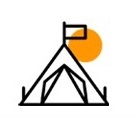
Get Yourself Fit
Nutrition tips, things to take, health & safety.
- Accommodations at Trek: All accommodations on the trek will be on twin sharing basis in Tents or Homestays. Any accommodation in a hotel/guest house/hostel will be in a budget hotel.
- Trek Leader and Guides: An experienced and certified Trek Leader , as well as a professional guide, will accompany you for the trek. The team will have years of experience and well equipped for any emergency situation.
- Services of a Professional Trekking Team: A team of an experienced Cook, Camp Staff, Porters/Mules will accompany you for all the arrangements on the trek .
- Meals: All Meals on the Trek are included. We will serve Vegetarian Indian food on the trek which will be cooked by our high altitude chefs. It will be a five-course meal plan.
- Camping and Safety Equipment: All the camping equipment such as Tents, Sleeping bags, Toilet Tents, Dining Tent, Mattresses, and other things will be provided by us and we guarantee the quality. Safety Equipment including Medical kit, Oxygen Cylinder, Oximeter, Crampons & Gaiters(if required) will be provided by us. We recommend you to bring your own sleeping bags if possible.
- Trek Permits and Forest Camping Charges: Only for Indian Clients, All the applicable trekking permits, Camping Charges, Forest Entry Fee, etc will be paid by us. Foreigners have to pay these charges if not mentioned.
- Portage of Personal Bags(Offloading): We highly advise you to carry your own burden (your rucksack) but due to any reason, if you wish to not carry your rucksack, we can arrange for a porter/mule to carry it. For this service, you will be charged over and above the trek cost. The charges for offloading vary with every trek.
- A Life-Changing Experience: We assure you that by trekking in the Himalayas you will have a life-changing experience and we will do everything we can to provide you with the best services and make your venture in the wild an unforgettable one.
Note: Prior to booking any adventure with Trekmunk, it will be mandatory to sign the waiver form and get a medical certificate from a doctor in due time, without these, you will not be allowed to start the trek. All this will be done online without using any paper.
- GST and Other Taxes: The goods and services tax is not included in the price mentioned with the trek. They are subjected to change according to the government rules of India.
- Flights and Transportation: Flights or other means of transport are not included in the package. Transportation from Home city to Leh and Leh to Home city is not included in the package. Any expenses occurred during the journey are not included in the package cost.
- Personal Equipment: Your Rucksack, personal clothing, shoes, trek poles, and other personal trekking gear is not included in this package. You have to bring your own gear according to the weather and difficulty of the trek.
- Travel Insurance: Travel Insurance is not included in this package. We recommend you to have travel insurance before opting for such adventures. You can buy insurance from us while booking the trek, it is optional.
- Personal Expenses: Any personal expenses incurred (Laundry, Bottled Water, Beverages, Snacks, Orders at tea houses or dhabas, Tips for guides, Camera fees, etc) are not included in the package.
- Emergency Expenses: Any costs arising out of unforeseen circumstances such as accidents, bad weather, landslides, road conditions and any other circumstances beyond our control are not included in the package.
- Anything not mentioned in Inclusions of the package.
Cancellation Policy And More Information
Booking Terms:
1. Confirmation Policy :
Upon Booking, An invoice will be sent to your mail & within 12 to 24 hours the booking confirmation with additional details will be sent to your mail.
2. Cancellation Policy:
Note: Following Cancellation policy will be followed for departures booked on or before 31st May 2021-
1) Cancellation up to 7 days before the start date of the trek: Get a complete cash refund (minus 5% transaction fee). The money is refunded to the same bank account, credit, or debit card from where the payment was made.
2) Cancellation during the last 6 days before the start date of the trek, and not counting the day of the trek: Full refund with 100% of the trek fee in the form of a Trekmunk Trek Voucher. Valid for 1 year from the date of issue. Can be used on any Trekmunk trek.
3) Cancellation on the start day of the trek, or no show on the start day of the trek : Unfortunately, no refund.
For more details, go to https://www.trekmunk.com/cancellation-policy
3. Refund Policy:
Any refund applicable will be processed within 10 to 15 business days as per the company policy.
4. Postpone/Transfer of a booked trek:
1. You can postpone your booked trek for a period of two months (61 days) but we will charge a 20% processing fee. The last date for the postponement will be 15 days before the start of the trek. Failing to book the slot in 2 months (61 days) time, would be considered a cancellation with no refund of any kind. Postpone of a booked trek can only be done once.
2. You can transfer your booked slot for the trek to any fit person till 15 days before the trek. You just have to mail us the request and rest we will handle. The new person has to get all the mandatory documents duly signed for the trek.
More Information:
1. We Trek for a Cause : For overall development of the areas we run our operations in, we donate Rs 100/- per booking from our profits which are used for the upliftment of the local people and conserving nature. We have named this initiative as - Trek for a Cause. For more details, follow: https://www.trekmunk.com/trek-for-a-cause
2. We are paperless : We are focusing on Sustainable Tourism and to do that we are trying all measures to convert our trek operations to be Eco-Friendly. Going Paperless is one step closer to our aim.
3. Single-Use Plastic : Trekmunk does not encourage the use of single-use plastic items. We are ensuring that our team is working together to reduce the problem and educate those around them. We will send you instructions on how to go plastic-free on your adventures.
4. Preparing for your Holiday : Getting some additional exercise makes a lot of sense to spend time before coming on a trekking adventure. The fitter you are, the more enjoyable you will find the experience. Hiking in the hill country is the best training but jogging, squash and swimming are also good for developing cardiovascular fitness and stamina. To read more on how to get fit, follow: https://www.trekmunk.com/get-fit-for-trek
5. Electricity Supply & Plug : You will get electricity supply till the starting point of the trek. If not Indian, We recommend you check if you require an adaptor for your electrical items at: http://www.worldstandards.eu/electricity/plugs-and-sockets/
6. Currency: The unit of currency in India is the Indian Rupees.
7. Health & Vaccinations:
Severe Allergies : If you have a severe allergy please inform the Trekmunk office before you travel. We will do all we can to help, but we cannot guarantee an allergy-free environment on trekmunk trips. You will need to carry your own treatment for the allergy with you, as 'adrenaline auto-injectors' are not carried as standard by our leaders and staff. You should inform your leader on the arrival of your allergy, and let them know where you keep your adrenaline pen.
Vaccinations : You should contact your doctor or travel clinic to check whether you require any specific vaccinations or other preventive measures. You should be up to date with routine courses and boosters as recommended e.g. diphtheria-tetanus-polio and measles-mumps-rubella, along with hepatitis A and typhoid. Malarial prophylaxis is not usually required for trips in the mountains, however, if you are visiting rural and remote low lying areas then they might be necessary.
8. Passport & Visas/Identity Proofs : If foreigner, Validity for 6 months, should have blank pages, and should be kept with yourself all the time.
9. Water : If you are on a trekking or cycling holiday, water is supplied to fill up your individual bottles. This will be boiled or filtered. Additionally, you should take purification tablets or a filter bottle (such as a LifeStraw, Sawyer Filter) to treat your water when in towns or where water is not supplied. We do not encourage the purchasing of single-use plastic bottles.
10. Altitude : This adventure involves going to a very high altitude. This is not something that you should worry about; the human body is quite capable of adapting to a very wide range of altitudes, but it is important that we follow some simple rules in order to acclimatize successfully. We will send you the information in your mailbox about Acute Mountain Sickness and trekking in high altitudes. On this trip, we carry bottled oxygen for use in emergencies.
11. Guidance on Tipping : Tipping is the accepted way of saying thank you for good service. Normally the guide and any other trek staff are given their tips at the end of the trek and this is best done as a group. The main guide will make sure that the tip is appropriately distributed among all the staff members on the trek.
12. Spending/Emergency Money : Approximately Rs. 8000-10000/- (in Indian Currency)should be carried for miscellaneous expenses including porter and trek crew tips, drinks, soft drinks, etc. We recommend that you carry your travel money in the form of cash as the availability of ATM is less in these remote areas. This can also serve as your emergency spending money.
13. Travel Insurance : It is recommended to have travel insurance for these kinds of adventures. When taking out insurance please ensure the policy you choose covers you for the activities and altitude included in your itinerary. We will ask for the Travel Insurance Details over a mail. Indians can buy insurance from us while booking the trek.
I and my friends went to Markha Valley trek with Trekmunk and we all had a great time. Walking up and down the hill, coming across some beautiful sites was mesmerizing. Staying in tents was so much fun. And our guide had all the knowledge about the trek. Trekmunk is really good w ...
I had an amazing trek with Trekmunk to Sandakphu November and December 2019. From the first moment of inquiry about the trek and all my questions were answered clearly and on time thanks to Dheeraj who managed to facilitate the trek quite well with his communication. Our guide Ar ...
I was bored with my regular 9 to 5 schedule and then I decided to seclude myself from the chaotic city life. So, I went to Brahmatal trek last month along with a couple of my friends. We went with Trekmunk and it was a lovely experience. The trek guide, Ramesh was very polite and ...
I and my friends went to Markha Valley trek with Trekmunk and we all had a great time. Walking up and down the hill, coming across some beautiful sites was mesmerizing. Staying in tents was so much fun. And our guide had all the knowledge about the trek. Trekmunk is really good with its food and accommodation facilities. I highly recommend Trekmunk. Kudos to their Team.
I had an amazing trek with Trekmunk to Sandakphu November and December 2019. From the first moment of inquiry about the trek and all my questions were answered clearly and on time thanks to Dheeraj who managed to facilitate the trek quite well with his communication. Our guide Arpan was very experienced, calm, patient and very helpful to each trekker's needs in the group. He facilitated to find and hire a porter for me once I needed one although we were in the middle of the trail. He also arranged emergency transportation when I had to cut the trek and go back home for an urgent matter. I really enjoyed their service and I would like to repeat the same trek or try other treks with them again.
I was bored with my regular 9 to 5 schedule and then I decided to seclude myself from the chaotic city life. So, I went to Brahmatal trek last month along with a couple of my friends. We went with Trekmunk and it was a lovely experience. The trek guide, Ramesh was very polite and helpful. The food and snacks were amazing. The activities in the campsite during our overnight stay is something that I am gonna cherish my entire life. I am waiting for my next trek with Trekmunk.
Chadar trek is considered to be one of the most difficult and dangerous treks, which requires a lot of skilled trek leaders, a perfect guide and a strong team of porters. I choose Trekmunk for Chadar and they proved they are a perfect team. Highly skilled trek leaders, professional skiers, gave us details on how to walk on slippery ice. Professionally trained and certified with wilderness medication programs always ready to take your care in any condition and travelers themselves. One will enjoy their company, their travel stories and their way of leading a trek. Cheers to team Trekmunk.
Traveling with these people is surely an insanely enthralling experience. This is my second backpacking trip with these people and the way I had imagined backpacking to be has been fulfilled by them and they have given me surely more. The best thing about travelling with these people is that you understand the true meaning of travelling and experience it very closely. You are given great freedom but at the same time taking care of. You participate in the process of backpacking. You have a trip leader with you but he acts more like a friend as the days pass by! We attended the hornbill festival and did a wonderful trek to Dzukuo valley in Nagaland with the leadership of this group. You break the boundaries of yourself when you travel like a true traveller and that is possible with these people.

Related Blogs
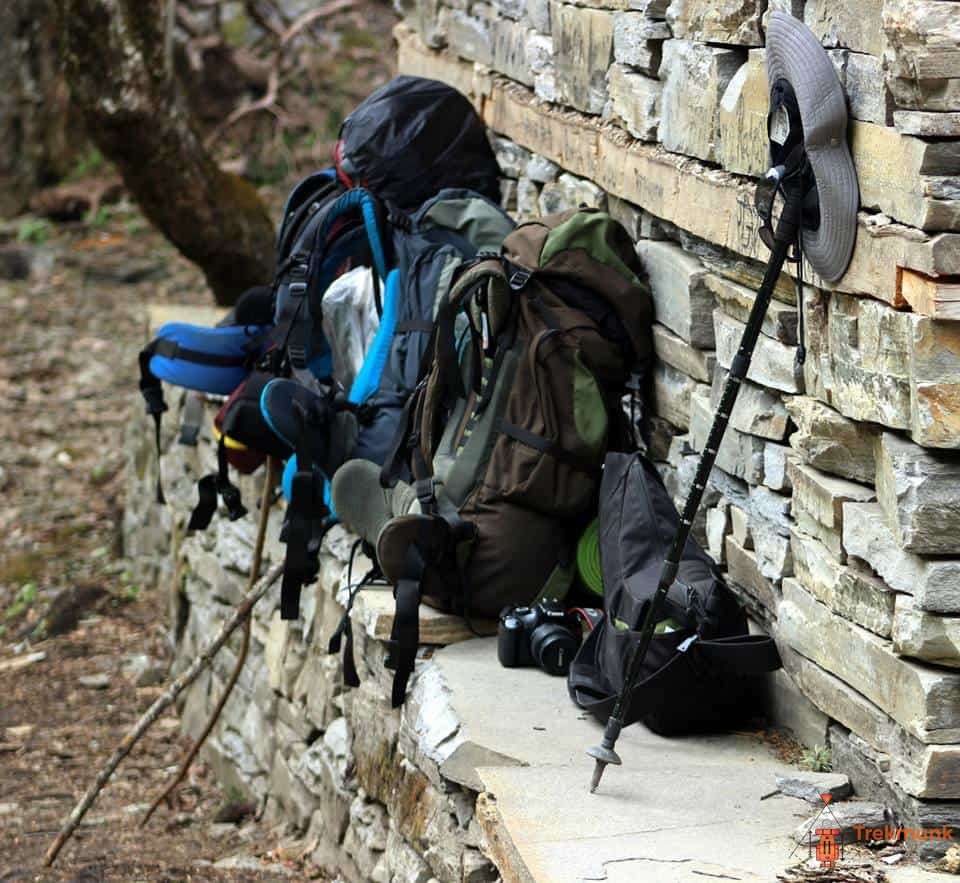
Related Tours
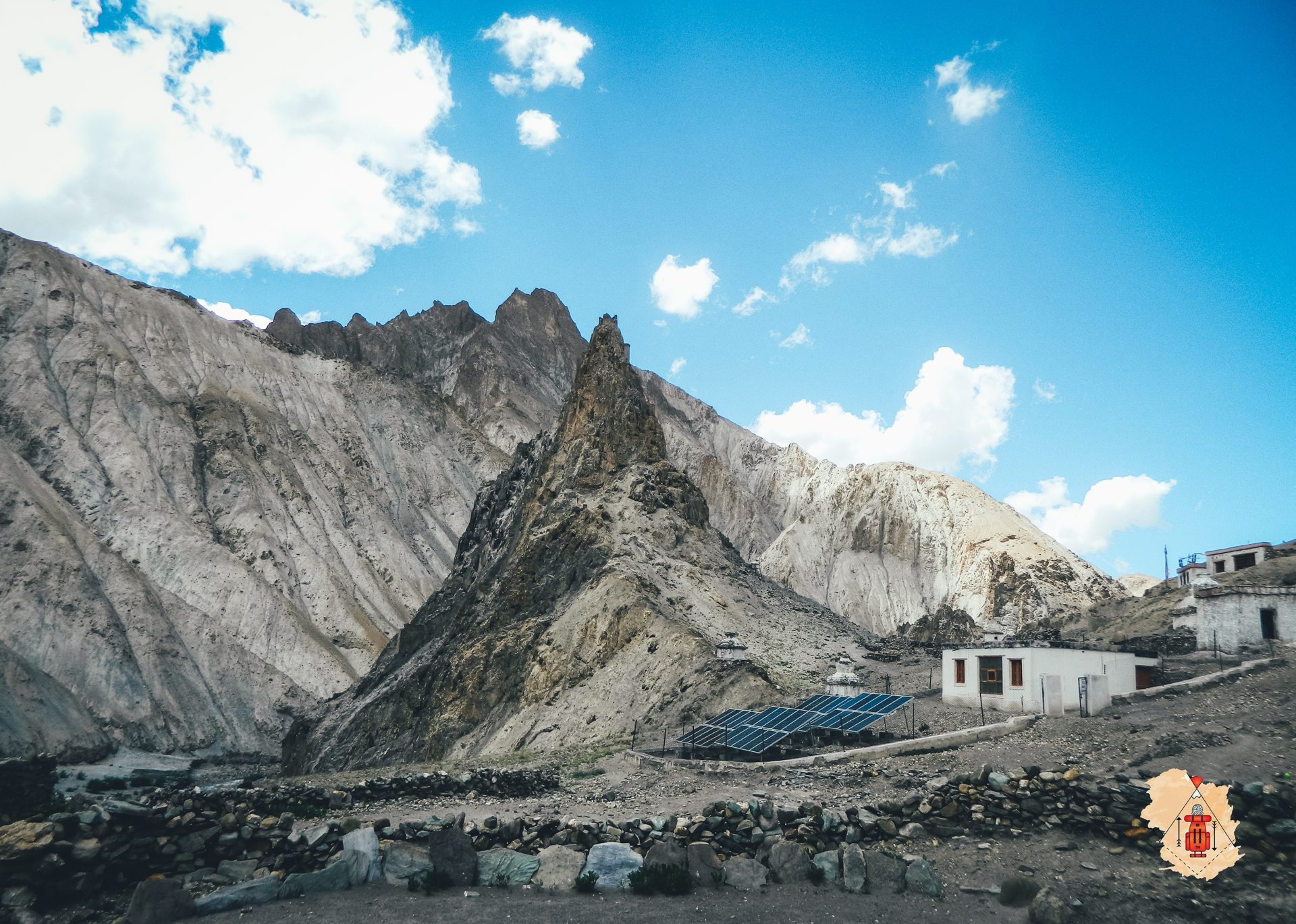
Markha Valley Trek
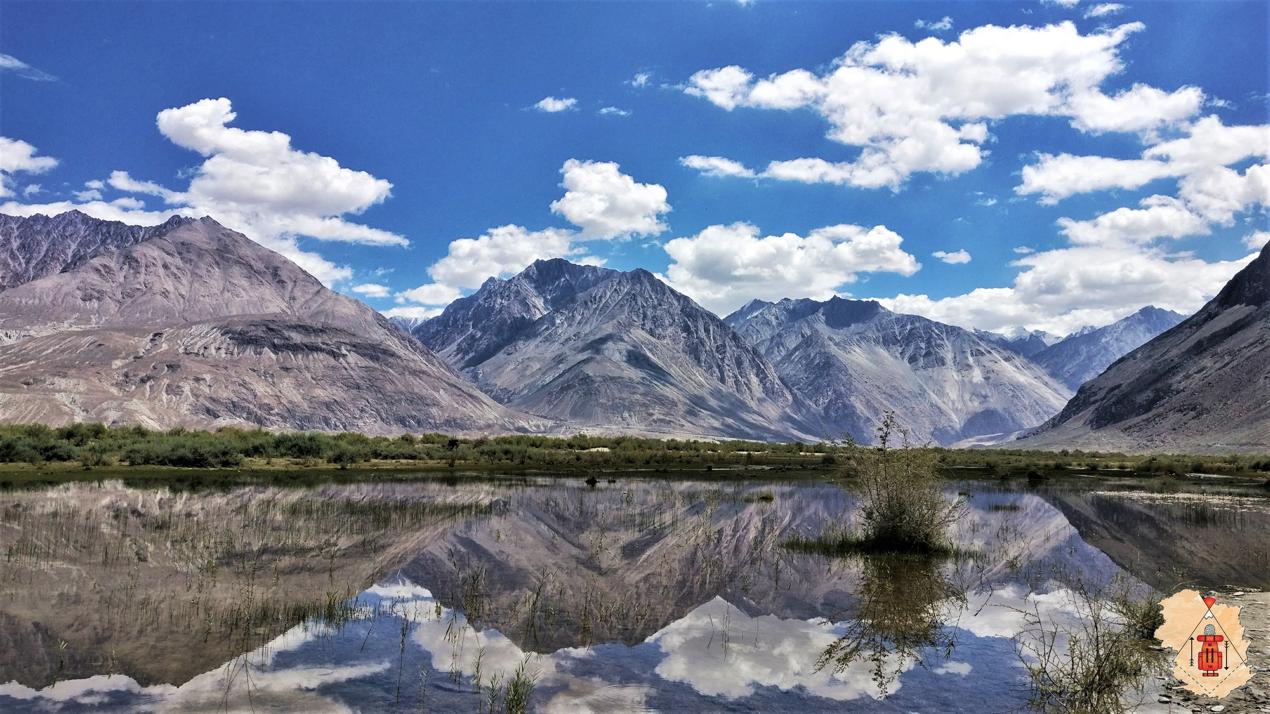
Saboo to Khaltsar Trek
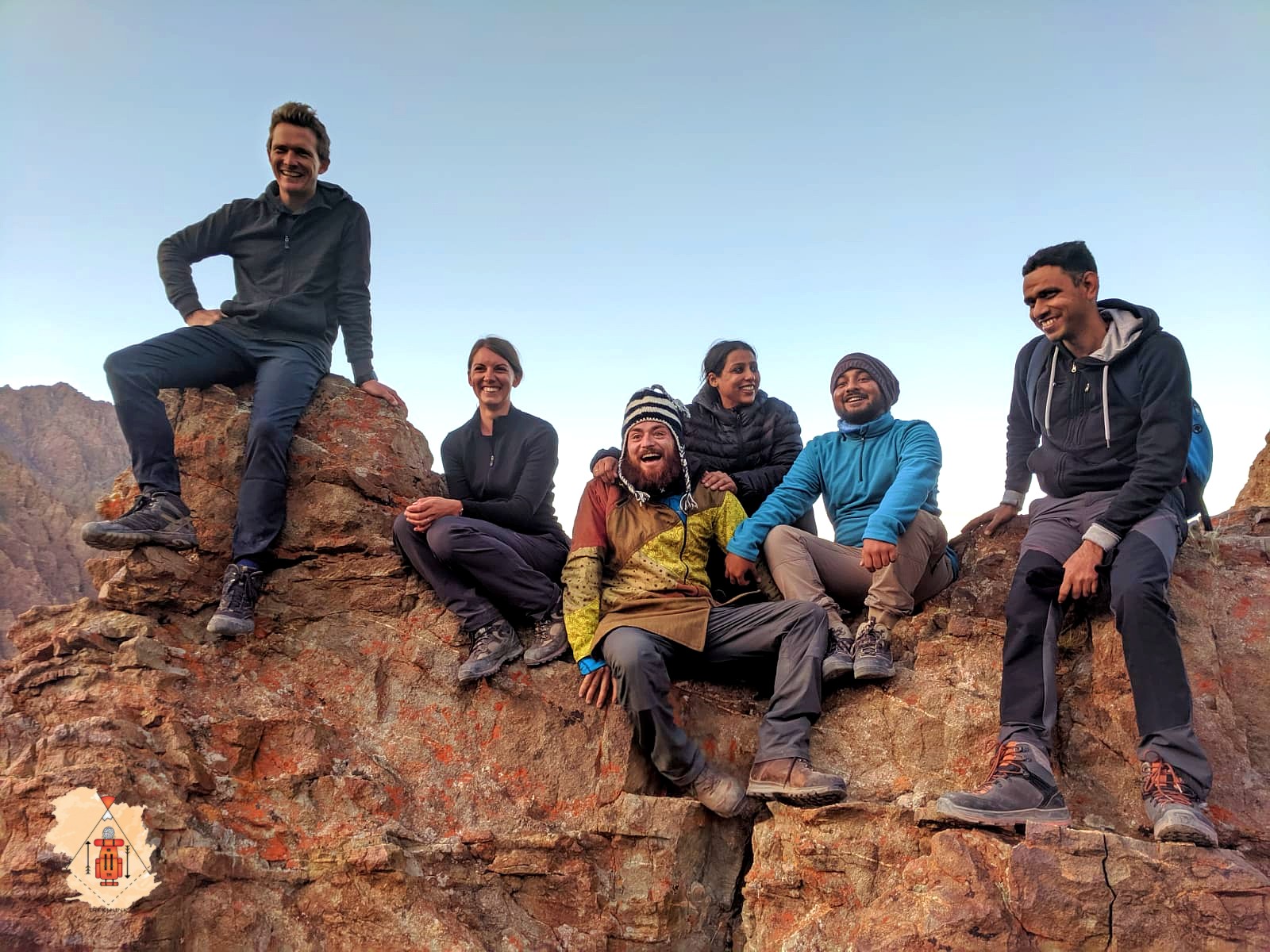
Sham Valley Trek
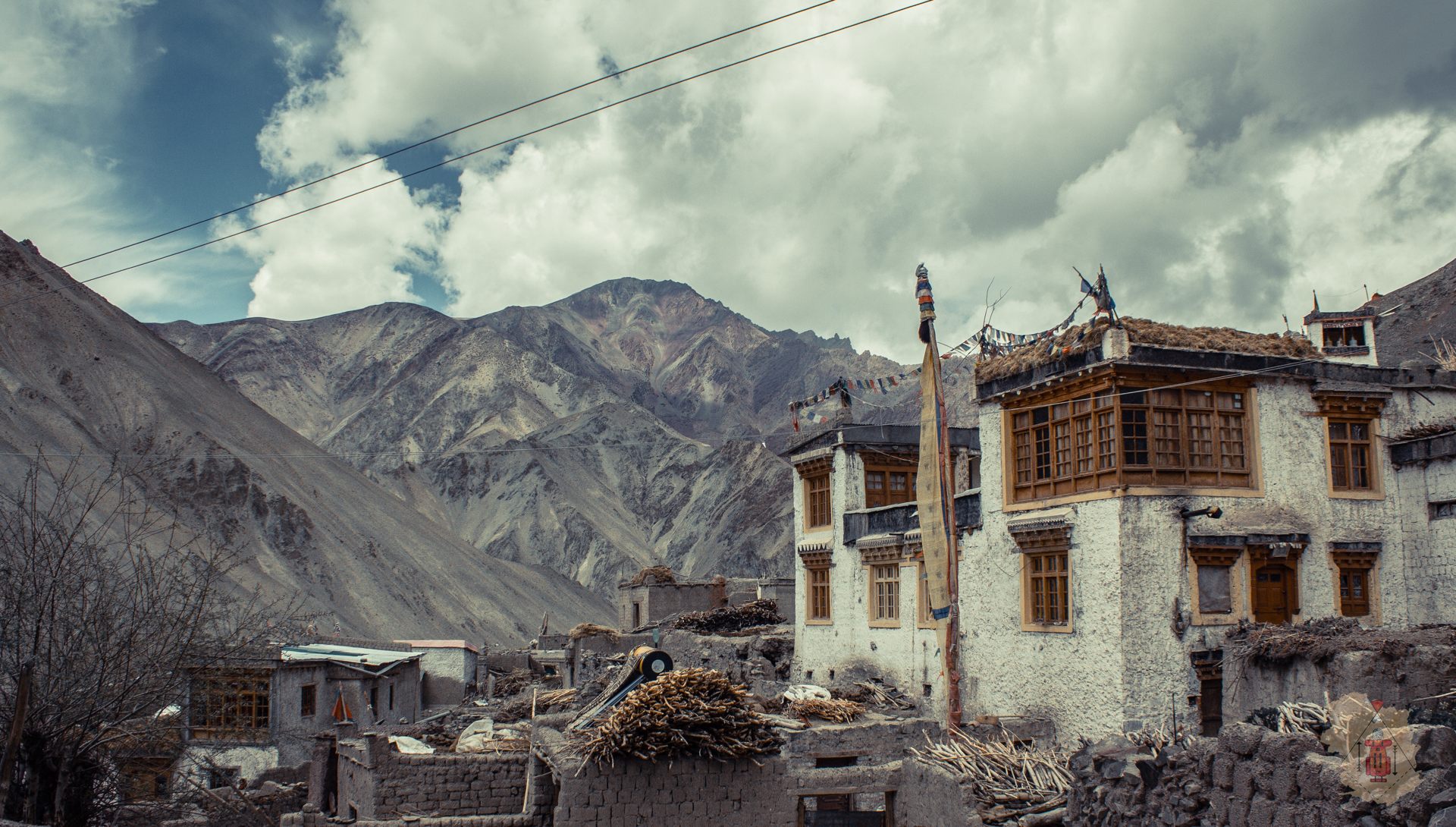
Snow Leopard Trek
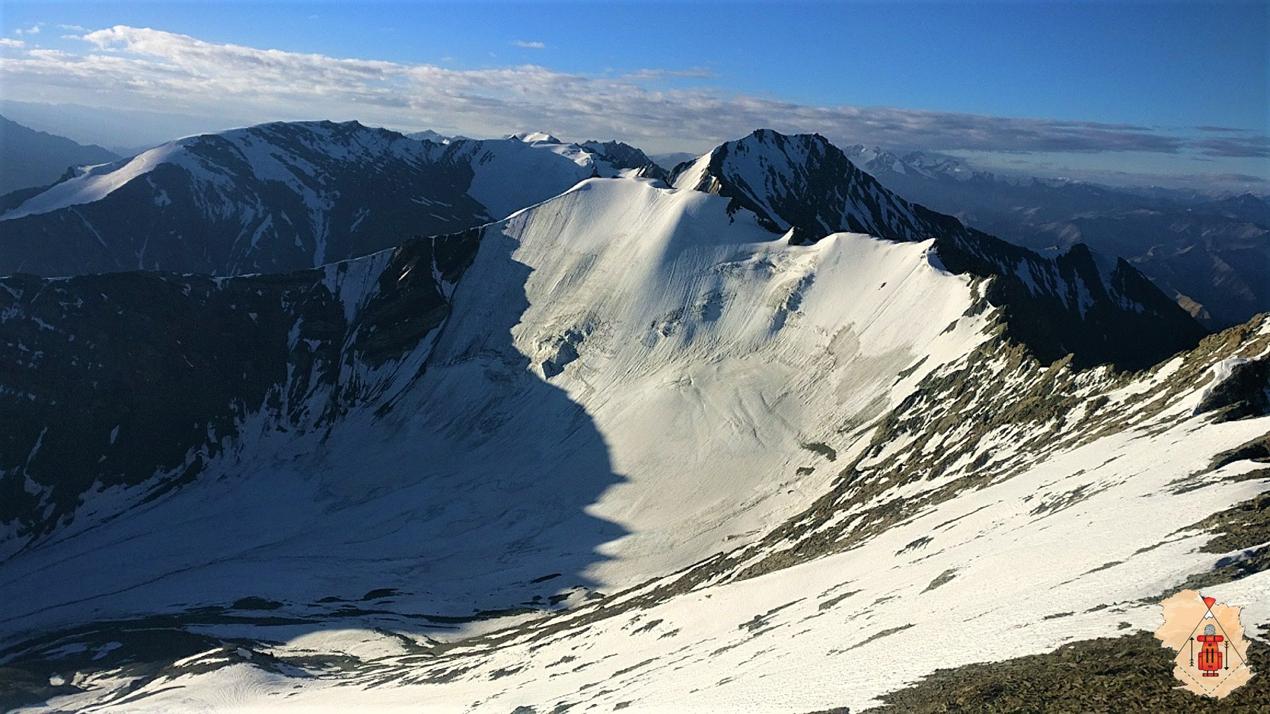
Stok Kangri Winter Expedition

"Trekmunk is changing the indian trekking industry"
"10 Most Promising Adventure Sporting and Trekking Companies - 2020"
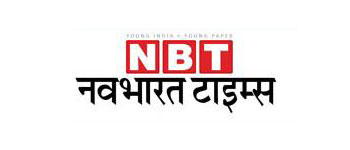
" Things you do for the Passion for Travel"
Hello there, How can we help you ?
Timing: 10 am to 6 pm IST (GMT +5:30)
Whats App Us

- Call Us +91 94590-18019 / 9816682570
- Mail Us [email protected]

Special Offer
Search Your package
Have A Query!
chadar trek
9 days/8 nights, -5°c to -30°c, fixed departure dates chadar trek, package price, chadar trek in ladakh.

Facing challenges in Chadar Trek is one of the best experiences of life. Trekking is truly bliss for those who want to try spontaneous and daring things. Chadar Trek is a challenging trek that every trekker must take once in a lifetime. Trekking on a frozen land with gigantic snowy mountains on one side is a dream come true for many people.
Located at a height of 11,150 ft. this trek will give a mesmerizing experience. It starts from the beautiful Leh region and goes up to 9 days to reach the final destination. You have to be ready to trek a distance of around 62 km in 9 days. Long walks near the snow-capped villages of Zanskar valley will make you love this region.
This trekking trail includes watching exotic animals in the frozen lands. Traversing through the dreamy patches of snow-covered lands can be defined as a story tale. Harsh and chilly winters will accompany you throughout the trip. Some of the best characteristics that define the Chadar trek include waterfalls, frozen rivers, snow-capped mountains, and wildlife.
You will also see many notable points on this trekking trip. They include Gurudwara Pathar Sahib and Magnetic Hill. The white sand is one of the most significant places to watch on this route. It resembles the cold desert of Ladakh with infinite land covered with snow from all sides. From majestic landscapes to beautiful Nerak waterfall, this trekking trip is the must-visit trip for every trekker.
Best time to do Chadar Trek
Chadar Trek is an arduous trek that you have to do between snow-covered mountains. You can peek at the winter season to see the true beauty of the Leh region during this trek. The best time to do Chadar Trek is between January and February. Many trekkers choose these months to enjoy the difficult modes of Chadar Trek.
Short Itinerary
Day 01: arrival in leh and stay in the guest house:, day 02: acclimatization day and stay in the guest house:, day 03: medical checkup at snm hospital-stay in the guest house:, day 04: lower shingra and somo paldar stay in tent:, day 05: trek to dib cave/tibb:, day 06: dib cave/tibb to camp at naerak frozen waterfall:, day 07: naerak to tibb/gaylpo:, day 08: trek from tibb cave to shingra koma and return to leh:, day 09: departure from leh :, detail itinerary.
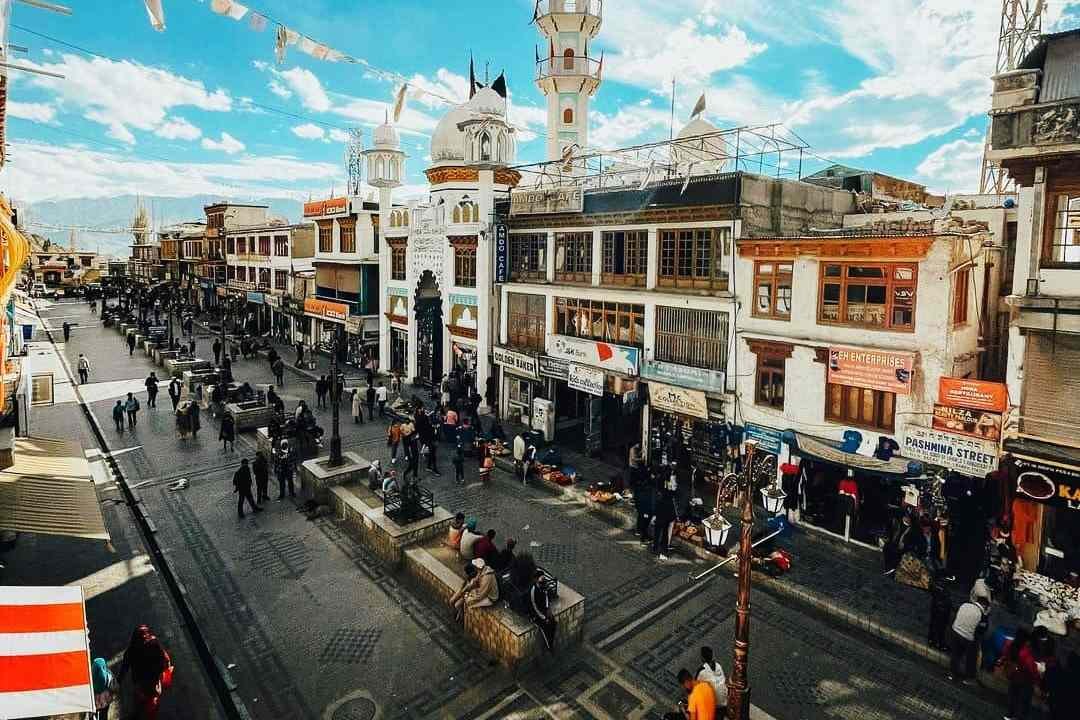
Day 01: Arrival in Leh (3500m) and stay in the guest house
Today, it is day 1 and we all have to arrive at Leh. This region is blessed with huge snow-capped mountains from every side. Leh is a mesmerizing spot that will take your breath away. You will suddenly feel the chilly touch of winter in the Leh region. Dress up with sweaters and thick jackets to protect your body from winter.
We will arrive at the guesthouse to rest and spend the full day. You can explore the beautiful Leh markets and buy some local stuff. Tonight, we have to spend time in the guesthouse and get prepared for the next day.
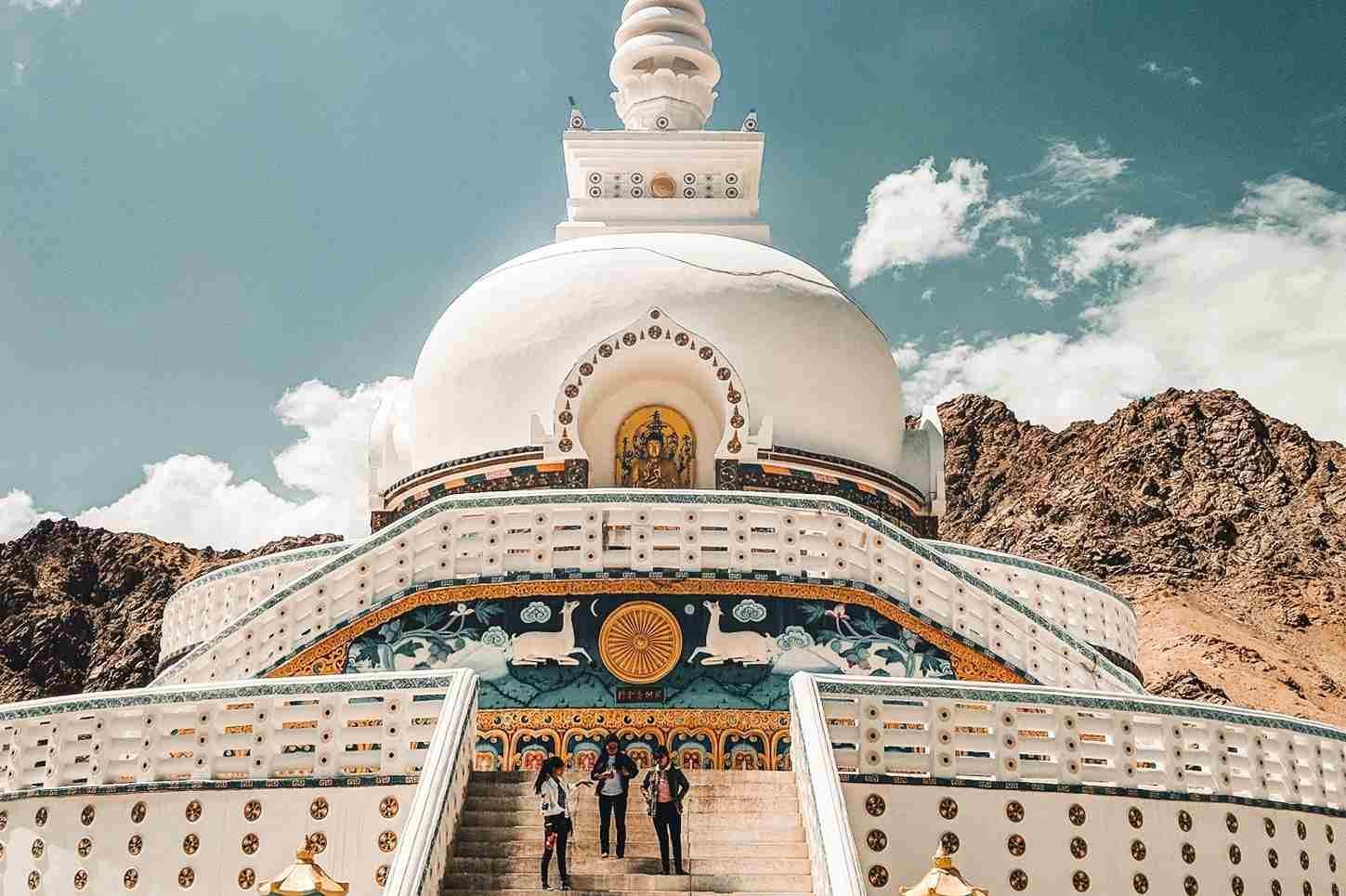
Day 02: Acclimatization day at a height of 11,400 ft. Stay in the Guest House
Acclimatization is an important thing for trekkers who are going for Chadar Trek. Even today, we will spend in Leh to acclimatize to the local weather. It is a mandatory rule to spend at least 2 days in the Leh region before Chadar Trek.
Just like on day 1, you can visit the local markets and some scenic spots of the Leh region. You can also visit the local sightseeing places to get an idea of the Leh region. Do not forget to wear warm clothes when you are visiting any spot of Leh as it is a very cold place located at a height of 11,400 ft. Same as day 1, we will spend the night in the guest house.
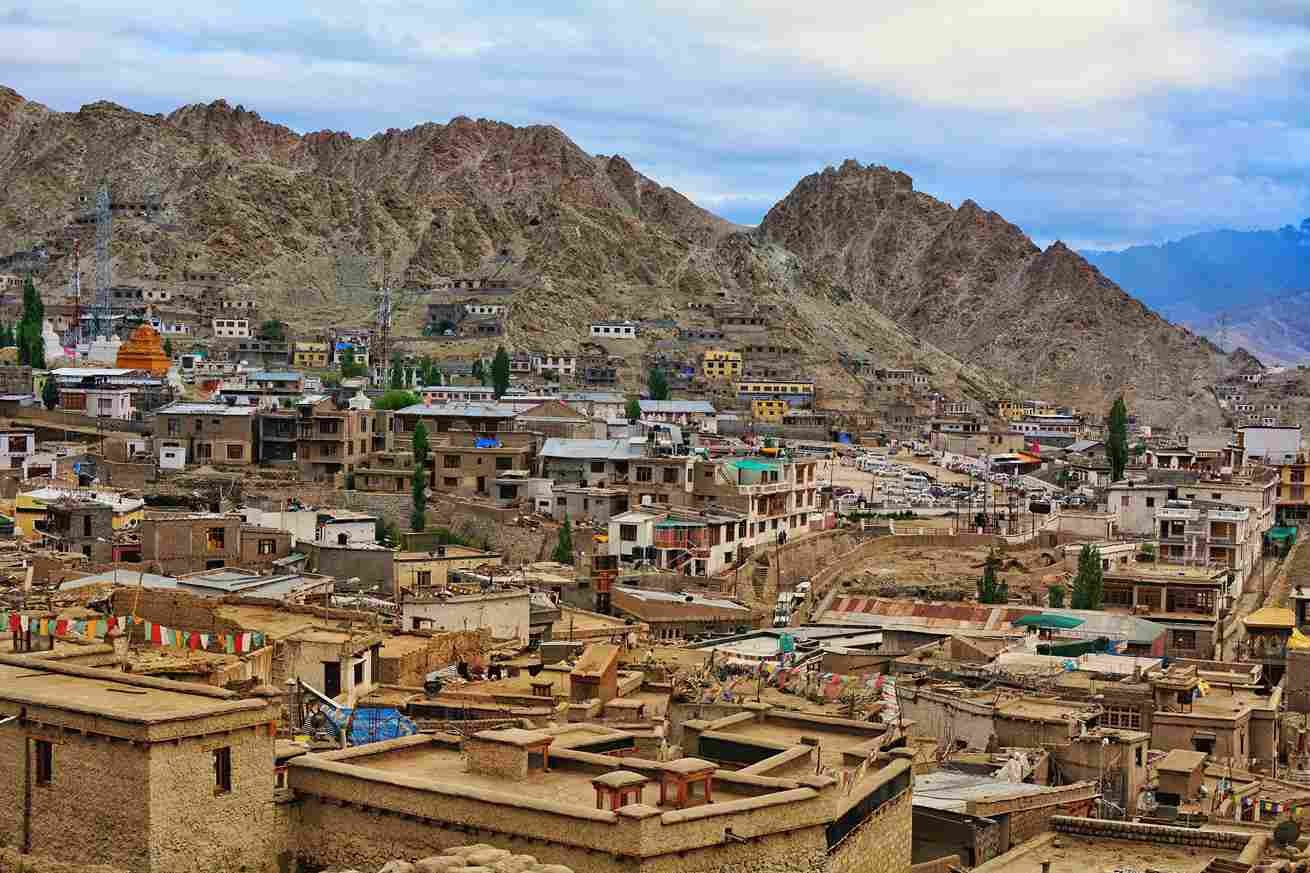
Day 03: A routine medical checkup at SNM Hospital-Stay in the Guest House
Day 3 is as important as the previous two days for trekkers who are going for the Chadar trek. Today, we will go for a medical test. This medical test will show whether the trekkers are fit to go further in the trekking trip.
If any trekker does not get a positive result, he/she will not be allowed to go trekking. This medical test is quick and takes a few minutes to show the results. We will spend tonight also in the guest house.
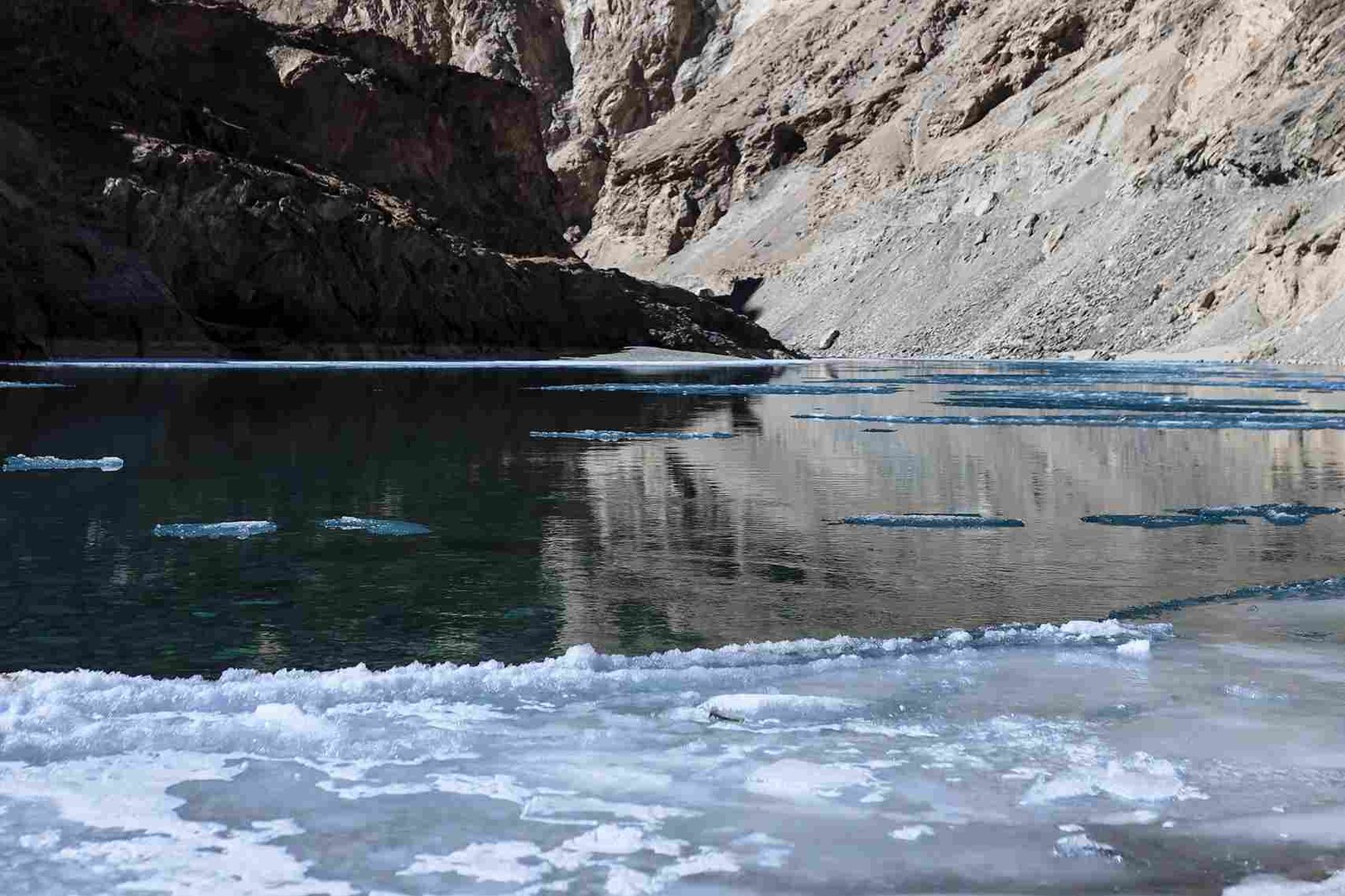
Day 04: Lower Shingra and Tsomo Paldar - Stay in tent
Altitude: 11,400 to 10,390 ft
Drive distance: 75 kilometers.
Time taken: 1.5 to 2 hours.
Trekking distance: 8 kilometers
Time taken: 4 to 5 hours
Trail type: Followed by Gurudwara Pathar Sahib
Trekking difficulty: Difficult
It is day 4 and today we are finally starting our trekking trip. Our first campsite for the day is Tsomo Paldar through Shingra Koma. We will drive for a distance of about 75 km near Gurudwara Pathar Sahib and Magnetic Hill. These are some breathtaking places in Ladakh not to miss. You will also see many other beautiful spots on this trip in your drive.
We will get down from the car to click some amazing pictures of these sights. We will reach Shingra Koma after a driving time of 4 hours. After reaching Shingra Koma, we have to start trekking to reach Zanskar.
You will come across many rock formations on the way to Zanskar. There is a continuous lining of icy roads waiting for you to step on them. However, you must walk slowly to know the fragile surfaces.
You can use your walking stick to check the ice patterns. We will reach Zanskar by walking on these icy roads. Now, you have to walk on a difficult road for 1 and a half hours to reach Tsomo Paldar. Route to our campsite Tsomo Paldar is one of the most challenging paths that you must pass to gain good experience for further trips. Spend the beautiful as well as a tiring night at Tsomo Paldar campsite.
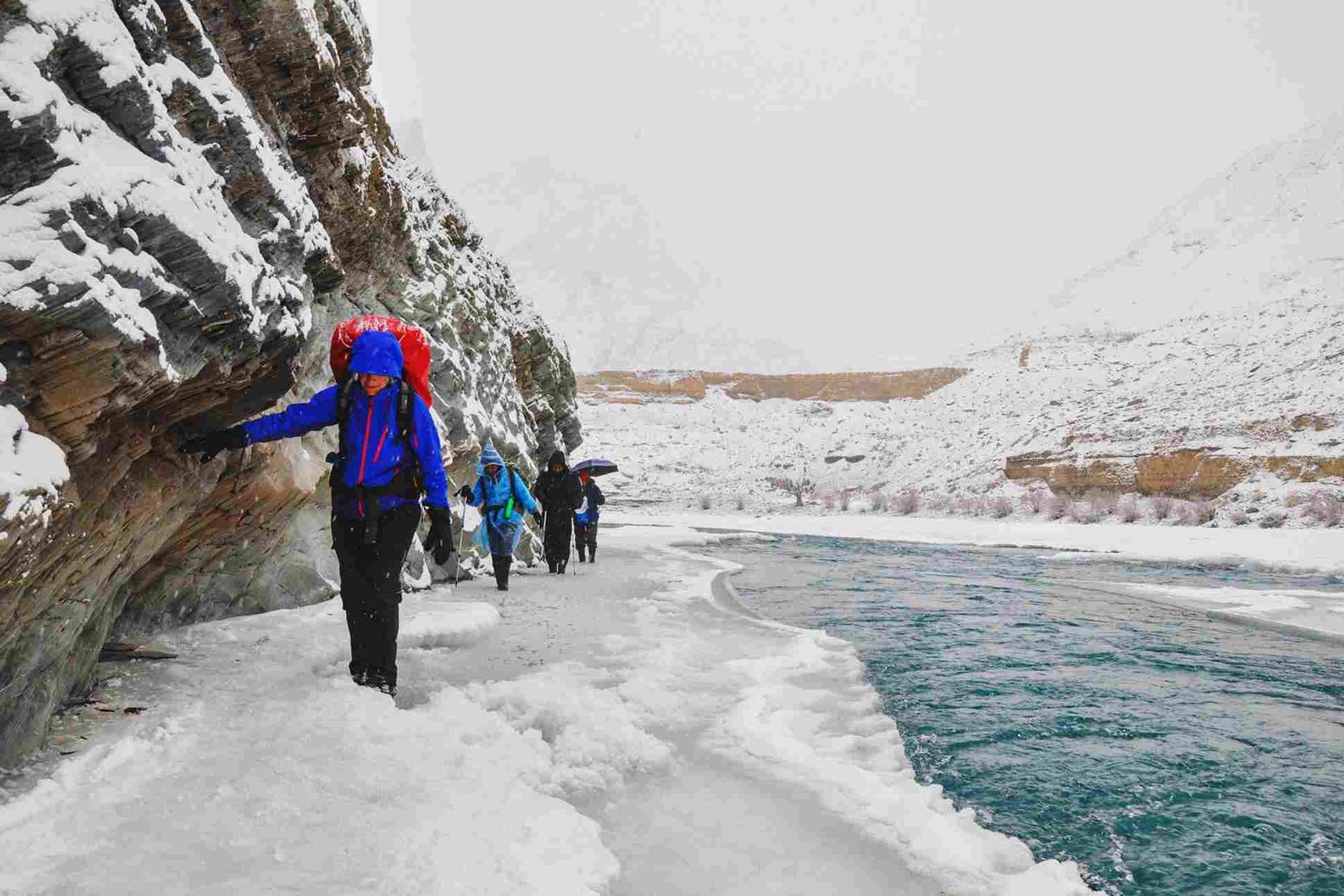
Day 05: Trek to Dib Cave/Tibb -
Altitude: 10,550 - 10,760 ft.
Trekking distance: 15 kilometers
Time taken: 6 to 7 hours
Trail type: Followed by Zanskar waterfalls
Trekking difficulty: Difficult
As we do on normal days, our trip will start early after breakfast. Chadar Trek distance is long as well as tiring but it is fun too. We have to move every step carefully on this trekking trail because of various ups and downs on the way. Today, we have to trek a long day to reach our next campsite which is Tibb Cave.
One of the most fascinating things about this trek is the Zanskar waterfalls. You will come across many frozen waterfalls on your route to Tibb Cave. These waterfalls have interesting stories that you will come to know from the locals while traveling on this route.
Zanskar waterfalls will follow you at every phase of this trek. Looking at the constant flow of green waters of Zanskar waterfalls leaves a wonderful impact on your mind. After crossing the Zanskar waterfalls, we will take a break and enjoy our lunch. After lunch, we will start our trip again to Tibb Cave.
As we go further on this route, you will see various rock patterns. These rock patterns look artistic under direct sun rays that give a soothing touch to your mind and body. Finally, we will reach Tibb Cave after a long journey. Our night stay will be in tents at Tibb Cave.
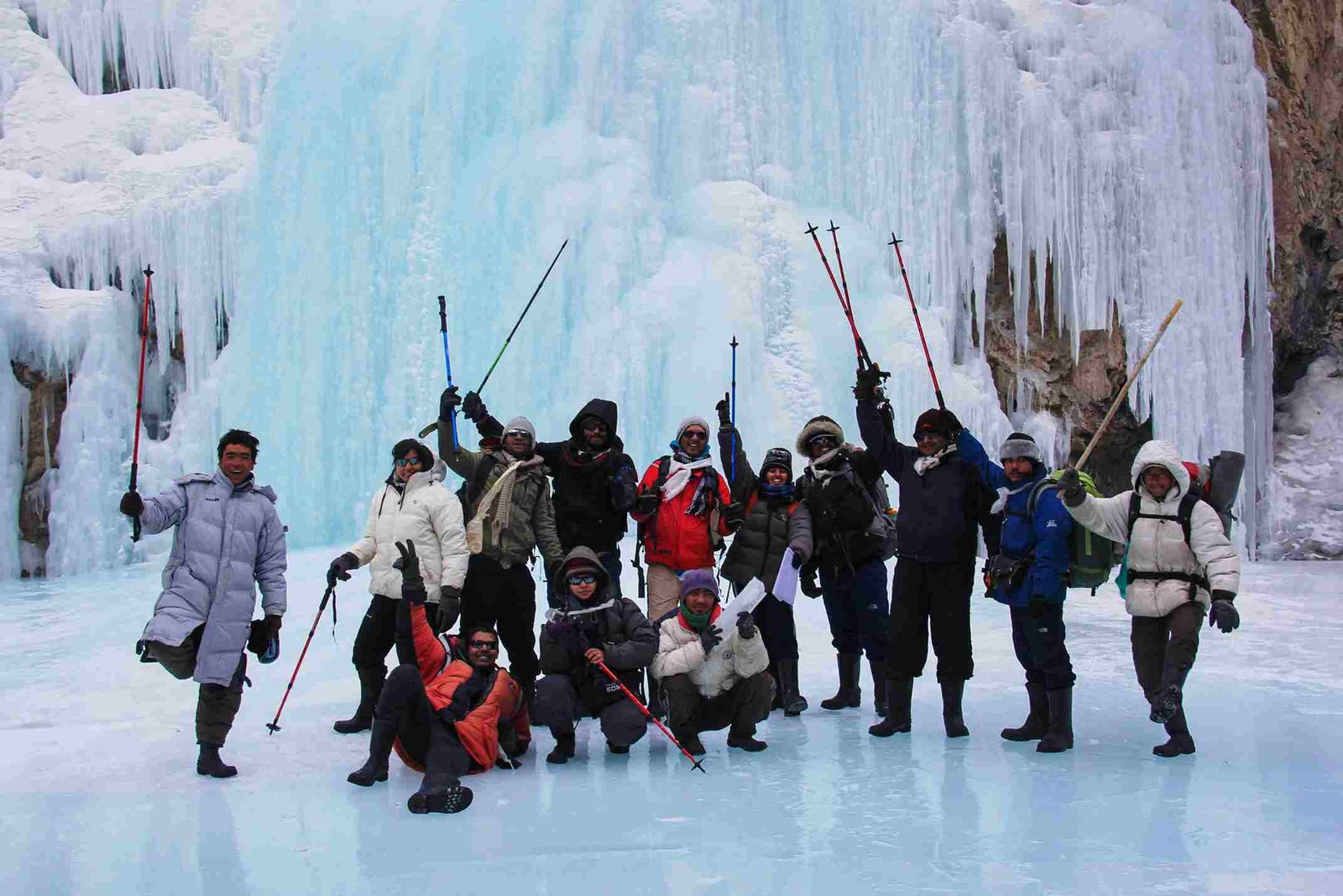
Day 06: Dib Cave/Tibb to Camp at Naerak frozen Waterfall
Altitude: 10,760 ft. to 11,150 ft .
Trekking distance: 12.5 kilometers
Time taken: 6 to 7 hours
Trail type: Followed by Zanskar region
Today, we have to cover a long journey starting from our campsite Tibb Cave to Nerak. We have to walk about 13 km on the icy path to watch the most beautiful point of the Chadar trek, Nerak waterfall. This waterfall is a soul-soothing point that attracts many trekkers from all over the world. After walking for 3 to 4 hours on this route, we will have our lunch.
After lunch, our journey to Nerak waterfall starts. Nerak waterfall has the coldest weather which can drop to even -30 degrees Celsius at night. Isn’t it exciting to trek in the chilly atmosphere of Nerak waterfalls? We recommend wearing thick woolen jackets to protect your body from harsh weather.
We will reach Nerak waterfalls in the evening. It is one of the most iconic places that must form a part of your camera. The dreamy and frozen waterfall of Nerak will transport you into the world of dreams. We will also visit the nearby Nerak village if time permits.
Our campsite for tonight is just 20 minutes away from this iconic waterfall. We will talk about this wonderful place and enjoy a sound sleep with amazing memories in our hearts.
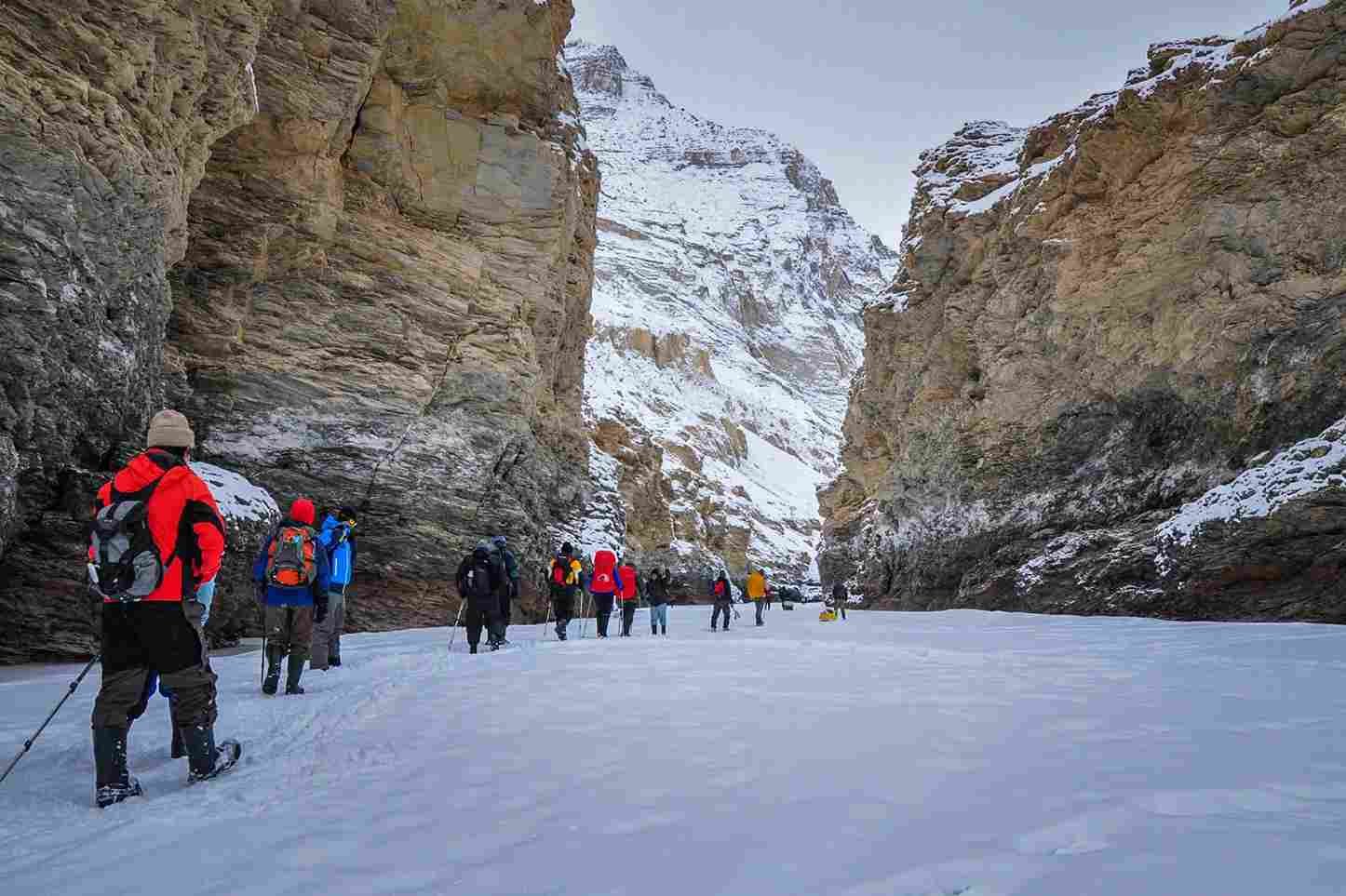
Day 07: Naerak to Tibb/Gaylpo
Altitude: 11,150 ft. to 10,760 ft.
Trekking distance: 14.5 kilometers
Today, we will return from the wonderful Nerak waterfalls to Tibb Cave. We will start our trip after breakfast. But today, you will see a great change in temperature on various routes. The temperature will differ slightly from the day on which we traveled to Nerak waterfalls. You will see a surprising change in layers of formation on this road. This pattern is just a mesmerizing and unforgettable view.
The Chadar trek is one of the most thrilling experiences for every trekker. As far as possible, try to capture every moment of Nerak waterfalls and Tibb Cave on your mobile phone. You might not get this golden chance again in your life. We will stay at night in Tibb cave.
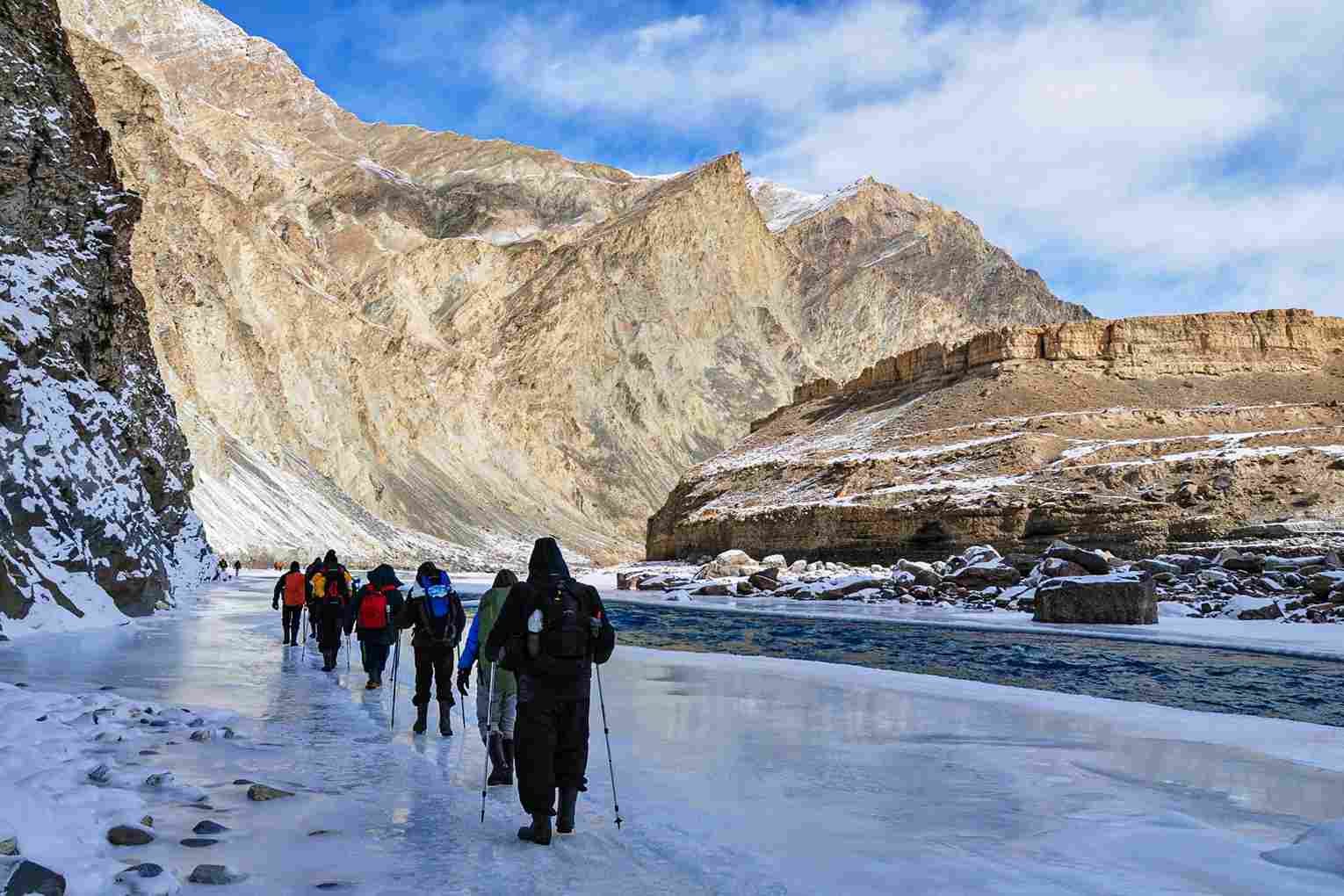
Day 08: Trek from Tibb Cave to Shingra Koma and return To Leh
Altitude: 10,390 ft. to 11,400 ft.
Trekking distance: 18 kilometers
Trail type: Followed by Shingra Koma
You must be prepared to walk a long way again today. We will start our return trip from Tibb Cave in the early hours of the morning. The path that we followed while climbing up to Tibb cave is not the same now. You will be able to see beautiful rocks precisely now.
From Tibb Cave, we will go upwards to Gyalpo and trek to Shingra Yokma. High mountain walls will surround you from both sides while walking on an icy road. If you are lucky, some animals such as Snow Leopard and Foxes might come on your way. This route is tough but gives a lot of beautiful things to view.
Majestic Chadar will again appear on your way. Do not miss watching this superb place again and capture it with your camera and heart. We will reach Leh by evening. We will have an overnight stay in a guest house at Leh. Enjoy a good sleep with a bunch of memories of the Chadar trek in your dreams.
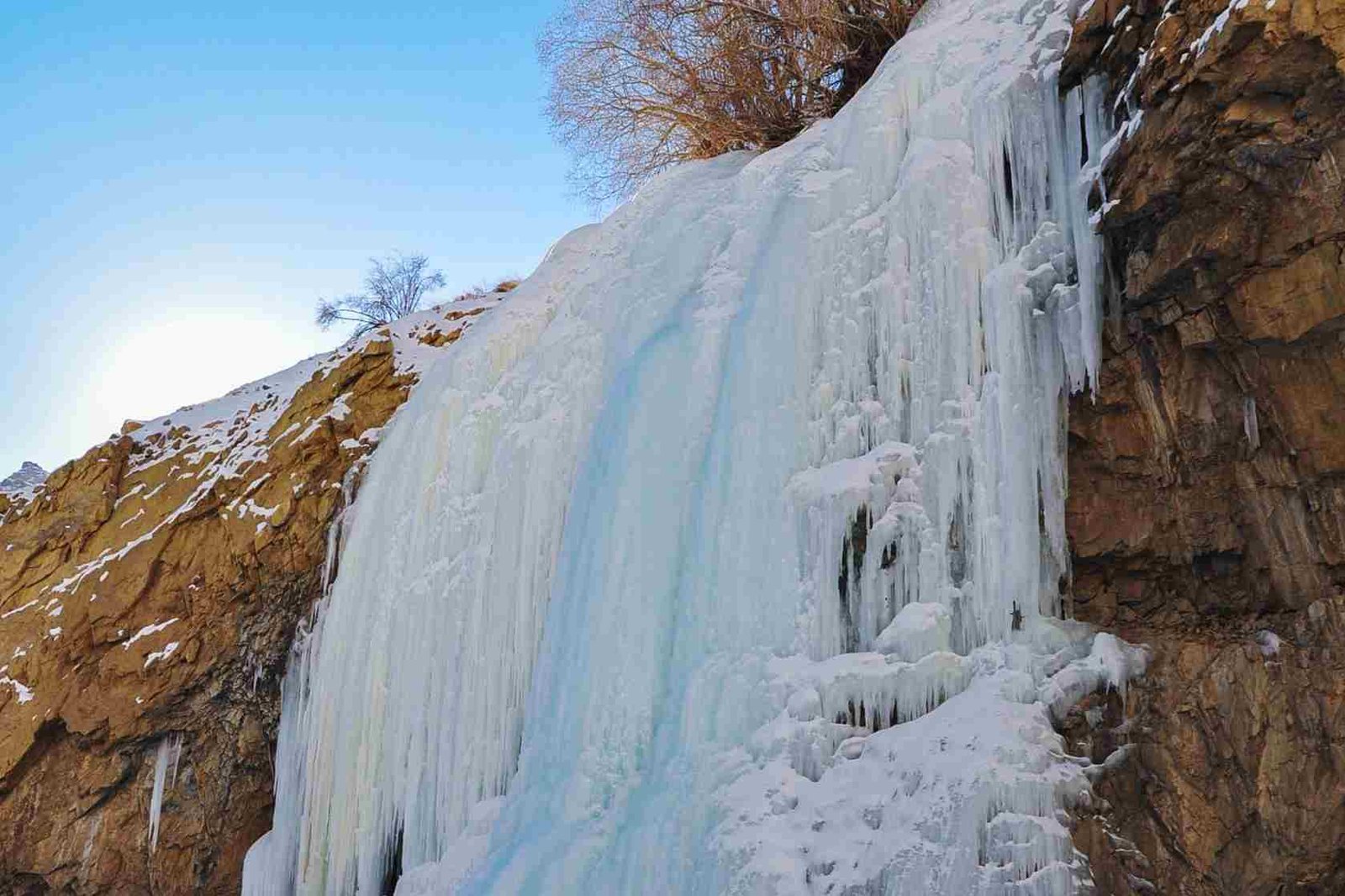
Day 09: Departure from Leh
Today is our last day. We will all separate with golden memories in our hearts and smiles on our faces. After breakfast, we will leave the guest house and go to the airport. Now, you have to continue the journey in a flight with stories of the wonderful Chadar Trek. Our Chadar trek package ends at Leh.
Inclusion And Exclusion
Things that are included in the trek package .
To make your Chadar trek more remarkable, we provide many things in our trek package such as:
- Sleeping mats, sleeping bags, and utensils for cooking
- Certified trekking staff
- Forest permits and campsite fees
- Accommodation charges at Leh on the first day
- Meals during the trek (Both veg and egg options)
- Standard porter for the whole group
- Transportation fees from Leh to Tibb cave and back
- Team insurance of Broza Adventures
- Pulleys, ropes, and other safety tools
Things that are not included in our trek package
Our trek package does not include the following things:
- Insurance for every trekker
- Meals are not included on days 1,2 and 3 at Leh.
- Porter for every trekker
- Other personal expenses
Fitness Required
Essential things to carry, frequently asked question, w hat is the average temperature of the chadar trek during the day .
During the day, the temperature of the Chadar trek can go down to -10 degrees Celsius. But sunrays will keep you warm for some hours.
Is the Chadar trek ideal for beginners?
No, the Chadar trek is the toughest in India with different temperature levels and difficult routes. A strict medical checkup is done to ensure whether a trekker can go for this trekking trail or not. Generally, this trekking is not suitable for beginners.
Will I need a walking stick to go for this trekking?
It is not necessary to take a walking stick on this trip. But getting a walking stick will help you to find a trekking pole easily. You can also make firm steps while walking on icy and slippery roads.
How difficult is the Chadar trek?
Chadar Trek is located at a massive altitude of 13,000 ft. This trekking trail has harsh climatic conditions at different points and zones. Trekkers will be tired after a long journey to reach this trek. So, this trek needs a strong physique with high endurance.
How long is the Chadar trek?
Chadar Trek is 65 miles or 105 km long (one way).
How many days are needed for Chadar Trek?
Chadar trek is a long trail of 9 days starting from Leh and ending at Leh. The best time to enjoy Chadar Trek is between November and March.
In which state is Chadar Trek?
Chadar Trek is a winter trail located in the union territory of Ladakh.
How to reach the Chadar trek?
You have to reach Leh to start your journey to Chadar Trek. You can reach Leh by flight, train, or car from Delhi.
How to prepare for the Chadar trek?
You will need high energy levels and better stamina to finish this winter trail. Some of the best tips to prepare for the Chadar Trek include daily exercise, walking, and jogging.
How to do the chadar trek?
Chadar Trek includes walking on the icy sheets and climbing on the icy rocks and boulders. You have to also take a rest in tents at night.
On which river is the Chadar trek carried out?
Chadar Trek is carried out on the frozen River Zanskar in Leh.
Where is the Chadar trek located?
Chadar trek is located in the union territory of Leh on the Zanskar River.
What is the Chadar trek in Ladakh famous for?
Chadar Trek is famous for the frozen River Zanskar which gives an unforgettable experience to the trekkers.
What is the Chadar trek?
Chadar Trek is a winter trail starting from Leh.
You will see a different pattern in weather conditions while going for Chadar Trek. The temperature in this trek goes down up to -25 degrees Celsius. You will witness snow-covered mountains, frozen rivers, and icy sheets during this period.
Our Terms & Conditions
At Broza Adventures, we are glad to take you on our adventurous trips. When it comes to booking tickets, please make sure that you read the below-given Terms and Conditions so that there is confusion in the future.
You can book your tickets with us over email, telephone, or simply by online transaction through our website. However, before making any payment make sure that you reach out to us to confirm that there is gladly available for you in the team.
Terms and Conditions:-
• Booking form- While filling up the application form, make sure you provide all the details correctly which should be complete and true.
• Late Booking of the tickets- There is no extra charge for late booking but you have to make your payment in full while you are looking for any of the trips with Broza Adventures.
• Payment and deposit money- Along with the booking application form, you will have to make a payment of 25%of for the trip per person. The balance money can be paid once on the arrival or before departure. The money shall be sent through bank transfer to our account, the details of which will be provided to you.
• Booking confirmation - Once we have received your advance money, we will reserve your seat on our team and we will make all the necessary arrangements for the trip and send you the confirmation in writing.
• Changes in information
In case there is any change that affects the information that you have provided in the application form then you must immediately inform us through mail or telephone. Failure to do so may result in the levy of extra charges by the government authorities which should be borne by you.
• Baggage and Luggage
We always advise the trekkers and travelers to carry as less things as possible as it makes your trip super smooth and easy. You should make all your efforts to make sure that your baggage weight does not cross 15kg. In case you carry more than the prescribed limits then you shall be responsible for the extra charges of the porter.
• Forced Cancellation
In case there is any war, riot, or dispute in the country or any terrorist attack, abnormal weather conditions, or natural disaster then in that case we will have to change or even cancel your travel arrangements and we will not pay you the compensation for the same.
• Cancellation Charges and refund policy
In case you want to cancel your bookings then it must be communicated to us in writing. However, if you are canceling your trekking booked by you before the period of 30 days of trekking then there will be a 5% deduction from the total cost tour.
If you are canceling the trek between 15-30 of the trekking date then 50% of the amount shall be deducted.
In case of cancellation in less than 15 days of the trek then there will be no cash refund from our side.
• Self-responsibility
We accept your booking on the assumption that you are physically and mentally prepared for trekking and other adventurous activities. You must accept all the risks that may be involved. In case of any medical conditions or any serious ailment, you must inform us before the booking. We reserve the right to refuse your booking in case your medical conditions are really serious.
• Insurance
We at Broza Adventures, expect that you are covered by proper insurance during the time of your trip with us. Please make sure that your insurance policy includes medical expenses, injury expenses, or even death.
• Problems or Complaints
In case you face any problem or if you have any complaint during the trip then you can at any time inform this to our leaders who will be leading you and your problems will be solved without any delay.
All the interested trekkers are expected to read the above-mentioned terms and conditions properly and understand them properly before paying the trekking fee. During the road journey and other adventure treks, the participants are advised to follow all the safety measures as will be mentioned by our team. Also, you must take care of all the equipment that is issued to you by Broza Adventures at the start of the journey, failing which you will be liable for the losses.
You can also reach out to us in case you want any more information regarding the trek.
What our participants say about chadar trek
Rate Us On Google / Click to read 250+ Reviews.
Other Treks Like chadar trek

beas kund trek
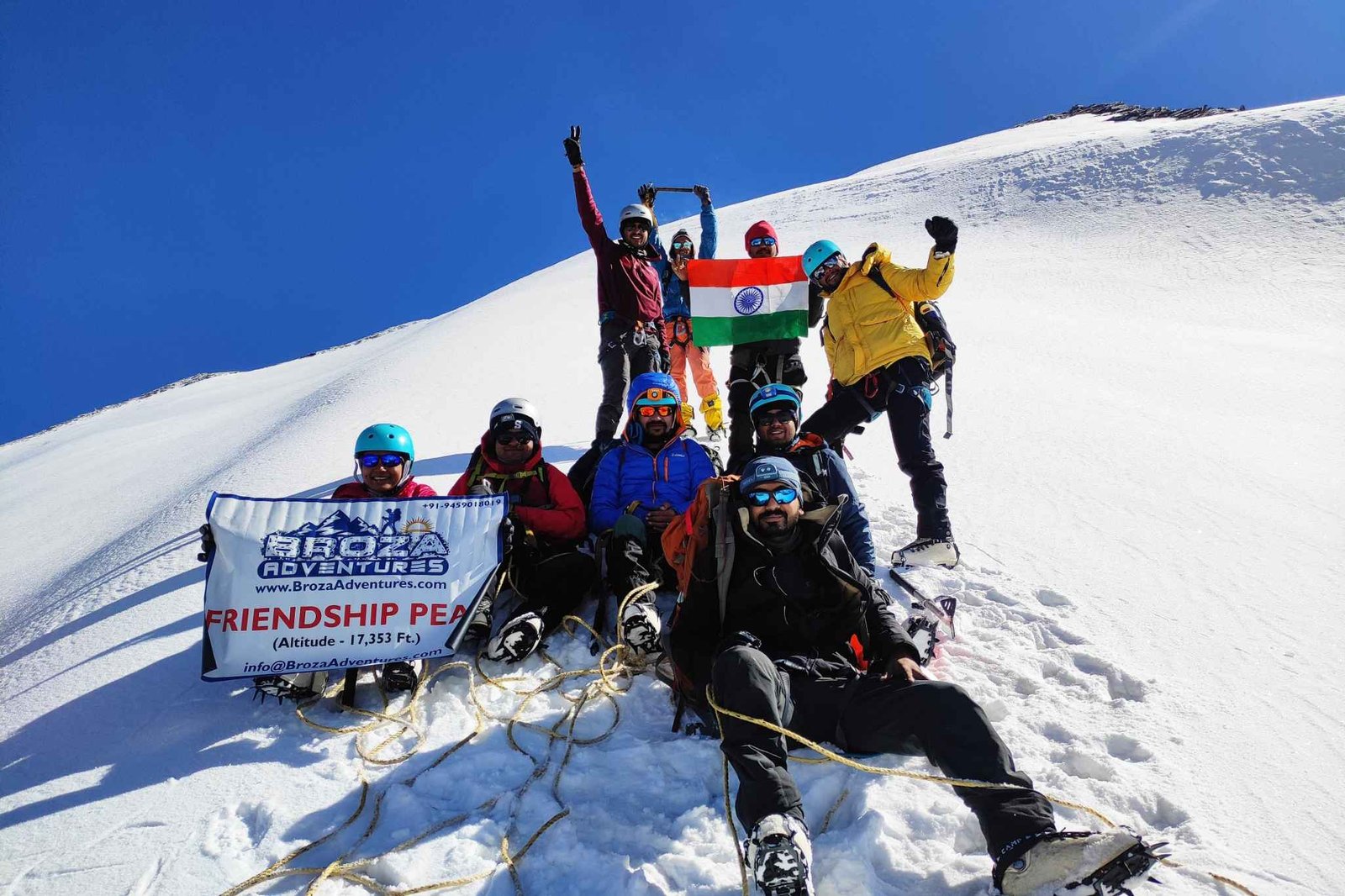
friendship peak expedition
Mount Friendshipp Peak in Manali becoming more famous for experience trekkers and beginners, this Expedition wil

rani sui lake trek
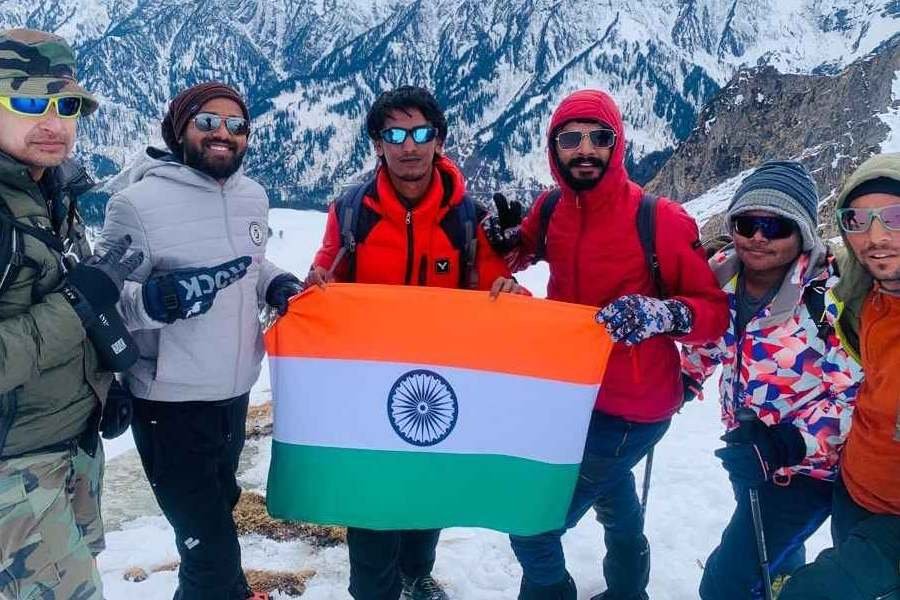
patalsu peak trek


IMAGES
VIDEO
COMMENTS
Experience the Chadar Trek Frozen River with Trek The Himalayas, India's Trusted Adventure Provider. Award-Winning Excellence, 4.8 Google Rating, 5400+ Reviews. ... Ladakh. Distance: 62 Km. Trail Type: Point to point trail ... Trek Distance: 3 km | 1-2 hr. Gumboots are mandatory. Carry two thermos flasks of 1 liter each.
Chadar Trek In Leh - over the Zanskar River range of Ladakh-2024- Complete information, Itinerary, Costs Date. Your trek journey started with Himalayan Hikers, beautiful mountain town of Leh, all our trekker reach Leh by flight this is best option to you reach to Leh, altitude is 11400 feet above sea level, the trek beautiful Zanskar River which liws totally frozen during the December to Feb ...
The exciting and adventurous Chadar Trek in Ladakh is a dream trek for most nature lovers and adventure enthusiasts. This awe-inspiring Chadar trek on the frozen river of Zanskar is a thrilling adventure experience of a lifetime. ... Trekking Distance: 62 Km Difficulty Level: High Altitude: 11,000 Feet Temperature: -5°C to -30°C Camps: Leh ...
The Chadar Trek or the Zanskar Gorge trek is a winter trail over the frozen Zanskar River, which lies in the Indian union territory of Ladakh. It is traditionally the only means of travel in the area during the harsh winter months. ... The overall distance is approximately 105 kilometres (65 mi) - an average trekker walks 16 kilometres (10 mi ...
Continuing the journey from Dib Cave/Tibb to the Camp at Naerak, the trek spans an altitude from 10,760 ft to 11,150 ft, covering a distance of 12.5 km. Experience the mesmerizing surroundings before resting for the night in tents.
Trekking Distance: 62 Km Temperature: In winter (January - February) - Day time temperature: -5°C to 0°C and Night time temperature: -30°C to -15°C. Chadar Trek in Ladakh is a unique experience, unlike any other trek in the Himalayas. Walking on a frozen river with towering mountains on either side is simply breathtaking.
Go on an ultimate adventure in 2024 with our Chadar Trek (Ladakh) guide. Experience the thrill of the frozen Zanskar River. Plan your trek! ... Distance: 60 - 65 kms; Difficulty: Difficult; Duration: 7-8 days; ... "Chadar Trek isn't just a journey; it's an experience that stays with you forever." ...
Best Time to Visit Chadar Trek. The ideal time to visit the Frozen River Chadar Trek is between mid-January to February as during this time the upper layer of the Zanskar River freezes. The river looks like a sheet of ice; hence, it is referred to in the local language as 'Chadar' which means blanket. Read more: Hidden Hill Stations In India.
It is a 6-day trek in inhospitable conditions. It is a trek over a frozen river in Ladakh. The average mean temperature during the day is minus 10. At the night, temperatures fall to minus 20 and 25. Ice forms break and change colour on the river every few hours. In places, the Chadar (or ice) does not form over the river.
The Chadar trek distance is 105 km long. The path is covered with a sheet of ice. Chadar trek temperature can go as low as -15 to -25°C. Unpredictable weather. ... As we know that the Chadar trek in Ladakh is the most challenging in India, we must remember that we should have an excellent fitness level to match the trek's requirements. ...
The Chadar trek Ladakh lets the trekkers walk on a thick layer of ice that covers the Zanskar river. It is not the only reason that draws thrill seekers to this fantastic attraction, but people are attracted to several other fascinating and ethereal sights. ... Trekking distance: 62 kilometers; Trail type: One-way trail. The trek commences and ...
The Chadar Trek is one of the most wild and beautiful hikes on the planet. Frequently covered by the world's top adventure channels and media outlets, the Chadar Trek takes hikers through a frozen river valley into the very heartland of India's Ladakh region. The region's harsh desert environment and towering mountains make the Chadar trek ...
Before embarking on the Chadar Trek, trekkers need to obtain the required permits from the Ladakh Tourism Department or local authorities. As per the new directives received from the local authorities in Leh, it is mandatory for all participants to undergo a medical examination at Leh and spend 3 nights in Leh before departure for the trek.
Discover the breathtaking Chadar Trek in Ladakh, a once-in-a-lifetime experience where you'll walk on frozen rivers and immerse yourself in the Himalayan winter wonderland. ... The trek covers a distance of around 105 kilometres, taking about 9 to 10 days to complete. However, these numbers hardly do justice to the sheer grandeur of the ...
The Chadar Trek, also known as the Zanskar Gorge Trek, is a 105-kilometre trek over the frozen Zanskar River in Ladakh, India. The trek lasts 15 days and is usually done between January and mid-February. While it is a thrilling adventure, it is also quite challenging. The trek is one of the most famous ones in the world but involves navigating ...
The Chadar Trek takes place in the winter months of January and February in the Zanskar region of Ladakh. The temperature during this time can be extremely cold, with daytime temperatures ranging from -5°C to -10°C and nighttime temperatures dropping to as low as -25°C to -30°C.
Chadar trek is one of the most unique and adventurous treks in the world. ... Srinagar, or other nearby towns in Himachal Pradesh or Jammu and Kashmir, to Leh, which is the nearest road head to the chadar trek. The road distance is about 475 km from Manali, and about 420 km from Srinagar, and the road duration is about two days, with a night ...
The Chadar Trek is undoubtedly one of our favourite Himalayan treks. The first time we heard about Chadar Frozen River Trek in Ladakh, we were intrigued. When I came to know about the conditions in which we have to trek, I was a bit sceptical. Just imagine walking on a frozen river for almost 8 hours a day at an altitude of almost 11,000 feet.
Chadar trek in the beautiful landscape of Ladakh is one of the most adventurous and most difficult treks in the country. The distance that is covered on foot is approximately 105 km and on an average, a trekker covers 15 to 17 km every day. The temperatures are usually 15 to 20 degrees during the day time and plummet to -25 to -35 degrees ...
Traverse the Zanskar River: Hike across a mesmerising expanse of the frozen river, aptly named "Chadar," a Hindi word for "sheet.". The glassy surface reflects the majestic Himalayas, creating a breathtaking panorama. Embrace the Challenge: At an altitude of 11,150 feet, the Chadar Trek offers a unique experience compared to high ...
Nearest Airport - Leh Airport, Ladakh. Chadar trek starts from a place Shingra Koma. The distance between Shingra Koma and Leh is around 70km and is covered in 3 hours. To begin the trek, one must first reach Leh, conveniently connected by air to major cities. Flying is the only option to reach Leh in winter.
Find your way through Ladakh with a different lens by pursuing this trek. The Chadar trek cost 54,500 rupees which covers all the inclusions from the base camp. The Chadar trek is your chance to pledge a connection with the majestic Himalayas, serene lakes, and rugged terrain. Trekmunk has the perfect itinerary for your trekking plans.
Chadar trek in Ladakh is dream trek of most of the Himalayan trekkers, trekking on frozen zanskar river, trek is the most unique trek in the Indian himalayas. About Us; Contact Us; Gallery; Login; Call Us +91 94590 ... You have to be ready to trek a distance of around 62 km in 9 days. Long walks near the snow-capped villages of Zanskar valley ...